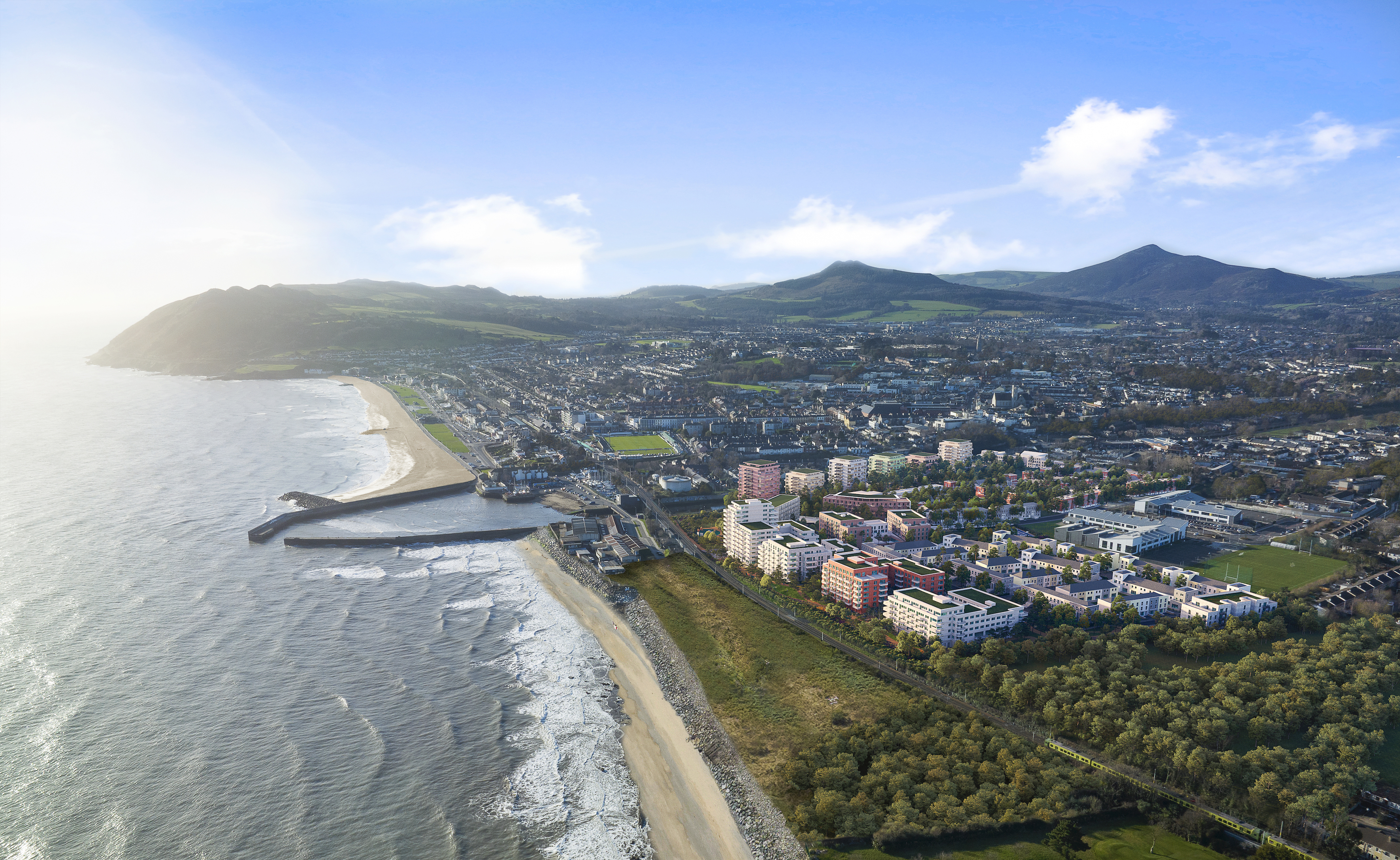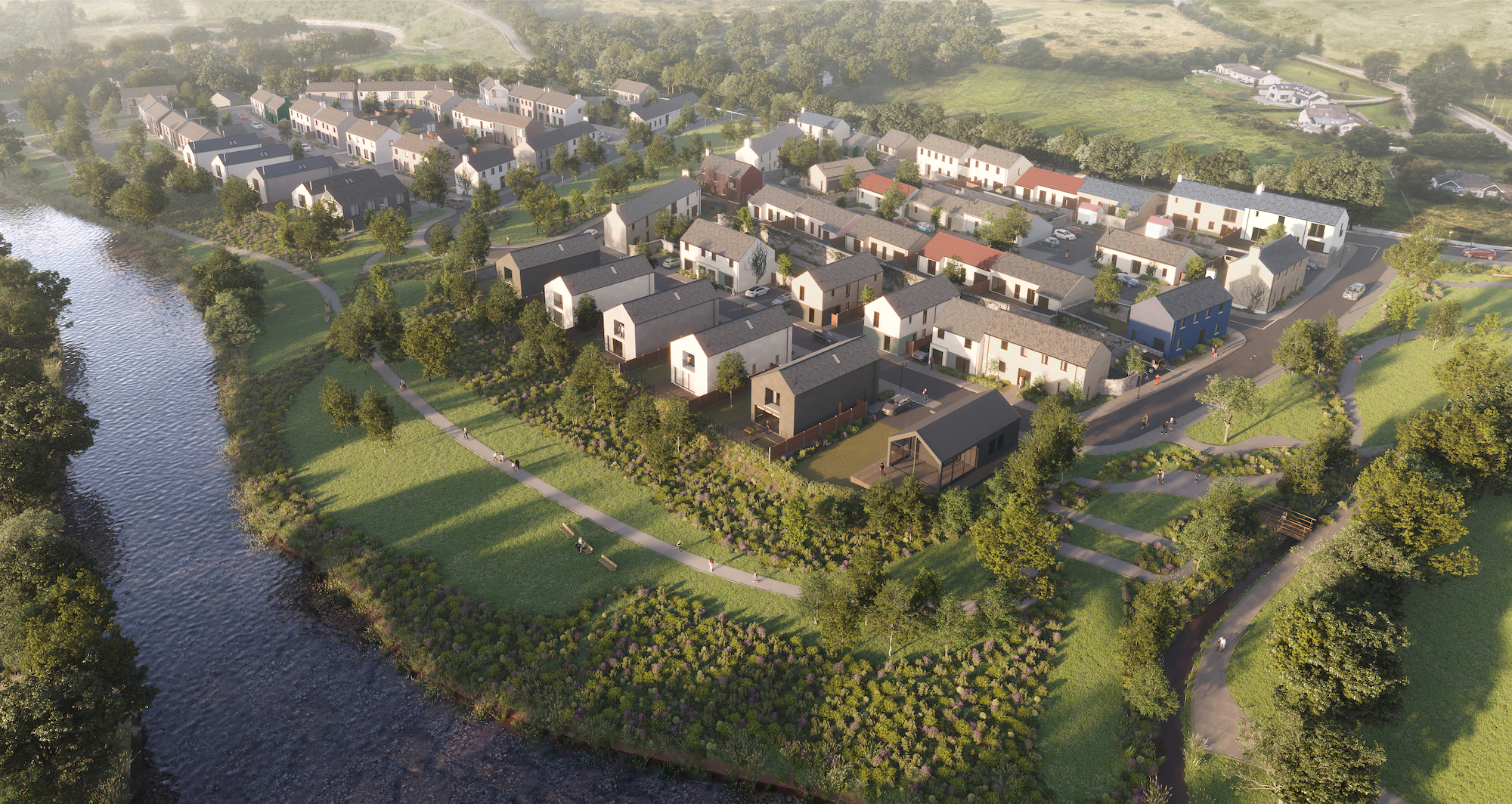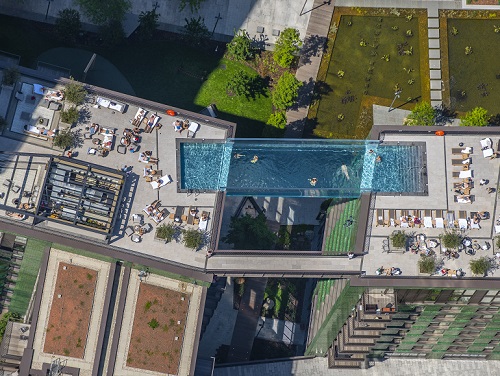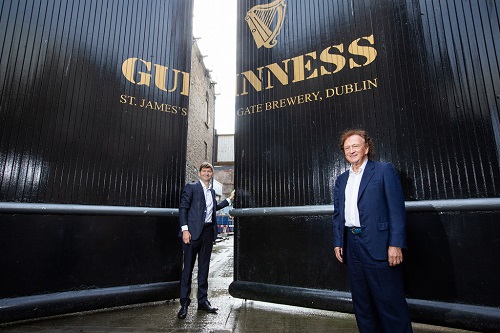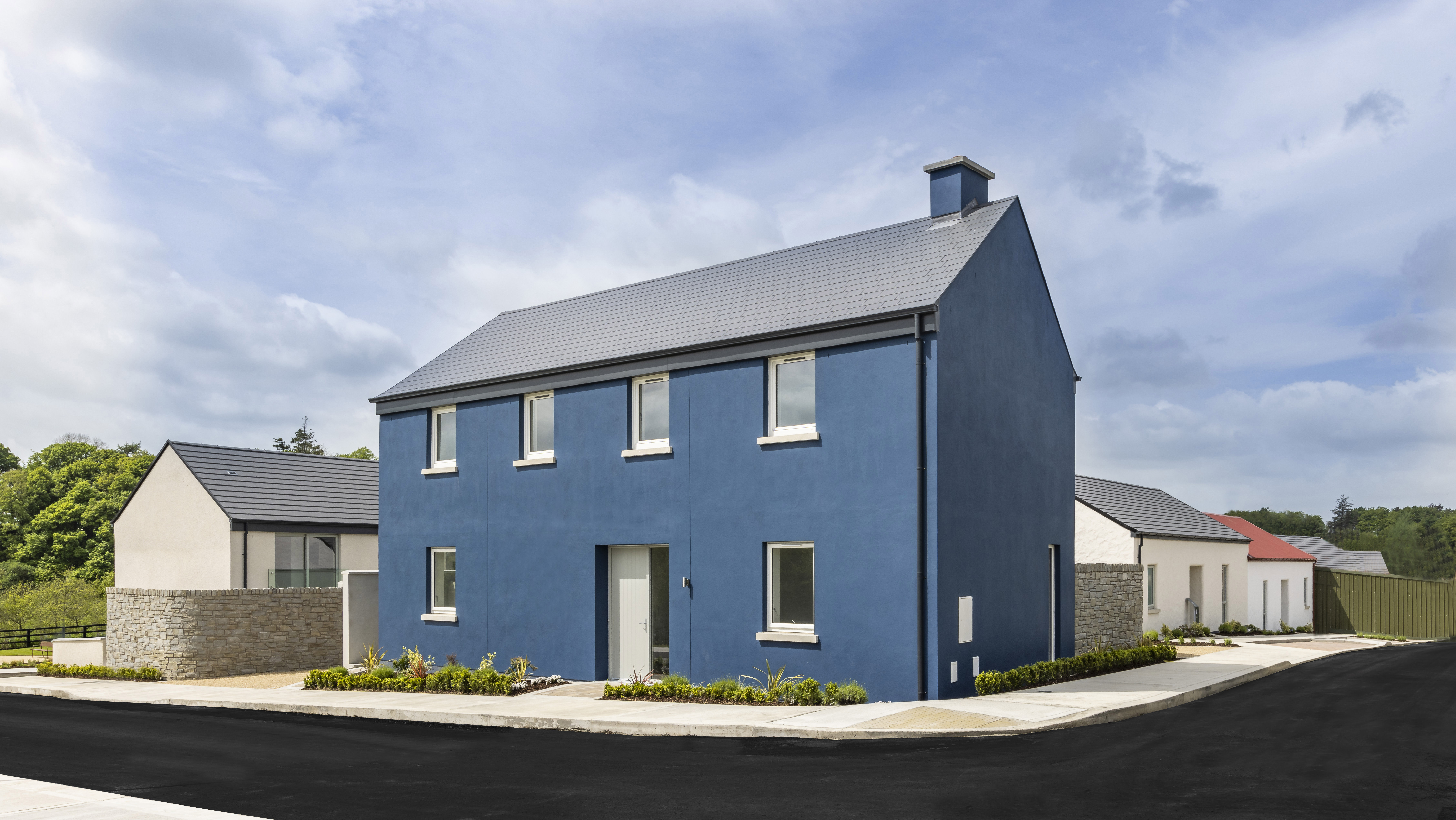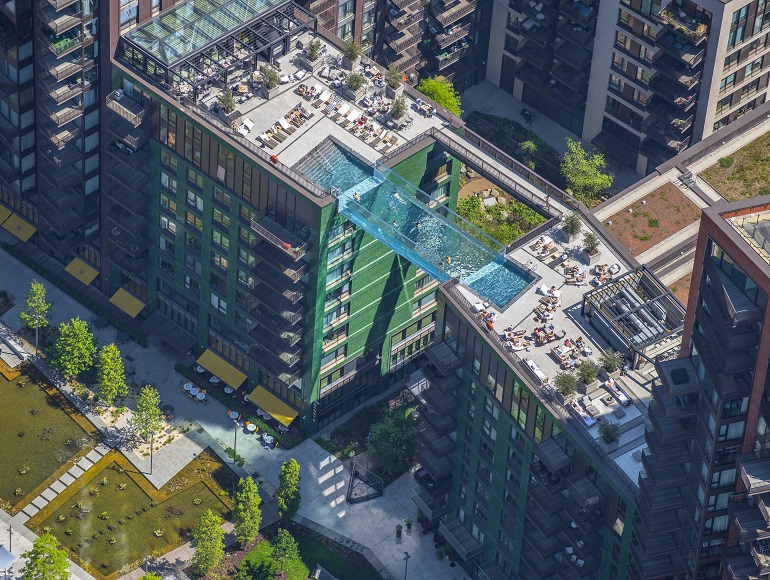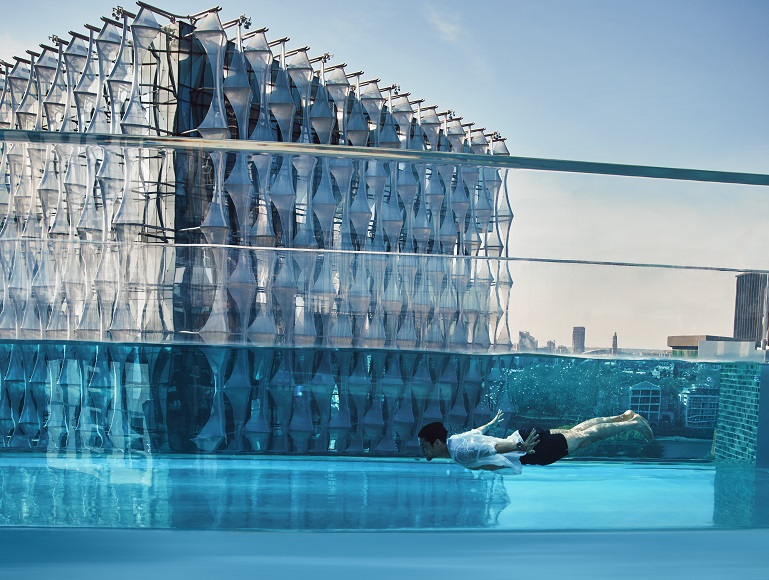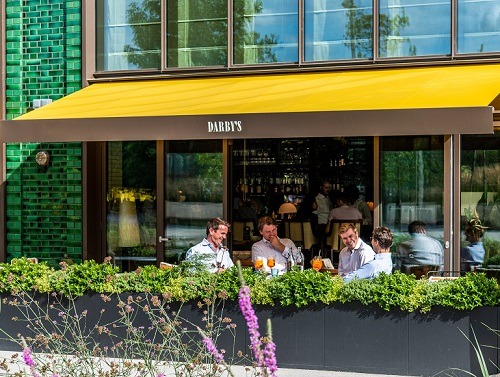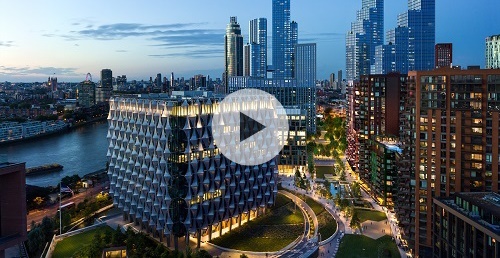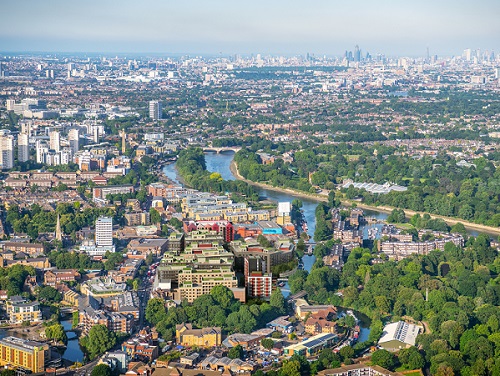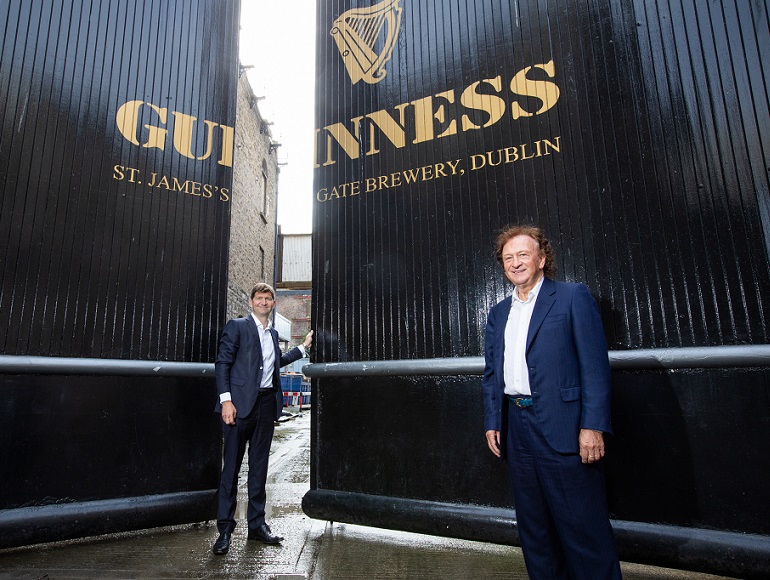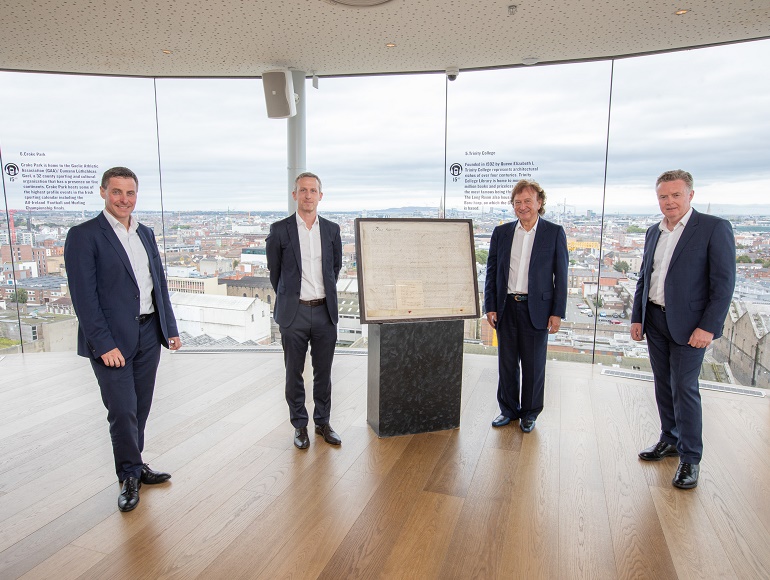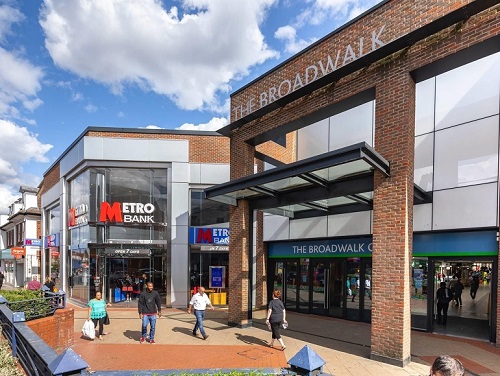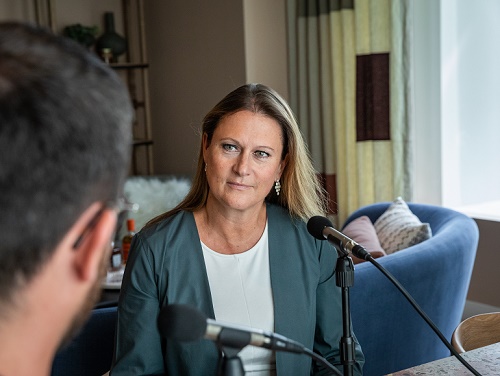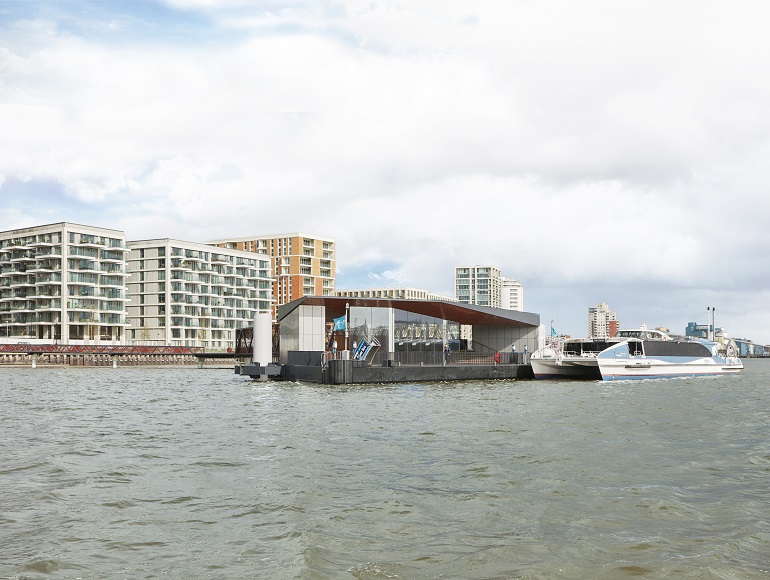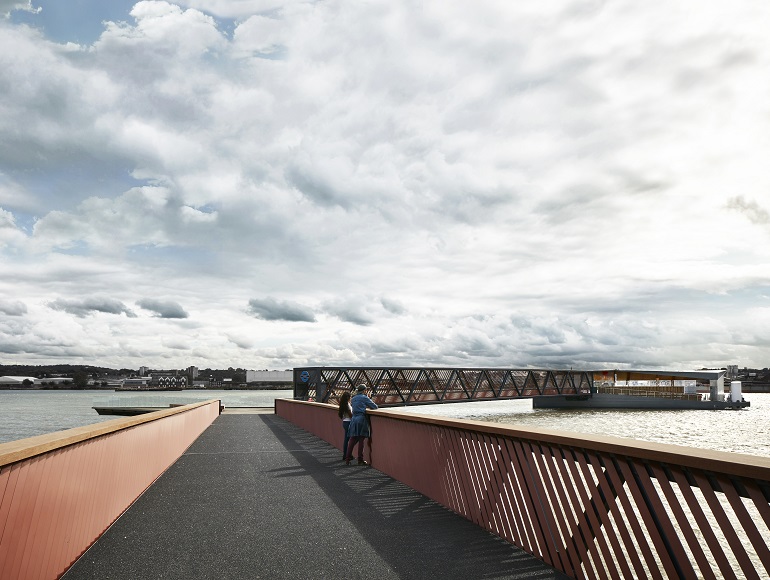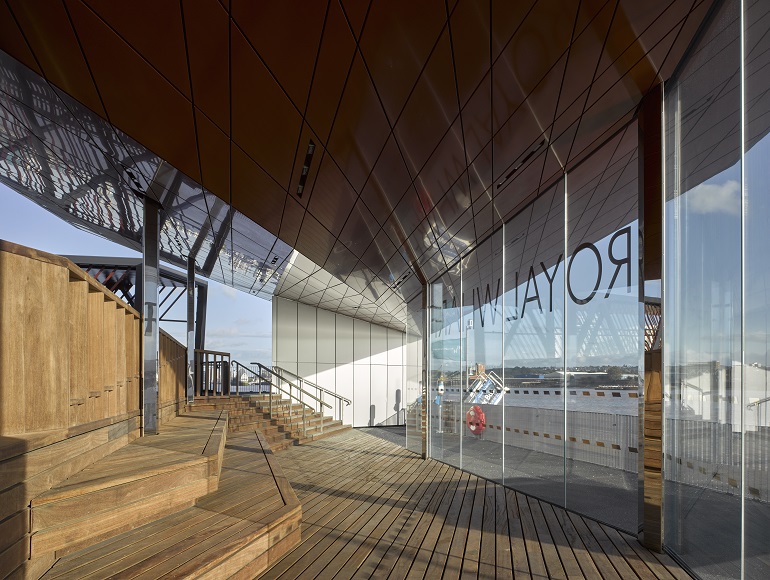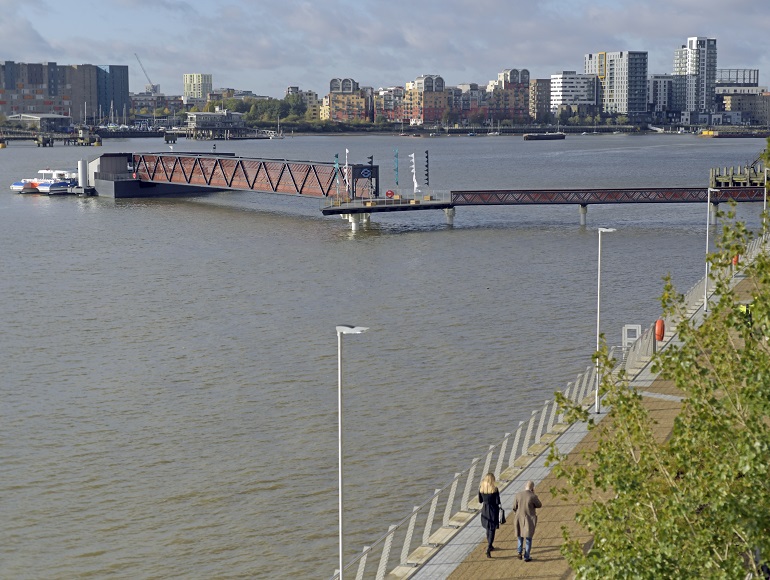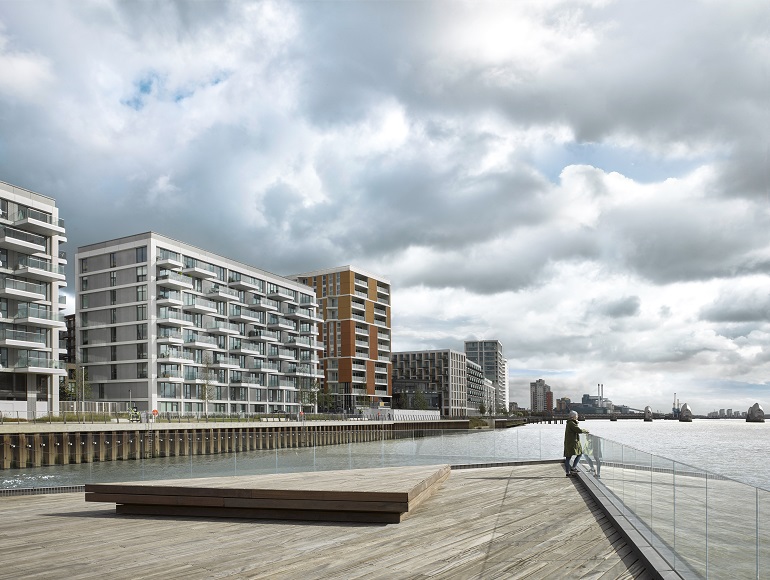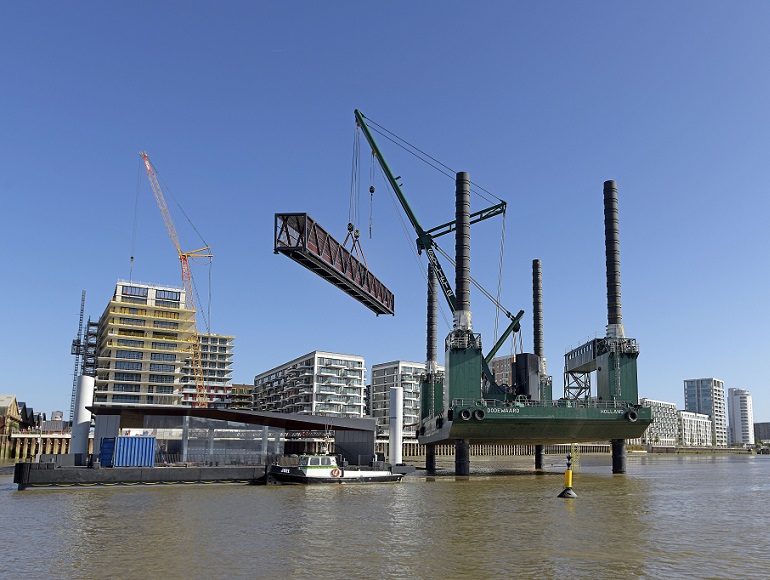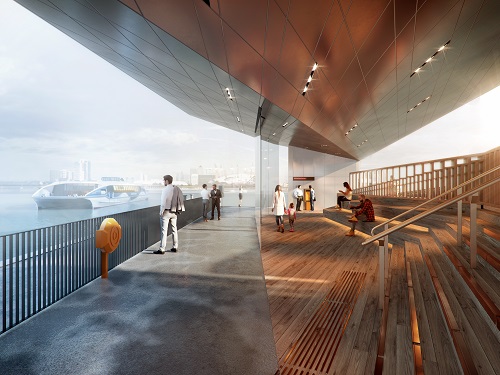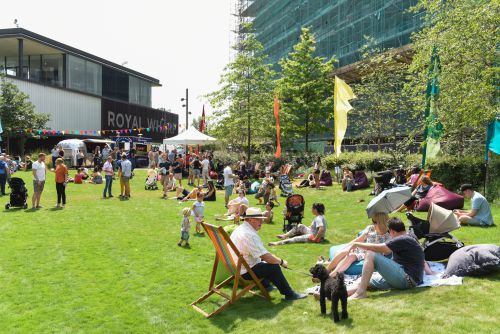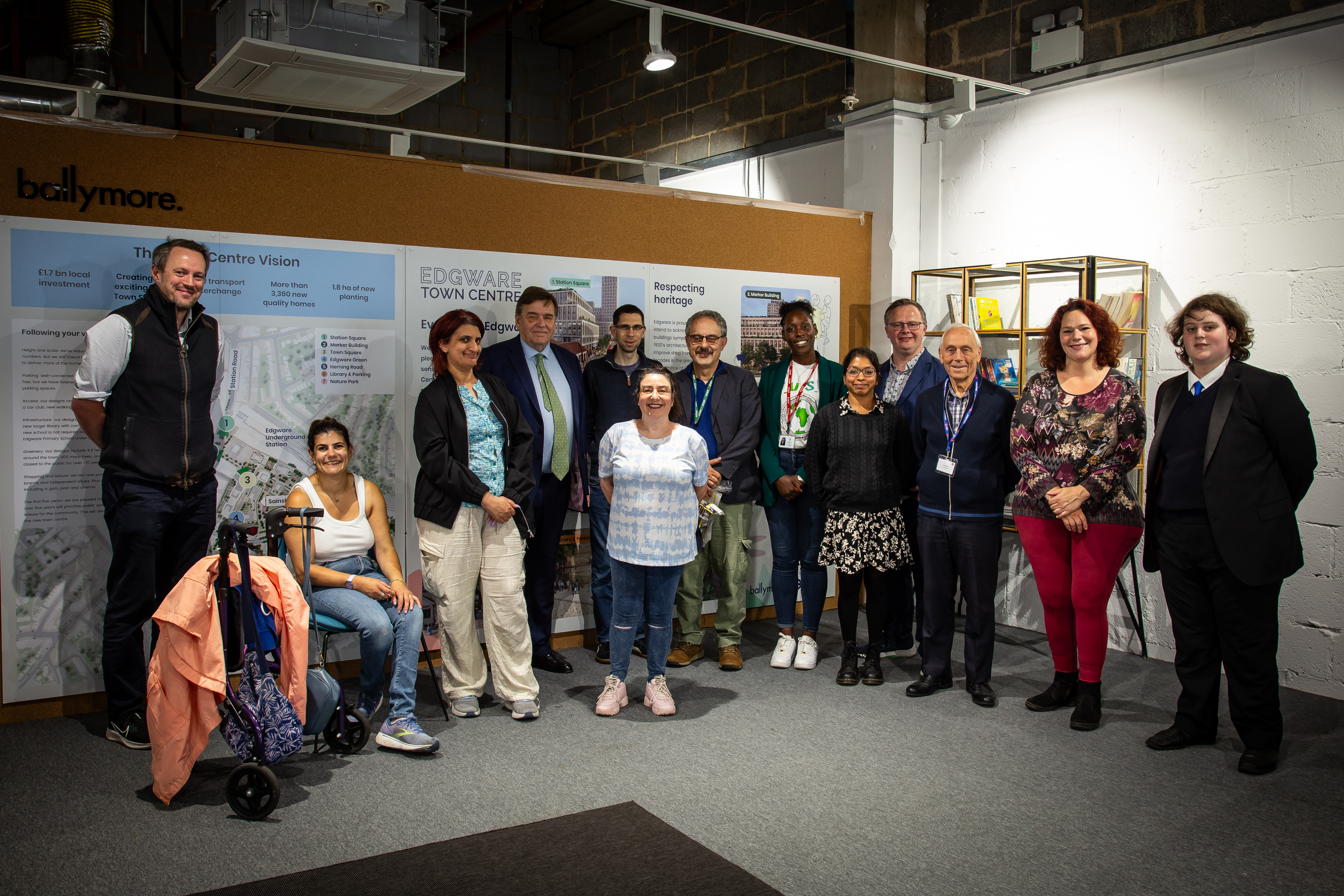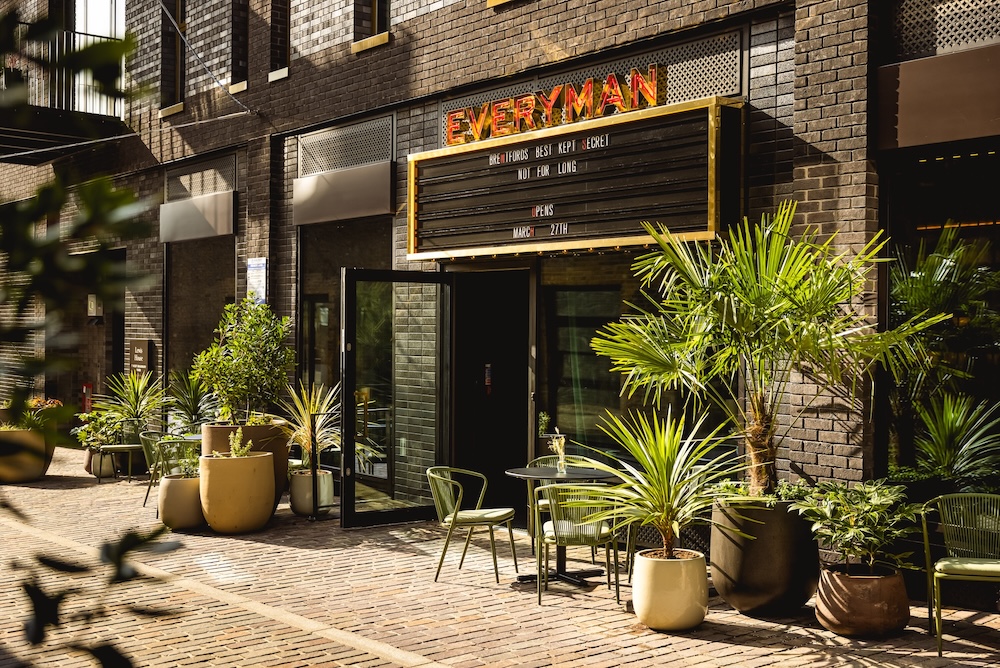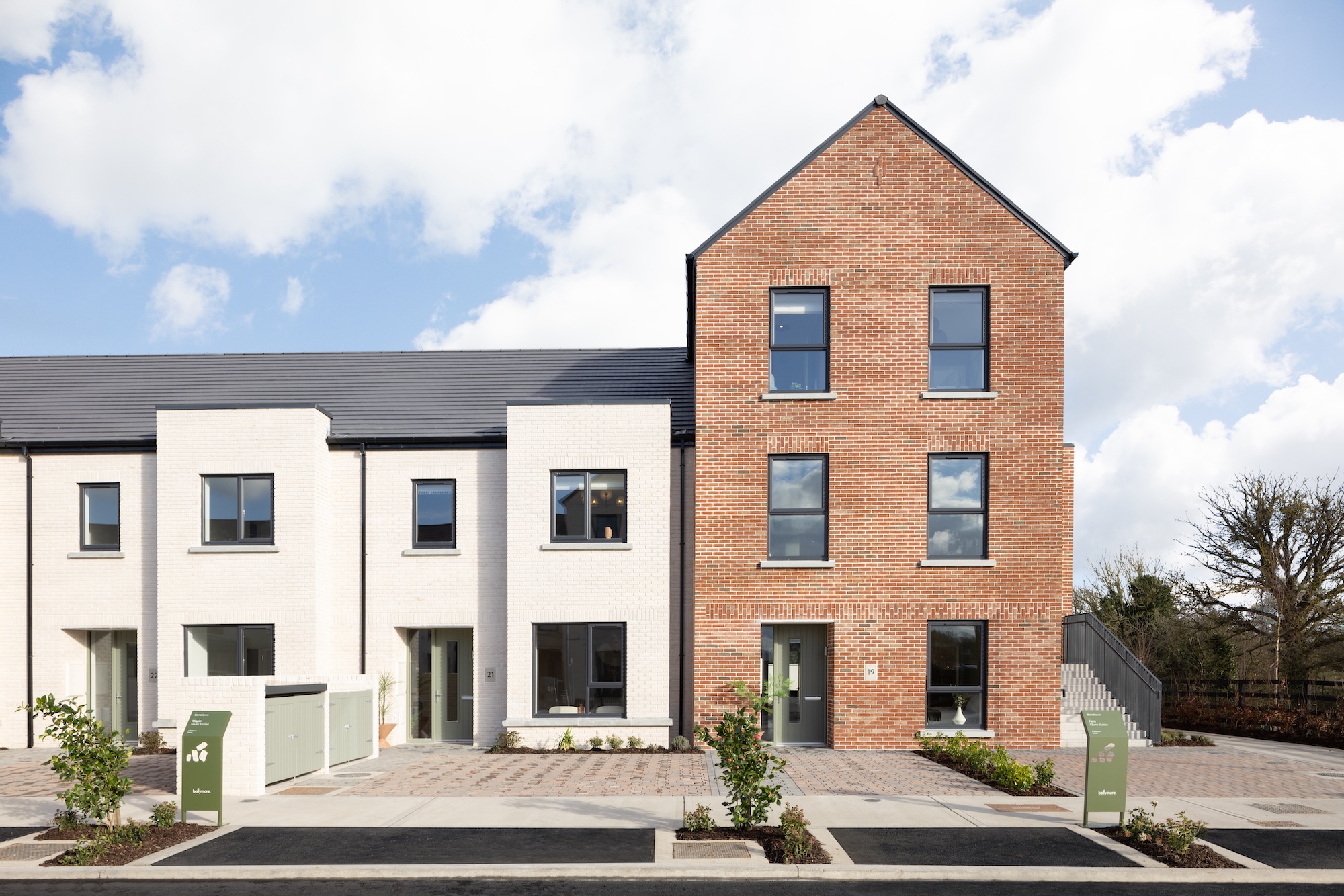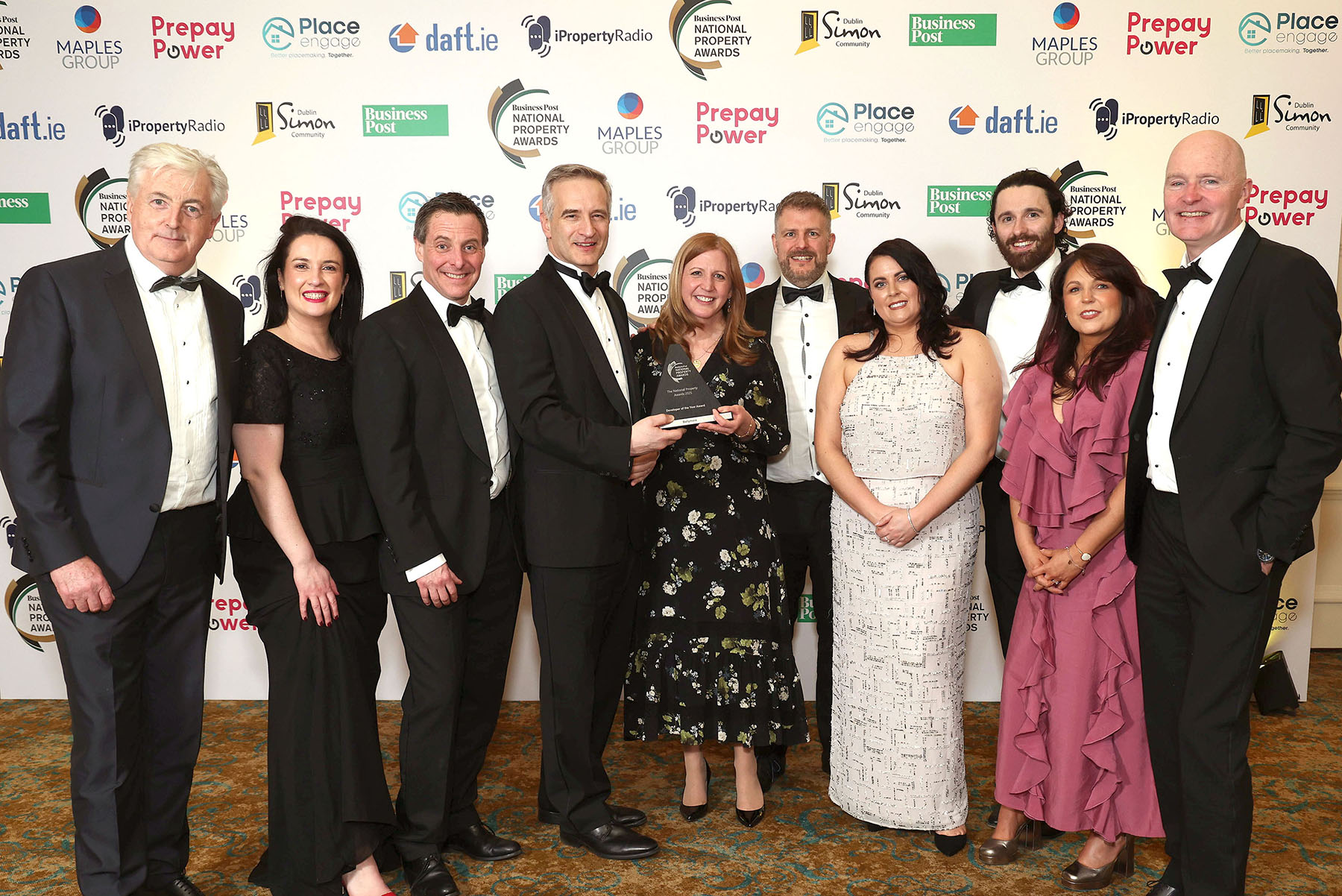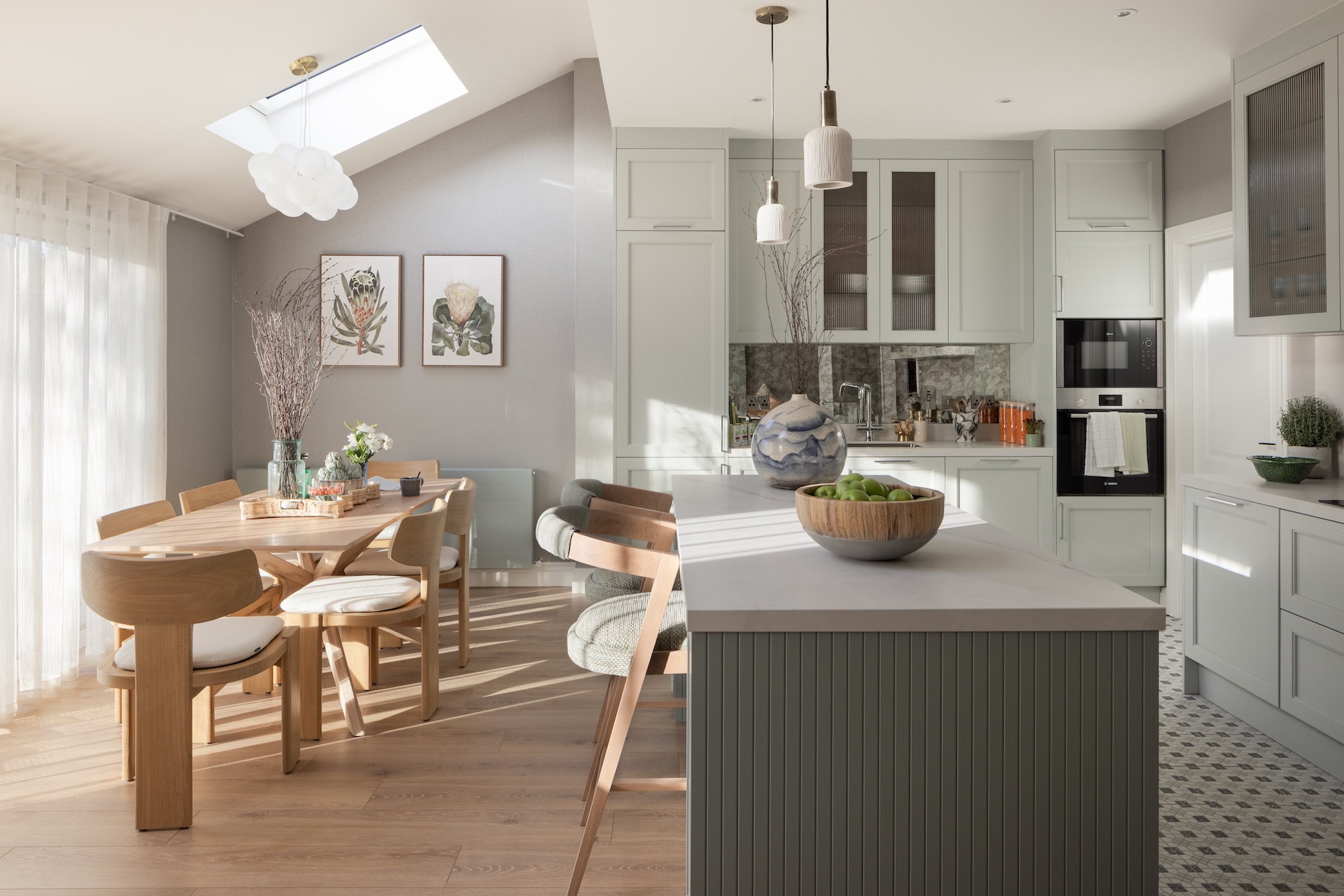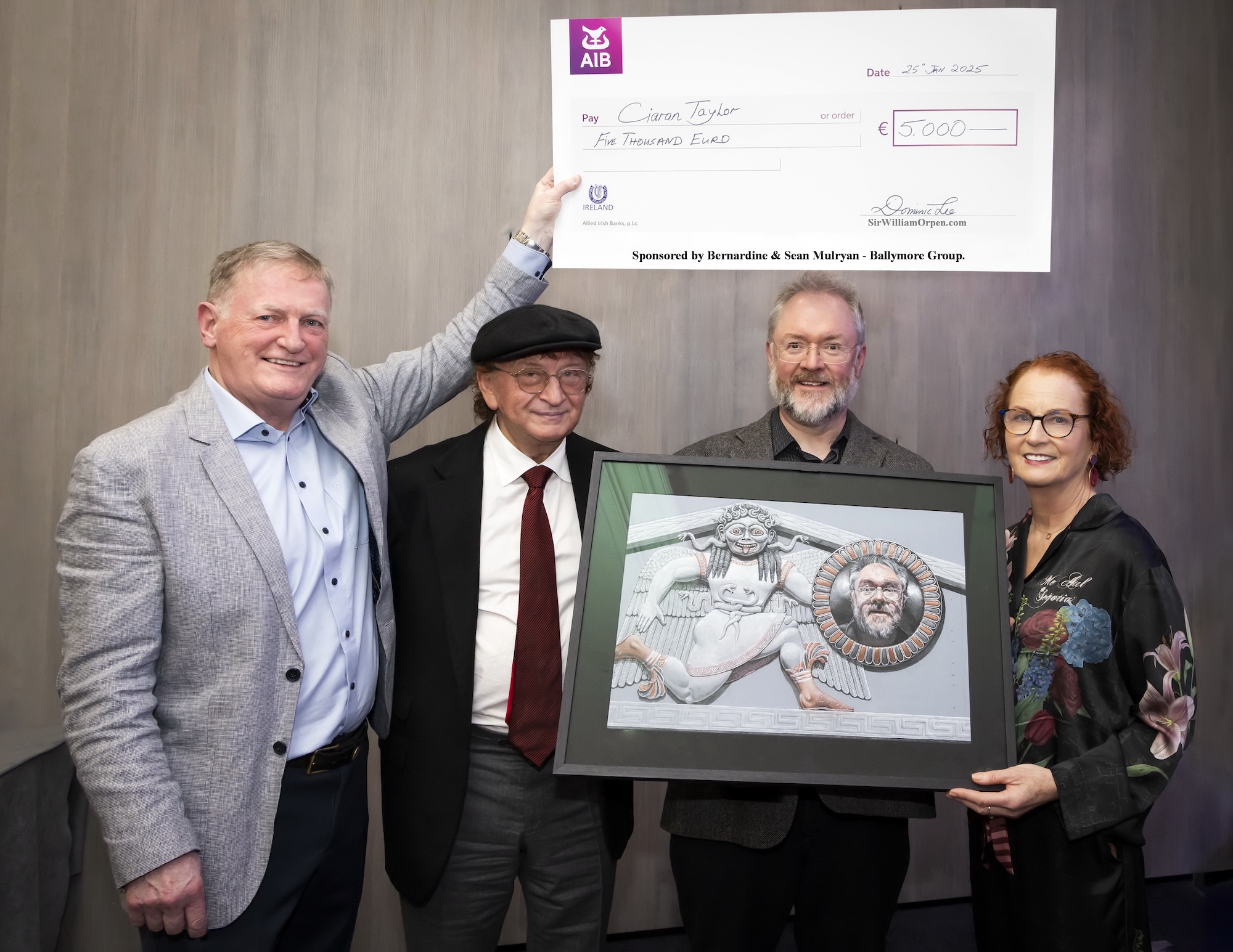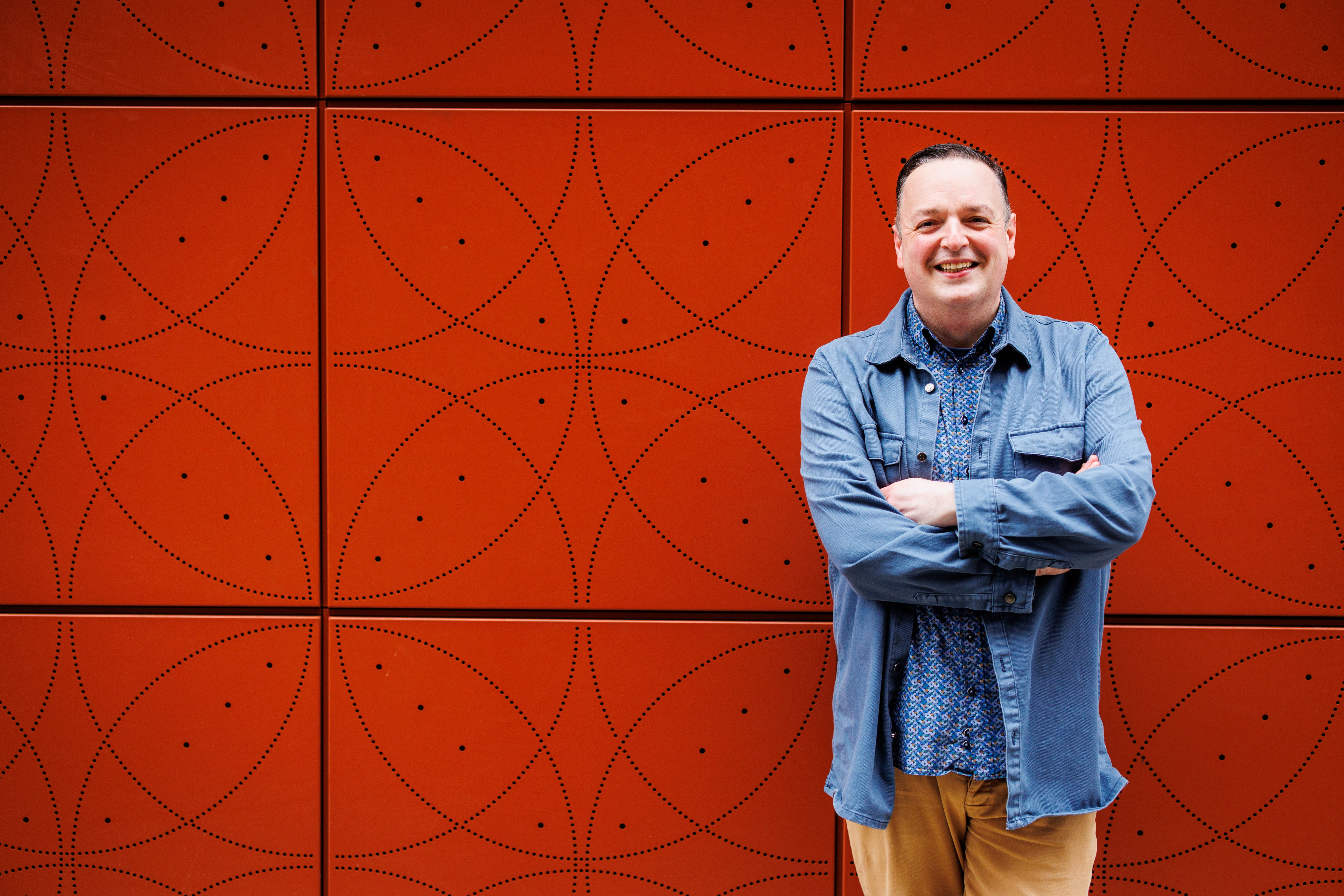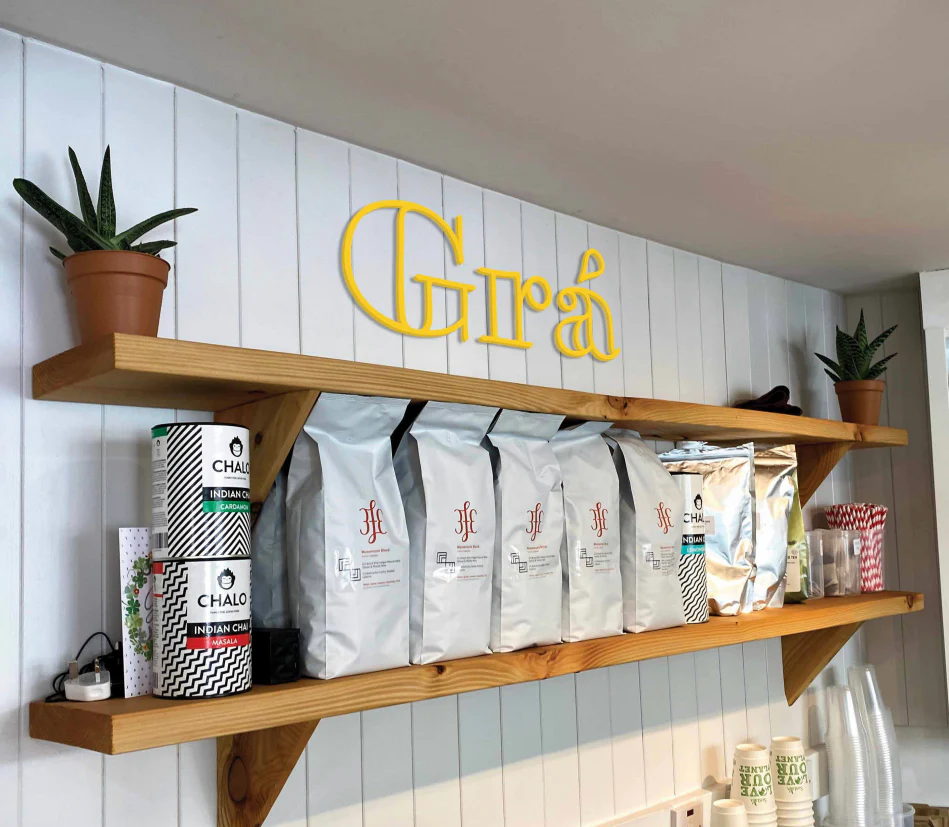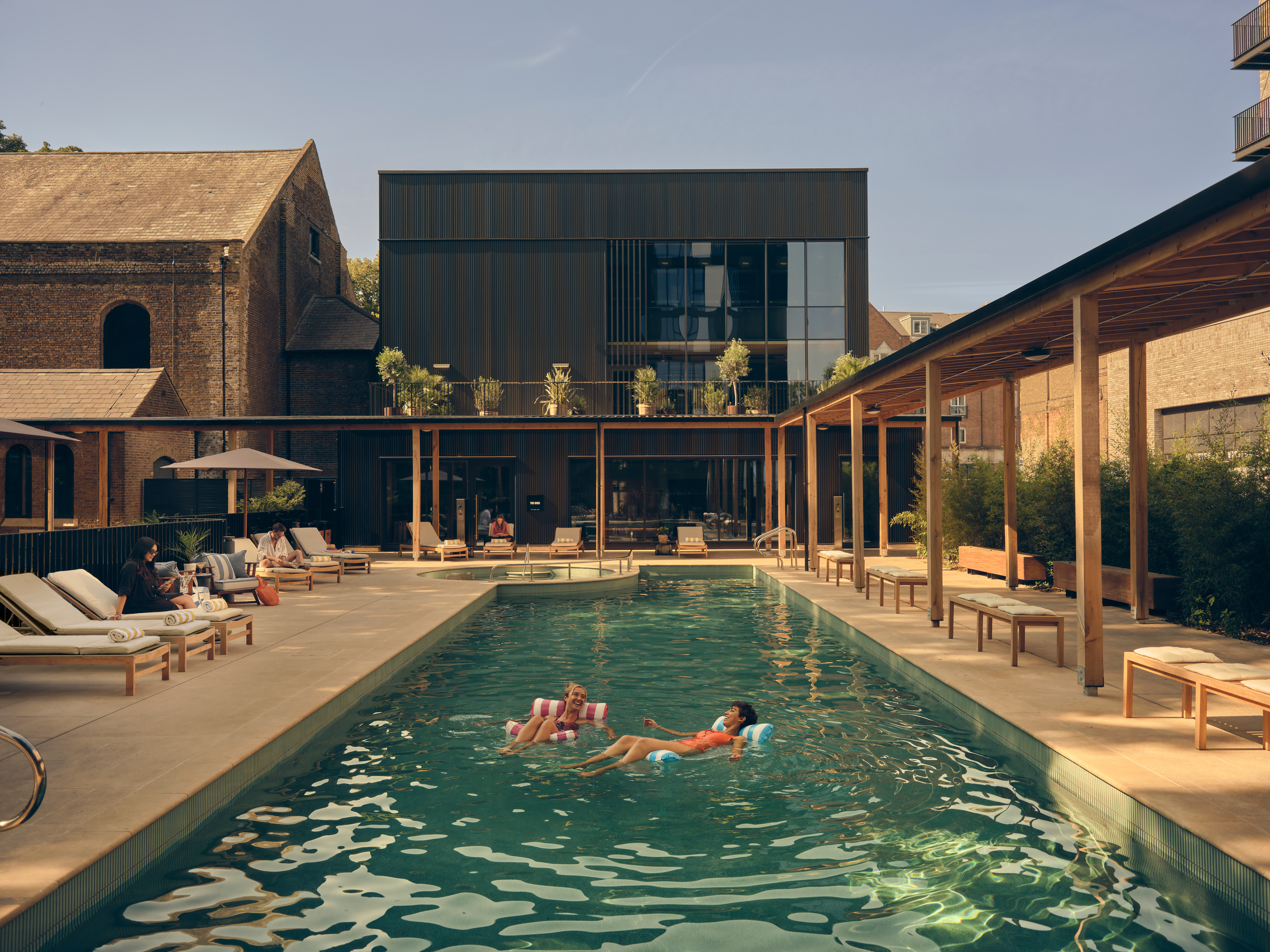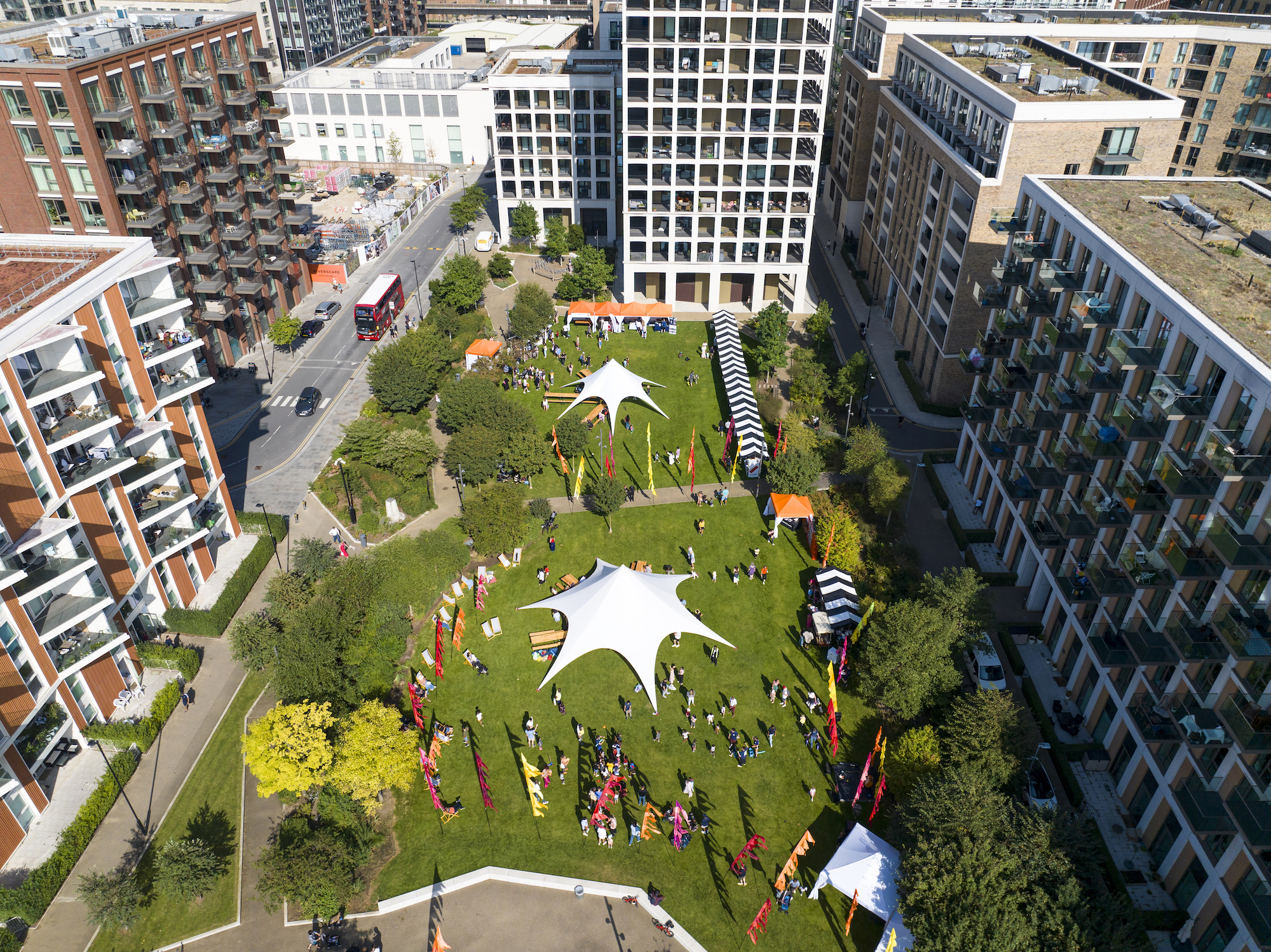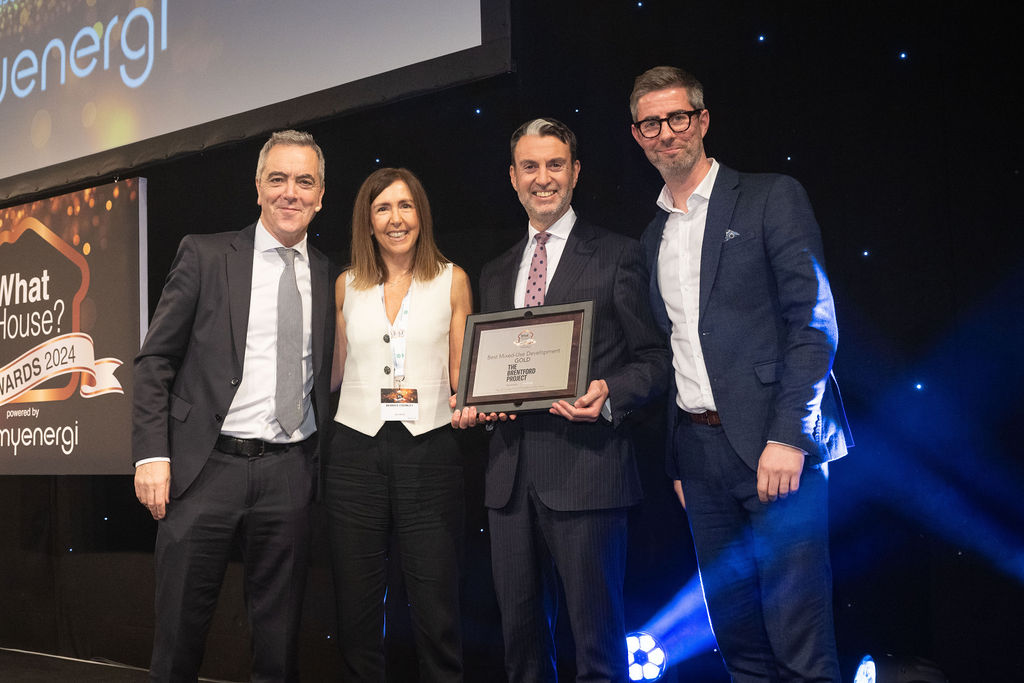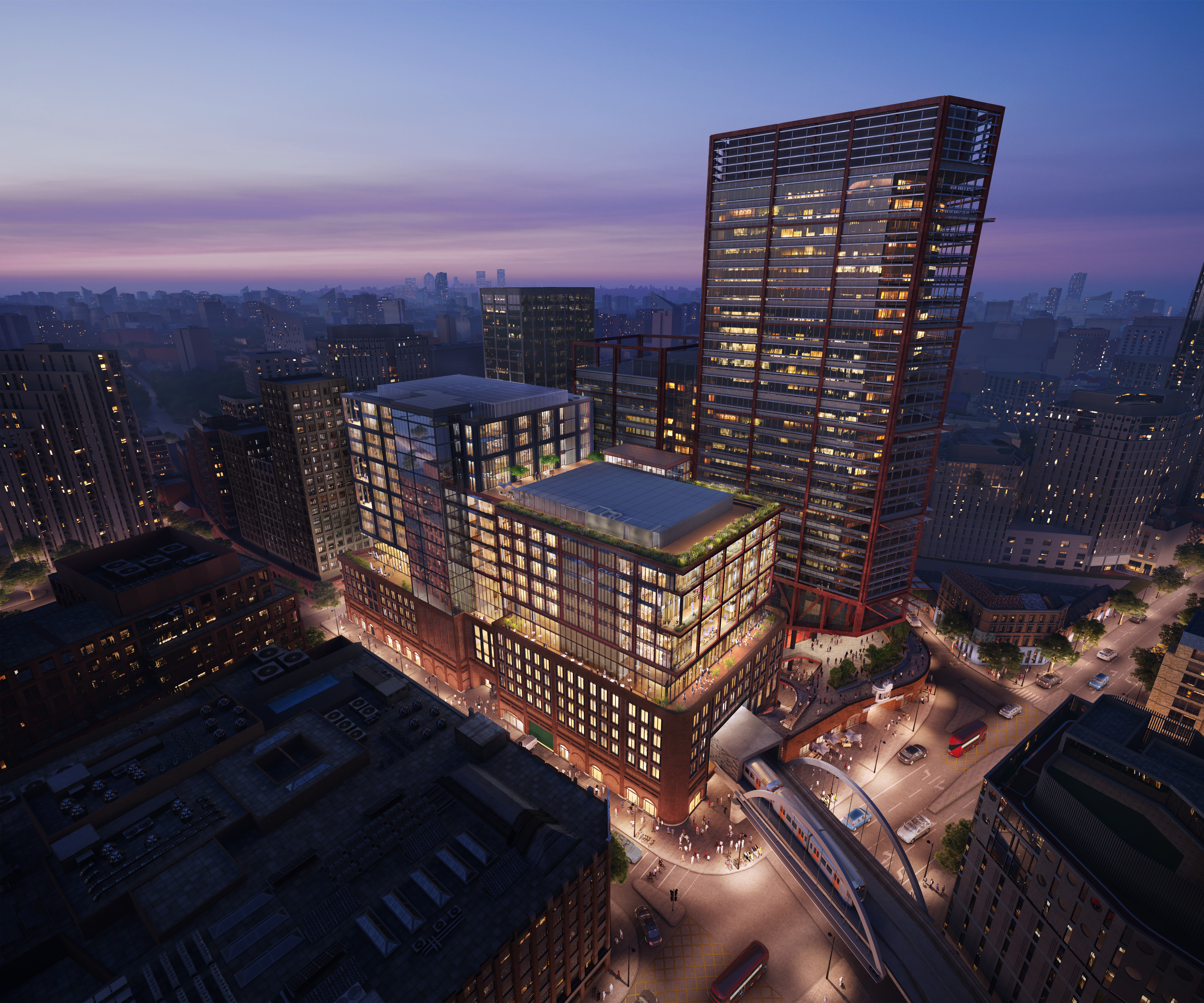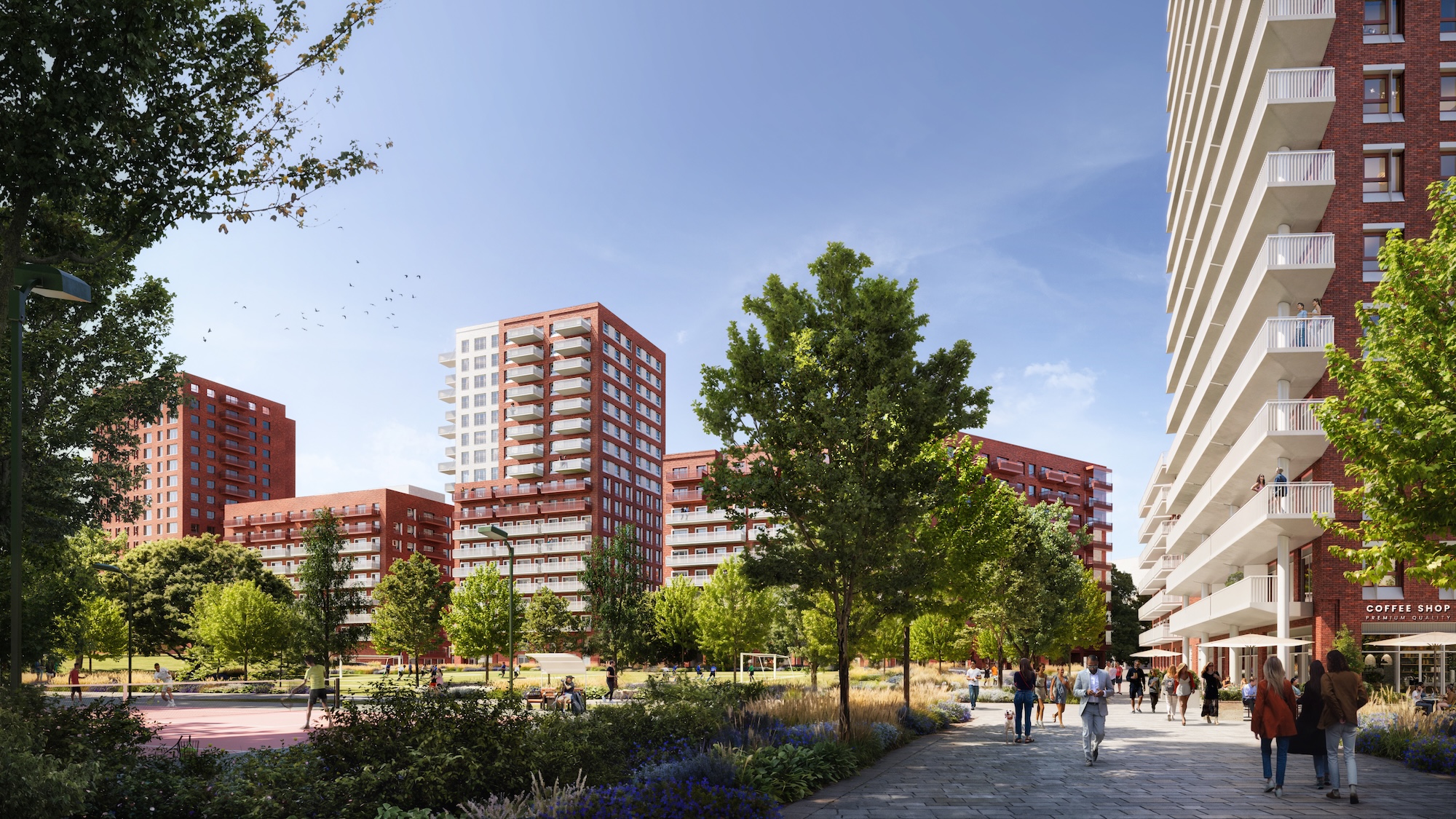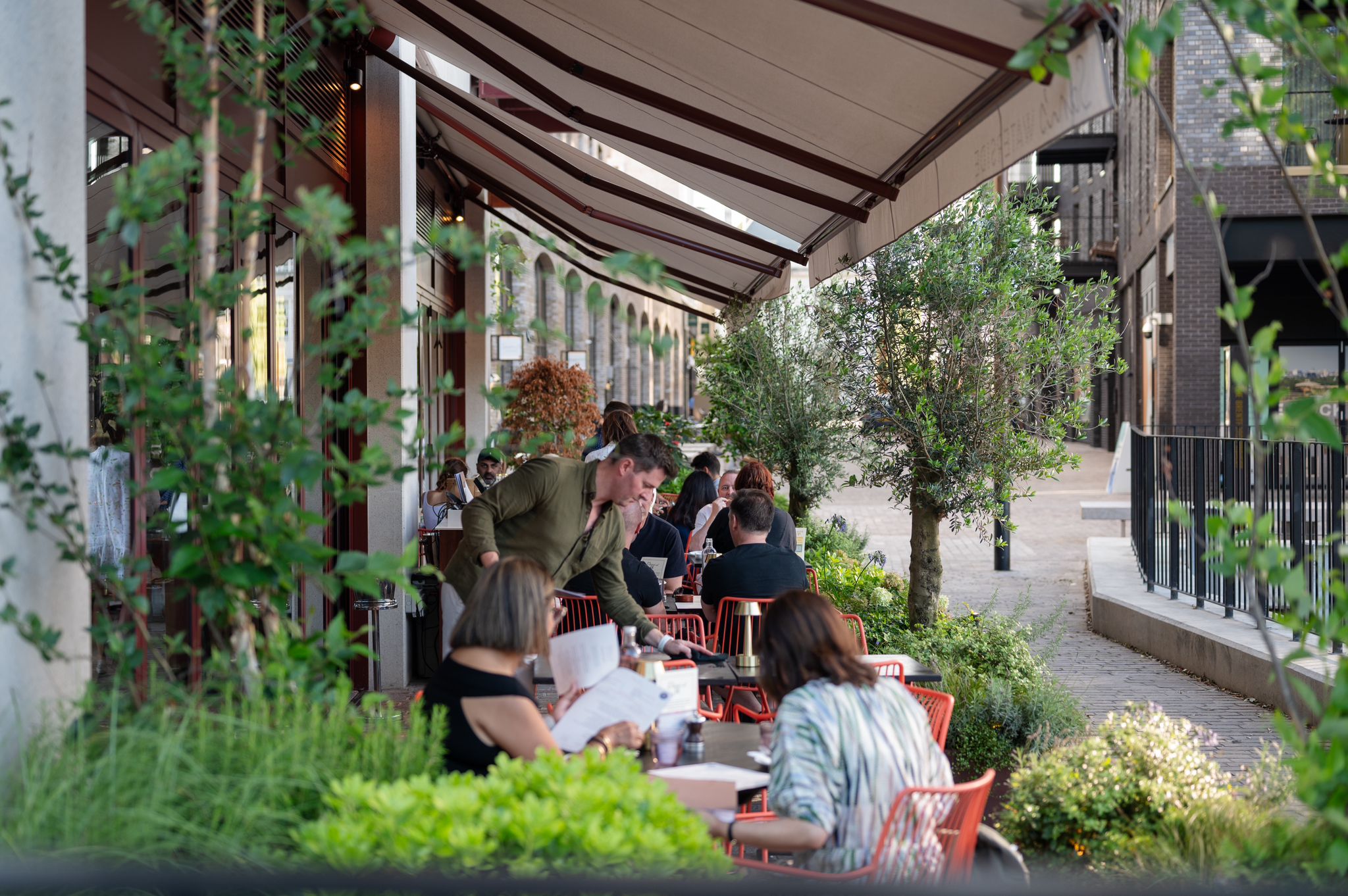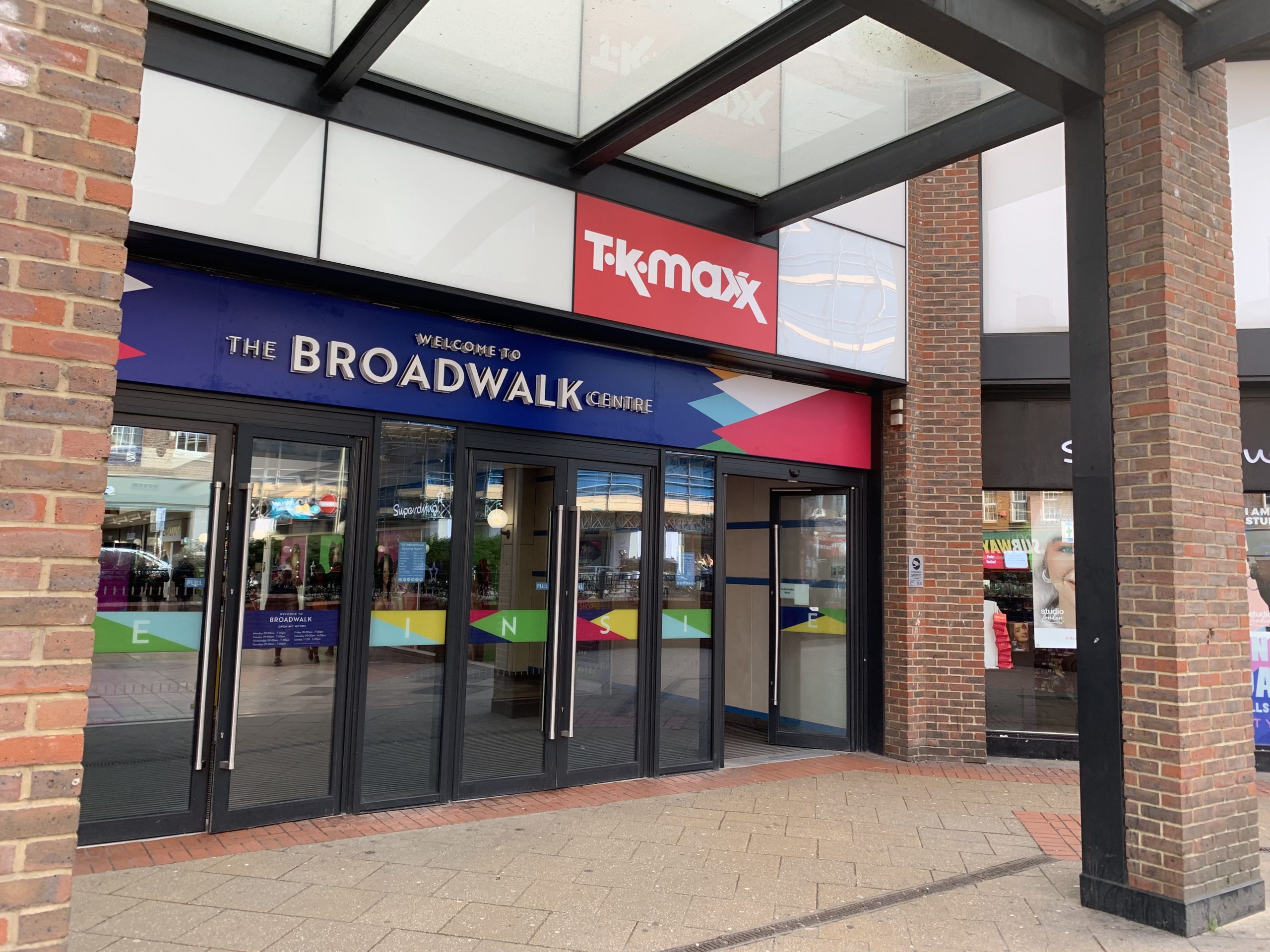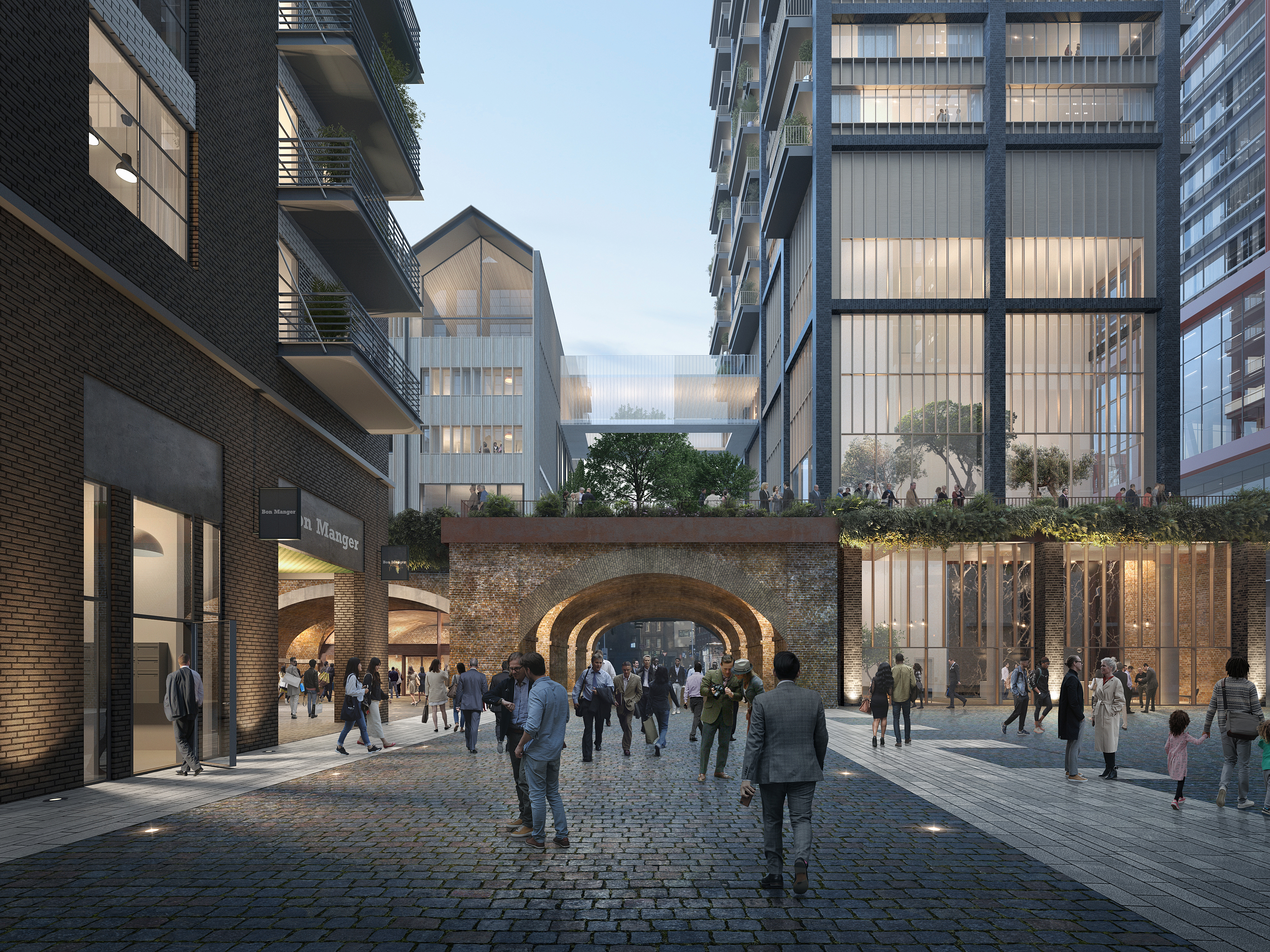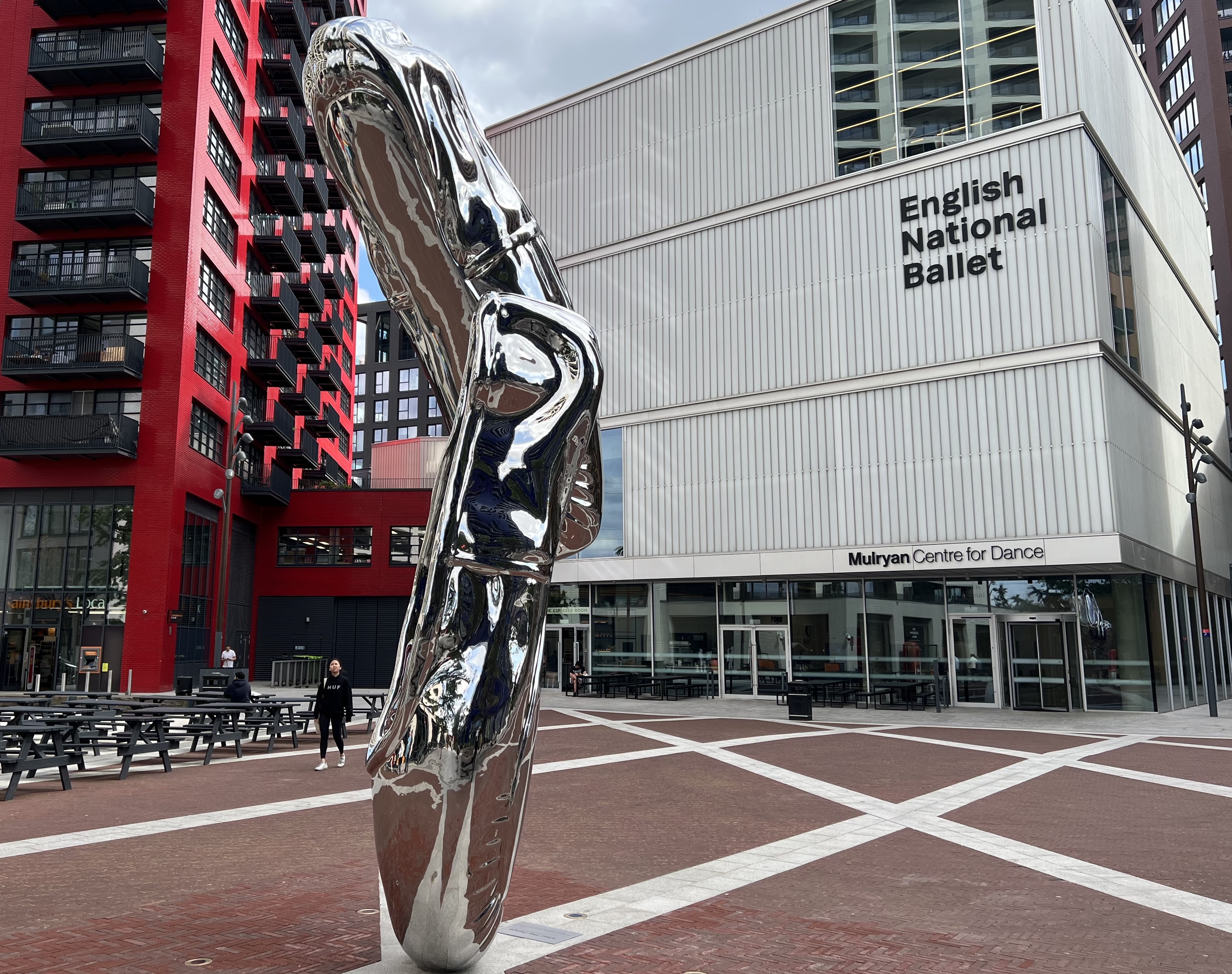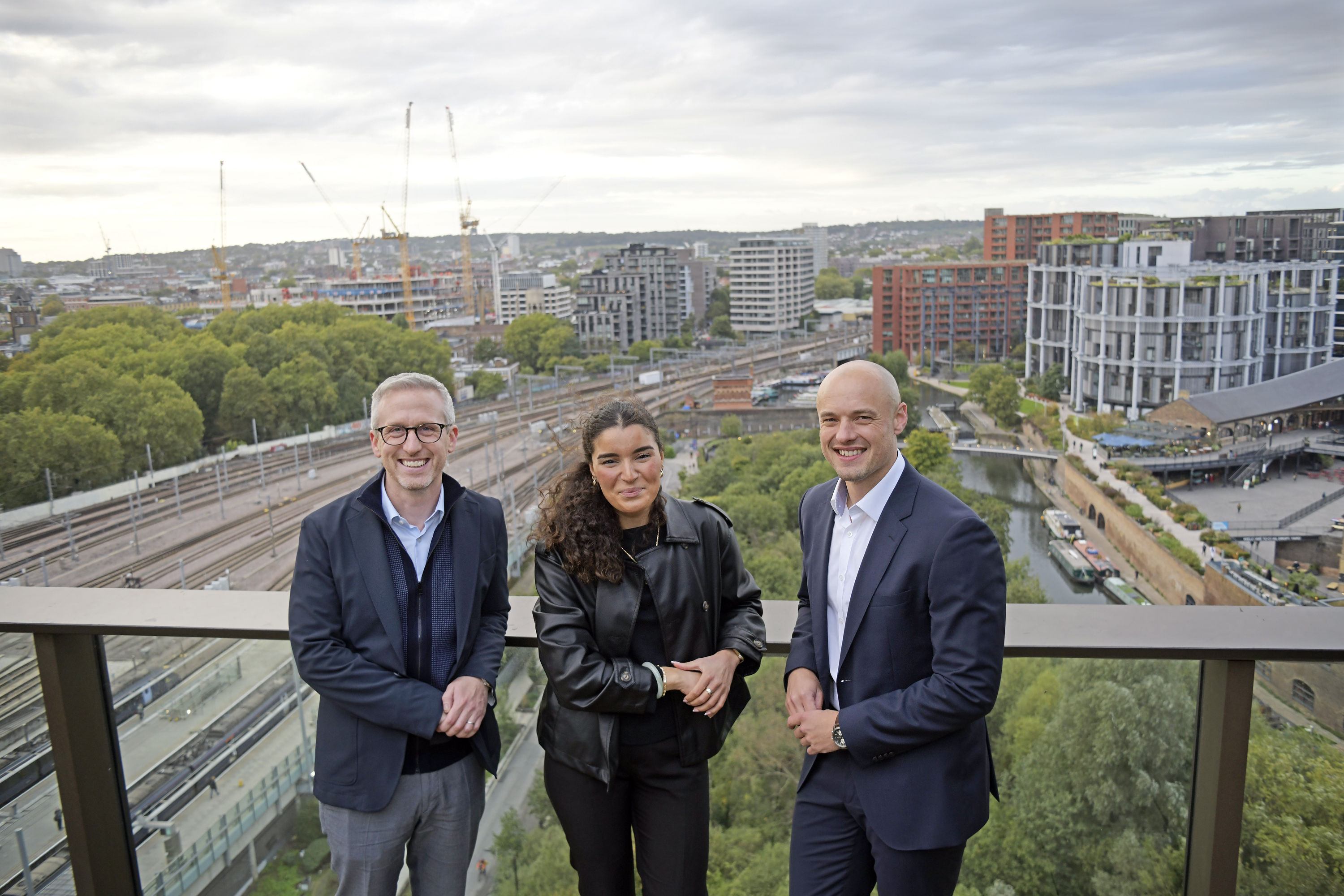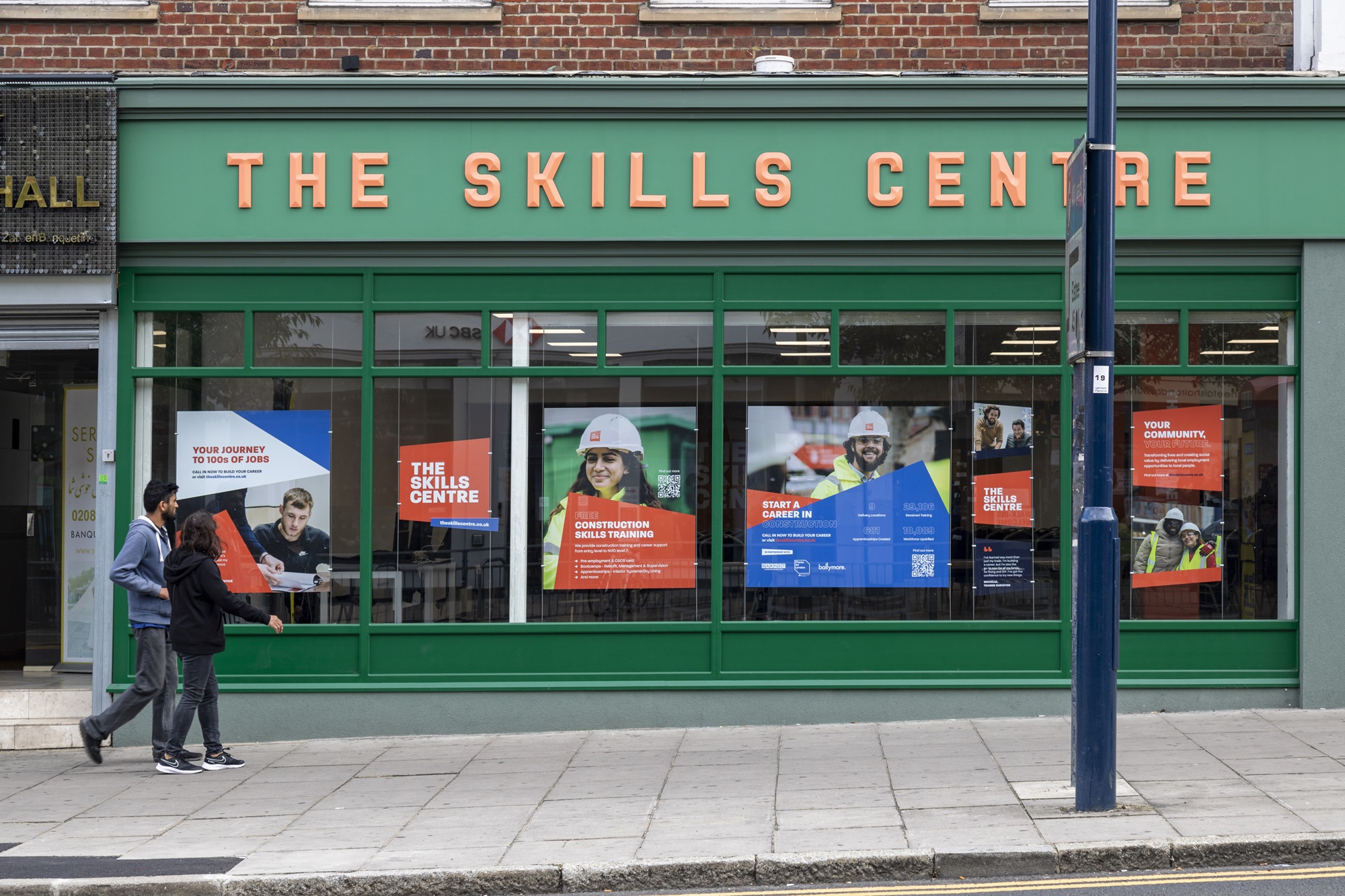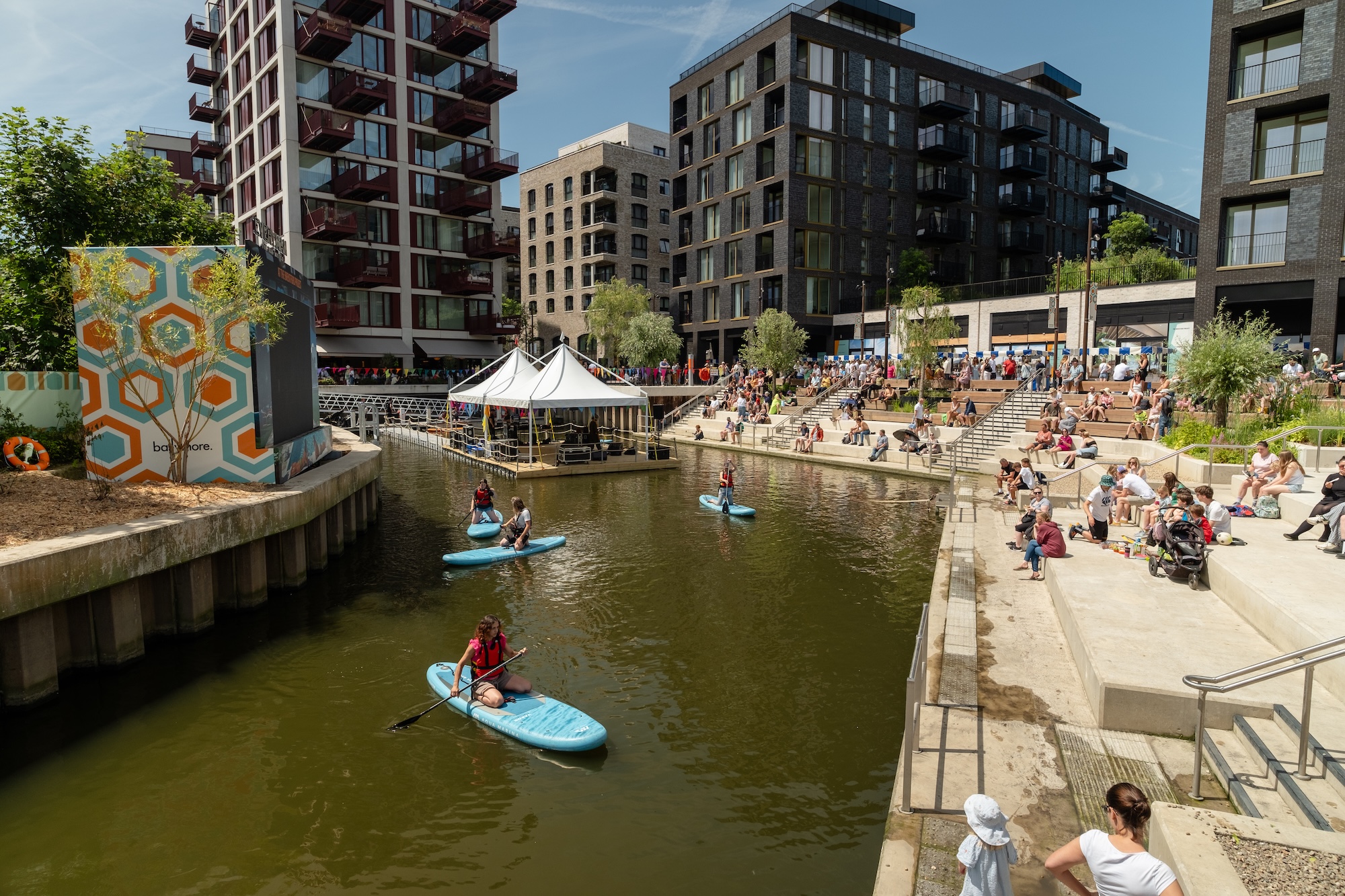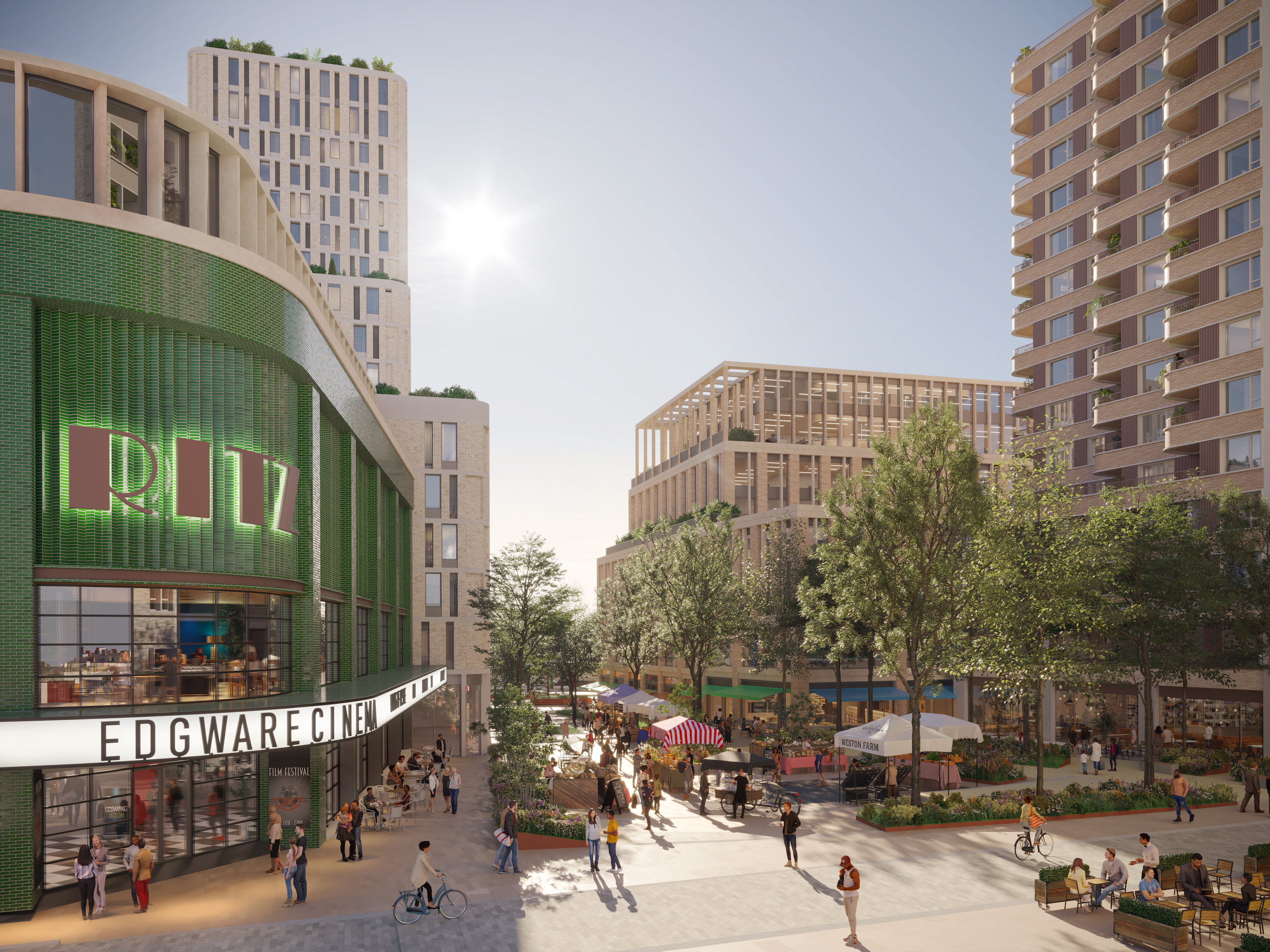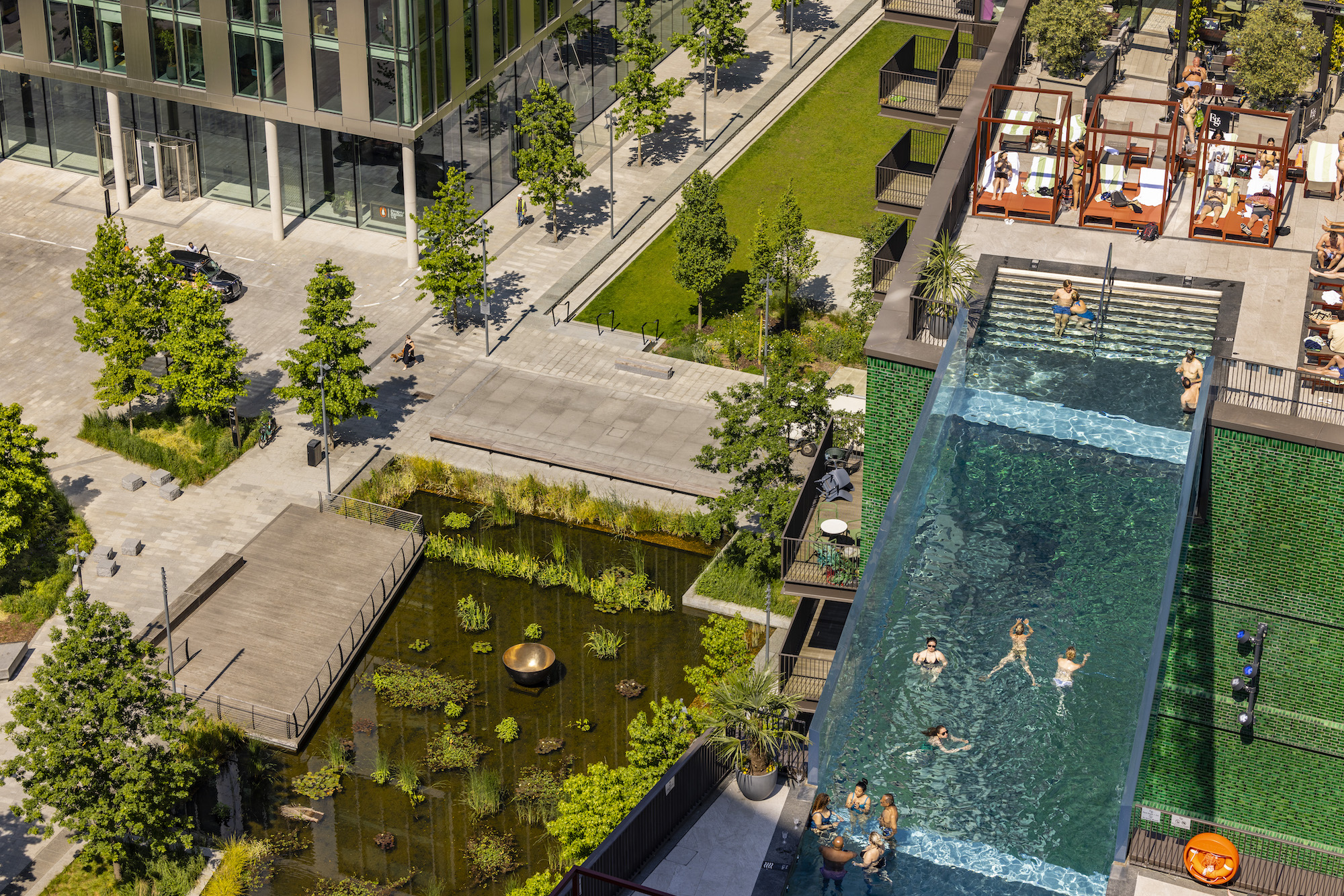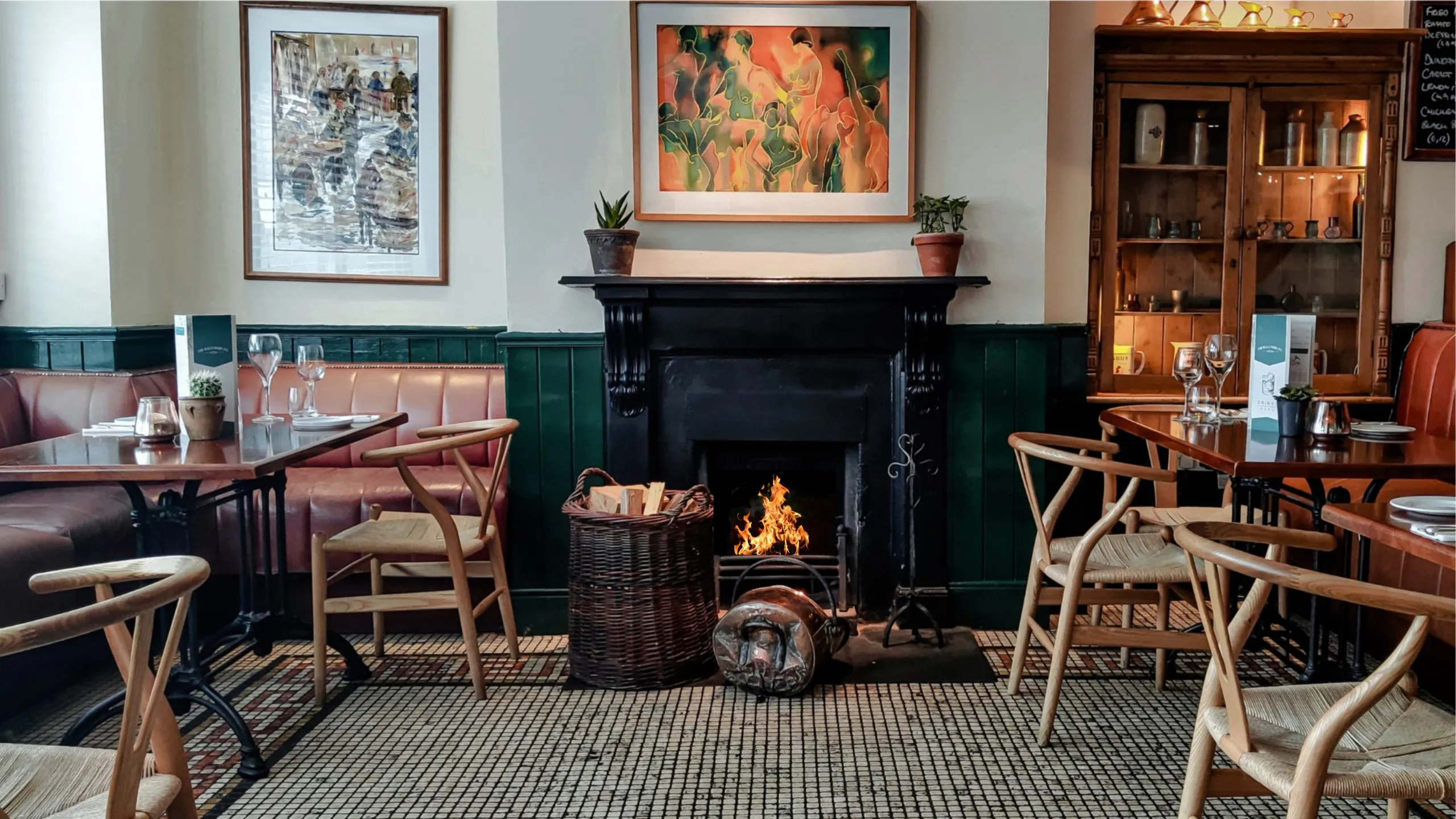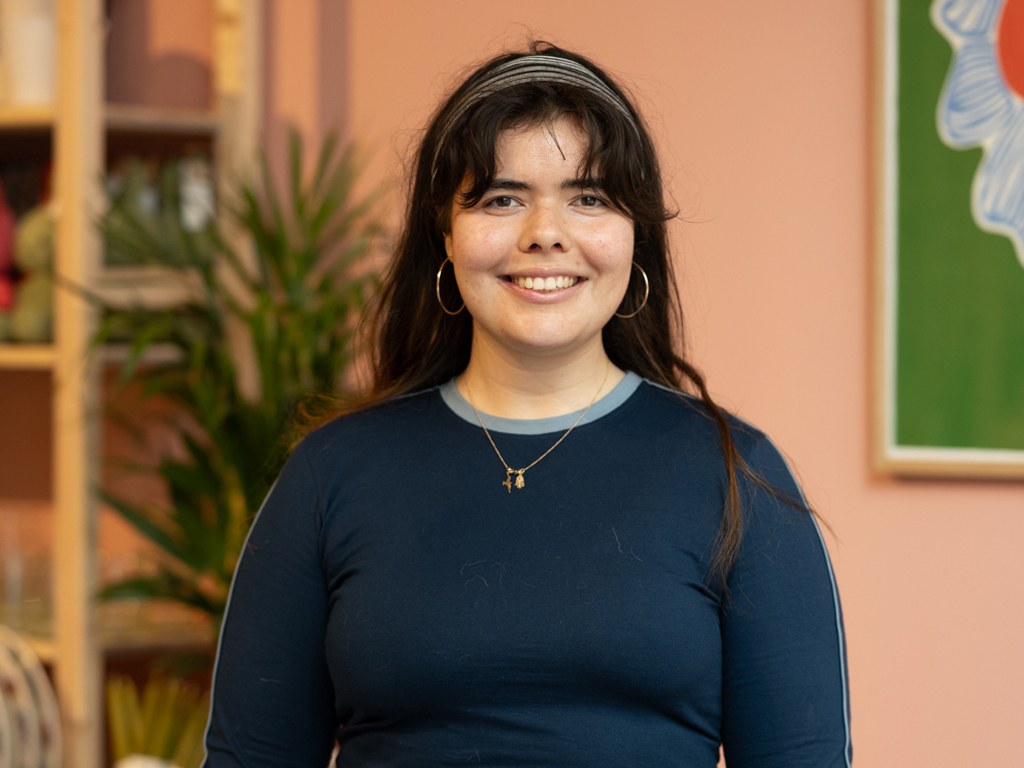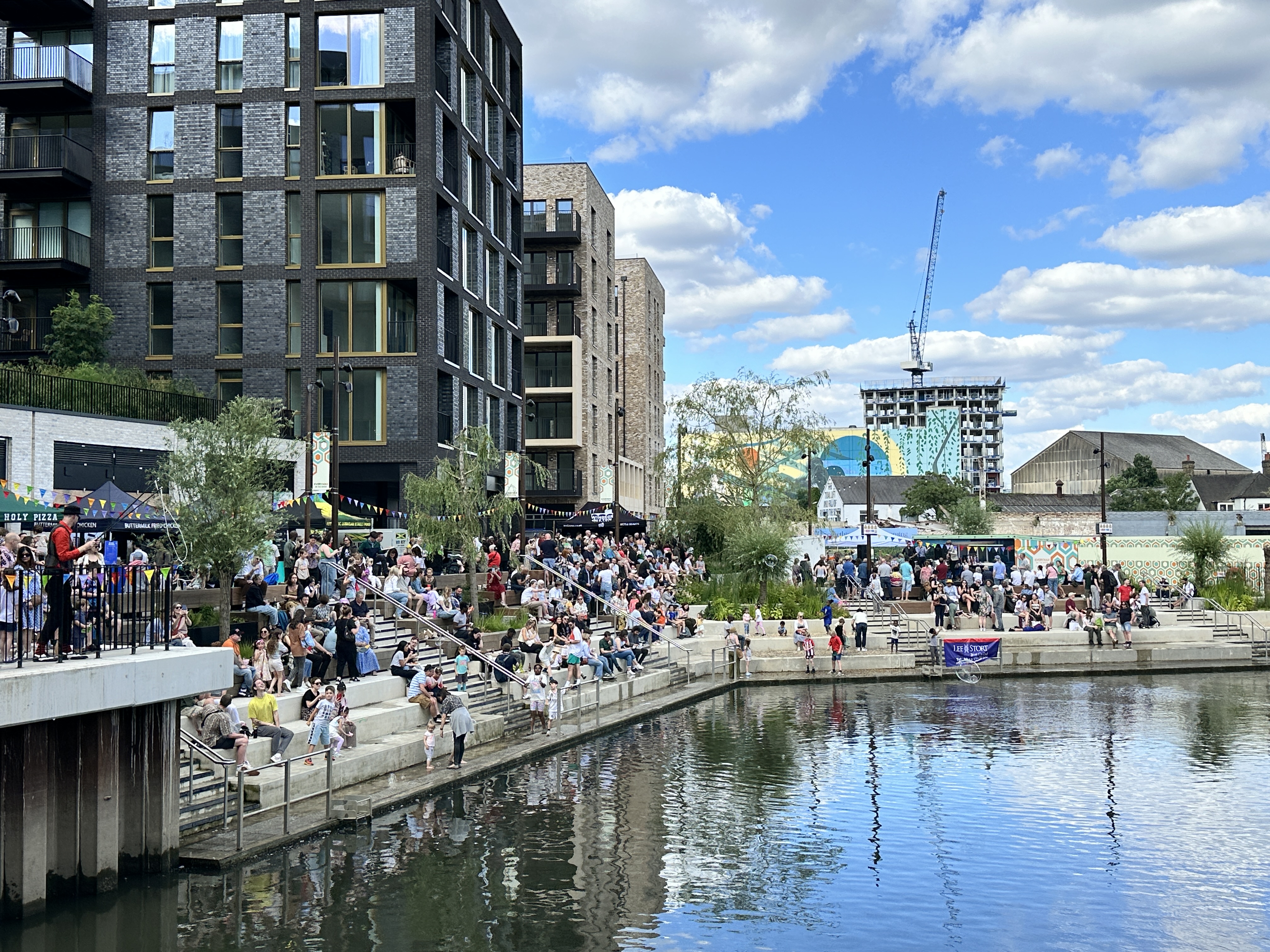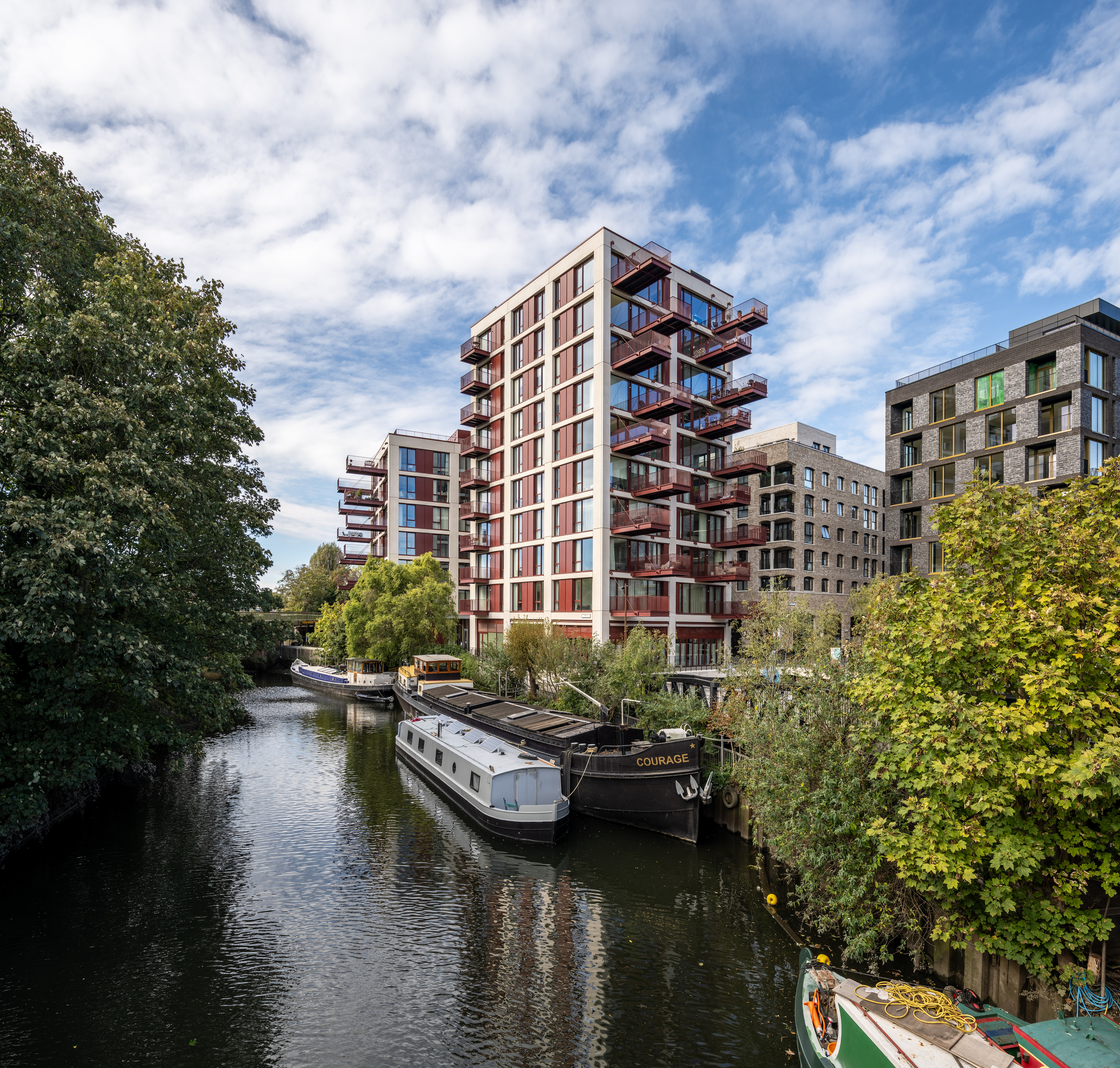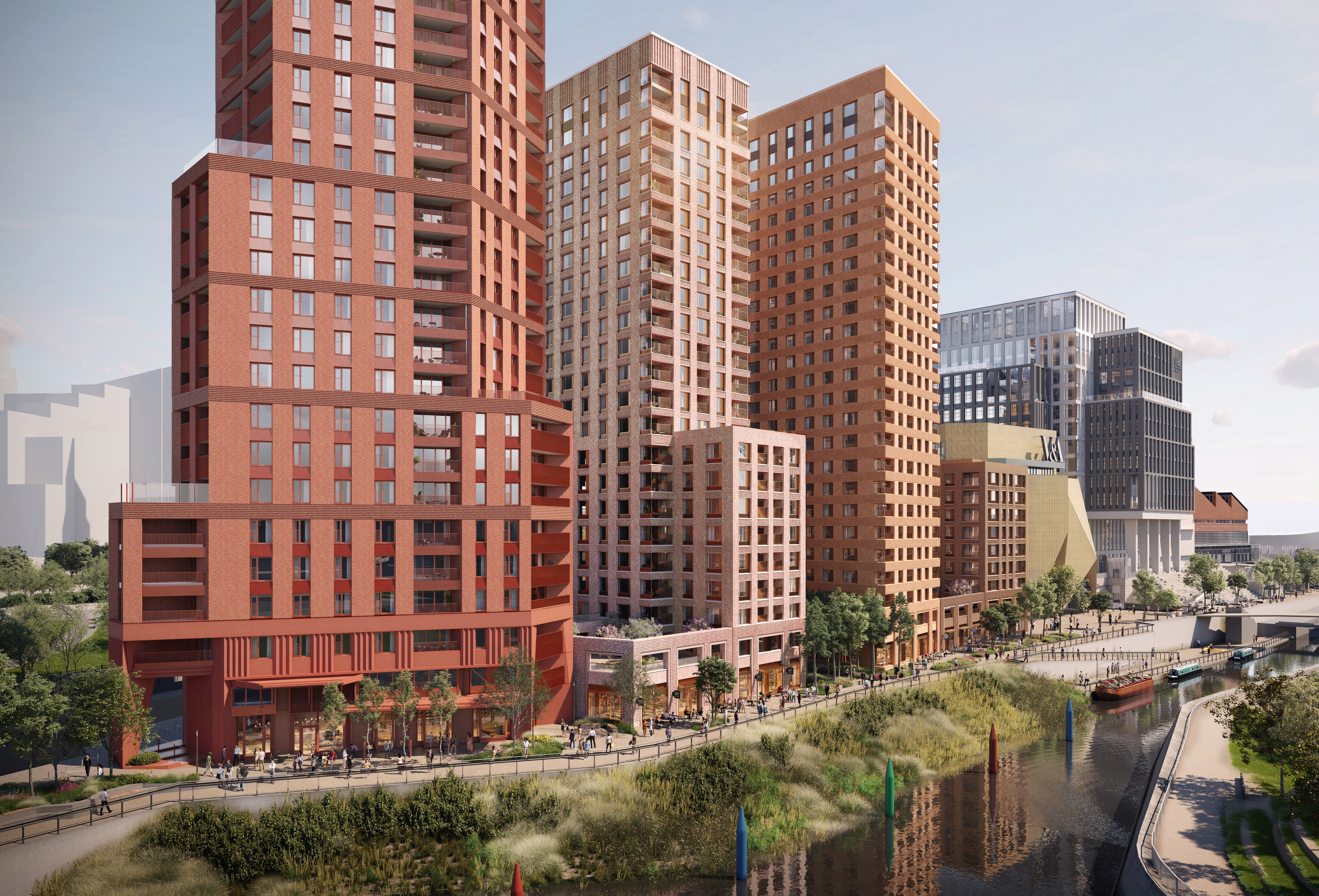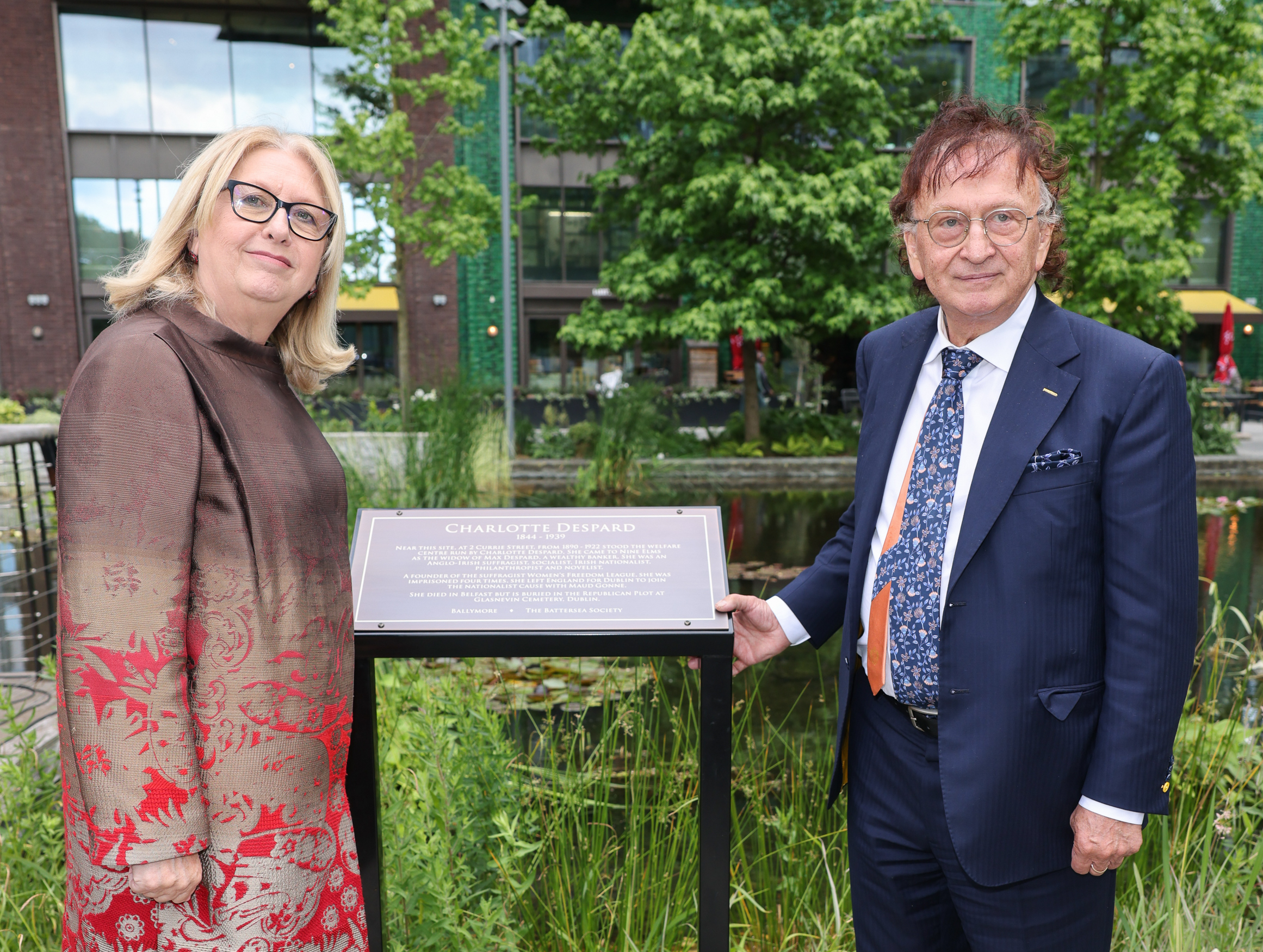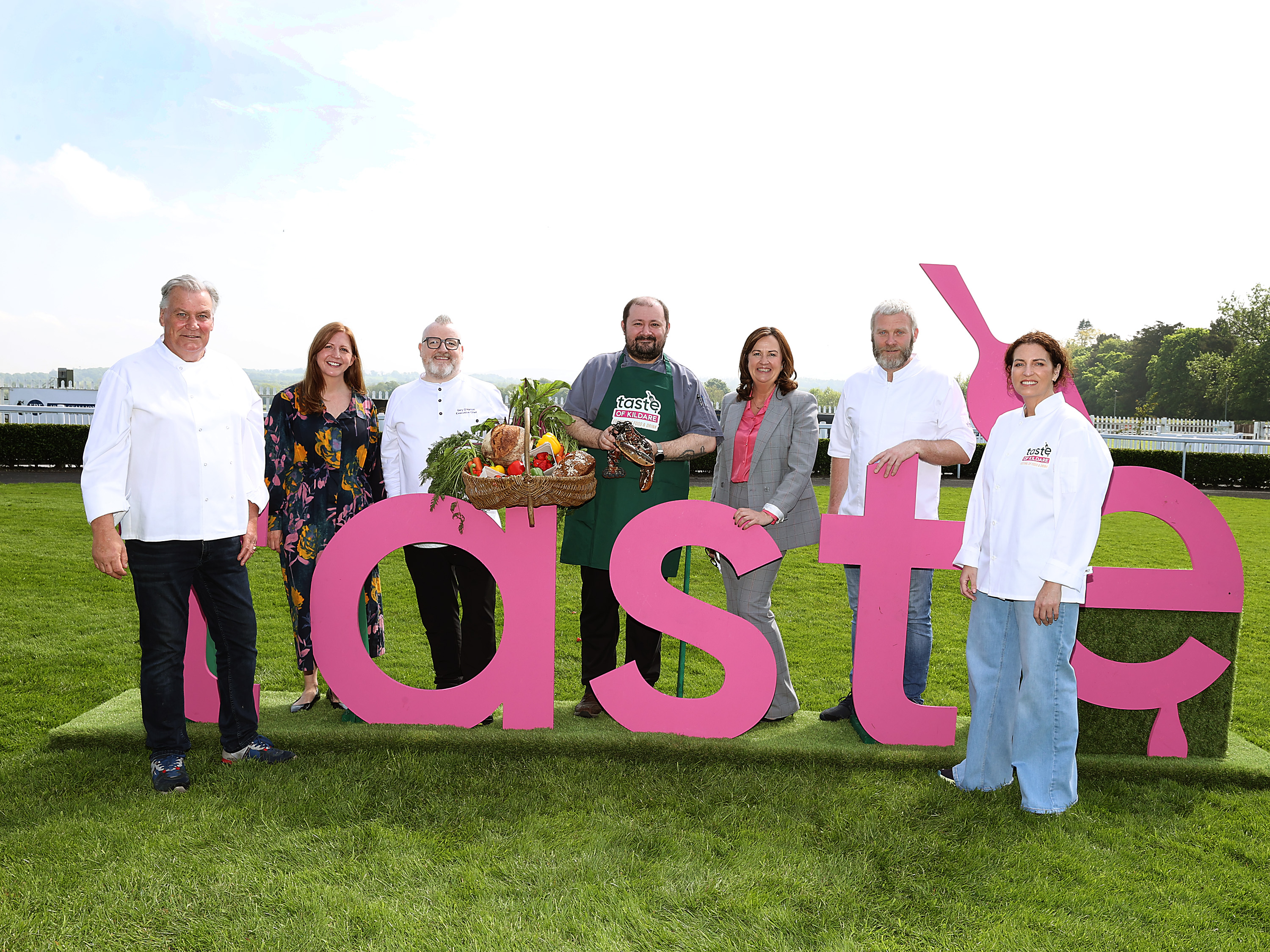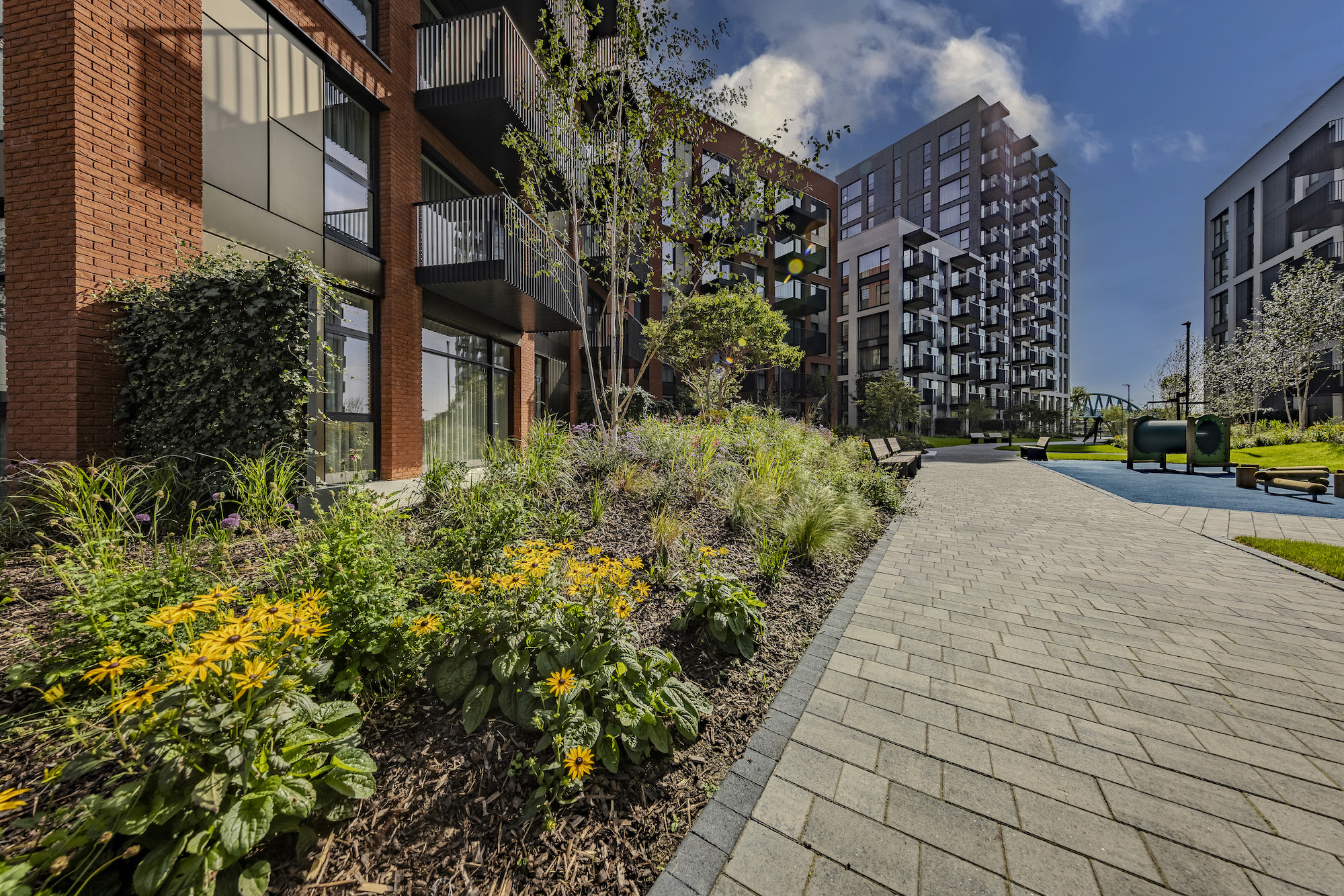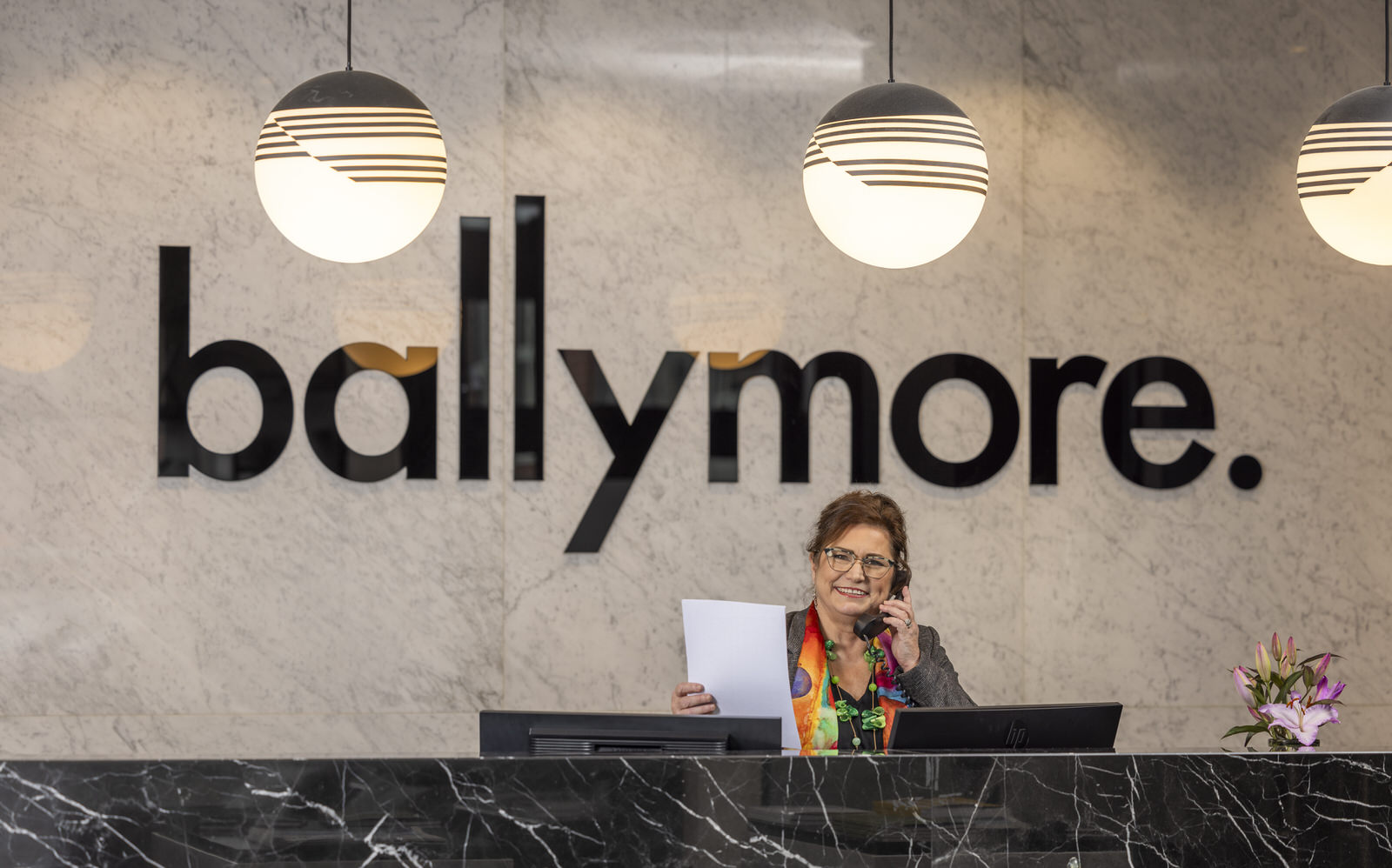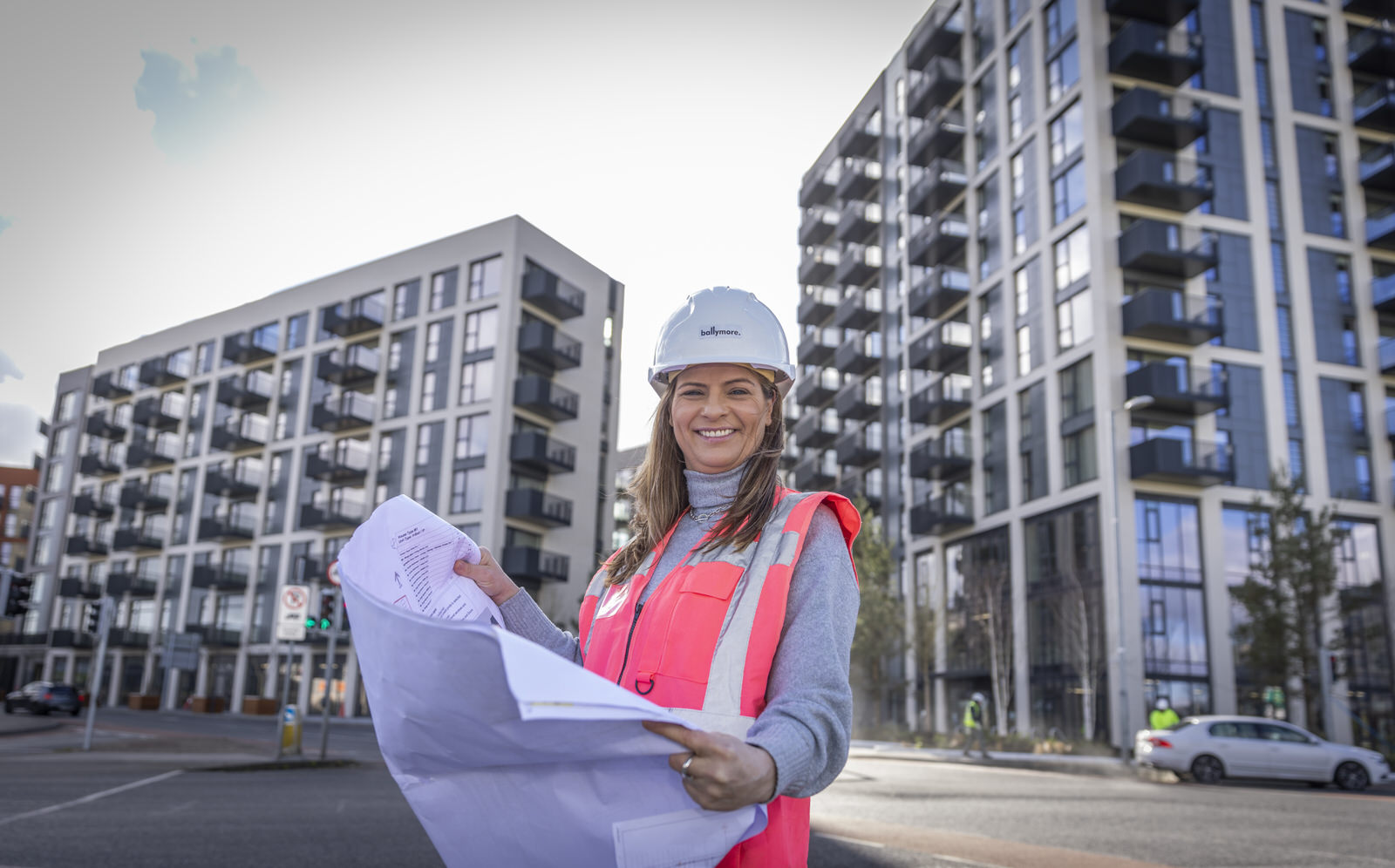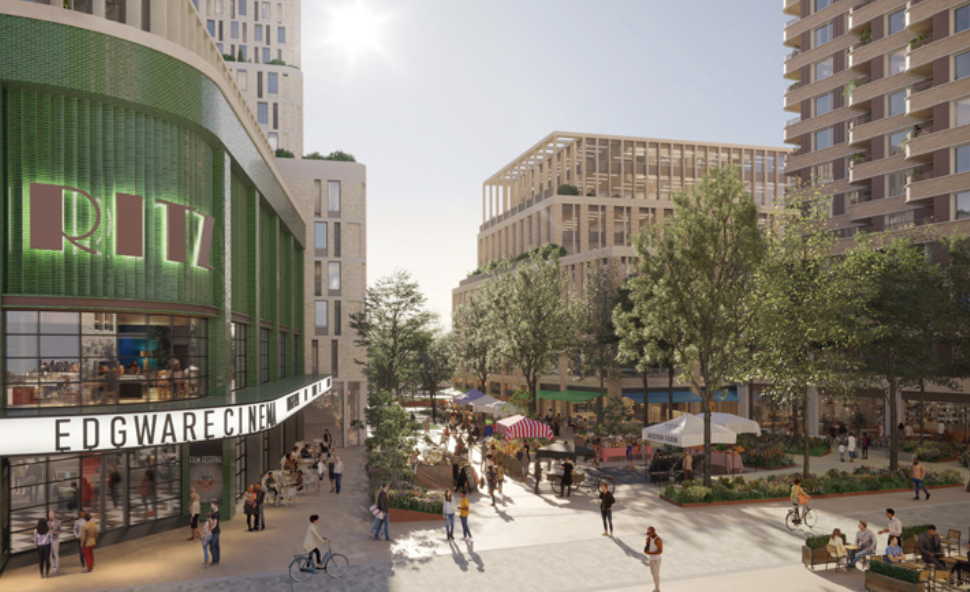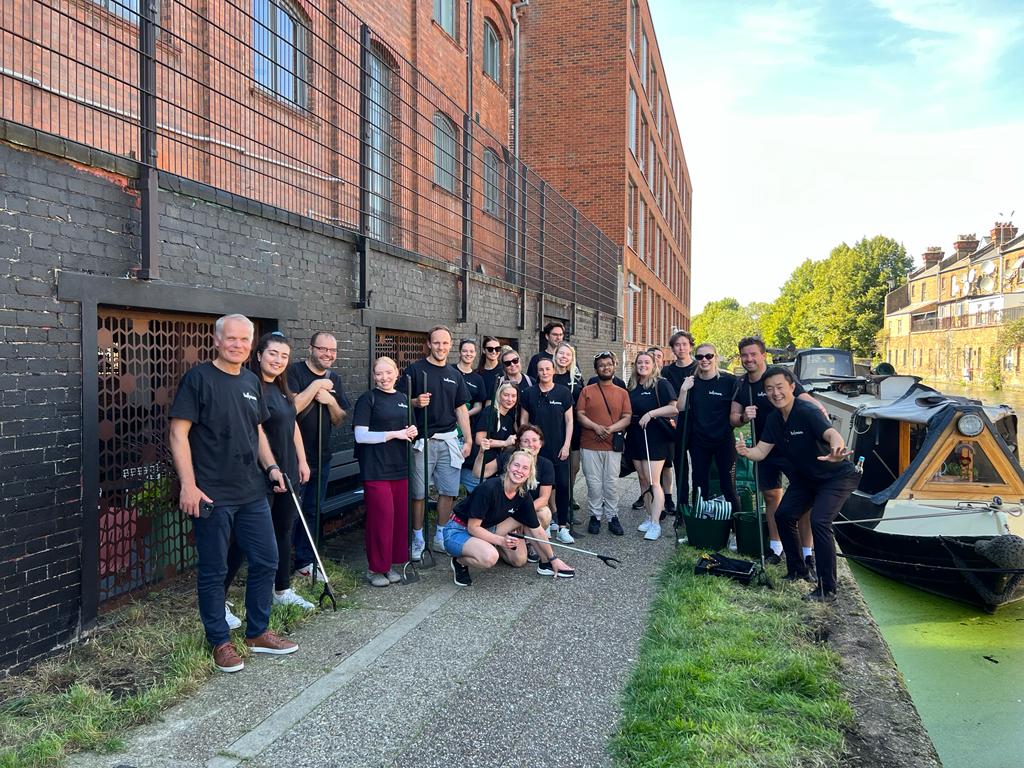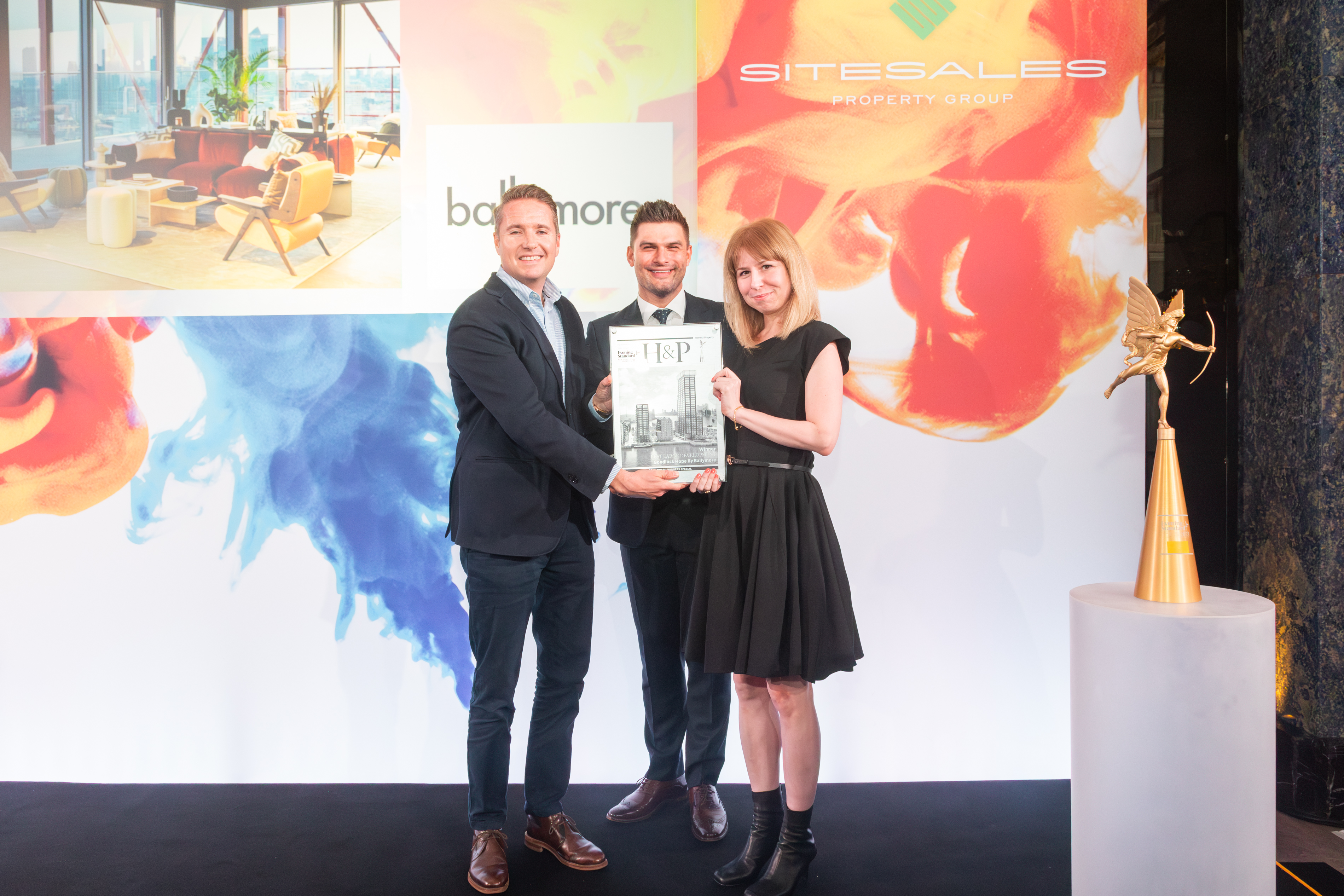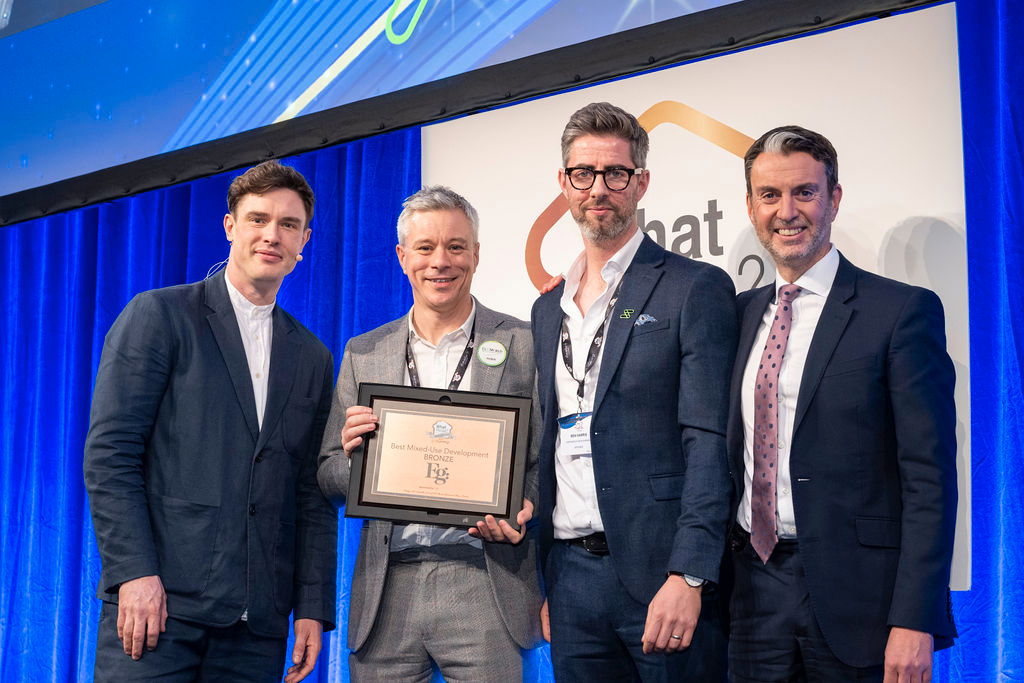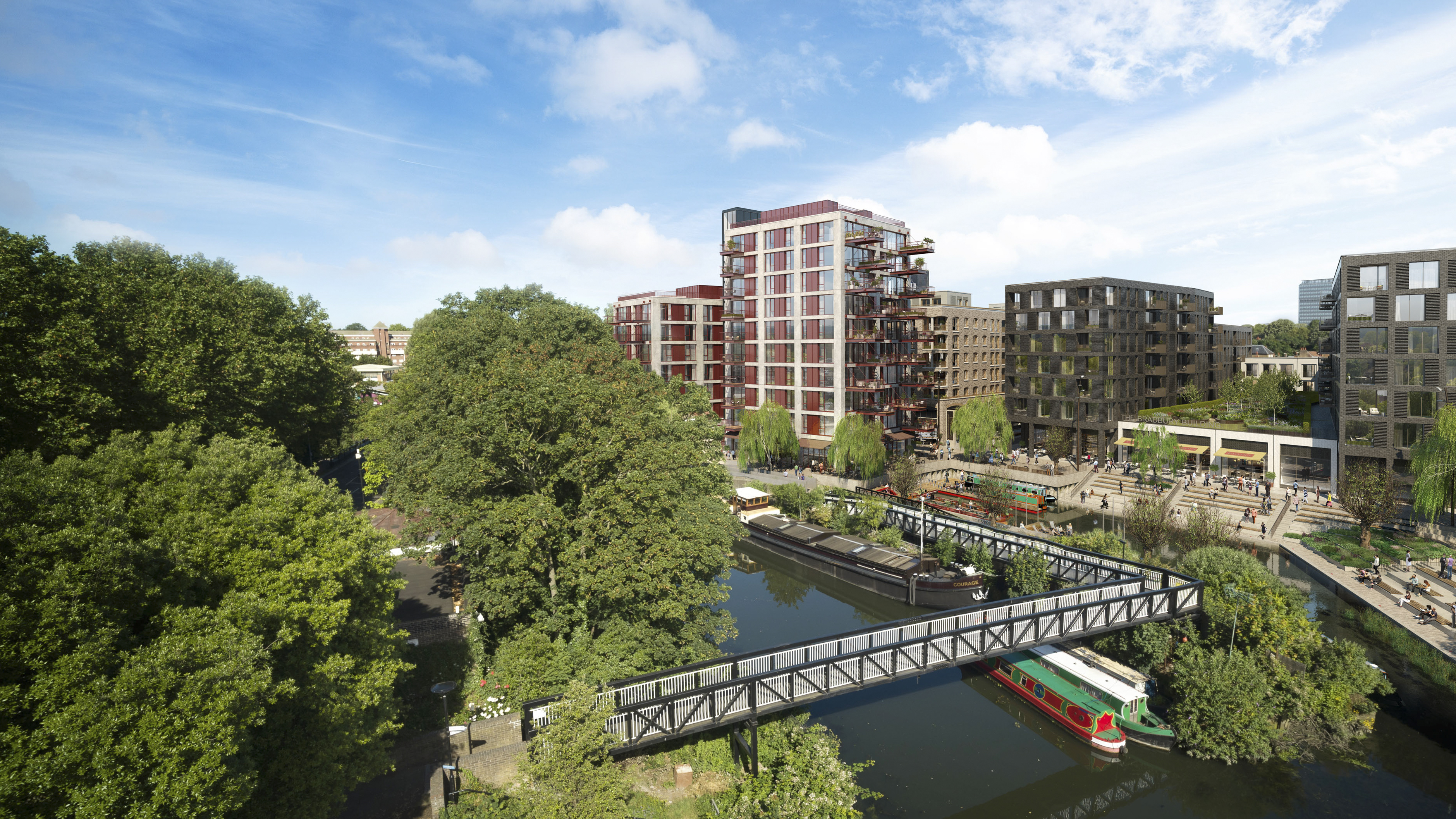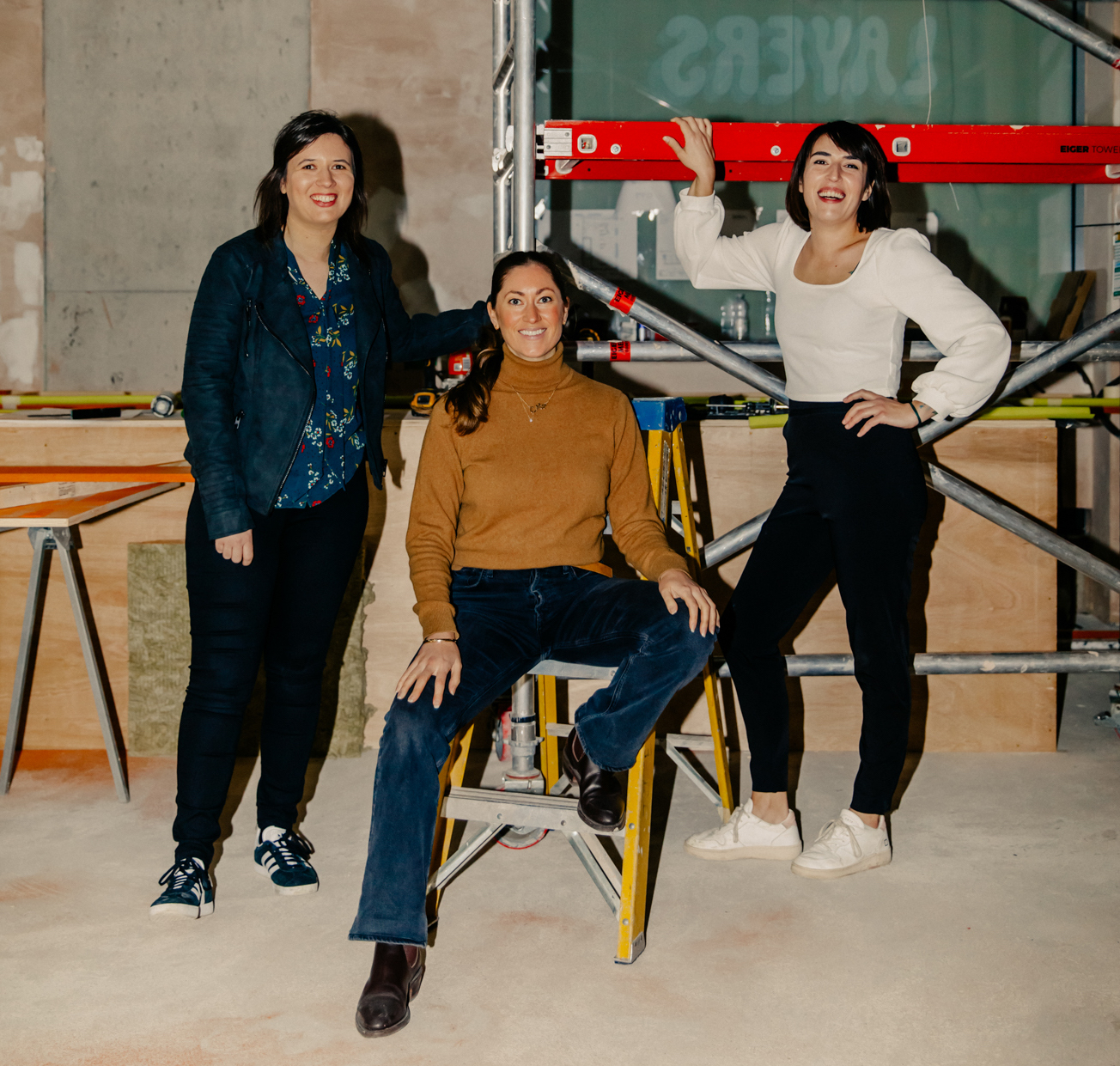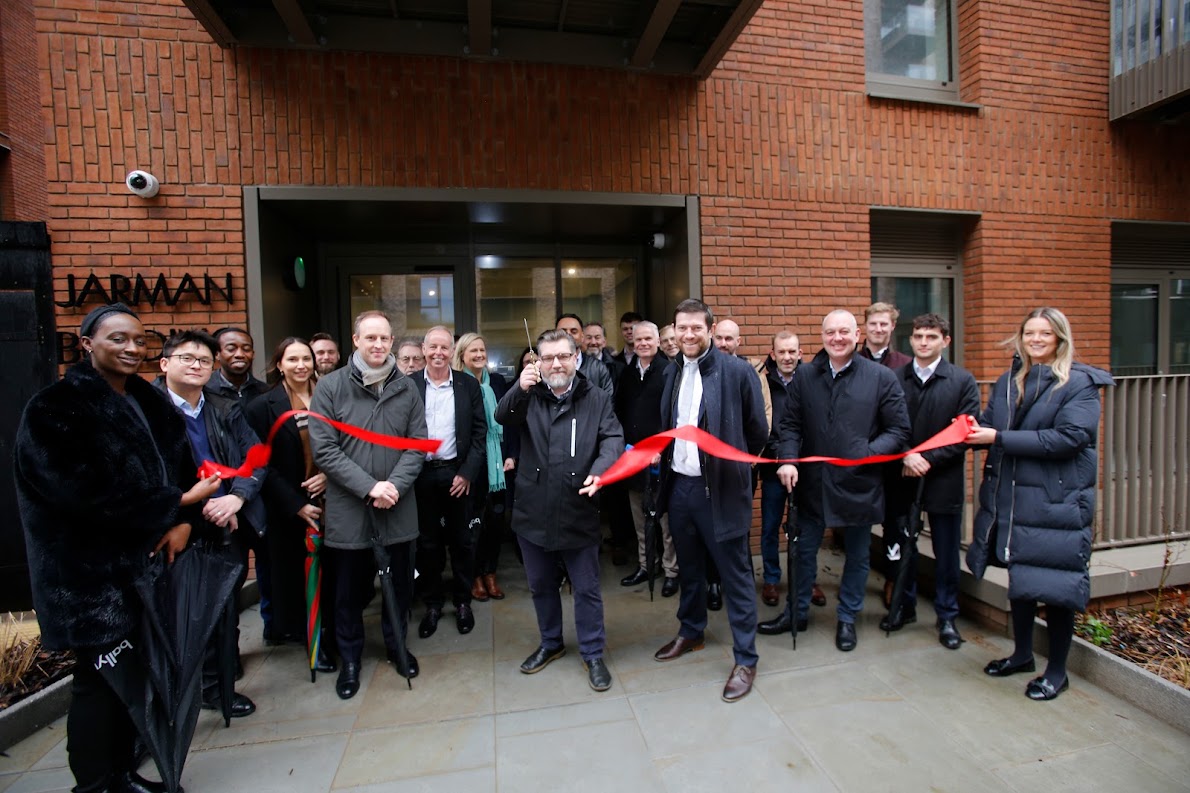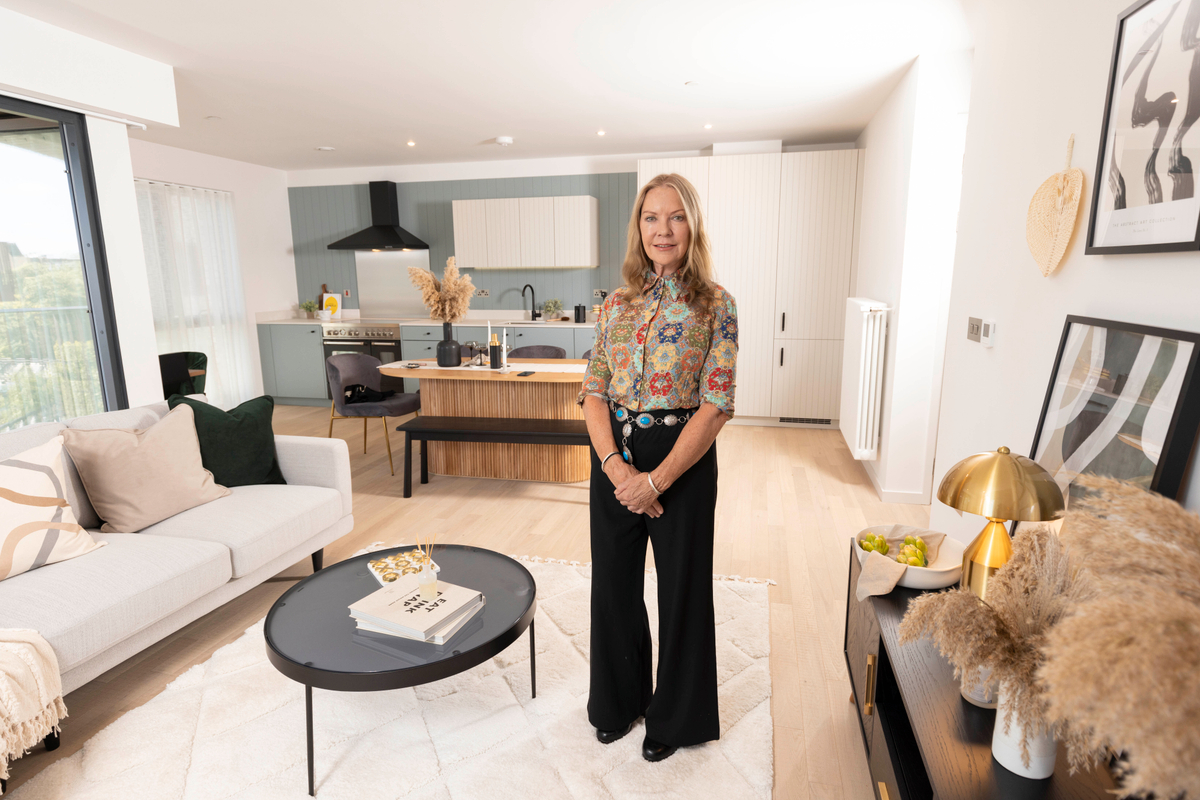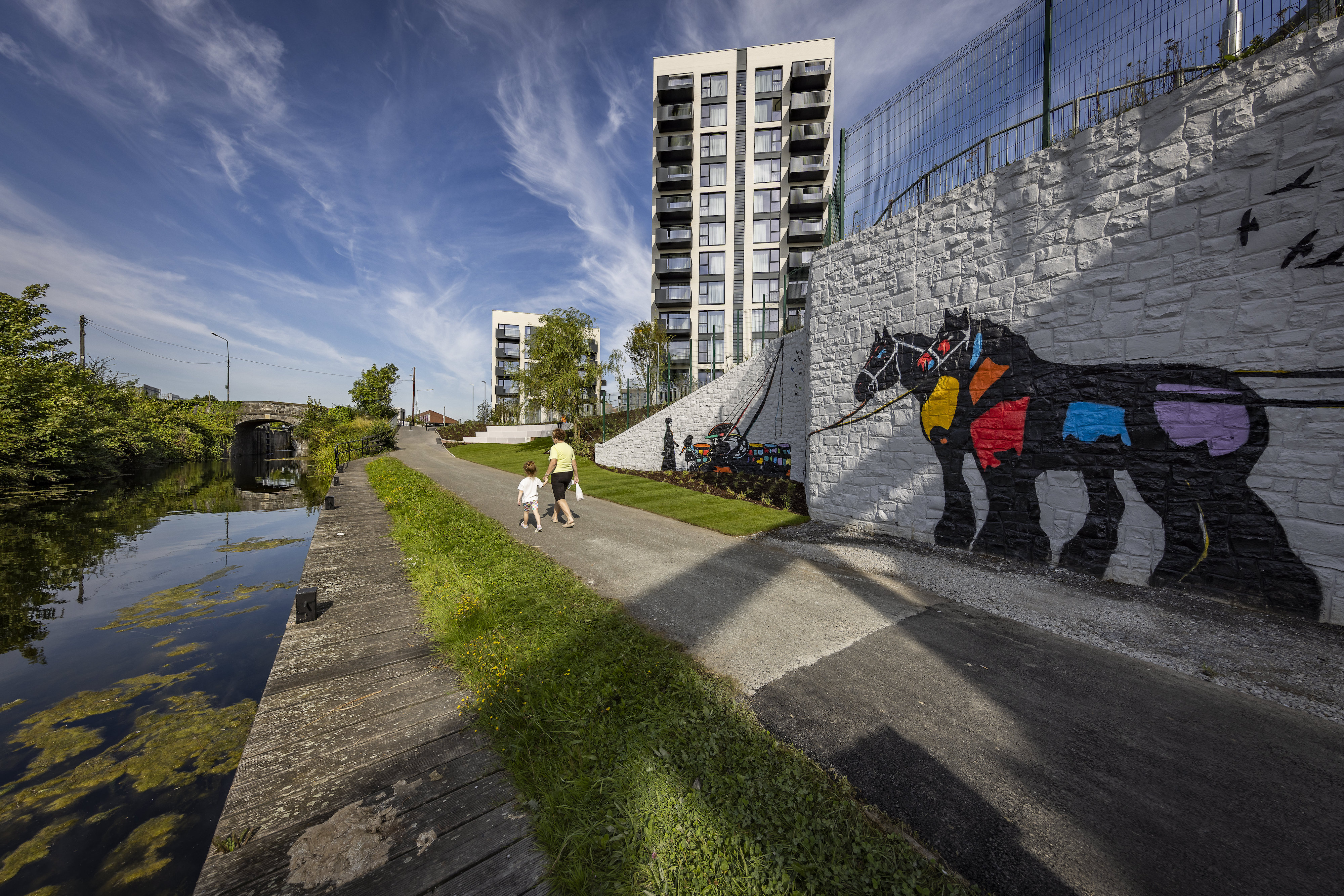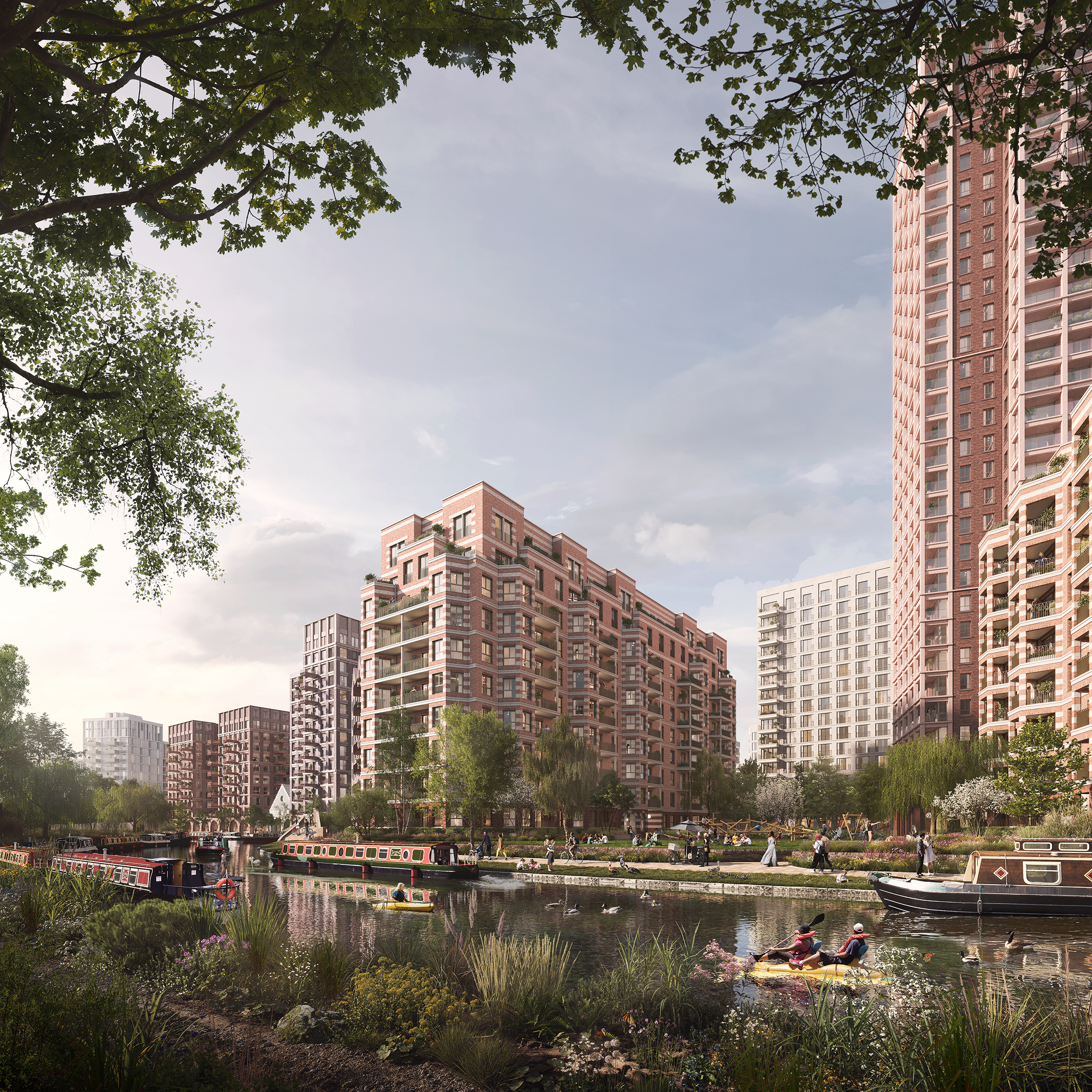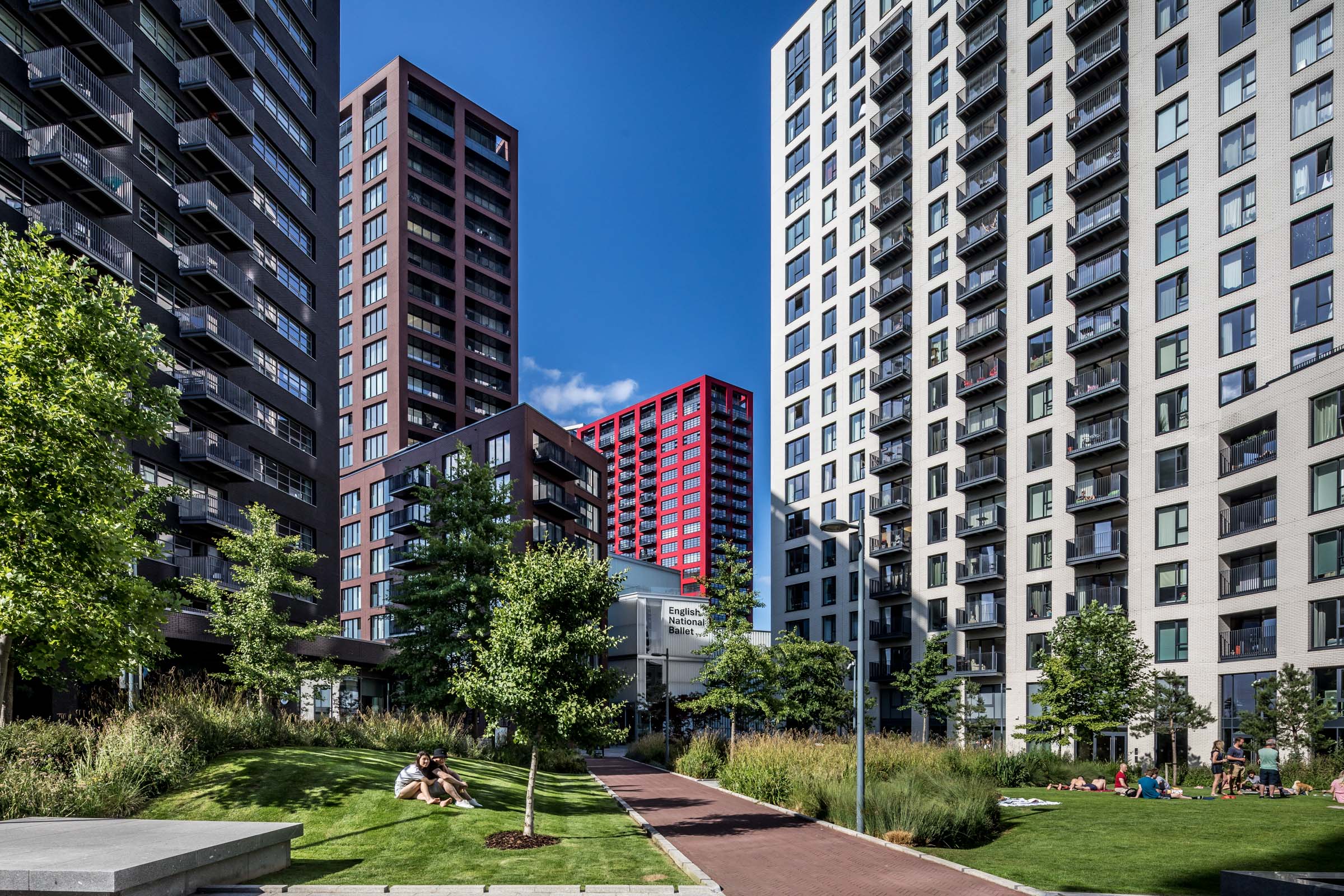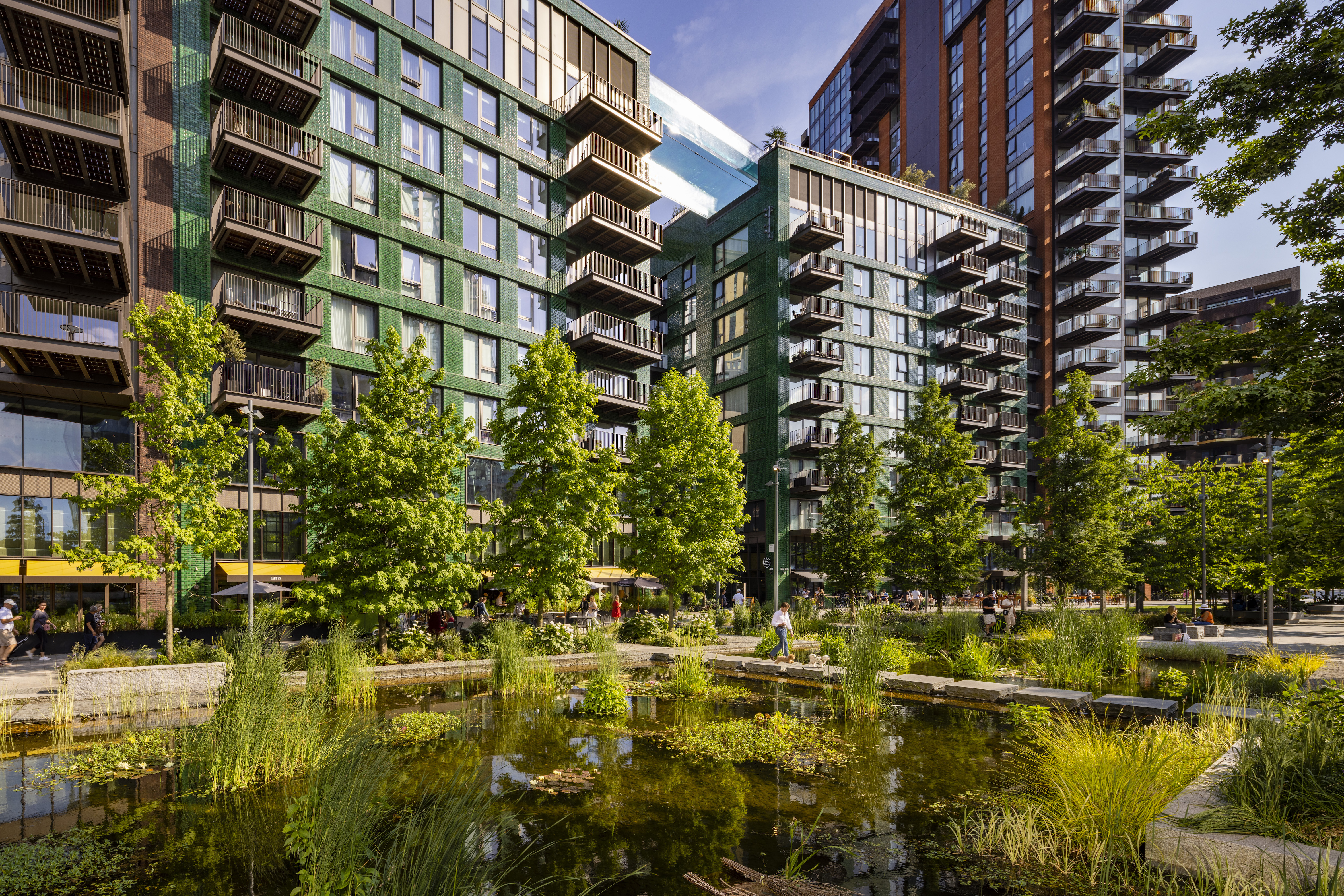A first look at Sea Gardens in Bray
- Ballymore has opened the doors to its newest development in Bray this week, welcoming customers to the development by appointment with agents Savills and Dillon Marshall.
- The new release includes two-, three-, and four-bedroom homes, with interior design features inspired by the local area
- When complete, the 40-acre site will comprise 1,200-homes, 9 acres of open space to include Central Park, Coastal Gardens, The Linear Park and a multi-use games area
- The vast neighbourhood straddles both Dun Laoghaire-Rathdown and Wicklow, with connectivity that will give residents the best of both urban and suburban living, with Dublin just 45 minutes away via the DART
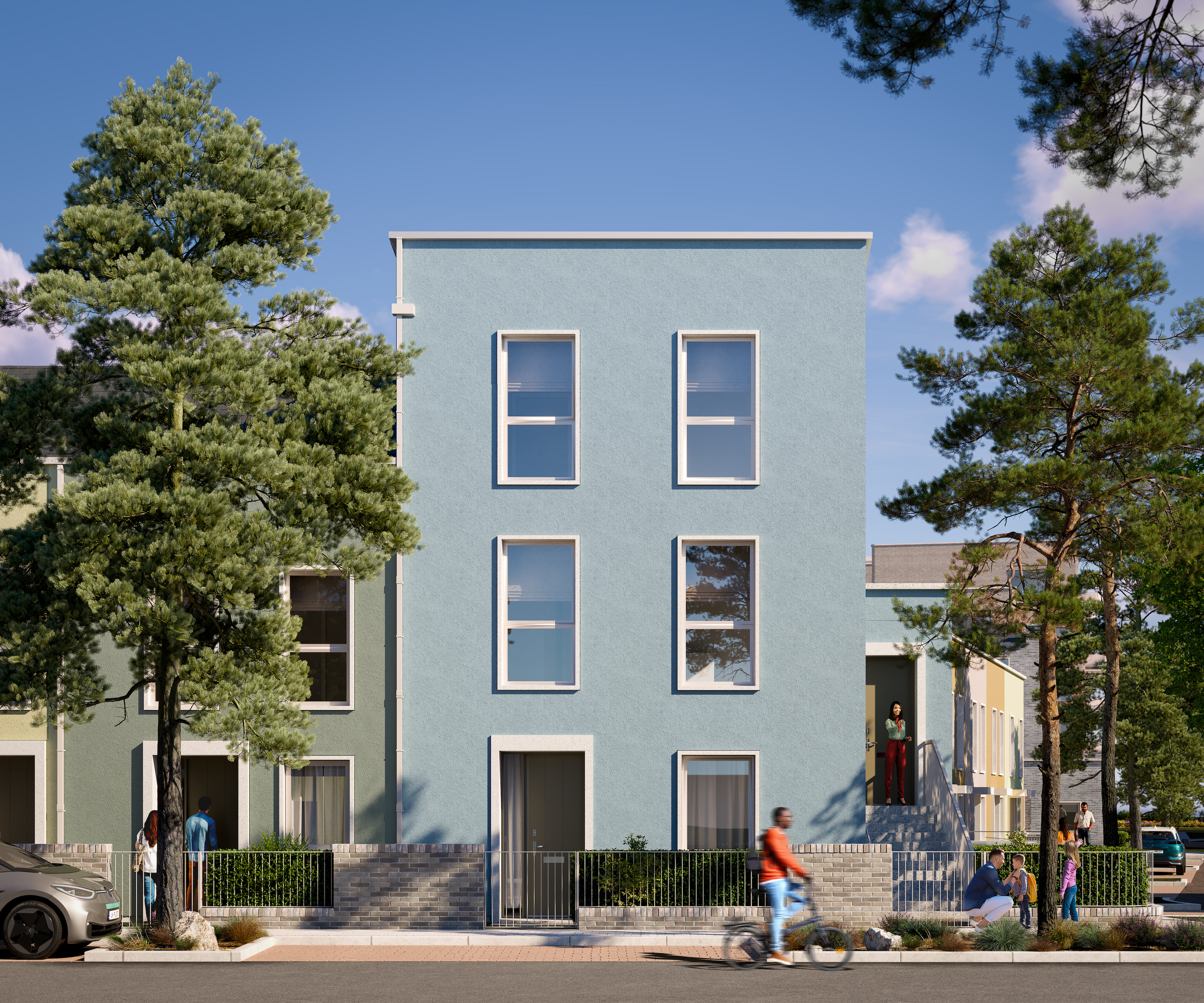
An external image showing one of the homes at Sea Gardens
Customers hoping to secure a new home at Ballymore’s Sea Gardens in Bray can make appointments to visit the first show homes this week, as a new range of properties are released for sale.
Located on the north bank of the Dargle River, close to Bray Harbour and the iconic Victorian promenade, Sea Gardens is an ode to Bray’s historic charm whilst catering to the requirements of sustainable 21st-century living.
The new homes boast views of the Irish Sea in one direction and of the Wicklow Mountains in another. Among those being released this week are the three-bedroom homes; ideally suited for young families, they feature three well-appointed bedrooms, including an ensuite bathroom for the primary bedroom, as well as large kitchen and dinner areas alongside a separate living room.
Ballymore will also release a range of spacious four-bedroom properties offering accommodation over three storeys. All four bedrooms are doubles, with two ensuite bathrooms for the primary bedrooms, as well as a focus on kitchen-living spaces. The homes also feature a study – which can also be used as a playroom or home office – as well as a large utility room, ample storage, and a concealed pantry.
The final homes within this release include two-bedroom apartments, each of which feature a primary bedroom ensuite, ample storage space, with some featuring a home office, as well as a collection of duplex homes, ranging two-bedroom, ground-floor apartments, and three-bedroom duplexes on the first and second floors.
A common theme across all of the homes is their sustainability credentials, with the promise of A-rated homes under the Home Performance Index by the Irish Green Building Council emphasizing Ballymore’s commitment to energy efficiency and sustainable living. The homes also each boast lots of space, with up to 2.7-metre ceiling heights, and great attention to detail – with kitchen colours and tiling that denote the different property types; from the pink hued kitchens of the two-bedroom homes, to the teals and blues that come in the three- and four-bedroom properties respectively, each colour is a nod to the local colour palate.
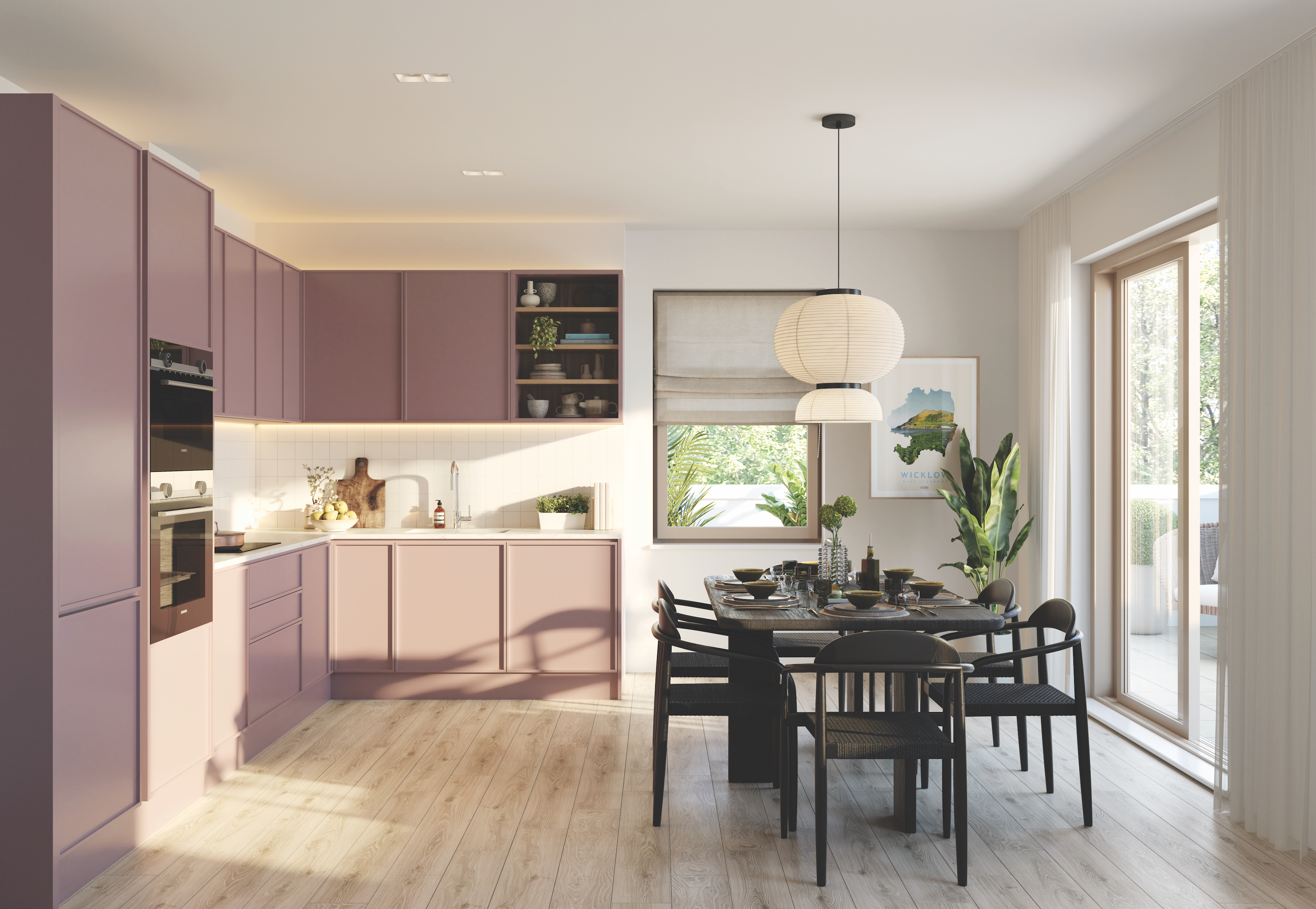
Just one example of Sea Gardens' unique kitchen designs
Externally, the properties are well-thought out, with the houses and ground-floor duplexes featuring private gardens, while the exteriors adopt a series of pastel render, resulting in contrasting streetscapes. Residents will also benefit from bike storage, car parking and EV charging facilities. Linda Mulryan is deputy managing director for Ballymore in Ireland and said: “We are looking forward to welcoming customers through our doors at Sea Gardens, showing them around these well-designed, high-quality new homes for the first time.
“Designs here are very much a nod to Bray’s distinct landscape, and we’ve brought as much of that into our aesthetic in each home. Fresh colour palates have been inspired by Bray itself and are evident in features such as each bathroom’s terrazzo tiling, to the pastel hues of the kitchen units, to the rendering outside.
“We have embraced the local environment to ensure that each property type has its own character, with its own unique story, and we are excited about sharing the intricacies of that with customers later this week.”
Homes in the new release stand adjacent to Sea Gardens’ new multi-use games area and are close to the Market Square; the latter will become a focal point for the neighbourhood, with plans for regular food markets and artisan pop-up events. Residents of this first phase will also benefit from a creche, café, convenience store, and plentiful seating areas, while the entire site boasts a total of nine-acres of public open space, including the five-acre Central Park that will offer landscaped gardens, and informal games courts.
Sea Gardens straddles the counties of Dun Laoghaire-Rathdown and Wicklow, falling on the boundary line between both counties; that distinction has been recognised and subtly integrated at Sea Gardens, with paths and planted areas linking to the adjacent parkland and residential streets. An example include’s the which Linear Park will link Corke Abbey Valley Park to Bray Harbour, and the adjacent Great Lawn which will feature a playground.
Connectivity is also key, with the DART to Dublin City Centre, and access to the M11 and M50 motorways all ensuring Sea Gardens residents will never be too far from where they need to be. The neighbourhood is also close to the centre of Bray, its neighbouring town of Greystones, and is served by high quality education providers from pre-school to primary and secondary schools, several language schools and a third-level institute.
Linda continued: “Sea Gardens is a place for 21st Century coastal living, somewhere we hope will become a great example of a connected, thriving, and happy neighbourhood.”
For further information, please register your interest here.
Related Articles
Ballymore’s homecoming! Back to where it all began, with a sustainable new development
It was 40 years ago, on May Day 1982, that Ballymore opened its first show house at its base in Ballymore Eustace in County Kildare, Ireland – aptly naming the company after the village in which it was founded.
Now, exactly four decades later, Ballymore has launched 80 new homes in Ballymore Eustace. Known as River Walk, the development sits on the banks of the River Liffey and features exciting new sustainable designs. All 80 homes will be energy efficient and built to a top A rating for energy efficiency, with well-insulated walls, floors, and roofs, as well as an air-to-water heat pump system that provides domestic hot water and efficient heating, serving wall-mounted radiators. Indoor air quality levels will be enhanced, thanks to mechanical ventilation.
Linda Mulryan, Deputy Managing Director at Ballymore, said, “River Walk is a long-awaited homecoming for us, some 40 years after starting our journey in Ballymore Eustace. The village has a special place in my heart and our primary goal with this development has been to ensure the village thrives in the future, not just by retaining its magic but by having the capacity to welcome a new generation of local people.”
Much thought has been given to the aesthetics at River Walk – with influences taken from the traditional Irish cottage fused with contemporary features. The architectural styles throughout the development celebrate the diversity of the architecture and work by local artists complements the interiors to demonstrate authentic modern Irish living.
Homes range from two-bedroom cottages with stunning interiors – including black granite worktop finishes in the kitchens, traditional painted panelling, traditional brass and enamel bathroom fixtures, and quality Irish craftsmanship throughout. Grand windows, open-plan living, volumetric space, striking lighting and luxury appliances, such as high quality Smeg fridge freezers, ensure the cottages also celebrate contemporary living.
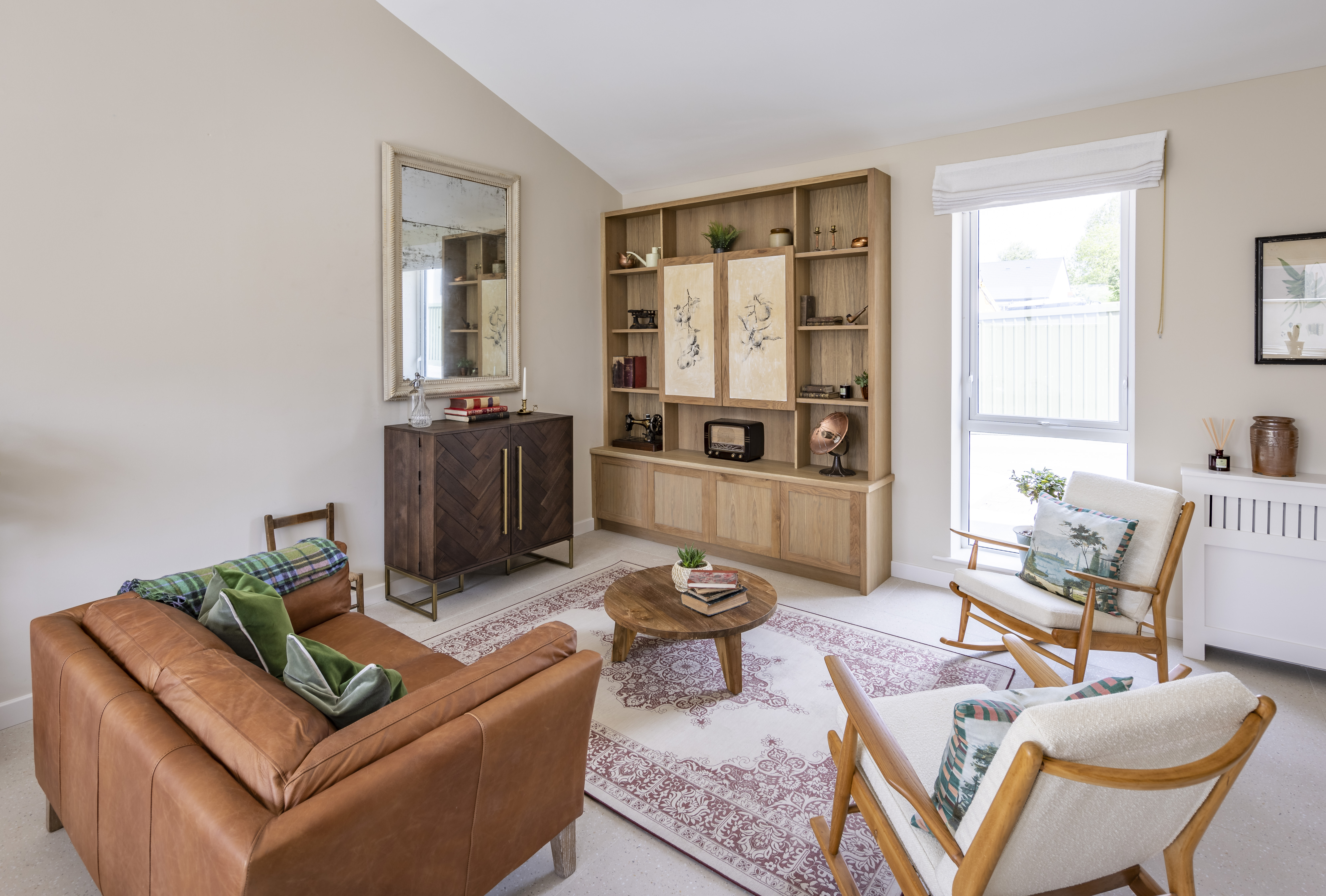
River Walk will also cater for families with a range of three- and four-bedroom homes featuring contemporary kitchens, sliding door options and terrazzo style walling and flooring, as well as feature painted staircase balustrades with solid oak handrails. Linda continued: “As is the standard for all our developments, River Walk homes embody exceptional design and build. We have invested a great amount of time into tastefully integrating the new homes so that they are not only an extension of Ballymore Eustace but also a great addition to the historic village.”
River Walk is located minutes from the centre of Ballymore Eustace – and with Dublin just 45 minutes away. Future residents will benefit from walks and trails along the banks of the Liffey, while on the water, rowers, kayakers, paddle boarders and the odd wild-bather frolic. The surrounding area has a rich equestrian history, so bridle paths and horse facilities are close at hand. The area is home to numerous sporting ovals, outdoor courts, and even a water ski club, so local people can enjoy a range of leisure pursuits. River Walk is also the perfect community for families, with the local school and many of the village amenities just a short walk from the new homes.
The development is ideal for workers who follow a hybrid working schedule and want to embrace the tranquillity of the Irish countryside, while also living within commuting distance of Dublin. Ballymore is home to ‘The Hub’, a fully equipped co-working space in the village, which offers a state-of-the-art boardroom with video conferencing, a private phone booth, collaboration spaces, and photocopy and scanning needs for the modern remote worker. Residents of River Walk automatically become VIP members of ‘The Hub’ for their first year, which offers them the benefit of 30 complementary days to use the hub workspaces, as well as other exclusive discounts and benefits.
You can read more about the development in the Irish Times.
Related Articles
Creating a world first: Sky Pool at Embassy Gardens
The Sky Pool, a global feat of design and manufacturing innovation, has officially opened at Embassy Gardens in London’s Nine Elms. The world’s largest free-standing clear acrylic pool structure sits high above the ground at tenth storey level, forming a transparent aqueduct spanning 15 metres between two new apartment buildings.
The buildings are part of the second phase of the mixed use Embassy Gardens scheme (EcoWorld Ballymore) on a high profile site close to the new US Embassy and the River Thames. The developers brought an international team of experts together to create the pool, working with architects HAL Architects and Arup Associates, structural engineer Eckersley O’Callaghan and US manufacturer Reynolds Polymer Technology. For all involved in the project, the pool’s opening marks the culmination of six years of collaboration to tackle the numerous challenges involved in designing, engineering and manufacturing this highly innovative structure.
The groundbreaking design concept grew out of a conversation between HAL Architects and Ballymore chairman and group chief executive Sean Mulryan. “We were dealing with the practical question of how to put a 25 metre swimming pool on the roof. A single pool of that size would not have fitted on one building,” explains Hal Currey, founder of HAL Architects. “We had a meeting with Sean and the idea of creating the pool as an aqueduct came up and Sean said: ‘If we’re going to do it, then let’s do it properly and make it transparent’.”
The conversation could have ended there. “It was one of those rash ideas that you don’t expect to happen,” says Currey. “But Sean really embraced it.”
Initially, the designers looked at making the pool in steel and glass, but when Eckersley O’Callaghan joined the design team, they suggested using acrylic instead of glass. Acrylic has been used to create some of the world’s biggest and most famous modern aquaria, including a water slide tube through a shark tank in Las Vegas. “The move from glass to acrylic was integral to the project and the final design,” says Currey. “Glass would have involved numerous complexities and fixings. Acrylic allowed us to get rid of a lot of architectural hardware. In terms of clarity and transparency, it allowed us to get close to the original idea. But we didn’t know when we created the first image of the design that it would be possible to use acrylic.”
That first computer generated image showing a view from the ground up to a clear blue pool had been published in the Evening Standard newspaper in London in 2017, exciting global interest. “The intention was to keep the design simple. It had to look as transparent as possible and appear as effortless as possible,” says Currey. Acrylic offered aesthetic benefits as it appears colourless, its refractive index would give the impression of it blending with the water and joints in the structure would not be visible. An acrylic pool would still, however, be complex to design and build. “We faced a combination of challenges: the transparency, the acrylic and spanning the two buildings,” explains Currey.
The final design comprises a 15 metre long acrylic section sitting in steel ‘tubs’ at either end, the tubs providing a base for the pool and also housing the pool steps and essentials such as cleaning equipment and lighting. Bridge bearings under the tubs allow the pool to move as the two buildings on which it sits move. The only other steelwork in the pool structure is the two discreet post-tensioned rods running under the side walls, which help secure the tubs to the acrylic without needing to drill into the latter.
Colorado-based expert in acrylic fabrication Reynolds Polymer Technology played a crucial part in refining the design. Currey gives one example: “The original design had two downstand acrylic beams, but they were removed as the construction evolved. So the pool actually became more aligned to its original design concept.”
The fabricator had to refine its own quality and fabrication processes – and temporarily extend its production facility – in order to deliver the large and exacting project. “Building a pool for London in Colorado was not the easiest thing to do. We were very much in Reynolds’ hands,” says Currey. The pool floor is made of seven cast acrylic panels, joined to create the 15 metre span, and has 3.2 metre high side walls. The overall structure contains 148,000 litres of water, giving a depth of 1.2 metres.
‘If we’re going to do it, then let’s do it properly and make it transparent’

Delivering this project has inevitably been a long and testing process. “There were many times when I thought it wouldn’t happen,” admits Currey. Now that it is complete, he says, “I’m fairly amazed it’s there. I feel a mix of relief and a sense of achievement. The most gratifying thing is that it looks better than it did in the early computer generated images.”
The pool has an obvious value to its location, says Currey. “There are all sorts of things it brings to Embassy Gardens – people talk about it and want to know about it and you hope there will be a social value as a congregation point for residents.” Embassy Gardens’ Sky Deck bar and restaurant on either side of the pool maximise the pool’s social potential.
For the construction industry, the project has value in adding to understanding of the application of non-traditional materials like acrylic. Currey also praises Sean Mulryan for remaining true to his initial vision. “In our industry we are so used to seeing designs value engineered,” he says. “It is not often that you have an idea that gets so fully supported by the client in this way.”
Related Articles
Ballymore to partner with Diageo to create Guinness Quarter
Global drinks giant Diageo has named Ballymore as its development partner to create a visionary neighbourhood for living, entrepreneurship, creativity and commerce at the St James’s Gate site of the Guinness brewery in Dublin. The move will see an iconic site with a rich heritage become a standard bearer for the city’s future, as Dublin’s first zero carbon district.
Diageo began its search for a development partner in 2017 and selected Ballymore following a rigorous selection process. Oliver Loomes, Managing Director of Diageo Ireland, said, “Since our announcement in 2017 we have been committed to doing it right and know that Ballymore share our vision for the future of the site. We look forward to partnering with them on this exciting project. Our ambition is also to work with the Iveagh Trust, one of Dublin’s largest social housing providers, as a partner in this project.”
Ballymore comes to this project with a track record in such complex regeneration developments as London City Island and Old Spitalfields Market, in London. Ballymore Chairman and Chief Executive Sean Mulryan said, “We are truly honoured to have been chosen as Diageo’s development partner for the Guinness Quarter. With 40 years of experience in delivering complex urban regeneration sites, in city centre locations across Europe, we are confident we have the team to deliver. I am looking forward to leading the team in bringing this special place to life.”
Diageo and Ballymore will now work with the local community and stakeholders to develop the shared vision for the regeneration of the 12.6 acre site. “It is unusual for a drink to mean so much to so many, but Guinness has become far more than a brand. It has become a symbol for Ireland: an icon of heritage for people all over the world,” continued Mulryan. “St James’s Gate has over 260 years of history, and so, we have a unique responsibility to ensure that when that famous gate opens, it opens to a place synonymous with good times and memorable experiences.”
Opening up the site’s gates to welcome in the public is one aspect of the regeneration vision, alongside the creation of new public spaces for this area of the city and preserving and breathing new life into valued heritage assets. The zero carbon ambition will see existing buildings assessed for potential re-use and renewable energy potential explored. “Working together, Diageo, Ballymore, the local community and Dublin City Council will establish a new part of Dublin City for future generations, that supports Ireland’s growth economically, socially, and culturally,” said Mulryan.
The St James’s Gate brewery has been the home of Guinness since 1759 and was once known as a ‘city within a city’, which boasted its own railway line, medical department and fire brigade. Under the regeneration, the site will remain at the heart of the local community, while also boosting the regeneration of its Liberties area location and the broader city.
The Guinness brand’s links with its historic home will also very much remain, as Diageo Ireland’s Loomes explained: “Diageo will continue to be present in the area as our Irish headquarters will be located at St James’s Gate, alongside our brewery, the new Roe & Co distillery, the Guinness Storehouse and the Open Gate Brewery. This demonstrates our confidence and commitment to the Guinness Quarter.”
Related Articles
Royal Wharf Pier realises vision for sustainable travel
London’s newest Thames pier was opened to the public this week and appropriately provided the location for Transport for London (TfL) to announce its new strategy aimed at expanding the river’s pier network.
The new pier at Ballymore and Oxley’s Royal Wharf is London’s longest and the 23rd serviced by the Thames Clippers riverboat service. The cutting edge design with its grey painted steel structure and distinctive copper-coloured balustrading was created by architect Nex and has already been recognised in this year’s New London Awards. The structure was built in Holland and transported some 300 miles by water to its final location, alongside the burgeoning community at Royal Wharf.
Local residents and visitors can now all enjoy the pier’s promenade and glazed viewing platform, taking in the sights and sounds of the Thames. But above all, the pier makes a key contribution to sustainable travel in east London, bringing popular destinations within easy reach. Residents from Royal Wharf and the wider Newham community using Royal Wharf Pier will be able to travel via the Thames Clipper to Canary Wharf in just 23 minutes, while the Tower of London is 34 minutes away.
The new pier could be the shape of things to come. The new Passenger Pier Strategy sets out how TfL, the Port of London Authority, boat operators and other stakeholders plan to double the number of trips taken by river each year to 20 million by 2035, reducing car use and freeing up capacity on other public transport. Heidi Alexander, Deputy Mayor for Transport said of the launch of the strategy: “The Thames is one of London’s major assets and our Pier Strategy will enable us to maximise its potential fully. By improving our piers and making them more accessible and appealing, we will encourage many more Londoners to travel by river – helping reduce car use, ease congestion and improve air quality.”
"This isn’t just a new build development for the people that live here, it brings a lot for the whole borough."
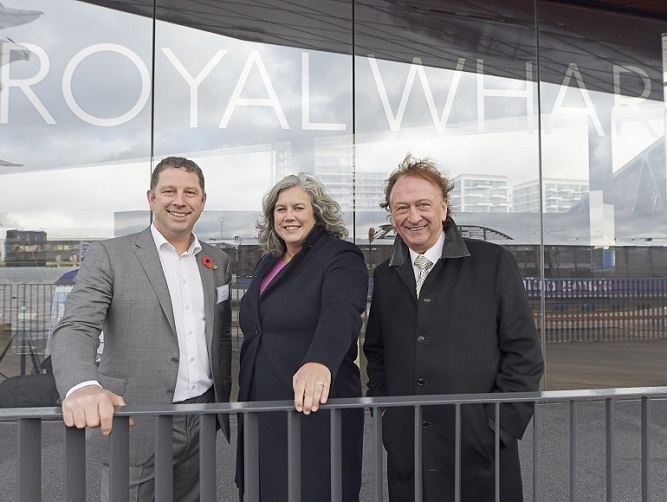
Sean Collins, Thames Clippers, Heidi Alexander, Deputy Mayor for Transport, and Sean Mulryan, at the pier's launch day
The strategy proposes that TfL and the Port of London Authority encourage the delivery of more privately funded, developer-led piers to help increase passenger potential. Robin Mortimer, Chief Executive of the Port of London Authority, said: “This new strategy is a key step in continuing safe and sustainable growth in passenger use of the River Thames – whether that’s for Londoners, UK or overseas visitors – the river offers something for everyone. Investment in modern and attractive passenger piers is central to that future growth and great customer experience.”
That could see more developers following the example being set at Royal Wharf, providing homes and sustainable travel in an integrated approach.
Sean Mulryan, Chairman & Group Chief Executive, Ballymore, said: “The new pier having launched for public service is an incredible achievement for all involved, and a great addition for Royal Wharf and Newham residents. We are delivering 3,385 new homes here in east London – which is in essence a new town, ultimately for 10,000 residents across 40 acres. This isn’t just a new build development for the people that live here, it brings a lot for the whole borough. The vision for the neighbourhood is being realised here, with the Royal Wharf Community Dock now open too, plus an NHS health centre, new nursery and primary school all on the way.”
Related Articles
The 2025 Edgware Community Fund is live
Ballymore is proud to announce the return of the Edgware Town Centre Community Fund for 2025, offering vital support to local initiatives across Edgware.
Building on the success of last year’s fund, which saw £26,900 awarded to a diverse range of community projects, this year’s fund will continue to make a positive impact across the town.
In 2024, the fund supported 12 local groups, including Unitas Youth Zone, FUSE Youth Group, the Mill Hill Community Choir, The Hive Foundation, and the Stonegrove Community Trust. This year, grants of up to £3,000 are available to help local initiatives thrive and make a lasting difference in the community.
The Edgware Town Centre Community Fund is an integral part of Ballymore’s commitment to transforming Edgware – a project which will rejuvenate the town centre with 3,365 new homes – 1,150 of which will be affordable – a new Town Square, improvements to the high street, better public transport links, and enhanced green spaces.
Simon Ryan, Director at Ballymore, shared his excitement about the return of the fund: “We are thrilled that our Edgware Community Fund is back for another round in 2025. There are so many excellent local organisations in Edgware, many of whom we are lucky enough to work with already, that make a real difference to the area. The additional funding will build on our successful first year of the community fund in 2024, which provided nearly £27,000 in funding to support activities from youth groups to food banks, a community choir to cooking classes. We are looking forward to seeing this year’s applications in the coming weeks and encourage all local groups to apply.”
The Edgware Town Centre team is inviting local organisations to apply for funding, which is a key part of the broader development project. Applications are open now and can be made via email at edgware@ballymoregroup.com to request an application form. Alternatively, you can complete the form online here.
Applications will close at 23:59 on 27th April 2025. Applicants with any questions regarding the fund or the application process, should get in touch via email at edgware@ballymoregroup.com.
Related Articles
Camley Street engagement programme now launched
A comprehensive programme of engagement is now underway in Camden, following Ballymore’s appointment to deliver the Camley Street project in partnership with science and tech developer and operator Lateral, and Camden Council.
The event, on 15 March, was the first in a series of drop-ins, workshops, co-design sessions and further engagement opportunities that will be held over spring and summer.
Plans involve the creation of a new, greener neighbourhood in Camden with new public open spaces and improved biodiversity. Around 350 new, energy-efficient homes will be delivered, more than half of which will be genuinely affordable, along with some 200,000 sq ft of Knowledge-Quarter-led commercial space, new shops and cafes, improved pedestrian and cycle routes to Kings Cross and Camden Town and creative workspace to support start-ups and SMEs.

Supported by design and architecture studio, make:good the March event was well attended and allowed people from the local area to meet members of the project team for the first time, building on the Council’s longstanding engagement around the future of Camley Street.
Children’s activities on the day focused on STEAM, in line with the vision for the new neighbourhood to bring inspirational science and tech-based learning to the existing and new community.
These events highlight how community engagement will be at the heart of the Camley Street masterplan, as Nicola Zech-Behrens of Ballymore explains: “With our partners, we are delighted to have launched our engagement process and are looking forward to evolving our plans for the Camley Street site in close dialogue with the local community.
“Guided by the vision that was co-created by local residents and Camden Council over the last few years, we’re developing that into a detailed plan to provide homes and jobs in a green, safe neighbourhood. By listening and collaborating, we aim to create a neighbourhood that delivers real benefits, from new jobs and training opportunities to enhanced public spaces.”
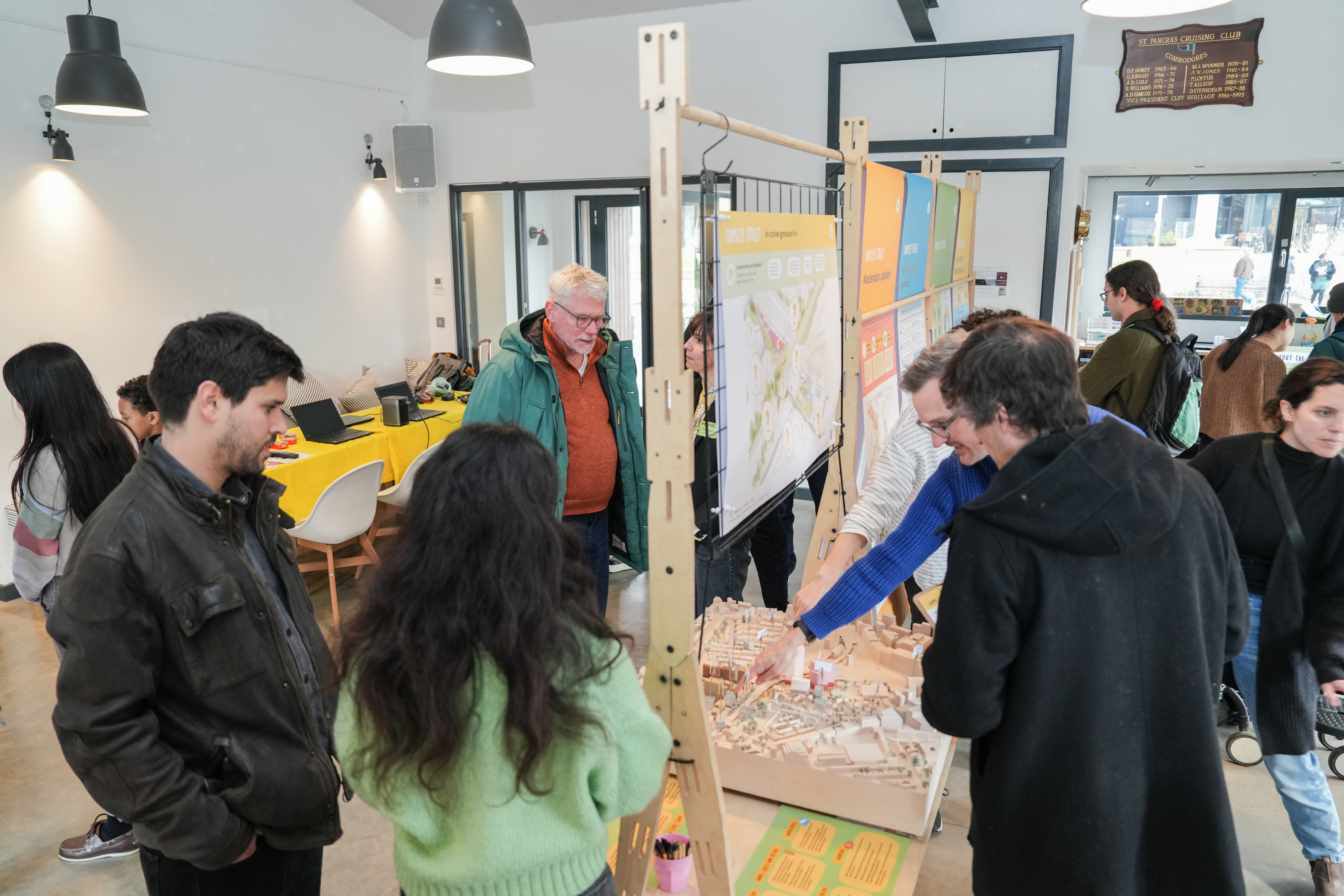
The engagement activity continues later this month with our community storytelling project that will offer paid opportunities for local young people to document life around Camley Street through filmmaking, videography, photography, and archiving.
A design drop in event will take place on 26th April, at the Maiden Lane estate, offering people a further opportunity to get involved in shaping the future of Camley Street.
These will be followed by the Camley Street Festival held on 14th June. Now in its fourth year, this family-friendly summer street takeover will bring together local makers, businesses, artists, community groups, and Camden Council teams to celebrate the area and its people.
If you would like to get involved and stay informed as our plans evolve, please visit our website, or take a look at our online survey. You can also follow us on Instagram to share your thoughts and ideas.
Related Articles
Ballymore is Irish Housebuider of the Year
We’re proud to share that Ballymore has been named Irish Housebuilder of the Year at this year’s Irish Building and Design Awards, held in Dublin.
The annual event celebrates the very best of Ireland’s construction and property sectors, with Ballymore awarded the top accolade in housebuilding, a recognition of the high standards we continue to set across our communities.
Over the past year, we have delivered several significant projects across the country – including Drumnigh Oaks in Portmarnock, where we unveiled our very first Passive House-standard homes, setting a new benchmark for energy efficiency. In Ballymore Eustace, we completed a further collection of new homes at River Walk, continuing to grow this thriving neighbourhood, while in Bray, we launched Sea Gardens, a brand-new coastal community designed to bring contemporary living to one of Ireland’s most scenic settings.
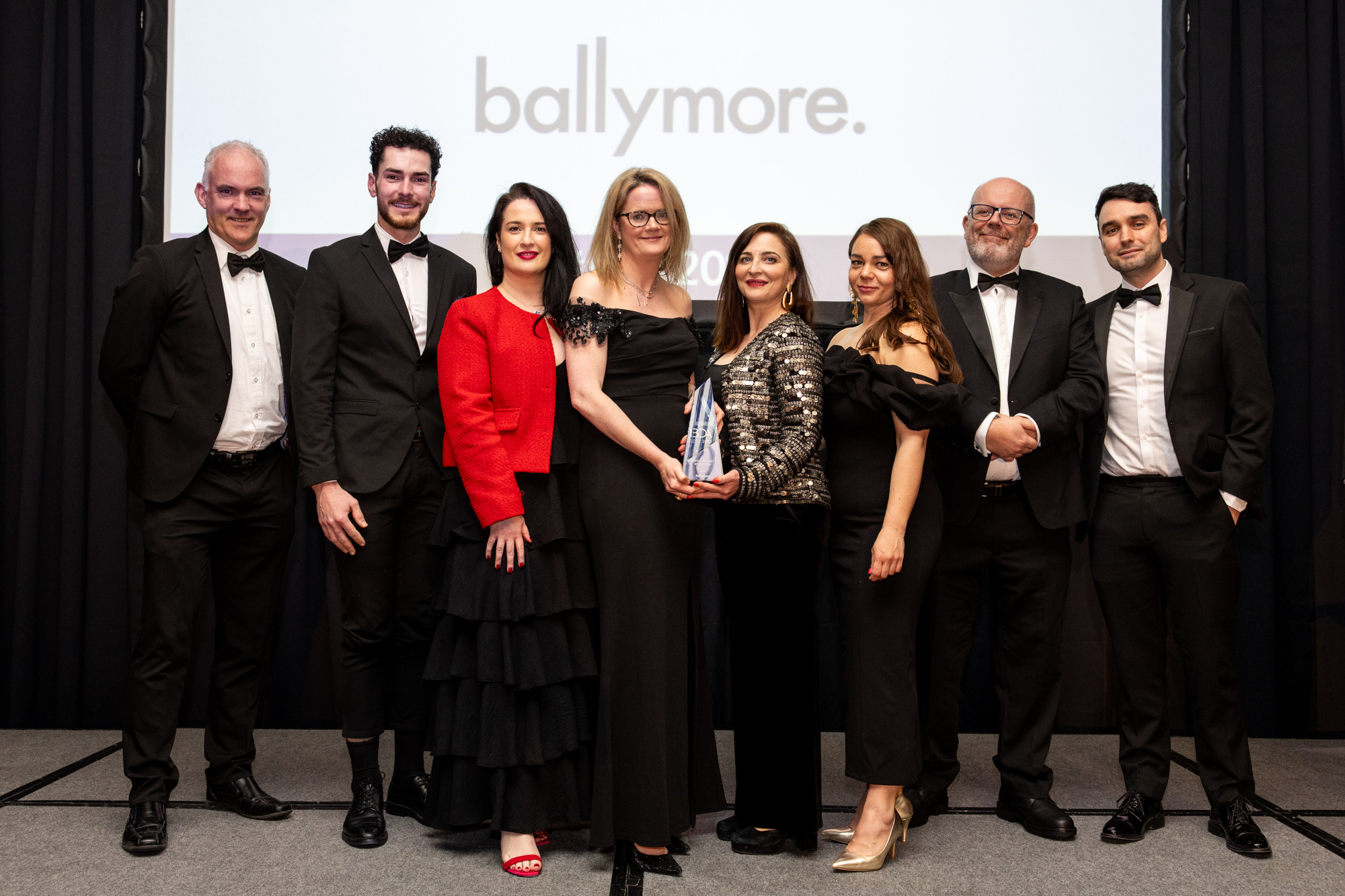
Speaking about the win, Pat Phelan, Ballymore’s Managing Director in Ireland, said: “This award is a fantastic endorsement of the hard work and creativity of our teams. Every Ballymore development starts with a simple principle – to create places people genuinely want to live. It’s rewarding to see that work acknowledged at a national level.”
The award follows closely on the heels of other recent national recognition. Just weeks ago, Ballymore was named Developer of the Year by The Business Post, and also received a Guaranteed Irish House Champion Award – each one underlining our long-term commitment to quality housebuilding in Ireland.
It also comes after we unveiled Stonehaven in Naas, County Kildare, where we recently launched the first phase of a thoughtfully designed neighbourhood of spacious, family homes. Pat continued: “Stonehaven is a really exciting milestone for us delivering well designed homes that are built to last.”
To learn more about our recent awards click here.
Related Articles
Everyman Premieres at The Brentford Project
Luxury cinema brand, Everyman, has officially opened its doors at The Brentford Project, bringing a luxury, community-focused film experience to the area. This latest addition to Ballymore’s transformational development marks a new era for local entertainment, offering a distinctive, high-end cinematic experience unlike anything Brentford has seen before.
We spoke with Chrissie Larkins, Operations Manager for Everyman South East, about what makes this venue special and why it’s more than just a place to watch films.

"I Love Film, and I Love My Job!"
With five years at Everyman and now overseeing eight cinemas, Chrissie Larkins is passionate about film, creating unique, welcoming spaces that reflect the character of their surroundings. "The first Everymancinema was opened 100 years ago, and today we have 48 cinemas, including 15 across London. With each new venue comes an opportunity to add something fresh to the brand – somewhere that feels distinct and connected to its local community," she explains.
That connection is what drew Everyman to The Brentford Project, a place Chrissie says has been completely transformed. The development, carefully curated by Ballymore, has brought together an exciting mix of hospitality outlets, making it the perfect setting for Everyman’s redefined cinema experience.
"Ballymore has nurtured such a brilliant group of operators here, and now, we’re adding to that mix with our innovative approach to entertainment, and it’s incredibly exciting."
From pop-ups to permanence
Everyman’s connection with Brentford began just a couple of years ago. Things moved quickly before Chrissie’s team teased local people with Everyman on the Water, a series of outdoor screenings in collaboration with Ballymore last summer – something that proved to be a huge hit with the local community. "As soon as Brentford was mentioned, I knew I had to have it in my portfolio," Chrissie recalls.
"We worked closely with Ballymore from the start, launching a series of pop-up screenings by the water. Hundreds of people came along to watch a great mix of films, with Barbie the standout favourite. We also showed family classics, musicals like Mamma Mia!, and a combination of new and old films. It was amazing to see the community come together."
Now, with a permanent home in The Brentford Project, Everyman is ready to bring a truly unique cinema experience to the area and Chrissie says that Everyman Brentford is all about creating a more immersive and sociable cinema experience: “The venue features luxurious velvet sofas in every screen, allowing guests to sit back and enjoy their film in total comfort,” she adds.
"The magic of cinema is about more than just watching a film—it’s about the experience that surrounds it. I still remember who I was with when I watched certain films, and that's something we want to bring to people here; great food and drinks delivered directly to your seat, and an atmosphere where memories are made."
But Everyman Brentford isn’t just about film screenings. The venue has been designed to be a space for the whole community, with a generous lobby and lounge area where people can meet for a coffee or a cocktail, or simply relax.
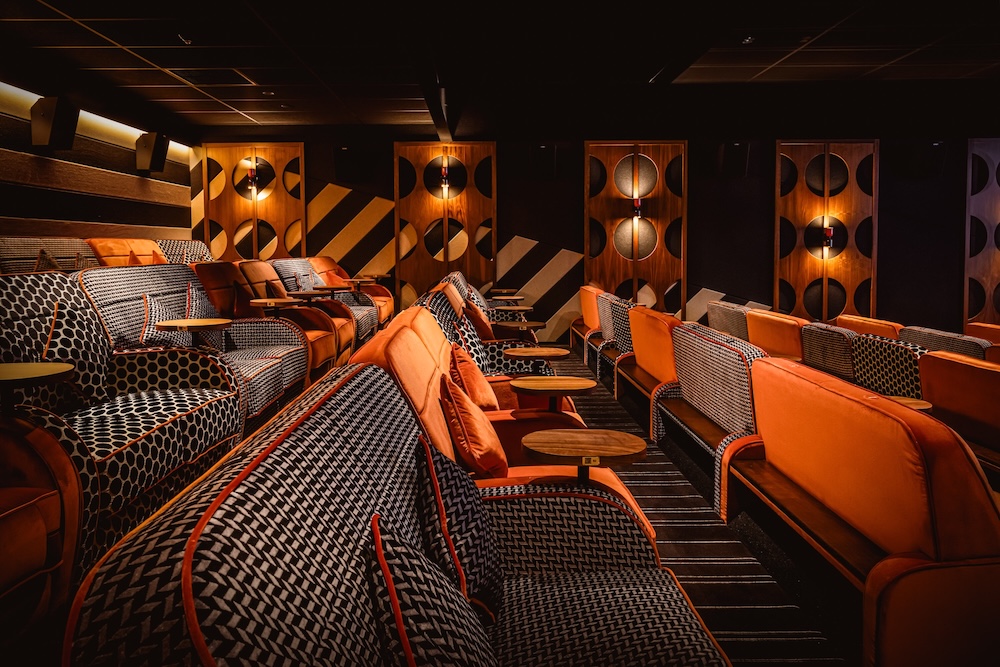
An experience for all
Inclusivity is a big part of Everyman’s ethos, and Brentford will host a range of specialist screenings to ensure that everyone can enjoy the magic of cinema. From toddler and baby screenings designed for parents with young children, to Silver Screen showings for over-55s and subtitled screenings for accessibility, the venue is committed to making film more inclusive.
"We want to build a real sense of community here," Chrissie says. "For many new parents, their first trip out with a baby is to one of our screenings, and we want that to be a really special moment."
What’s coming up?
With the doors now open, Everyman Brentford is kicking off with an exciting lineup of films and events. "There’s so much to look forward to with a year of great cinema ahead of us,” Chrissie concludes.
“We’ve got 'Wicked: Part II' in November, 'Avatar' at Christmas, and family favourites like 'Lilo & Stitch' and 'How to Train Your Dragon' this summer. We’ll also be screening National Theatre Live and opera performances, as well as hosting community events and classic throwbacks from April onwards.
"We can't wait to welcome the local community and are grateful for the enthusiasm and interest we've received so far. A huge thank you to Ballymore for creating such a vibrant neighbourhood; we hope our new venue becomes a true reflection of that spirit, offering a must-visit destination for everyone living, working, and visiting Brentford."
Find out more here.
Related Articles
Supporting autism awareness and inclusive education
April 2nd marks World Autism Awareness Day, a time to celebrate the strengths of autistic individuals and raise awareness of their unique perspectives.
At Ballymore, this cause is especially close to our hearts, particularly through our support of Scoil Oilibhéir, a 262-student Gaelscoil in Dublin 15, which in 2022 established a new Special Class for Autism.
The class, Rang na Réaltaí (which means "Class of Stars" in the Irish language), is part of a broader effort to ensure that students with more complex special educational needs can access tailored support within their local mainstream schools.
In this article, headteacher Antóin Ó Cléirigh, Class Teacher Mícheál Mac Cormaic, Special Needs Assistant Ciara Uí Shúilleabháin and Special Educational Needs Co-Ordinator and Deputy Head Lára Ní Riain share insights into the school’s work and the role Ballymore plays in supporting new programmes such as music therapy, something making a real difference in the lives of students.

At Scoil Oilibhéir, a 262-student school in Dublin 15, music is changing lives. Through the introduction of music therapy, autistic children are finding new ways to communicate, build confidence, and develop essential life skills.
It’s part of a wider mission led by headteacher Antóin Ó Cléirigh and his team, who are pioneering new therapeutic approaches to support the wellbeing of students with autism. "Across Ireland and the world, autism is becoming more commonplace," says Antóin. "It’s imperative that we protect each child and support their parents as they navigate life with autism."
Yet, despite the growing need, resources remain limited. This Irish Times recently reported that one in 20 Irish schoolchildren has now been diagnosed with autism – a threefold increase in less than a decade. But while the will to support these children is strong, infrastructure and capacity often fall short, making it challenging to provide the level of care and attention each child deserves.

Partnering with Ballymore to Enhance Student Wellbeing
Since early 2023, Ballymore has supported Scoil Oilibhéir’s journey, helping the school establish Rang na Réaltaí – a special autism class designed to provide a structured and supportive environment for children with acute needs.
"Ballymore has allowed us to do so much," explains Antóin. "Their support gave us momentum, enabling us to explore internationally recognised therapies that we otherwise wouldn’t have had access to."
Among those therapies is music therapy, which has quickly become one of the school’s most impactful initiatives. Led by specialist music therapist John McLoughlin, the programme provides children with a structured yet flexible space to express themselves.
"The kids adore music," says Ciara, who, along with Mícheál and Lára has overseen the therapy’s implementation. "It’s incredible for communication, especially for pre-verbal children, as it gives them a way to connect with their peers."
Each session follows a consistent structure, helping to create a safe and familiar space for students. The session begins with a ‘hello song’, welcoming each child by name, before children take turns playing different instruments, helping them learn patience, sharing, and social interaction. The sessions conclude with a ‘goodbye song’, offering closure and routine.
"Each week, the instruments change; last week, we introduced the ukulele, and the kids absolutely loved it," adds Ciara. "The guitar and the Hapi drum are always favourites."
But the impact extends far beyond enjoyment. "This is a completely different form of therapy for them," says Lára. "For older children, it’s a huge support for mental health and wellbeing. Some children who struggle to attend school find comfort in music, while others gain confidence as they engage with younger students in shared sessions. They let go, they’re free, and they’re content."
This contributes to a really positive atmosphere throughout the week says Class Teacher Mícheál Mac Cormaic “The children really look forward to music therapy all week. During each session the children play a whole range of different instruments and can express themselves in an imaginative and structured way. They are learning the life skills of listening, turn taking, sharing, creating, collaborating all the while thoroughly enjoying themselves”
Music therapy also plays a critical role in helping students manage stress. "Summer can be a really difficult time for children with autism," Lára continues. "Many can’t participate in mainstream summer camps, so we use music therapy as a calming and grounding activity."

Building on Success: The Role of Equine Therapy
Alongside music therapy, Scoil Oilibhéir first introduced equine therapy, another initiative made possible through Ballymore’s support. Every week, for 10 weeks, students visit a nearby farm, where they learn to ride, care for, and interact with horses, a process that has had remarkable benefits.
"It takes weeks of preparation," says Lára. "We work on getting the children comfortable with the environment, understanding their sensory preferences, and making sure they feel safe and in control."
The results have been profound. "One child who had never been able to sit up on his own managed to do so by his sixth or seventh session. It also improves core strength, coordination, and communication. The relaxed setting helps the children open up and engage in ways they never have before."
Class Teacher Mícheál expands on the positive impact, “What began as an activity which brought a certain amount of fear and trepidation for the children has developed into a weekly adventure where they get immense joy from horse-riding. The anticipation creates a really positive atmosphere in the class. Equine Therapy has given the children the motivation to engage in the school curriculum through discussion, writing, art, science, geography.”

Expanding Opportunities for All Students
While Rang na Réaltaí provides a specialised environment for children with acute needs, Antóin and his team are working hard to ensure more students across the school can benefit from these therapies.
A ‘reverse integration’ initiative is already underway, bringing mainstream students into autism support settings to foster understanding and inclusion. "A big part of this is sensory awareness," explains Lára. "We’re working to identify triggers and support needs across all students, creating a more inclusive environment."
And the school isn’t stopping at music and equine therapy: "We’re looking into art therapy, as well as practical life skills like baking, an especially important activity given that children with autism often experience dietary challenges," says Lára.
Mícheál explains that, “We would like to have a sensory-friendly kitchen facility created with neuro-diverse needs in mind in our school. Acquiring essential life skills, like safe food preparation, is a key factor in promoting a successful transition to adulthood for our autistic children With a sensory-friendly kitchen the children could perform personal care activities and learn about food safety, food preparation and hygiene.”
The ultimate goal? A second autism class, allowing even more children to access the specialist education, care and opportunities they need. "It’s a huge gamechanger for our students," says Antóin. "Moving into a special class can sometimes be a process, as it takes children away from their peers. But music and equine therapy bridge that gap, helping them integrate, build confidence, and develop essential life skills.
"We couldn’t have done it without Ballymore’s support," he continues. "For the parents and the kids, it means everything."
Related Articles
Ballymore unveils Stonehaven -bringing exceptional homes to Naas
Ballymore has unveiled the second phase of Stonehaven , a vibrant new neighbourhood in Naas, Co. Kildare, featuring 380 high-quality homes.
The first 20 homes launched this week, offering an exceptional blend of timeless elegance and modern craftsmanship. They boast soft pastel render façades, beautifully complemented by expertly detailed brickwork – striking contrast of white Perla banding against rich Vandersanden Gala red brick.
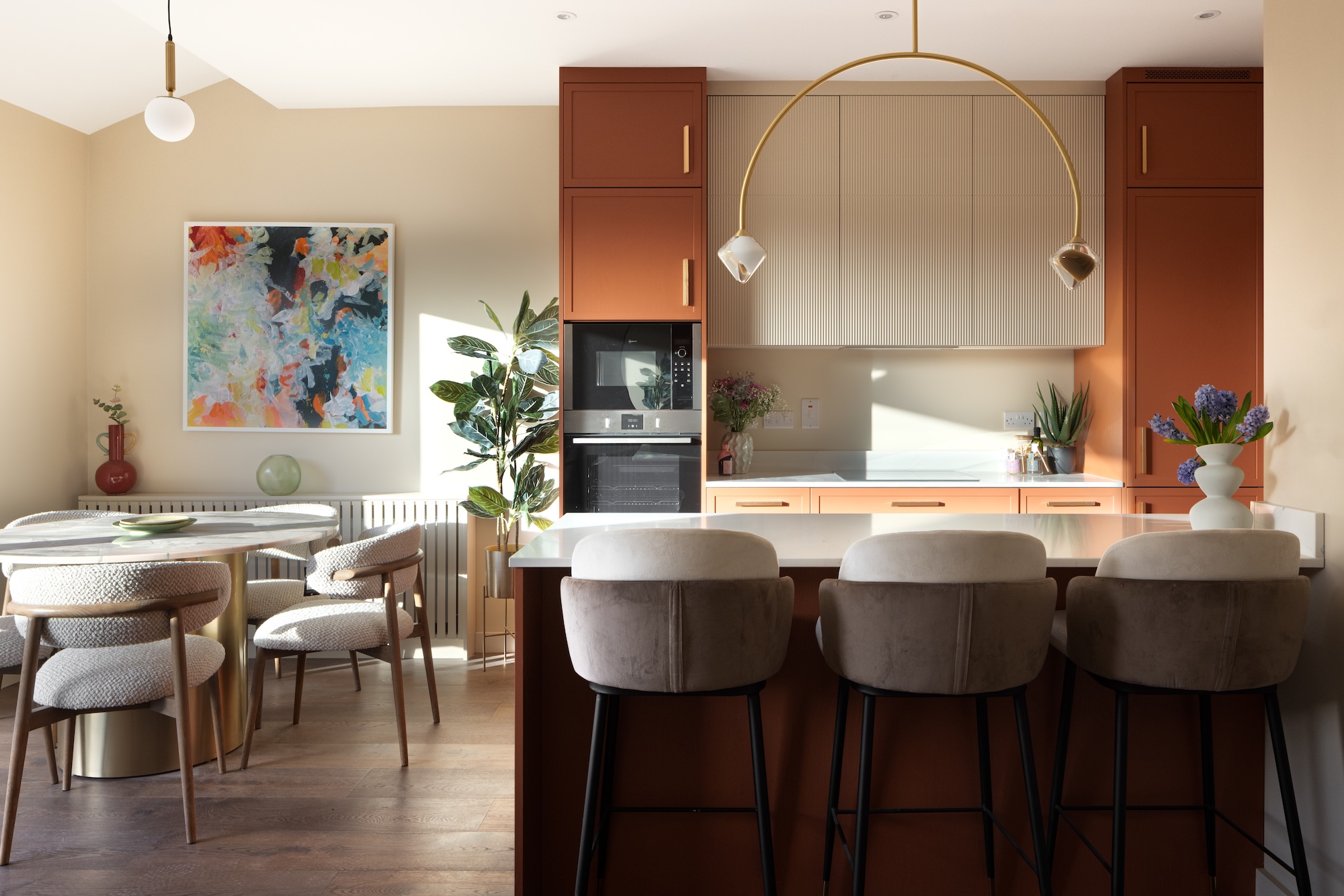
The release includes a range of two-bedroom duplex, three-bedroom duplexes, and spacious three- and four-bedroom houses, all crafted to the highest standards of design and comfort that is exemplified in four new show homes. Key features include:
Up to 2,153 sq ft of living space
2.7m ceiling heights in every home
Designer kitchens with full-height timber grain or painted barrel rib effect shaker units in a variety of striking colourways – from rich spiced carrot in the houses to deep, vibrant green in the duplex homes. They are complemented by sleek, gold quartz countertops, custom cabinetry with a hickory oak finish and satin brass handles, integrated NEFF appliances, ample storage space and LED lighting
Luxury bathrooms, showcasing elegant fixtures, large-format Terrazzo and marble-effect tiles for a high-end finish
Full-height wardrobes in bedrooms, with an Oyster oak interior design
Painted walls and ceilings, a mix of spotlights and pendant light fittings throughout
Houses also feature private paved front gardens with off-street parking for two cars, alongside secluded rear gardens with painted timber side gates for added privacy
Speaking of the homes, Linda Mulryan, Deputy Managing Director at Ballymore said: “We are delighted to unveil Stonehaven, bringing these beautifully designed homes to Kildare.
Exceptional design is about more than aesthetics – it’s about creating homes that inspire, elevate, and enhance everyday life. From the generous proportions and soaring ceilings to the meticulously crafted kitchens and luxurious finishes, every detail has been thoughtfully considered to blend style, comfort, and practicality. These homes don’t just look impressive – they are designed to be lived in, offering the perfect balance of bold design and timeless elegance."
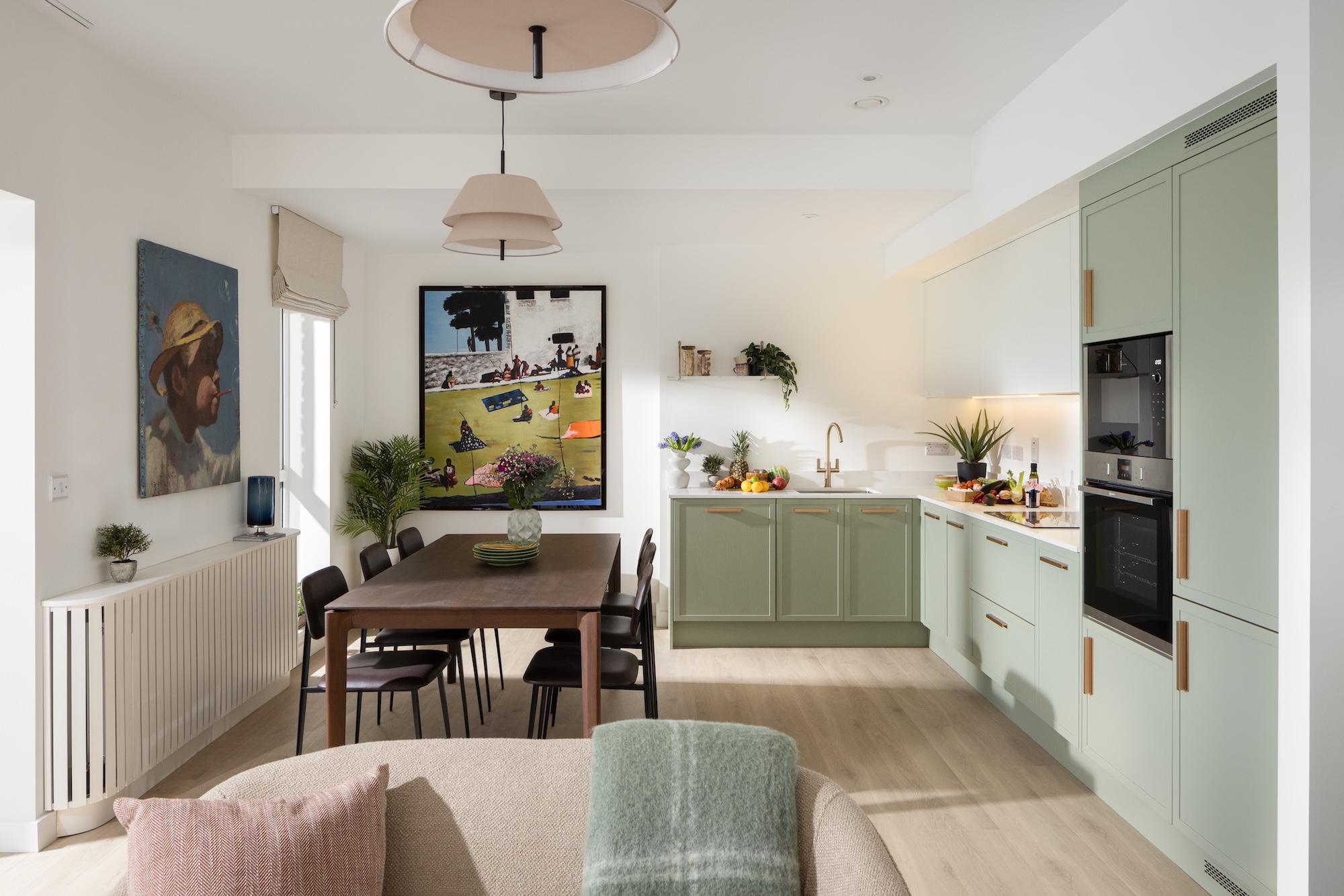
The show home interiors have been designed by Elaine Mackenzie Smith of Kildare-based Number 10 Design. Speaking of her inspiration for the design of the properties she added: "I wanted each home to have its own distinct personality, reflecting different lifestyles. The duplexes have a playful edge, with quirky carpets, antiques, and rich, darker tones, while the two-bed duplex is bright and fun, with soft pinks and greens where art plays a key role.
“The four-bed is chic yet family-friendly, with earthy tones, while the three-bed has a moodier, modern feel. It was fantastic to see people connect with different styles -proving each one resonated in its own way.
“I’m passionate about Irish and European art, and all the woodwork was handcrafted by a Kildare carpenter. Ballymore gave me the freedom to push boundaries with colour, including the bold spiced carrot kitchen – a real showstopper that I knew would turn heads."
Stonehaven also champions energy efficiency, incorporating a thermostatic central heating system with a heat pump and controlled ventilation to keep homes warm, comfortable, and cost-effective to run.
The homes reaffirm Ballymore’s strong legacy in Kildare – the county where it was founded in 1982. Linda continued: “We’ve always had a strong connection to the county we call home and have carefully planned this new community to give local people the perfect balance of high-quality homes and exceptional amenities.”
A great community
Stonehaven is designed to offer more than just beautiful homes – delivering an exceptional lifestyle, with a focus on wellness, community, and sustainability. The development includes seven acres of landscaped parkland, featuring:
Scenic walking routes and the Stonehaven Loop
A multi-use games area, playground, and picnic space
A dedicated dog-walking zone
A grocery store and crèche, providing convenience for families
Stonehaven is ideally located just minutes from Naas town centre, offering easy access to local favourites like Fletcher’s – with its weekly trad nights – Swans on the Green, and local boutiques such as Emporium Kalu and Gallery 9. Linda continued: “This is a place in which families can live a great life, enjoy green spaces, wellness-focused features, and the convenience of local services – and all in a fantastic Naas location.”
For further details and sales enquiries, click here.
Related Articles
“Ballymore is leading the way’
Ballymore has become the first Irish property developer to partner with the 100 Million Tree Project in planting a native Irish Tree mini-forest at Sea Gardens in Bray.
Led by our Deputy Managing Director in Ireland Linda Mulryan, alongside our Director of Construction Paul Carty, Hayleigh O'Farrell - Head of Brand and Communications, other Ballymore colleagues and local schoolchildren, the tree planting comes ahead of a commitment to create even more new urban mini-forests at viable developments.
The 100 Million Trees project, founded by brothers Richard and David Mulcahy and administered by their sister Tina, is a not-for-profit, community driven initiative dedicated to planting native trees throughout Ireland. In this article David Mulcahy, also a practicing Consultant Cardiologist, shares his passion for trying to make a meaningful contribution towards increasing native afforestation in Ireland while also significantly increasing areas of biodiversity, and attempting to mitigate against climate change. He also reflects on the exciting new collaboration with Ballymore.

I am a cardiologist and was lucky enough to start training at a time where there was an explosion in developments to treat heart disease, the leading cause of death in the western world. Over the past 40 years huge inroads have been made in the detection and treatment of heart disease, but in that time climate change has slowly but inexorably progressed and can now be very definitely considered a threat to human health. We in Ireland (11%) and indeed in the UK (13%), have a very low rate of afforestation compared to mainland Europe (35%), and one of the ways we can make our own small contribution to mitigating against climate change is to plant trees, possibly the best way to assist with carbon capture, while also returning some of the lost habitat for our birds, bees, and insects.
I set up a small environmental group (Bugs, Bees, and (native) Trees) with some friends about a week before the pandemic hit in 2020, travelling round the country when it became possible to, planting copses of 5–6-year-old trees in schools, hospitals, and private lands. My brother Richard suggested that we should think bigger and aim to plant 100 million native trees over a 10 year period, and thus the project was born, with sister Tina becoming the organiser after retiring from the Council of Europe. In our trial season, in order to assess the feasibility of planting mini-forests (2,500 native trees in ¼ acre site), we trialled 18 sites using volunteers, and planting just over 20,000 native trees in densely packed mini-forests (something known as the Miyawaki method). In the 2023-24 season (Nov-Apr) we planted over 200,000 trees, and this season we plan to plant 550,000 trees (approx. 225 sites). This is only being made possible by people offering their land for the planting of these mini-forests, and is truly a community driven project. Ireland is fortunate in that the soil is mostly good, and trees tend to grow easily. There is also plenty of water, so drought is less of a problem than elsewhere, and thus management of these miniforests is less problematic.

Ballymore on board
We were delighted when a such a stellar national brand as Ballymore offered to take part in the project, creating a mini forest as part of the first phase of the Sea Gardens neighbourhood in Bray. Ballymore is leading the way as the first developer to support the project and their help in further spreading the word for us is just brilliant, as is their ongoing commitment to plant more trees.
Trees planted in urban areas will have enormous benefits, not just for the birds and the bees, but in terms of cleaning the air, temperature control, noise reduction, and also generating a feeling of wellbeing within the areas.
Our mini forest was planted at Sea Gardens, with the final trees being planted by Linda and Sean Mulryan, members of Ballymore staff, including Charlie Conlan who drove the project, and a very enthusiastic group of local schoolchildren, who showed us how it should be done! It was wonderful to have them involved, and of course if we are going to deal with the climate crisis over the next 20 years, the young people are going to have to spearhead all our efforts.
We planted a total of 1,500 native trees of 13 different varieties; cherry, bird cherry, blackthorn, dogrose, Guelder rose, Crab apple, Rowan, Common Alder, Downy Birch, Oak, Scots pine, Hazel, spindle, and Hawthorn trees. We planted them closely packed to help them grow quickly to chase the light; different varieties will also grow to different heights, leaving a layering of the mini-forest, and a wonderful min-ecosystem.

With sufficient enthusiasm from members of the public and wonderful companies like Ballymore in offering land, we hope to plant 550,000 native trees this season (159,000 planted to date since end November 24), and 1,000,000 next season.
Ballymore is eager to do more, and we can’t wait to work with their team again. But if anyone is interested in working with us, we would love to hear from you. We provide the trees, and plant them, and they are YOUR TREES! Hopefully together, we will achieve the 100 million trees planted within the 10 years. Hopefully also young people will get increasingly involved in ensuring maximal care for our wonderful world.
Related Articles
Ballymore is Irish Developer of the Year
Ballymore has been named Developer of the Year by Ireland’s Business Post, a prestigious recognition of our portfolio of transformative development projects across the country.
The award was presented on Thursday 27th February at the National Property Awards ceremony at Dublin’s InterContinental Hotel, celebrating the achievements of individuals and organisations shaping the industry. Judged by leading figures, including Business Post Property Editor Tina-Marie O’Neill, Gavin Lawler, President of the Irish Planning Institute, and Mary Conway, Chair of the Irish Property Owners’ Association, the accolade reflects Ballymore’s impact on the Irish real estate landscape.
Pat Phelan, Managing Director in Ireland, and Deputy Managing Director Linda Mulryan accepted the award on the night; with Pat saying: “Ballymore’s story began in Ireland over 40 years ago, when Sean and Bernardine Mulryan founded the company in Kildare in 1982.
“Since then, we have grown into a leading force in the industry, creating vibrant, resilient places where innovation and community come together. From beautifully designed homes to major commercial projects like Dublin Landings in the Docklands, and green spaces such as the new playground we recently delivered in Malahide, every project we undertake reflects our unwavering commitment to enhancing lives, strengthening communities, and building a legacy that will endure for generations.
"Our dedication to the Irish market remains as strong as ever, and we will continue to invest in the country’s construction sector, driving economic growth and shaping the urban landscape.
"I am delighted that this award recognises those efforts."
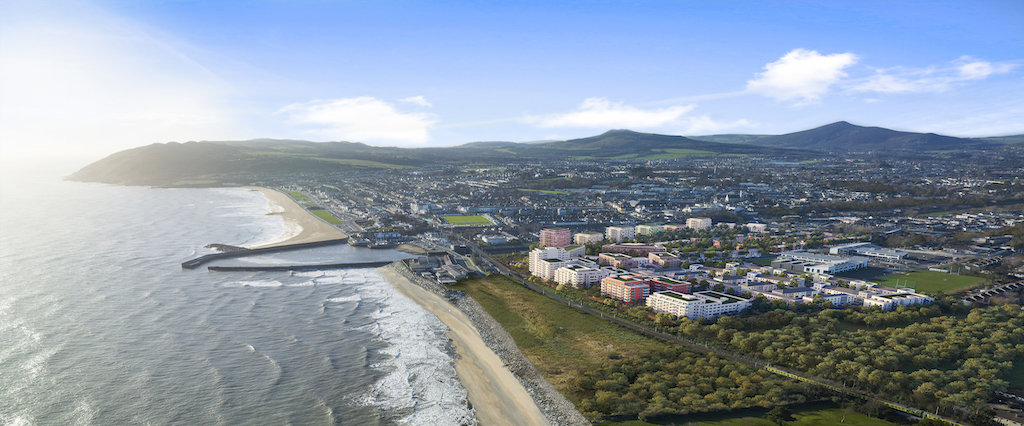
Sea Gardens in Bray; one of Ballymore's newest and transformative projects in Ireland
Over the past year, Ballymore has made significant progress across its Irish portfolio. New homes at Seamount Rise in Malahide, Station Walk in Newbridge, and Stonehaven in Naas have strengthened our reputation for delivering thoughtfully designed, high-quality housing. Meanwhile, the launch of Sea Gardens in Bray, a landmark coastal development, reflects Ballymore’s continued ambition to create thriving, sustainable communities.
Sustainability has also remained at the heart of Ballymore’s approach, with a strong focus on carbon reduction strategies and biodiversity enhancements – including our first Passive House homes at Drumnigh Oaks in Portmarnock, further demonstrating a commitment to energy-efficient, future-proofed housing.
Beyond our projects, we are also investing in the environment, partnering with the 100 Million Trees Project to create a new urban forest at Sea Gardens, with plans to introduce similar initiatives across future developments.
The award comes following other accolades for Ballymore, including an Irish Construction Awards for River Walk in Ballymore Eustace, Kildare. Reflecting on our success, Linda Mulryan concludes: “Awards like these are fantastic recognition of Ballymore’s unwavering commitment to excellence in Irish development. Our focus remains on creating places with a soul, and high-quality, design-led homes in which people love to live for the long-term.”
Related Articles
Ballymore’s first Passive House development
Ballymore has unveiled Drumnigh Oaks, a new collection of sustainable new homes in the coastal Dublin suburb of Portmarnock.
Designed to the highest standards of comfort, quality, and sustainability, these homes set a new benchmark for energy-efficient living in Ireland with the properties on target to be fully Passive House standard. The beautifully designed showhouses, which open to the public on 1st March, offer a glimpse inside, showcasing interiors by award-winning designer Sara Cosgrove, renowned for her role as a judge on Home of the Year.

A new standard in sustainable living
Achieving Passive House certification requires meeting rigorous sustainability standards that ensure maximum comfort, reduced energy consumption, and a lower environmental impact. Ballymore has achieved this at Drumnigh Oaks with features including:
Airtight construction, reducing energy loss and keeping annual heating demands below 15kW/sqm. This results in significantly lower energy bills, with Passive House owners paying as little as €540 per year—compared to over €1,000 for a standard new-build home.
Mechanical ventilation with heat recovery, which reduces indoor air pollution by 90% and ensures a continuous supply of fresh, high-quality air every two to three hours. This system prevents condensation and mould while maintaining a consistently comfortable temperature.
Advanced window technology, designed to enhance thermal performance and reduce heat loss by 50% compared to conventional windows.
Super-insulated walls, roofs, and foundations, ensuring minimal heat loss and maximum efficiency.
Significant energy savings, with a 56% reduction in energy consumption compared to conventional homes, making for a smarter, more cost-effective way to live.
“Sustainability lies at the heart of everything we do at Ballymore,” says our colleague Charlie Conlan who is Ballymore’s Sustainability Designer. “At Drumnigh Oaks, we’ve pushed the boundaries with Passive House design, overcoming complex challenges to meet Passive House targets. For homeowners, this translates into lower energy costs, exceptional indoor air quality, and the reassurance of living more sustainably.”
Design excellence
Merging sustainable innovation with Ballymore’s signature design ethos, we’ve ensured that each home at Drumnigh Oaks offers 1,708 sq ft of thoughtfully designed living space, including custom-designed kitchens, complete with integrated appliances, elegant contemporary bathrooms featuring bespoke finishes and full height wardrobes. The spacious homes also feature 2.7m floor-to-ceiling heights, enhancing natural light and a sense of space and views of private rear gardens and landscaped communal spaces.
The Sara Cosgrove-designed show homes, reflect these features, as well as Drumnigh’s sustainable ethos and coastal surroundings with interiors featuring organic textures, natural materials, and a calming palette of greens and blues, creating a sophisticated yet family-friendly atmosphere.
Further emphasizing Ballymore’s commitment to sustainability, the homes incorporate recycled paints in partnership with Enable Ireland’s Rediscovery Centre. Proceeds from these eco-friendly paints support Enable Ireland’s disability services, which provide vital support to over 13,000 children and adults nationwide.
A great location
Nestled in the heart of Portmarnock, Drumnigh Oaks offers the perfect balance between serene coastal living and city convenience. Portmarnock DART station is just a seven-minute walk away, while Dublin Airport can be reached in approximately ten minutes by car. Residents can enjoy an exceptional range of outdoor amenities, including the famous Velvet Strand beach, Portmarnock Golf Club, and the historic Malahide Castle. Meanwhile, the nearby villages of Portmarnock and Malahide provide a vibrant mix of restaurants, cafés, and boutique shops.
“Drumnigh Oaks is the culmination of over 40 years of Ballymore’s dedication to design, quality, and sustainability,” says Linda Mulryan, who is our Deputy Managing Director at Ballymore. “We have invested heavily in both design and construction to create homes that are not only more energy-efficient and healthier to live in but also truly beautiful spaces. This development is about more than sustainability, it’s about building homes that people love to live in.”
Find out more
The Drumnigh Oaks showhouses will be open for viewing from Saturday, 1st March, by appointment through sales agents O’Farrell Cleere. Homes are priced from €860,000, with further details and a brochure available here.
Related Articles
Supporting the arts in Ireland
Ballymore continued its longstanding support of the Irish art scene this week, proudly donating and presenting the first prize for the Sir William Orpen 'Ready to Start' awards ceremony in Dublin.
Inspired by the works of the renowned Irish artist Sir William Orpen, the Ready to Start Awards celebrated the talents of artists from across Ireland, each challenged to create a self-portrait reflecting a defining moment in their artistic journey. The competition attracted 256 entries from all over the country, with 36 finalists exhibited at the ceremony – giving a truly inspiring backdrop for guests immersed in the creative atmosphere.
Ballymore's founder, Chairman, and Chief Executive Sean Mulryan, along with his wife Bernardine Mulryan, donated the event's first prize and attended the ceremony to present the award. Reflecting on the evening, Sean commented: "We were delighted to support this wonderful event, meet the artists, and witness the incredible variety of portraits on display. Bernardine and I are passionate about supporting artistic projects, which play such a vital role in enriching our communities while celebrating local talent, which was present here in abundance."

Works of art on display at the event
The ceremony, held at The Talbot Hotel in Stillorgan, was orchestrated by Dominic Lee of Priory Studios, who Sean and Bernardine had supported last year by donating a painting for an exhibition he curated at Farmleigh House, Phoenix Park which attracted over 10,000 visitors in 2024 (Dominic also manages SirWilliamOrpen.com). The title of the awards was inspired by one of Orpen's most prominent works, Ready to Start – a self-portrait of the artist in military uniform when he was appointed an official war artist during WWI.
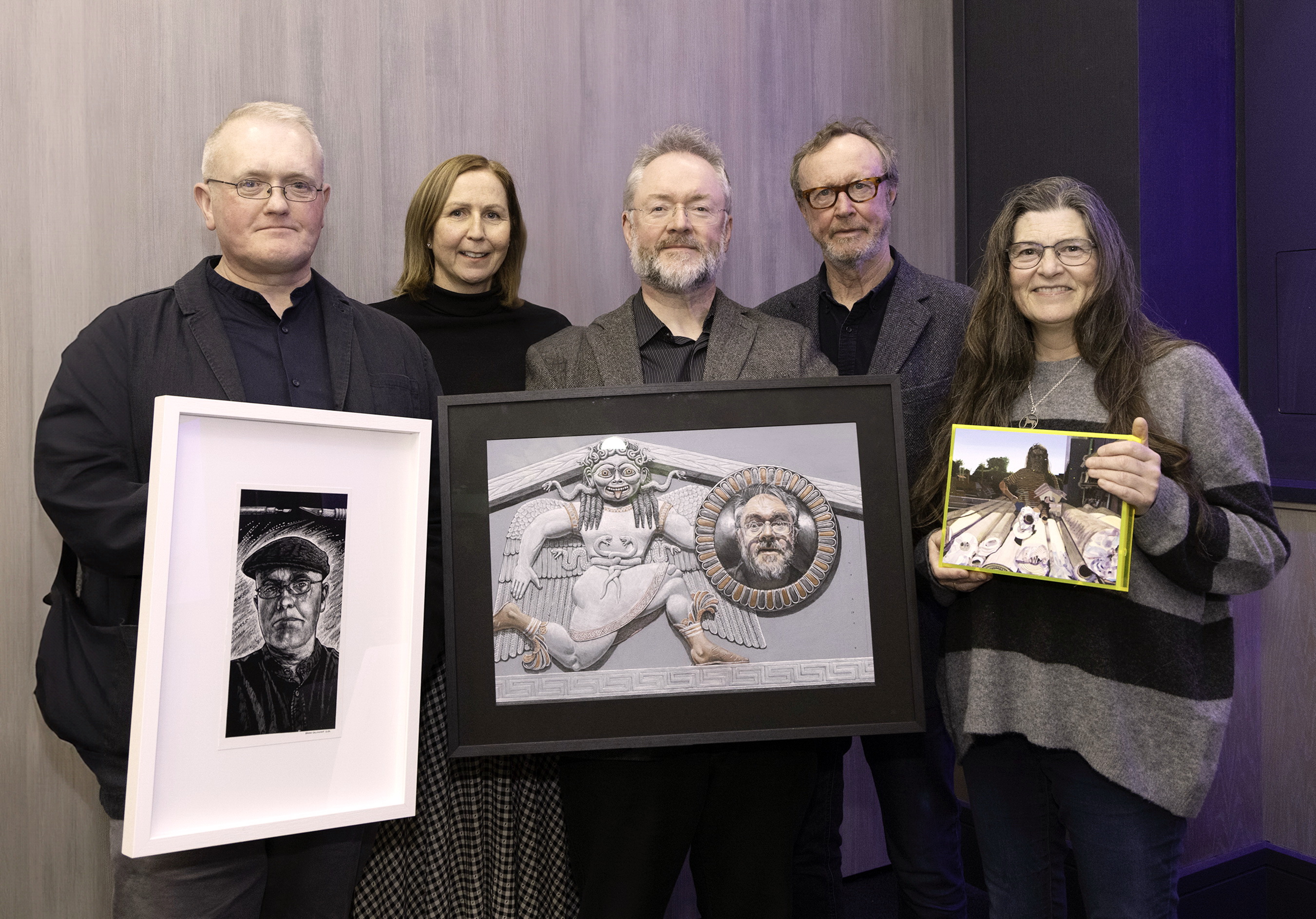
The night's three winners, pictured with judges
Speaking about Ballymore's involvement, Dominic added: "Having the support of Ballymore, a successful and prominent family business rooted in Ireland, has been incredible for the profile of our event. Sean and Bernardine's generosity encouraged 256 artists to take part, with a selection of their works showcased on the night. A highlight of the evening was a moving speech by Dr Neil Orpen, a descendant of Sir William Orpen which added a poignant touch to the proceedings."
Sean Mulryan concludes: "At Ballymore, investing in cultural enrichment is a key part of our mission. Artists have a unique ability to bring a sense of identity to a place, and we're dedicated to creating opportunities to showcase their work wherever we can.
"Representing the cultural interests of our neighbourhoods is as important as the infrastructure itself, and we're incredibly proud of the projects we've supported so far - and those still to come."
Related Articles
布倫特福德榮獲英國住宅獎及多項大獎
Ballymore在2024年英國住宅獎(British Homes Awards)中榮獲“年度重建項目獎”,這是該公司近幾個月內斬獲的第三項重量級大獎。
英國住宅獎被譽為英國住宅建設領域的至高榮譽之一,表彰在建築設計、室內創新、建築品質及永續性等多方面的卓越成就的開發商。
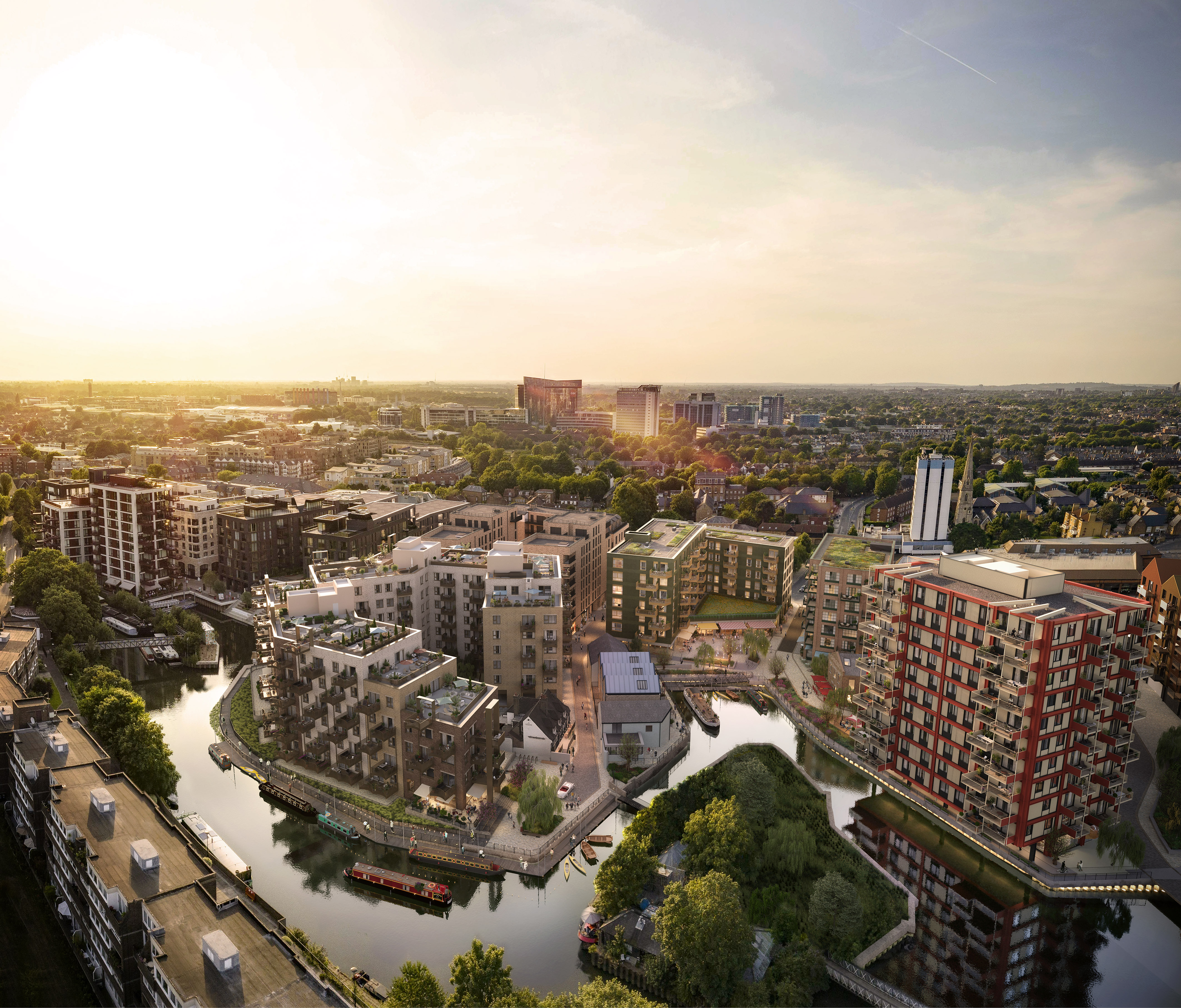
布倫特福德計畫(The Brentford Project)因其在西倫敦改造中的卓越表現而受到表彰。該項目建造了876套全新住宅,煥發活力的高街,打造了五英畝的公共空間,創造了大量就業機會,並提供多種社區及休閒設施。其中包括私人俱樂部The Wick,內設先進的健身房、豪華水療設施、休閒會客廳以及室外溫水泳池。

榮獲該殊榮後,布倫特福德項目又摘取了「PROPS年度開發獎」。此外,在《倫敦旗幟晚報》(Evening Standard)「新住宅獎」評選中獲得高度讚譽,並在「倫敦建築規劃獎」中被評為最佳新生活居住地的傑出獎項。 Ballymore總經理約翰·馬蘭(John Mulryan)表示:「我們對近期的獲獎成績感到非常欣喜,這些獎項是對我們在布倫特福德改造項目中所秉持願景的高度肯定,同時也是對我們致力於打造設計精良、品質卓越的住宅與配套設施承諾的最佳回饋。」
“能夠獲得房地產業最高獎項之一,並繼續獲得業界同行的認可,是莫大的榮耀。”
在過去一年中,布倫特福德項目取得了顯著進展,目前已交付319套私人住宅和96套經濟適用型住房。同時,項目的商業版圖也蓬勃發展,如今已有10家零售商入駐,其中包括獨立品牌如Sam's Waterside和GAIL'S等現已開業,此外Everyman影院也計劃於明年初揭幕。
Ballymore將於10月19日推出項目的下一階段—Quincy House。這座位於Town Wharf Square核心的新建築將提供85套全新住宅,起價為35萬英鎊。
了解更多關於布倫特福德項目的信息,請點擊此處。
Related Articles
布伦特福德荣获英国住宅奖及多项大奖
Ballymore在2024年英国住宅奖(British Homes Awards)中荣获“年度重建项目奖”,这是该公司近几个月内斩获的第三项重量级大奖。
英国住宅奖被誉为英国住宅建设领域的至高荣誉之一,表彰在建筑设计、室内创新、建筑质量及可持续性等多方面的卓越成就的开发商。

布伦特福德项目(The Brentford Project)因其在西伦敦改造中的卓越表现而受到表彰。该项目建造了876套全新住宅,焕发活力的高街,打造了五英亩的公共空间,创造了大量就业机会,并提供多种社区及休闲设施。其中包括私人会所The Wick,内设先进的健身房、豪华水疗设施、休闲会客厅以及室外恒温泳池。

荣获该殊荣后,布伦特福德项目又摘取了“PROPS年度开发奖”。此外,在《伦敦旗帜晚报》(Evening Standard)“新住宅奖”评选中获得高度赞誉,并在“伦敦建筑规划奖”中被评为最佳新生活居住地的杰出奖项。Ballymore总经理约翰·马兰(John Mulryan)表示:“我们对近期的获奖成绩感到非常欣喜,这些奖项是对我们在布伦特福德改造项目中所秉持愿景的高度肯定,同时也是对我们致力于打造设计精良、品质卓越的住宅与配套设施承诺的最佳回馈。”
“能够获得房地产业最高奖项之一,并继续获得业界同行的认可,是莫大的荣耀。”
过去一年中,布伦特福德项目取得了显著进展,目前已交付319套私人住宅和96套经济适用型住房。与此同时,项目的商业版图也在蓬勃发展,如今已有10家零售商入驻,其中包括独立品牌如Sam's Waterside和GAIL'S等现已开业,此外Everyman影院也计划于明年初揭幕。
Ballymore将于10月19日推出项目的下一阶段——Quincy House。这座位于Town Wharf Square核心的新建筑将提供85套全新住宅,起价为35万英镑。
了解更多关于布伦特福德项目的信息,请点击此处。
Related Articles
皇家碼頭為宜居家園樹立典範
皇家碼頭是個擁有1萬居民、各類商店、咖啡館、一所學校、多家企業及一支專屬足球俱樂部的繁榮社區。被居住和工作在這裡的人們譽為是一個真正宜居的社區,這個成功的社區模式將成為未來社區建設的典範。
隨著政府致力於加快新住房的建設步伐,Ballymore開發的倫敦東部皇家碼頭(Royal Wharf)展示瞭如何透過大規模開發,打造理想宜居家園,並滿足當前人們對繁榮理想社區的迫切需求。
Ballymore借助雄厚資源與遠見卓識,成功改造了這片毗鄰泰晤士河畔的40英畝土地。該公司總經理John Mulryan 表示,「我們將這裡視為創建新城區的重大機會。因此,我們建造了一條全新的高街、一所新學校,並引入眾多商舖和企業。讓這片曾經荒蕪的土地,在幾年間業已變成了一座擁有1萬居民的溫馨社區。
建築事務所Howells的創始人兼董事Glenn Howells強調「在這裡不僅僅是建造房屋,更要打造基礎設施、社區和配套設施,使之成為真正意義上的宜居社區,而不僅僅是一個房區。
除了4,000多套住宅,皇家碼頭還配備了餐廳、咖啡館、社區中心、牙醫診所、藥房、綠地以及倫敦最長的船埠碼頭Royal Wharf Pier,這是Uber泰晤士快船服務的最新碼頭。全部這一切的建成僅花了六年時間。 Glenn Howells補充道:“令人矚目的是,這種方式讓社區得以迅速紮根、發展壯大併步入正軌。”
觀看我們的視頻,以了解更多有關皇家碼頭轉型的故事。
居住與工作在皇家碼頭社區的人們也深有同感。皇家碼頭小學執行校長Linda-May Bingham說:「我們非常重要的一個價值觀是希望學校能融入社區,同時社區也能夠融入學校。皇家碼頭的社區精神非常強,這裡是一個充滿活力且適合家庭生活的地方。
這種社區精神不僅來自完善的設施,還得益於由當地慈善機構-West Silvertown Foundation慈善基金會所舉辦的豐富活動。該機構在皇家碼頭設有活動中心。新入住的居民Chandrika表示:“社區裡總是舉辦各類活動,人們有機會結識新的朋友,鄰里之間也會建立深厚的友誼。”
因此,居民們將皇家碼頭描述為一個多元化的、熱情好客的社區。居民Jo表示:「這裡有很多年輕家庭或養狗的夫婦,每個人都很友善。」居民Jonnie則補充說:「這裡不像其他的社區鄰居之間各不相識,我們這裡的鄰居都像朋友一般熟識。
皇家碼頭的社區精神仍在日益壯大,這些都得益於像Vito Monteiro這樣居民努力的成果。他表示:「我一直熱愛足球和教練工作,於是決定創辦一支足球隊,讓社區更加緊密地團結在一起。」皇家碼頭足球俱樂部已在Echo Junior聯賽中嶄露頭角,特別是7歲以下年齡組更是捧回了一座獎盃。
政府面臨的挑戰是如何複製皇家碼頭的成功模式,以滿足日益緊迫的住房需求。 Ballymore董事長Mulryan提出了解決方案:「如果我們希望私人機構在倫敦建造更多的住宅,我們需要創造一個鼓勵投資的環境。」皇家碼頭計畫沒有使用公共資金,而是吸引了國際投資者的資本。
「在皇家碼頭,我們的開發合作夥伴是新加坡的豪利集團——他們本可以在世界任何地方投資,但他們決定投資倫敦的住宅項目,」Mulryan先生繼續說。 「這對倫敦來說是一件好事,對現在以這裡為家的一萬人來說也是一件好事。我認為我們需要將這種投資視為對我們城市的利好舉措,我們需要住房和財政政策來激勵這種投資,而在目前的環境下,這種投資很難實現。
Related Articles
皇家码头为宜居家园树立典范
皇家码头是一个拥有1万居民、各类商店、咖啡馆、一所学校、多家企业及一支专属足球俱乐部的繁荣社区。被居住和工作在这里的人们誉为是一个真正宜居的社区,这个成功的社区模式将成为未来社区建设的典范。
随着政府致力于加快新住房的建设步伐,Ballymore开发的伦敦东部皇家码头(Royal Wharf)展示了如何通过大规模开发,打造理想宜居家园,并满足当前人们对繁荣理想社区的迫切需求。
Ballymore借助雄厚资源与远见卓识,成功改造了这片毗邻泰晤士河畔的40英亩土地。公司总经理 John Mulryan 表示,“我们将这里视为一个创建新城区的重大机遇。因此,我们建造了一条全新的高街、一所新学校,并引入众多商铺和企业。让这片曾经荒芜的土地,在几年间业已变成了一座拥有1万居民的温馨社区。”
建筑事务所Howells的创始人兼董事Glenn Howells强调说“在这里不仅仅是建造房屋,更要打造基础设施、社区和配套设施,使之成为真正意义上的宜居社区,而不仅仅是一个房区。”
除了4,000多套住宅,皇家码头还配备了餐厅、咖啡馆、社区中心、牙医诊所、药房、绿地以及伦敦最长的船埠码头Royal Wharf Pier,这是Uber泰晤士快船服务的最新码头。全部这一切的建成仅用了六年时间。Glenn Howells补充道:“令人瞩目的是,这种方式让社区得以迅速扎根、发展壮大并步入正轨。”
观看我们的视频,了解更多有关皇家码头转型的故事。
居住与工作在皇家码头社区的人们也深有同感。皇家码头小学执行校长Linda-May Bingham说:“我们非常重要的一个价值观就是希望学校能融入社区,同时社区也能够融入学校。皇家码头的社区精神非常强,这里是一个充满活力且适合家庭生活的地方。”附近Little Hudson Café的老板Nicola Micah也表示:“我觉得这里的社区精神非常棒,尤其是现在有更多的店铺与本地商家纷纷营业以后更加如此。”
这种社区精神不仅来源于完善的设施,还得益于由当地慈善机构——West Silvertown Foundation慈善基金会组织的丰富活动。该机构在皇家码头设有一个活动中心。新入住的居民Chandrika表示:“社区里总是举办各类活动,人们有机会结识新的朋友,邻里之间也会建立深厚的友谊。”
因此,居民们将皇家码头描述为是一个多元化的、热情好客的社区。居民Jo表示:“这里有很多年轻家庭或养狗的夫妇,每个人都很友好。”居民Jonnie则补充道:“这里不像其他的社区邻里之间各不相识,我们这里的邻居都像朋友一般熟识。”
皇家码头的社区精神还在日益壮大,这些都得益于像Vito Monteiro这样居民努力的结果。他表示:“我一直热爱足球和教练工作,于是决定创办一支足球队,让社区更加紧密地团结在一起。”皇家码头足球俱乐部已在Echo Junior联赛中崭露头角,特别是7岁以下年龄组更是捧回了一座奖杯。
政府面临的挑战是如何复制皇家码头的成功模式,以满足日益紧迫的住房需求。Ballymore董事长Mulryan提出了解决方案:“如果我们希望私营机构在伦敦建造更多的住宅,我们需要创造一个鼓励投资的环境。”皇家码头项目没有使用公共资金,而是吸引了国际投资者们的资本。
“在皇家码头,我们的开发合作伙伴是新加坡的豪利集团——他们本可以在世界任何地方投资,但他们决定投资伦敦的住宅项目,"Mulryan先生继续说。“这对伦敦来说是一件好事,对现在以这里为家的一万人来说也是一件好事。我认为我们需要将这种投资视为对我们城市的利好举措,我们需要住房和财政政策来激励这种投资,而在目前的环境下,这种投资很难实现。”
Related Articles
幸運島:一個充滿活力的文化社區
幸運島(Goodluck Hope)精心舉辦的為期五個月的島上居民互動活動「島民節」(Islander Festival) 融合了島上的文化、藝術、美食和美酒的特色,推出了豐富多彩的活動。使得島民與來這裡休閒遊玩的遊客自然匯聚一堂,為大家帶來了完美的體驗,這項活動不僅促進了鄰里之間的相互關懷與了解,極大地豐富了島上居民的生活,而且讓整個社區洋溢著溫馨祥和,其樂融融的氛圍,使這裡成為首都倫敦最令人嚮往的生活居住地之一。
從歌唱大師班到晨間瑜伽,從杜松子酒的品酒夜到變裝賓果派對,這一系列豐富多彩的活動展現了島上富有創新與創意的氛圍,也為居民和遊客提供了眾多休閒娛樂的機會,能讓人們在這個三面環水的秀美社區深深感受到東倫敦獨特的魅力。
在過去的五個月裡,幸運島變成一個活力四射的中心。這場盛會自五月啟動,於十月圓滿落幕,精彩紛呈的活動以獨具匠心的創意方式與豐富多樣的體驗,為人們帶來了種種前所未有的歡樂。也更加完美地展現了其充滿個性、創新與探索精神的美譽。
精彩的活動安排
為了鼓勵當地社區嘗試新鮮事物,同時感受活力四溢的街區新氣象,島民節以周為單位精心安排,包括“週三工作坊實踐”(Workshop Wednesdays)、“週四飲品品鑑”(Thirsty Thursdays )、「週五電影欣賞」(Film Fridays)、「週六友情社交」(Social Saturdays)和「週日迎接晨曦」(Sunrise Sundays),這項策劃的宗旨是在吸引社區所有的居民,也會讓遠道而來的遊客有賓至如歸的感覺。
活動安排充分展現了當地豐富的創新與創意企業的資源。參與者不僅有機會學習新技能,還能結識新朋友。從Art Craft Studios的陶藝工作坊,到位於City Island的音樂工作室The Woods的創辦人Dantae Johnson開設的聲樂工作坊。特別是聲樂工作坊的課程透過多種多樣的聲樂練習,探索音樂在改善人們身心健康方面的力量。每一場活動都別具特色,許多課程更是在短短數日內迅速售罄。
對於美食愛好者而言,新開幕的Layers烘焙坊與咖啡廳舉辦的法式酥皮糕點課程更加吸引了他們的眼球;這是由知名讀書俱樂部Shelf Help的創始人Toni Jones主持和精心策劃的「自我健康」工作坊為參加者帶來了相當有特色的體驗。在課程中,參與者探索如何更好地了解和改善環境與自我的關係,並獲得實現個人目標的指導性方法。
「週四飲品品嚐」吸引了熱情洋溢的島民與遊客,主題飲品快閃店紛紛亮相增強了活力。活動地點設在 幸運島的Dry Dock,伴隨著倫敦新銳音樂人的現場演奏,美景與優美的樂曲相交織而營造出輕鬆迷人的氣息。而「週五電影欣賞」則為觀眾帶來豐富多彩的影片,從英國國家芭蕾舞團的經典劇目《吉賽爾》,到朱迪·科默感人至深的巔峰之作《Prima Facie》,可謂是應有盡有,精彩可期。
社區居民在周六友情社交更是積極響應,盡情享受一系列豐富多彩的各種活動。從幸運島畫廊的平價藝術快閃展,到由Sheila Simmonds主持的趣味變裝賓果遊戲(Drag Bingo),以及充滿音樂、喜劇和現場娛樂的歡樂之夜,可謂是繽彩紛呈。家庭成員和孩子們則可以參與「Mini Me」藝術工作坊和Docklands Village Nursery舉辦的泰迪熊野餐音樂會。而創意人士則沉浸在由倫敦燈塔畫廊與工作室駐地藝術家Sokari主持的特別活動中,該工作坊聚焦於建築攝影,讓藝術愛好者大飽眼福。
週日迎接晨曦則是圍繞身心健康展開一系列清晨的瑜伽課程,地點選在燈籠房的觀景台,由Hum Yoga主持,並以打坐冥想和正向思維結束每週的活動。這些課程因其具有高人氣特徵而深受歡迎,以至於主辦方不得不增加更多的場次來滿足這種迫切的需求,這也充分展現出了這一活動本身的魅力及公眾對社區的凝聚力。
正如Ballymore 的Laura Jeffery 所總結的:「幸運島提供的豐富多彩的體驗非同凡響,並充分證明了這裡是一個充滿活力與多元化的社區。這次島民節活動展現了幸運島是讓文化活動真正能夠散發出無限魅力的搖籃。」
Related Articles
幸运岛:一个充满活力的文化社区
幸运岛(Goodluck Hope)精心举办的为期五个月的岛上居民互动活动“岛民节”(Islander Festival) 融合了岛上的文化、艺术、美食和美酒的特色,推出了丰富多彩的活动。使得岛民与来这里休闲游玩的游客自然汇聚一堂,给大家带来了完美的体验,这一活动不仅促进了邻里之间的相互关怀与了解,极大地丰富了岛上居民的生活,而且让整个社区洋溢着温馨祥和,其乐融融的氛围,使这里成为首都伦敦最令人向往的生活居住地之一。
从歌唱大师班到晨间瑜伽,从杜松子酒的品酒夜到变装宾果派对,这一系列丰富多彩的活动展现了岛上富有创新与创意的氛围,也为居民和游客提供了众多休闲与娱乐的机会,能让人们在这个三面环水的秀美社区深深感受到东伦敦独特的魅力。
过去的五个月里,幸运岛已经变成一个活力四射的中心。这场盛会自五月启动,于十月圆满落幕,精彩纷呈的活动以独具匠心的创意方式与丰富多样的体验,为人们带来了种种前所未有的欢乐。也更加完美地展现了其充满个性、创新与探索精神的美誉。
精彩纷呈的活动安排
为了鼓励当地社区尝试新鲜事物,同时感受活力四溢的街区新气象,岛民节以周为单位精心安排,包括“周三工作坊实践”(Workshop Wednesdays)、“周四饮品品鉴”(Thirsty Thursdays)、“周五电影欣赏”(Film Fridays)、“周六友情社交”(Social Saturdays)和“周日迎接晨曦”(Sunrise Sundays),这一策划的宗旨是在吸引社区所有的居民,也会让远道而来的游客有一种宾至如归的感觉。
活动安排充分展现了当地丰富的创新与创意型企业的资源。参与者不仅有机会学习新技能,还能结识新朋友。从Art Craft Studios的陶艺工作坊,到位于City Island的音乐工作室The Woods的创办人Dantae Johnson开办的声乐工作坊。特别是声乐工作坊的课程通过多种多样的声乐练习,探索音乐在改善人们身心健康方面的力量。每一场活动都别具特色,许多课程更是在短短数日内迅速售罄。
对于美食爱好者而言,新开张的Layers烘焙坊与咖啡厅举办的法式酥皮糕点课程更加吸引了他们的眼球;这是由知名读书俱乐部Shelf Help的创始人Toni Jones主持和精心策划的“自我健康”工作坊给参加者带来了颇具特色的体验。在课程中,参与者探索如何更好地了解和改善环境与自我的关系,并获得实现个人目标的指导性方法。
“周四饮品品鉴”吸引了热情洋溢的岛民与游客,主题饮品快闪店纷纷亮相增强了活力。活动地点设在 幸运岛的Dry Dock,伴随着伦敦新锐音乐人的现场演奏,美景与优美的乐曲相交织而营造出轻松迷人的气息。而“周五电影欣赏”则为观众带来丰富多彩的影片,从英国国家芭蕾舞团的经典剧目《吉赛尔》,到朱迪·科默感人至深的巅峰之作《Prima Facie》,可谓是应有尽有,精彩纷呈。
社区居民在周六友情社交更是积极响应,尽情享受一系列丰富多彩的各种活动。从幸运岛画廊的平价艺术快闪展,到由Sheila Simmonds主持的趣味变装宾果游戏(Drag Bingo),以及充满音乐、喜剧和现场娱乐的欢乐之夜,可谓是缤彩纷呈。家庭成员和孩子们则可以参与“Mini Me”艺术工作坊和Docklands Village Nursery举办的泰迪熊野餐音乐会。而创意人士则沉浸在由伦敦灯塔画廊与工作室驻地艺术家Sokari主持的特别活动中,该工作坊聚焦于建筑摄影,令艺术爱好者们大饱眼福。
周日迎接晨曦则是围绕身心健康展开一系列清晨的瑜伽课程,地点选在灯笼房的观景台,由Hum Yoga主持,并以打坐冥想和正向思维结束每周的活动。这些课程因其具有高人气特点而深受欢迎,以至于主办方不得不增加更多的场次来满足这种迫切的需求,这也充分展现出了这一活动本身的魅力及公众对社区的凝聚力。
正如 Ballymore 的 Laura Jeffery 所总结的:“幸运岛提供的丰富多彩的体验非同凡响,并充分证明了这里是一个充满活力与多元化的社区。此次岛民节活动展现了幸运岛是让文化活动真正能够散发出无限魅力的摇篮。这里有着充满热情的创意企业,热衷于通过独特的体验将人们凝聚在一起。感谢每一位参与者,是你们共同成就了这场文化盛宴。”
Related Articles
Ballymore摘取2024愛爾蘭建築卓越獎
Ballymore的River Walk項目榮獲本年度愛爾蘭建築獎「年度住宅項目」的殊榮。
該獎項是於2024年5月24日週五晚間在都柏林舉行的盛大頒獎典禮上頒發的,每年一度的愛爾蘭建築獎旨在表彰過去一年裡在建築和開發領域均取得卓越成就的商家。
River Walk是在Ballymore Eustace地區建造的一個全新社區。 1982年Ballymore從這裡起步,並以Ballymore作為公司的名字。如今,Ballymore回歸故裡,實踐創辦人Sean Mulryan的願景,為家鄉做出貢獻。
Ballymore實現了這個宏大願景,建造了80套能源高效的住宅,並巧妙地將傳統愛爾蘭小屋的溫馨風格與現代設計元素融合在一起。 River Walk從該地區的豐富文化遺產中汲取靈感,同時又與周圍的社區設施形成無縫連接,並賦予其全新的生命。
談到此次獲獎,Sean Mulryan開心地表示:「River Walk是我們對現代社區構思的傑作,同時也汲取了當地與愛爾蘭傳統文化的精華。」
「我們的目標是創造一個與Ballymore Eustace完美融合的社區,既傳承其悠久的歷史,又強調現代物業對品質和永續性的高品質的要求。四十年後我們重返這個村莊,象徵著一種歸屬感,因為我們正在打造一個與原有魅力和諧共處的新型社區。」
「我們為自己的工作能夠獲得ICE評審的認可而倍感榮幸,同時也向所有其他獲獎者與提名者表示衷心的祝賀。」
愛爾蘭建築卓越獎(ICE Awards)自1993年創立以來,便成為愛爾蘭建築業中最具權威的獎項,專門表彰建築業表現卓越的商家。更多資訊可參考連結https://iceawards.ie.
Related Articles
Ballymore摘取2024爱尔兰建筑卓越奖
Ballymore的River Walk项目荣获本年度爱尔兰建筑奖“年度住宅项目”的殊荣。
该奖项是于2024年5月24日周五晚在都柏林举行的盛大颁奖仪式上颁发的,每年一度的爱尔兰建筑奖旨在表彰过去一年里在建筑和开发领域均取得卓越成就的商家。
River Walk是在Ballymore Eustace地区建设的一个全新社区。1982年Ballymore从这里起步,并以Ballymore作为公司的名字。如今,Ballymore回归故里,践行创始人Sean Mulryan的愿景,为家乡做出贡献。
Ballymore实现了这一宏大愿景,建成了80套能源高效的住宅,并巧妙地将传统爱尔兰小屋的温馨风格与现代设计元素融合在一起。River Walk从该地区的丰富文化遗产中汲取灵感,同时又与周围的社区设施形成无缝连接,并赋予其全新的生命。
谈及此次获奖,Sean Mulryan开心地表示:“River Walk是我们对现代社区构思的杰作,同时还汲取了当地与爱尔兰传统文化的精华。”
“我们的目标是创造一个与Ballymore Eustace完美融合的社区,既传承其悠久的历史,又强调现代物业对质量和可持续性的高品质的要求。四十年后我们重返这个村庄,象征着一种归属感,因为我们正在打造一个与原有魅力和谐共处的新型社区。”
“我们为自己的工作能够获得ICE评审的认可而倍感荣幸,同时也向所有其他获奖者与提名者表示衷心的祝贺。”
爱尔兰建筑卓越奖(ICE Awards)自1993年创立以来,便成为爱尔兰建筑行业中最具权威的奖项,专门表彰建筑业表现卓越的商家。更多信息可参阅链接https://iceawards.ie.
Related Articles
Ballymore榮膺WhatHouse兩項金獎
我們很高興地宣布,Ballymore位於倫敦西部的開發項目-布倫特福德計畫(The Brentford Project),在第44屆What House大獎中榮獲兩項金獎,該獎項是為了表彰Ballymore在英國住宅建設領域的卓越成就。
What House Awards被譽為新房行業的“奧斯卡”,獲獎者是真正卓越的象徵。能參加由演員詹姆斯·內斯比(James Nesbitt)主持的盛大頒獎典禮,並與1300位行業精英齊聚一堂,共同見證Ballymore的成果獲得如此高規格的認可,實在是莫大的榮幸。
Ballymore榮獲的「最佳綜合開發」和「最佳再生計畫」兩項金獎,充分體現我們的團隊在打造充滿活力、永續社區方面的不懈努力得到了業界的承認。布倫特福德計畫以其卓越的居住空間、創新的設計理念以及繁榮的商業中心,完美詮釋了我們對西倫敦城市重建的全新定義。
巴利摩集團董事總經理約翰·馬蘭(John Mulryan)表示:「這次雙金獎的榮譽對參與布倫特福德計畫的每一個人來說都是非凡的成就。這是對我們團隊與合作夥伴遠見卓識與辛勤付出的最佳肯定,並且真正實現了區域的轉型 這個項目以其深思熟慮的開放式的設計理念,以及居住、工作與休閒空間的巧妙融合,充分體現了我們對打造宜居的繁榮社區的承諾。
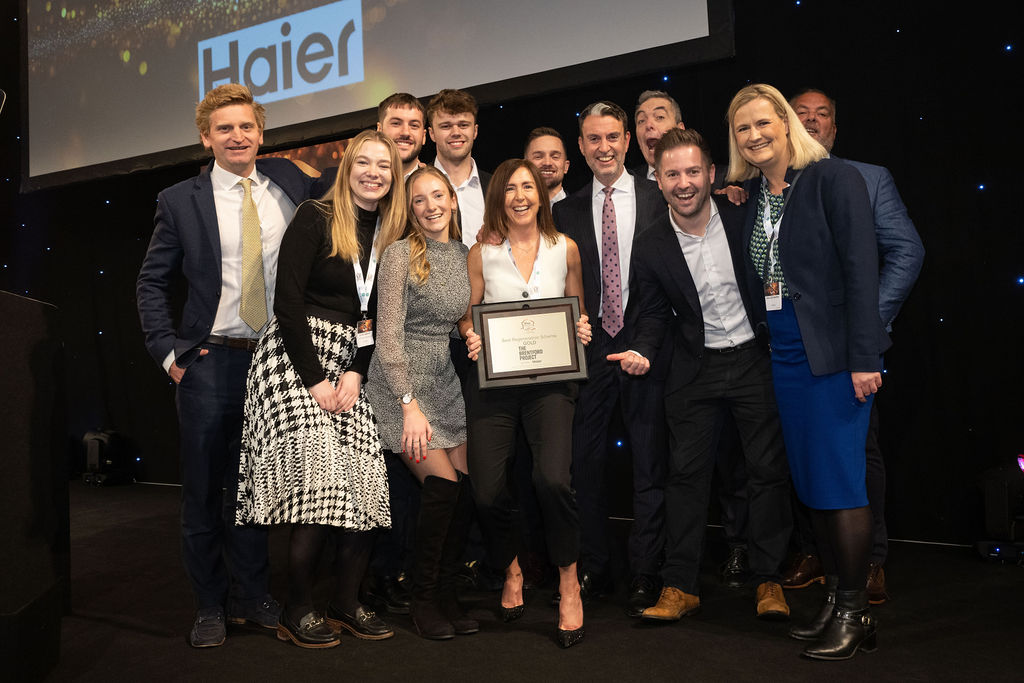
布倫特福德計畫在今年共斬獲五項大獎,其中包括夏季榮膺的「英國住宅獎-年度最佳城市再生計畫」獎以及「PROPS年度開發獎」。此外,該計畫近期還在《倫敦旗幟晚報》(Evening Standard)「新住宅獎」評選中獲得高度讚譽,並在「倫敦建築規劃獎」中被評為最佳新生活居住地的傑出獎項。
布倫特福德項目的住宅起售價為435,000英鎊。歡迎了解更多。
Related Articles
Ballymore荣膺WhatHouse两项金奖
我们很高兴地宣布,Ballymore位于伦敦西部的开发项目——布伦特福德项目(The Brentford Project),在第44届What House大奖中荣获两项金奖,该奖项是为了表彰Ballymore在英国住宅建设领域的卓越成就。
What House Awards被誉为新房行业的“奥斯卡”,获奖者是真正卓越的象征。能参加由演员詹姆斯·内斯比(James Nesbitt)主持的盛大颁奖典礼,并与1300位行业精英齐聚一堂,共同见证Ballymore的成果获得如此高规格的认可,实在是莫大的荣幸。
Ballymore荣获的“最佳综合开发”和“最佳再生项目”两项金奖,充分体现我们的团队在打造充满活力、可持续社区方面的不懈努力得到了业界的承认。布伦特福德项目以其卓越的居住空间、创新的设计理念以及繁荣的商业中心,完美诠释了我们对西伦敦城市重建的全新定义。
巴利摩集团董事总经理约翰·马兰(John Mulryan)表示:“这次双金奖的荣誉对参与布伦特福德项目的每一个人来说都是非凡的成就。这是对我们团队与合作伙伴远见卓识与辛勤付出的最佳肯定,并且真正实现了区域的转型。这个项目以其深思熟虑的开放式的设计理念,以及居住、工作与休闲空间的巧妙融合,充分体现了我们对打造宜居的繁荣社区的承诺。这些奖项进一步认证了我们对创建经得起时间考验的社区的承诺。”

布伦特福德项目在今年共斩获五项大奖,其中包括夏季荣膺的“英国住宅奖——年度最佳城市再生项目”奖以及“PROPS年度开发奖”。此外,该项目近期还在《伦敦旗帜晚报》(Evening Standard)“新住宅奖”评选中获得高度赞誉,并在“伦敦建筑规划奖”中被评为最佳新生活居住地的杰出奖项。
布伦特福德项目的住宅起售价为435,000英镑。欢迎了解更多信息。
Related Articles
Bishopsgate Goodsyard重建項目取得新進展
Ballymore和Hammerson攜手推出的Bishopsgate Goodsyard(簡稱“The Goodsyard”)重建項目的兩個專項深化設計申請(RMAs)已通過倫敦大都會市政府 (GLA) 的批准。其一是打造一個位於Shoreditch車站上方的主要商業建築,這是即Sclater Street歷史建築修復項目獲得批准後,又一成功通過了深化設計審批的項目。
2022年,倫敦市長批准了The Goodsyard項目的全面重建規劃。這一計畫將在位於肖爾迪奇(Shoreditch)占地4.5公頃的土地上打造一片全新社區,包括住宅、零售店、休閒中心、辦公空間以及一座全新的公園。該項目橫跨倫敦塔橋區(London Borough of Tower Hamlets)與哈克尼區(London Borough of Hackney),將賦予這一歷史悠久社區全新的面貌。
由國際知名建築事務所Gensler與Buckley Gray Yeoman聯手設計的首個深化設計申請的通過,標誌著該項目進入了實質性的推進階段。這個申請計畫包含打造36,000平方米的頂級辦公空間,其中包含專為中小企業設計的經濟適用空間。此外,還將在貝思納爾格林路(Bethnal Green Road)與肖爾迪奇高街(Shoreditch High Street)沿線新增600平方米的零售空間,同時開闢一條名為“Middle Road”的全新街道,將Brick Lane與肖爾迪奇高街的這兩條歷史名街串聯起來,重塑街區的走勢。
另一項由Chris Dyson Architects設計的Sclater Street項目申請,則聚焦於修復Sclater Street上五棟年久失修的歷史建築,將其重新煥發活力。這些見證了城市變遷的珍貴建築將通過此次複建得到妥善保護,並被改造成集零售、咖啡館與共享辦公於一體的多功能空間,此外還將在上層新增三戶住宅,為社區注入新鮮活力。
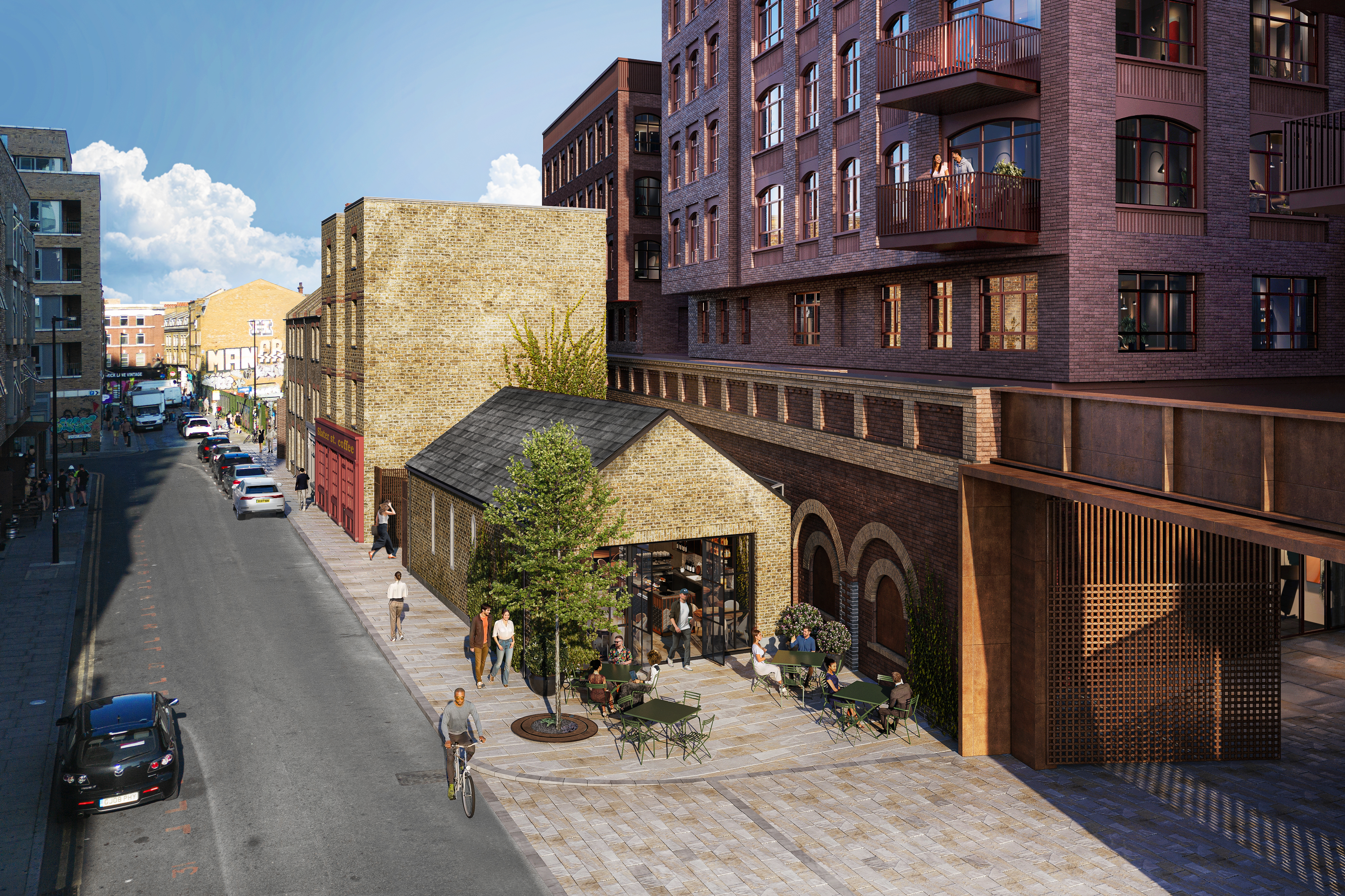
Hammerson集團首席開發與資產重組官Harry Badham補充道:“The Goodsyard是倫敦市中心最後一塊規模宏大並且尚未開發的寶地,具備引領未來城市營造與整體性再生的非凡潛力。這座計畫中的辦公大樓,不僅是打造一個國際新地標的重要組成部分,更是植根於獨特而不斷演變的本地文化的象徵。”
“這座辦公樓將為該地區帶來全新的建築連同方式的體驗,同時也大幅地提升了地面首層空間的使用體驗,為辦公空間使用者、居民和到肖爾迪奇訪問的客人提供更舒適宜人的生活工作環境。”
Sclater Street和一號辦公樓的深化設計申請的通過,標誌著整個Goodsyard 項目步入了入實施階段。未來幾個月內,我們還會有更多深化設計申請提交,以供大倫敦市政管理局(GLA)諮詢和審議。
一旦項目竣工後,整個Goodsyard地區將會有如下的亮眼變化:
● 多達 500 套新住宅,其中 50% 為經濟適用房,重點聚焦家庭套房。
● 140 萬平方英尺的辦公空間,包括倫敦規模最大的經濟實用辦公空間之一。
● 一個全新的占地 2.6 英畝的綠化公園。
● 全新的餐廳、零售店及休閒空間。
● 兩個新的文化場所——一個修建在Brick Lane,另一個會展空間位於歷史建築Braithwaite Arches之中。
● 在建設期間和項目完成後會創造11,000 個工作機會。
● 提供150個學徒培訓的機會。
欲瞭解更多提案資訊,請點擊這裏。
Related Articles
Bishopsgate Goodsyard重建项目取得新进展
Ballymore和Hammerson携手推出的Bishopsgate Goodsyard(简称“The Goodsyard”)重建项目的两个专项深化设计申请(RMAs)已通过伦敦大都会市政府 (GLA) 的批准。其一是打造一个位于Shoreditch车站上方的主要商业建筑,这是即Sclater Street历史建筑修复项目获得批准后,又一成功通过了深化设计审批的项目。
2022年,伦敦市长批准了The Goodsyard项目的全面重建规划。这一计划将在位于肖尔迪奇(Shoreditch)占地4.5公顷的土地上打造一片全新社区,包括住宅、零售店、休闲中心、办公空间以及一座全新的公园。该项目横跨伦敦塔桥区(London Borough of Tower Hamlets)与哈克尼区(London Borough of Hackney),将赋予这一历史悠久社区全新的面貌。
由国际知名建筑事务所Gensler与Buckley Gray Yeoman联手设计的首个深化设计申请的通过,标志着该项目进入了实质性的推进阶段。这个申请计划包含打造36,000平方米的顶级办公空间,其中包含专为中小企业设计的经济适用空间。此外,还将在贝思纳尔格林路(Bethnal Green Road)与肖尔迪奇高街(Shoreditch High Street)沿线新增600平方米的零售空间,同时开辟一条名为“Middle Road”的全新街道,将Brick Lane与肖尔迪奇高街的这两条历史名街串联起来,重塑街区的走势。
另一项由Chris Dyson Architects设计的Sclater Street项目申请,则聚焦于修复Sclater Street上五栋年久失修的历史建筑,将其重新焕发活力。这些见证了城市变迁的珍贵建筑将通过此次复建得到妥善保护,并被改造成集零售、咖啡馆与共享办公于一体的多功能空间,此外还将在上层新增三户住宅,为社区注入新鲜活力。

Hammerson集团首席开发与资产重组官Harry Badham补充道:“The Goodsyard是伦敦市中心最后一块规模宏大并且尚未开发的宝地,具备引领未来城市营造与整体性再生的非凡潜力。这座计划中的办公大楼,不仅是打造一个国际新地标的重要组成部分,更是植根于独特而不断演变的本地文化的象征。”
“这座办公楼将为该地区带来全新的建筑连同方式的体验,同时也大幅地提升了地面首层空间的使用体验,为办公空间使用者、居民和到肖尔迪奇访问的客人提供更舒适宜人的生活工作环境。”
Sclater Street和一号办公楼的深化设计申请的通过,标志着整个Goodsyard 项目步入了入实施阶段。未来几个月内,我们还会有更多深化设计申请提交,以供大伦敦市政管理局(GLA)咨询和审议。
一旦项目竣工后,整个Goodsyard地区将会有如下的亮眼变化:
● 多达 500 套新住宅,其中 50% 为经济适用房,重点聚焦家庭套房。
● 140 万平方英尺的办公空间,包括伦敦规模最大的经济实用办公空间之一。
● 一个全新的占地 2.6 英亩的绿化公园。
● 全新的餐厅、零售店及休闲空间。
● 两个新的文化场所——一个修建在Brick Lane,另一个会展空间位于历史建筑Braithwaite Arches之中。
● 在建设期间和项目完成后会创造11,000 个工作机会。
● 提供150个学徒培训的机会。
欲了解更多提案信息,请点击这里。
Related Articles
Plans submitted for 3,600 riverside homes in E16
John Mulryan, Managing Director, Ballymore, comments:
“I’m incredibly proud of the quality of design and future thinking that has gone into these two proposals for the Royal Docks. We’ve been deeply committed to this part of London for several decades, and it’s a gift to be able to expand upon the success of Royal Wharf so that we can continue to support the neighbourhood’s growth and build upon its character.
“Royal Wharf has become a blueprint for successful brownfield development – completed back in 2020 yet to this day delegations from around the world visit to study the project. We look forward to a determination on the Knights Road and Thames Road proposals and hope to start construction next year.”
These two latest applications follow Ballymore’s submission of major planning applications in Edgware and in Ladbroke Grove over the last 12 months. Together, Ballymore has live planning applications totalling 11,000 homes proposed for London. Its consented pipeline comprises 5,000 homes which could be delivered in the next six years, including Cuba Street on the Isle of Dogs, and final phases at Embassy Gardens in Nine Elms and at its town centre regeneration in Hounslow, The Brentford Project.
Ballymore also recently announced two RMA consents for a new commercial building and the restoration of historic buildings at Bishopsgate Goodsyard, as delivery begins to come forward in partnership with Hammerson in Shoreditch and Brick Lane. The company also received consent for its RMA at Stratford Waterfront, 700 homes in partnership with London Legacy Development Corporation, and has works underway for a new bridge on the Queen Elizabeth Olympic Park which will enable delivery of Bridgewater Triangle, also in partnership with LLDC.
Related Articles
Bishopsgate Goodsyard redevelopment progresses
Ballymore and Hammerson are working together to deliver the redevelopment of Bishopsgate Goodsyard, (‘The Goodsyard’) and have received approval on two Reserved Matters Applications (RMAs) from the Greater London Authority (GLA). One of the main commercial buildings, to be located above Shoreditch station, have achieved detailed design approval shortly after another approval for the restoration of historic buildings on Sclater Street.
In 2022, the Mayor of London granted Planning Permission for the comprehensive redevelopment of The Goodsyard. The scheme will deliver new homes, retail and leisure, workspace and a new park built on the 4.5-hectare site in Shoreditch, which spans the London Borough of Tower Hamlets and the London Borough of Hackney.
Designed by Gensler and Buckley Gray Yeoman, the RMAs mark the next stage in the realisation of the approved scheme. The first RMA will provide 36,000 sq m of best-in-class workspace, including affordable space for small and medium sized businesses. In addition, it will deliver 600 sq m of new retail space fronting Bethnal Green Road and Shoreditch High Street as well as a new ‘Middle Road’ connecting the historic fabric of Brick Lane and Shoreditch High Street.
The Sclater Street RMA, designed by Chris Dyson Architects, includes the restoration of five derelict historic buildings on Sclater Street to bring them back into use. These buildings, which are part of the historic fabric of the neighbourhood, can now be protected and restored as part of the redevelopment of The Goodsyard. As a result, new retail, café spaces, and co-working space will be created as well as three homes on the upper floors.

John Mulryan, Group Managing Director at Ballymore said: “These RMA approvals mark the beginning of delivery of The Goodsyard. The result will be the re-opening of one of London’s most important historical assets located between the City and Shoreditch.
“The office site presents a rare opportunity to create one of the most forward-thinking workspace environments in London. Our flexible, sustainable commercial spaces are specifically designed with the end user’s needs in mind for both functionality and well-being. The area will celebrate and expand on the ever-evolving creative vibe of Shoreditch.”
Detailed designs for the building and Sclater Street follow consultation with local stakeholders at the GLA as well as in both Tower Hamlets and Hackney, including a public consultation event for the workspace building and drop-in event for Sclater Street. In line with feedback, the design team developed a façade for the commercial building which is both sympathetic to the historical character of Shoreditch and reflective of a contemporary aesthetic.
Harry Badham, Chief Development and Asset Repositioning Officer at Hammerson added: “The Goodsyard is one of the last undeveloped sites of scale in central London which has the potential to lead the way in terms of placemaking and holistic regeneration. This proposed workspace building is part of creating a new international destination rooted in a unique and ever-evolving local culture.
“The workspace building will bring new physical connections to this area while delivering a significantly improved ground floor experience for both workspace users, residents and visitors to Shoreditch.”
The RMAs for Sclater Street and workspace building 1 are the beginning of the delivery of the entire Goodsyard site. Further RMAs will be brought forward for consultation and consideration by the GLA over the coming months.
Once complete, the entire Goodsyard site will deliver:
Up to 500 new homes, including 50% affordable, with a focus on family homes.
1.4m sq ft of workspace, including one of the largest offers of affordable workspace for businesses.
A new 2.6 acre public park
New restaurants, retail and leisure spaces.
Two new cultural spaces – one destination building on Brick Lane and one exhibition space within the historic Braithwaite Arches.
11,000 new jobs during construction and after completions.
150 apprenticeships.
To find out more information on the proposals, please click here.
Related Articles
A year of cuisine and community
It’s been a year since Sam Harrison and business partner Fanny Stocker opened the doors to Sam’s Waterside at The Brentford Project. As they celebrate a terrific first 12 months, we catch up with Sam who is now the proud recipient of 2 AA Rosettes for the food he’s serving, the cherry on the top in what has been a hectic if not exhilarating year.
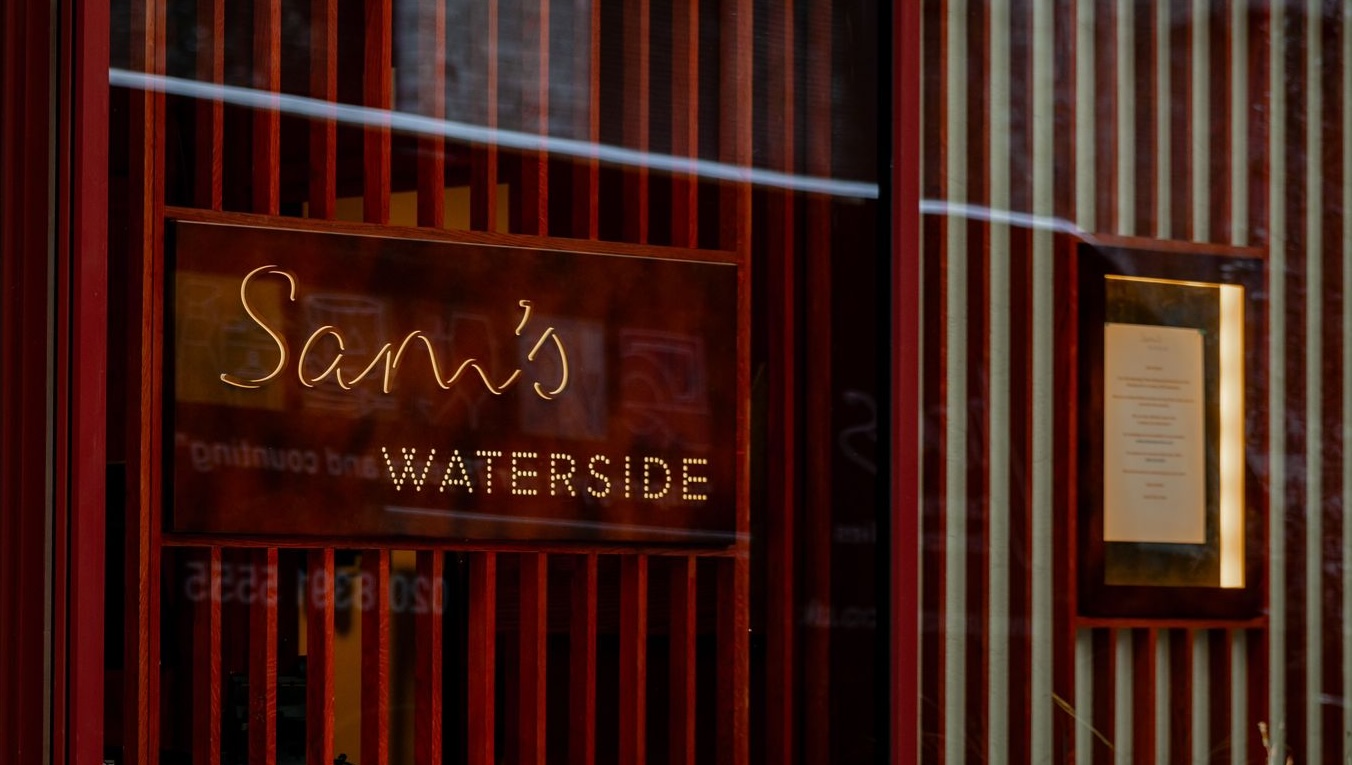
“I’ll sleep on Christmas Day!”
Happy Birthday to us! What a year it’s been - I’m still continually touched by how many people continue to say ‘thank you, we’ve been waiting for a restaurant like this in Brentford." I feel like we have made a real impact opening here, one guest told me that she'd been waiting 30 years, so I think we’re doing something right!
It’s been a year of highs and lows as to be expected when opening a new restaurant. It was tough opening as winter approached and so we greatly enjoyed seeing the Brentford Project come to life in the Spring and Summer with Ballymore’s events and live music by the waterside. We’re excited to see this continue and for the whole area to be thriving and full of life. We love being on the water at Workhouse Dock and it is great to see it becoming a focal point for the area and a hub for the whole community; it’s certainly what attracted me to open my restaurant here.
This location is really quite special, there is a great sense of local community which we love about Brentford. People are very proud of it and locals seem proud to have us as part of it which I’m very grateful for. As a team we’re looking forward to seeing how the neighbourhood continues to evolve and which other businesses will join us here. It’s still such early days so it’s really exciting.
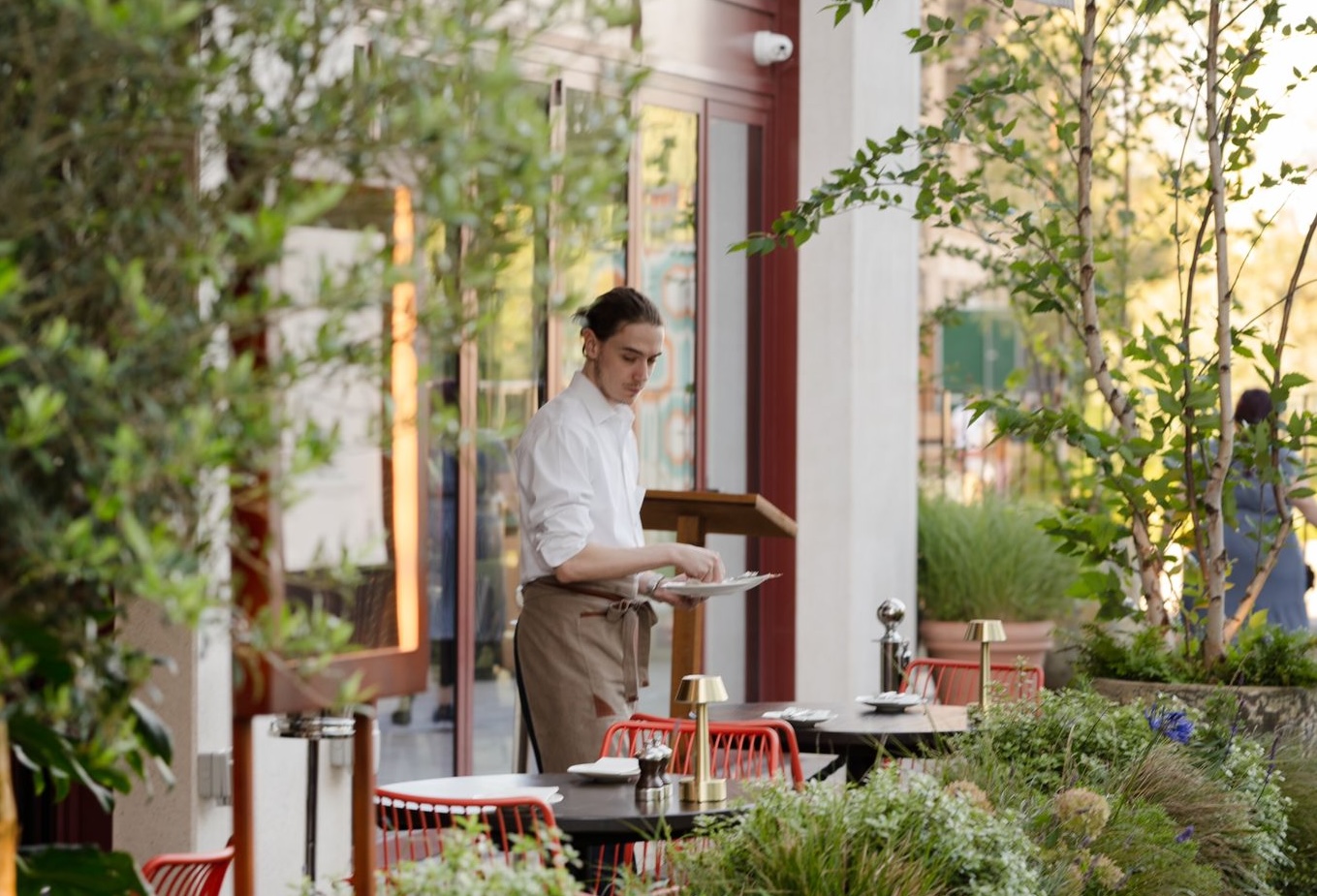
Constantly creating
We are continually evolving our menu and options for dishes and we like to link our menu to seasonality and availability, but our Head Chef Jacob and I love being creative and trying new things so there’s always some testing going on behind the scenes. Through the new year into January we are working on a series of special evenings featuring chef collaborations and wine tastings which we can’t wait to launch. Think seafood celebrations, jazz nights and lots more to come!
I love the mix of clientele we get, it’s so important to attract a mix of people for a neighbourhood restaurant to survive. We need different people coming in on different days, at different times and for different reasons; it might be for a special celebration on a Friday night or just because they can't be bothered to cook at home on a Tuesday night! I love how many regulars we have already, it feels like they have already become part of our family. We also have some great celebrity regulars and some impressive big names… but a good restaurateur never reveals!
A job well done
It’s always wonderful to hear the positivity and feedback from our customers. I’m genuinely thrilled with how grateful guests seem to be to have us here. We often hear that our food is “some of the best food I have ever had” or the “best Sunday lunch in London.” It makes the non-stop schedule worthwhile.
Overall it’s been an amazing year, and while tough at times we’ve had some incredible highlights – including the 2 AA Rosettes we’ve received for our food and our nomination for the award of West London's Best New Business.
I’m hoping for a very busy run up to Christmas, and the team and I are ready to welcome new and existing customers to experience our food and atmosphere. We will close for Christmas Day and Boxing Day – a period in which I intend to sleep before returning with a bang for the New Year celebrations! I’m confident 2025 will be a defining year for The Brentford Project as it continues to flourish.
Related Articles
A new playground for Malahide
Minister and local TD Darragh O’Brien has joined the Mayor of Fingal Cllr Brian McDonagh and representatives from Ballymore this week to officially opening a new playground in Malahide.
The fully accessible play space has been designed by Ballymore to complement its newest neighbourhood at Seamount Rise. It has been created in collaboration with Fingal County Council’s Parks Department, Park Hood Landscape Architecture and local suppliers, and is part of Ballymore’s ongoing commitment to creating inclusive and community-oriented developments.
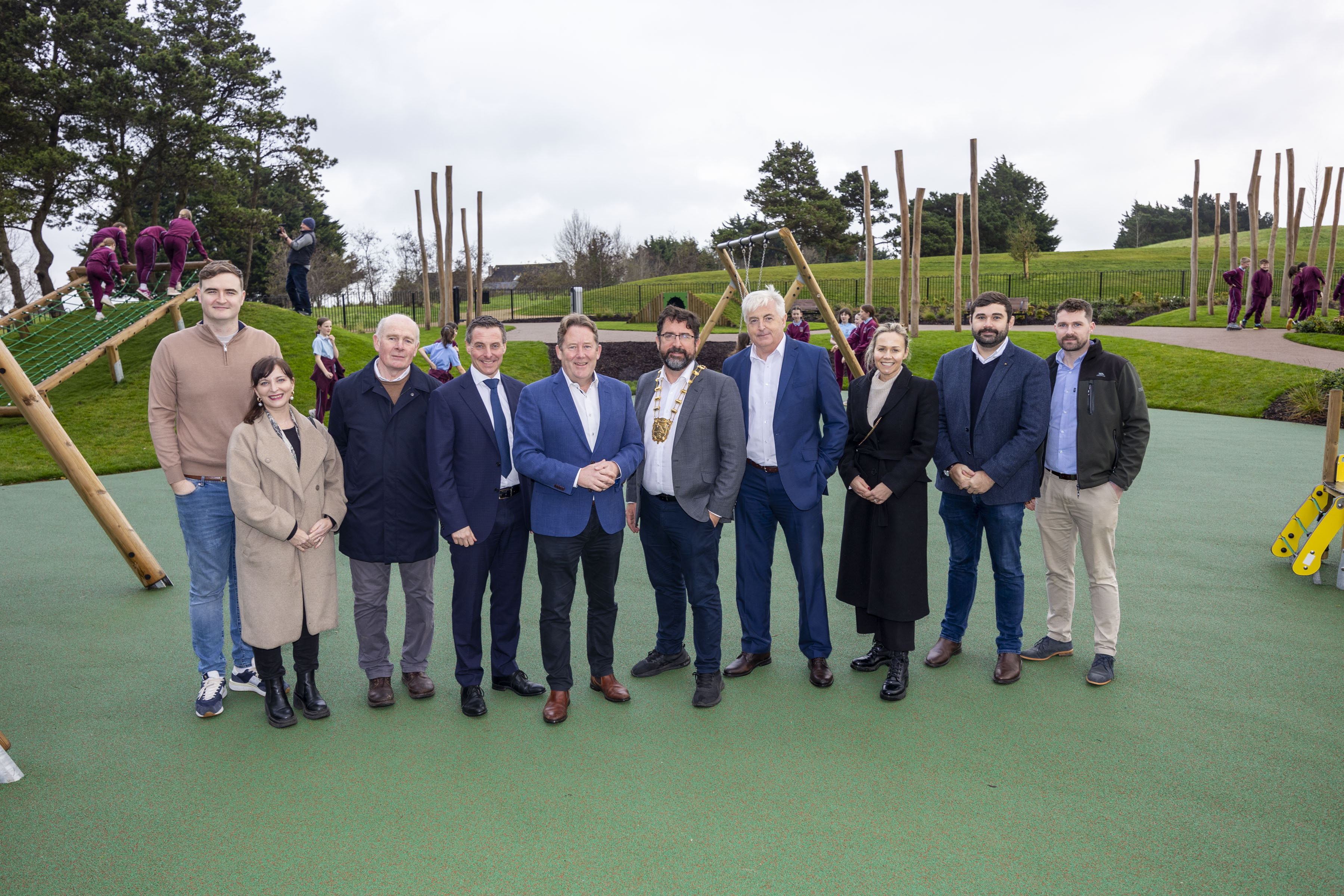
It is designed to blend with the natural surroundings, featuring timber swings, a roundabout, slide, and vertical timber poles which add a distinctive touch to the play area. Built with locally sourced, natural materials, the playground harmonises with the landscape, providing a space that celebrates the Irish aesthetic while catering to families and children in the area.
Ballymore’s approach to the project was to create a design that respects the local environment and natural habitat. The site’s elevated location offers spectacular views, with one side overlooking Ballymore’s residential buildings and the other offering a clear vista to Dublin. In addition, the surrounding space includes a designated biodiversity area with a blossoming wildflower meadow and habitats that support local bat populations as Pat Phelan – Managing Director of Ballymore who opened the playground with Darragh O’Brien and the Mayor – explained: “It’s a joy to see this space completed, the culmination of design work and collaborating with the local council to shape this former golf course mound into an accessible playground and a pathway that connects different parts of the development.
“The playground is a fantastic space for everyone in the local community, and I hope that it is used by those living at Seamount Rise and beyond.”
Accessibility and inclusion were core considerations in the playground’s design, ensuring it accommodates all visitors, including wheelchair users and families with buggies. Pat Phelan continued: “We designed this space to ensure that all children, including those with special needs, can enjoy it comfortably. Local parents, especially those with children with autism, have given us positive feedback on the inclusive layout. We’ve also installed communication boards that allow children to point to activities they’d like to try, making it easier for everyone to interact and engage.”
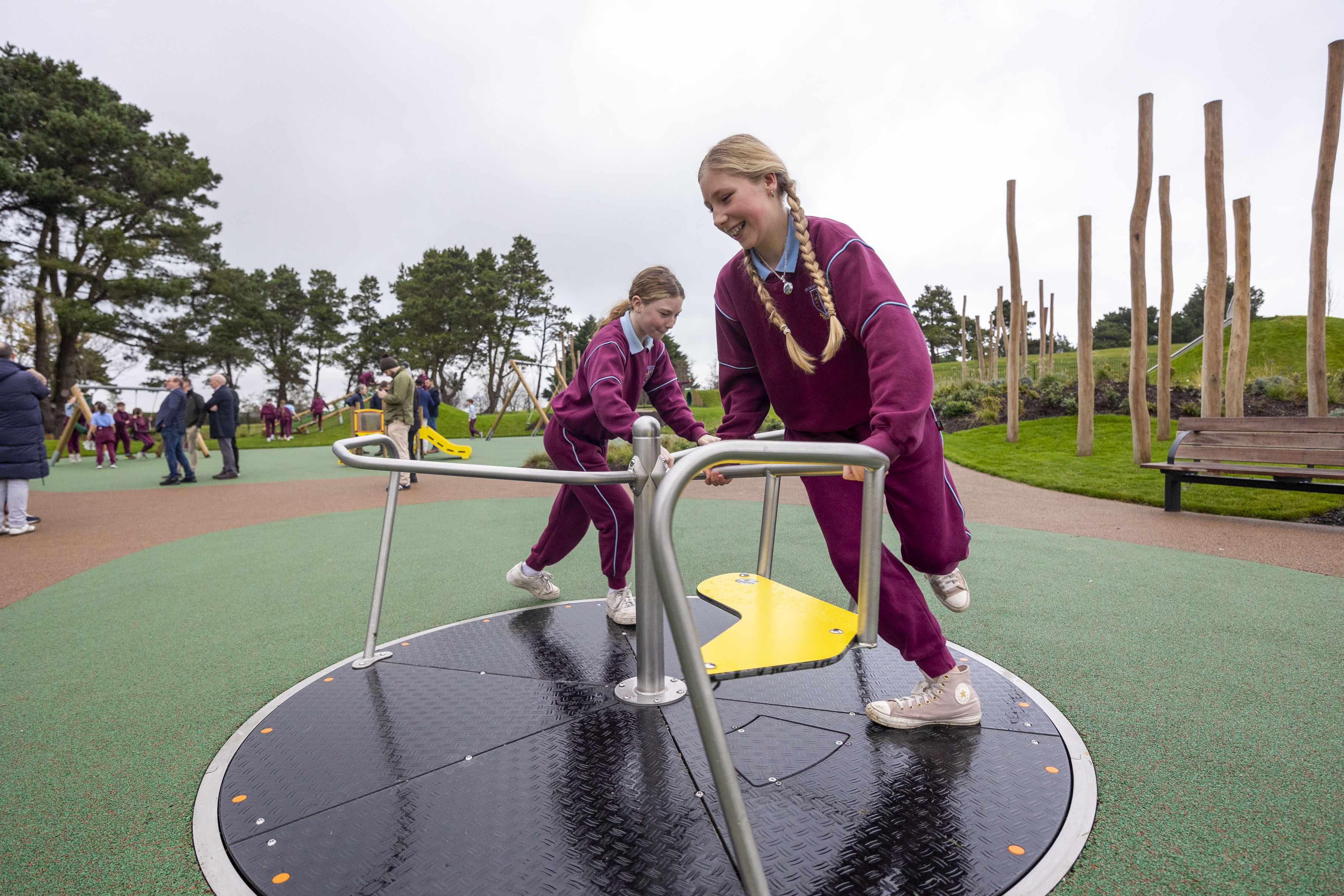
Mayor of Fingal, Cllr Brian McDonagh, added: “This is a beautiful playground that represents a brilliant investment and delivers a fantastic addition to the area. It will serve the community for many years to come and be a great place for children of all abilities to play, explore and enjoy the great outdoor space that’s on offer. We're doing an audit of all our playgrounds and I think this shows what can be done to develop play facilities that are within easy walking and cycling distance for everybody.”
The new playground also boasts green space, with Ballymore committing to protecting the area’s natural flora by planting native Irish species such as Scots pine and birch trees, supporting the local biodiversity. It also offers convenience for local people, creating a shortcut across Seamount Rise, saving residents a 20-minute walk.
Minister for Housing, Local Government and Heritage, Darragh O’Brien TD praised the project: “This playground at Seamount Rise reflects the heart of what we want for our communities; accessible, thoughtfully designed spaces that bring people of all ages together. Projects like this demonstrate how local authorities and developers like Ballymore can work together to create amenities that enhance quality of life for residents and strengthen community ties.”
Seamount Rise is Ballymore’s newest neighbourhood comprising 59 family homes and 76 apartments, with high-specification, high-quality residences – with 2.7-metre ceiling heights, floor-ceiling glazing, and spacious balconies from which residents can enjoy the captivating sea and mountain views. Find out more here.
Related Articles
Double gold for Ballymore at the What House Awards
We are thrilled to announce that our West London development, The Brentford Project, has scooped Gold in two categories at the 44th What House? Awards, celebrating the best in UK housebuilding.
The awards are regarded as the Oscars of the new homes industry, and are a true mark of excellence. It was a privilege to attend the gala, hosted by actor James Nesbitt, alongside 1,300 industry professionals, and to see our work recognised at such a high level.
Our awards for Best Mixed-Use Development and Best Regeneration Scheme reflect the dedication of our Ballymore team to creating vibrant, sustainable communities. The Brentford Project exemplifies our commitment to blending exceptional living spaces with innovative design and thriving commercial hubs, redefining urban regeneration in West London.
John Mulryan, Group Managing Director at Ballymore said: “This double win is a fantastic achievement for everyone involved in The Brentford Project. It’s a testament to the vision and hard work of our teams and partners, who are bringing to life a development that truly transforms the area. From its thoughtful design to its dynamic mix of homes, workplaces, and leisure spaces, The Brentford Project embodies our belief in creating places where people can thrive. These awards reinforce our commitment to shaping communities that stand the test of time.”

The Brentford Project has won a total of five awards this year, earning the prestigious British Homes Award for Regeneration Scheme of the Year this summer, as well as the PROPS Development of the Year Award. The Brentford Project was also recently Highly Commended at the Evening Standard New Homes Awards and in the Best New Place to Live at the Building London Planning Awards.
Homes at The Brentford Project start from £435,000. Find out more.
Related Articles
Retail competition launches for Edgware
As part of our £1.7 billion transformation of Edgware town centre, Ballymore is offering local organisations the chance to win free retail space at Broadwalk Shopping Centre.
Led by SaveTheHighStreet.org, the initiative is perfect for budding entrepreneurs and established businesses looking for a fresh start. The prize includes not only a retail unit but also comprehensive, hands-on business support, all free of charge.
Ballymore’s partnership with Places for London has set the wheels in motion for Edgware’s transformation into a vibrant, future-proofed urban centre, featuring thousands of new homes, green spaces, and employment opportunities. This unique opportunity will allow the winning business to thrive within Edgware’s revitalised hub, reaching a new community and becoming part of an evolving high street for an initial three months, with the opportunity to extend after.
Alex Schlagman, a Founding Partner of SaveTheHighStreet.org, says: “It’s time to turn vacant shops into incubators that attract, support and retain promising high street entrepreneurs. We’ve been seeing great successes with these projects in other areas and are excited to be working with so many forward-thinking local partners across the London Borough of Barnet to make ‘The Edgware Startup’ a reality this year.”
Ballymore’s redevelopment plan includes a new retail and transport hub, providing seamless access in and out of the centre and a stage for businesses to reach thousands of new visitors. With a £1.7 billion investment, we’re set to generate over 1,400 full-time jobs and £80m in local economic value upon completion. Simon Ryan, Developments Director at Ballymore says "The Edgware Start Up is an incredible opportunity designed to help local people get the break they need to thrive in business.
“The competition is the latest initiative we've launched, ahead of our proposed £1.7bn investment into Edgware Town Centre, as testament to our commitment to Edgware and its future. The Edgware Start Up follows the launch of the Edgware Business Improvement District and a Community Fund for charitable groups and organisations. I look forward to seeing the entries and good luck to all the entrepreneurs out there!"
If you’re ready to be part of Edgware’s future and take your business to the next level, enter here.
Related Articles
Goodluck Hope; A vibrant cultural destination
Featuring a fusion of culture, art, food and drink, Goodluck Hope hosted an interactive five month ‘Islander Festival,’ enriching the community with inspiring experiences, connection and discovery, cementing it as one of the most exciting places to live in the capital.
From singing masterclasses to sunrise yoga, gin nights to drag bingo, the eclectic offerings showcased the innovative and creative businesses based across the Island providing much opportunity for residents and visitors to connect and experience life in our East London neighbourhood.
Goodluck hope has been the centre of activity over the past five months as the community experienced our immersive Islander Festival, which began in May and came to an end last month. The innovative programme of events was awash with ingenious and imaginative ways to spend time, very much living up to its reputation as an Island brimming with personality, creativity and discovery.
A jam-packed itinerary
Orchestrated to encourage the local community to try something new while spending time in the lively neighbourhood, the festival anchored around a weekly itinerary featuring Workshop Wednesdays, Thirsty Thursdays, Film Fridays, Social Saturdays and Sunrise Sundays in a bid to appeal to all members of the community as well as attracting visitors far and wide.
The programme of workshops reflects the range of innovative and creative businesses abundant in the area with participants welcomed to engage in a new skill and meet new people. From pottery workshops with Art Craft Studios, to vocal workshops by Dantae Johnson from City Island-based music studios The Woods, which explored the power of music to assist in wellbeing through various vocal exercises, each experience offered something unique and many of the sessions sold out within just a few days.
For culinary fans there was an interactive viennoiserie class led by Goodluck Hope’s new destination bakery and cafe, Layers, and the wonderfully conceptual ‘Self Health’ workshop, led by popular book club Shelf Help and founder Toni Jones. Attendees explored how to understand and improve their relationship with themselves, with guidance on how to achieve personal goals.
Thirsty Thursdays ignited a vibrant crowd tempted by a series of themed drinks pop-ups located on the Goodluck Hope Dry Dock, accompanied by live music from up-and coming London talent, providing a scenic backdrop for people to connect and relax. Film Fridays were packed full of screenings to suit all tastes ranging from the English National Ballet’s Giselle to Jodie Cromer’s career defining performance in the poignant Prima Facie.
The community came out in full force to soak up all that was on offer for Social Saturdays, from affordable art pop ups at the Goodluck Hope Sales Gallery, to Drag Bingo with Sheila Simmonds who also hosted an evening of music, comedy, and live entertainment. Families and children were able to enjoy a ‘Mini Me’ art workshop and a teddy bear picnic & music workshop at Docklands Village Nursery, with creatives catered for in a special workshop run by London Lighthouse Gallery & Studio’s resident artist, Sokari, focused on architectural photography.
Sunrise Sundays were paired back and centred around wellbeing with a series of early morning yoga classes in the Lantern Room Viewing Deck, led by Hum Yoga and concluding each week with meditation and mindful movement. These proved so popular that extra dates were added affirming the success of the festival in bringing people together in new ways.
As Ballymore’s Laura Jeffery concluded: “The abundance of experiences on offer at Goodluck Hope has been truly exceptional, affirming it as a neighbourhood that provides a rich and vibrant community. The festival highlights the destination as a cultural hotbed of activity, full of creative businesses passionate about bringing people together through unique experiences. Thank you to everyone who took part and made it the huge success that it was.”
Related Articles
Royal Wharf points the way to delivering essential homes
With 10,000 residents, shops, cafes, a school, businesses and its own football club, Royal Wharf is seen by those who live and work there as a true community and it could be a model for the future.
As the government looks to boost delivery of new homes, Ballymore’s Royal Wharf in east London is demonstrating how large-scale development can create desirable places, meet today’s urgent need for housing and foster communities.
Ballymore brought resources and vision to transform this 40-acre site beside the River Thames. “We saw this as a massive opportunity to create a new town effectively,” says John Mulryan, the company’s Managing Director. “So we’ve built a new high street, new school, shops, businesses - all have relocated to this place, which only a few years ago was a completely barren wasteland and has now been turned into home for 10,000 people.”
“It’s not just about creating homes. It’s about creating the infrastructure, the community and the facilities, so that what we’re building is not just a housing estate; it’s a proper place,” stresses Glenn Howells, Director and founder of architect Howells, which masterplanned the new neighbourhood.
Alongside c.4,000 homes, Royal Wharf has restaurants, cafes, community centre, a dentist, pharmacy, green spaces and Royal Wharf Pier, London’s longest riverboat terminal and the newest stop on the Uber by Thames Clippers service. All this and more were constructed in just six years. “What’s remarkable about that is it enabled the community to take root and grow and become established very, very quickly,” explains Howells.
Watch our video to learn more about Royal Wharf's transformation story.
Those who live and work in the area agree. “A very significant value that we have is that we want to involve our school in the community, and the community in our school,” says Linda-May Bingham, Executive Head Teacher at the new Royal Wharf Primary School. “There’s definitely a very strong sense of community spirit at Royal Wharf and it’s a very vibrant, positive place for families to live”. Nicola Micah, owner of the nearby Little Hudson Café, says, “I feel like the area has a really good community spirit, especially now that a lot more shops and local businesses have opened up”.
That community spirit comes not only from the amenities, but also from the activities on offer, many of them organised by local charity, the West Silvertown Foundation, which has a centre at Royal Wharf. “There’s always something going on and there’s always opportunities to meet people and make really, really good friends,” says new resident Chandrika.
As a result, residents describe Royal Wharf as a diverse and welcoming community. “There are lots of young families or couples with dogs and everyone’s really friendly,” says resident Jo. “It’s not like in other places where you don’t really know your neighbours,” says resident Jonnie. “We’ve got friends more than neighbours.”
Royal Wharf’s community spirit continues to grow, thanks to the efforts of residents like Vito Monteiro. “I was always passionate about football and coaching, so I decided to start a football club to bring the community together,” he explains. Royal Wharf FC is already making its mark in the Echo Junior league, its under 7s team proudly taking home a trophy last year.
The challenge for the government is to replicate the successes of Royal Wharf to meet the pressing demand for new homes; Mulryan has an answer. “If we want the private sector to build more homes in London, we need to have an environment that encourages investment,” he says. Royal Wharf did not require public funding but attracted capital from international investors.
“In Royal Wharf, we had a Singaporean development partner in Oxley – they could have invested anywhere in the world, but they decided they wanted to invest in London residential,” Mulryan continues. “That was a positive thing for London and a positive thing for the 10,000 people who now call this their home. I think we need to see that type of investment as a good thing for our city and we need housing and fiscal policy to incentivise this kind of investment which would not be possible in the current environment.”
Related Articles
Camden Council selects Ballymore and Lateral as JV partners at Camley Street
Urban regeneration specialist Ballymore is partnering with Life Sciences Developer/Operator Lateral to deliver the Camley Street project, a key project in Camden’s Community Investment Programme. The redevelopment is in a prime location in what is known as the “Knowledge Quarter” – the area of King’s Cross where world-leading research and technology institutes and companies have made their home. Split across two sites, the planned redevelopment will:
Deliver around 350 new, energy-efficient homes – around 170 of these will be genuinely affordable homes;
Increase the employment space on the sites through the delivery of more than 200,000sq ft of Knowledge Quarter-led commercial space, creating around 1,000 jobs in the light industrial, life sciences, technology, and digital industries;
Build on and enhance the existing innovation ecosystem and growth initiatives in an area which has a proven and consistent high demand for science and technology facilities;
Establish a new, greener neighbourhood in Camden with new public open spaces, improving biodiversity. New shops, cafes and improved pedestrian and cycling routes will support stronger links to King’s Cross Central and Camden Town;
Support an inclusive economy by creating light industrial and affordable workspace to support start-ups and SMEs.
The affordable homes will be a mix of homes at social rents, providing much need homes for families on our housing register; and intermediate homes, available for rent at a reduced rate with a secure tenancy, giving key workers such as teachers and nurses an affordable home in which to live and stay in Camden.
Ballymore and Lateral will now form a Joint Venture and will work with Camden Council, local residents and businesses to further develop these plans before submitting for planning during the second half of 2025.
Subject to planning permission being secured and relevant conditions being met, the Joint Venture would then acquire 3–30 Cedar Way Industrial Estate (‘Site B’ - 2.37 acres) on a long leasehold to deliver commercial space, private residential units and affordable homes. Camden Council would directly deliver affordable housing and affordable commercial space on 120–136 Camley Street (‘Site A’ - 1.19 acres). The redevelopment has an anticipated Gross Development Value (GDV) of £500 million.
Councillor Nasrine Djemai, Cabinet Member for New Homes and Community Investment, Camden Council, said: “We’re getting on with building the new energy-efficient family sized homes that are desperately needed and creating the employment space which will help Camden’s Knowledge Quarter continue to grow and provide the good, well-paid work our residents need. Through our Community Investment Programme we’ve built over 1,500 homes, a third of our target of 4,850 new homes. Half of the new homes at Camley Street will be affordable - either social or intermediate rented, and around 200 of the homes will have two or more bedrooms – the spacious, family-sized homes we need more of in Camden.
“The life science, technology, and digital industries are booming in Camden – we want to facilitate this growth and crucially ensure our residents have access to the jobs created by them. This includes work experience placements with school children, creating apprenticeships, providing training, so that residents growing up in Camden now have a clear pathway into these jobs.
“Over the past few years, Camden Council has worked with residents and businesses nearby to shape a Shared Vision for Camley Street. We will work in partnership with Ballymore and Lateral to ensure they are committed to the same level of engagement and co-working with residents and businesses as we are. Their expertise and experience will help us move forward more quickly with this exciting project.”
John Mulryan, Managing Director, Ballymore: "Camley Street presents significant opportunities for both the Borough of Camden and London as a whole. It’s a huge site which has immense potential, and its success will rely on effectively connecting into the Knowledge Quarter ecosystem, ensuring the benefits are accessible to all and reach far and wide.
We’re looking forward to collaborating closely with local residents and businesses to create a thoughtfully designed, sustainable neighbourhood. Together with our partners Camden Council and Lateral, we will deliver affordable housing, innovation and lab spaces, light industrial facilities, and ultimately create transformative jobs and skills opportunities for the community."
Rob Beacroft, Co-Founder, Lateral: "The Camley Street project represents a significant step forward in our mission to create vibrant, inclusive Innovation Neighbourhoods that are deeply rooted in the communities they serve. At Lateral, our science and technology developments are driven by a needs-led approach, ensuring we identify opportunities to attract and support the right occupiers across every stage of their innovation journey.
“By partnering with Camden Council and Ballymore, we are embedding Camley Street into Camden’s unique ecosystem, creating a seamless integration with the Knowledge Quarter. This transformative partnership will not only deliver new homes and science and technology space but also create long-term, sustainable opportunities for residents, industry, healthcare and academia, fostering innovation and collaboration at every level."
Related Articles
New construction training facility delivered for Edgware
The Skills Centre and Places for London have opened their third training Centre together for Londoners in partnership with the London Borough of Barnet and Ballymore.
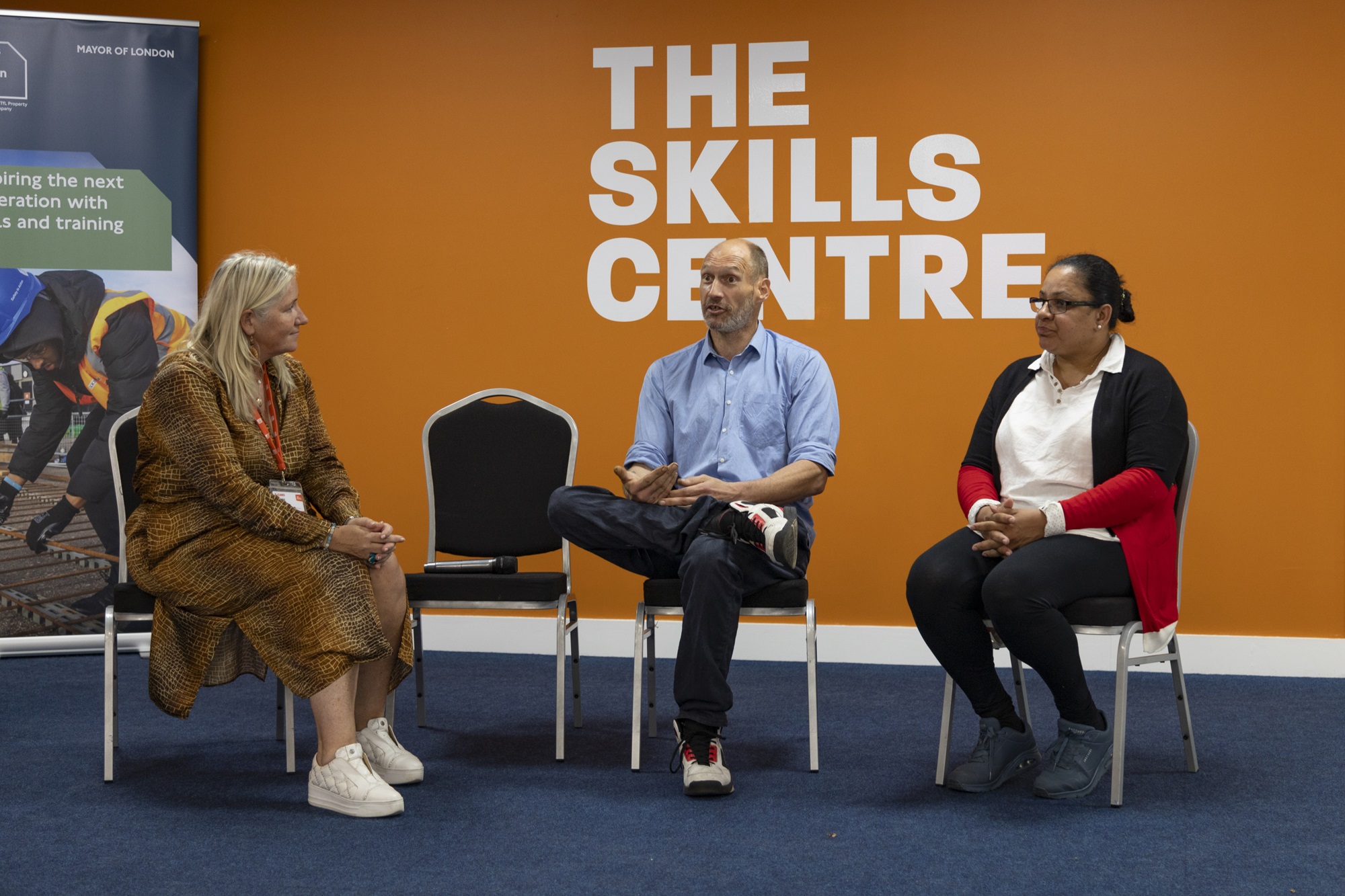
The Skills Centre, one of the UK’s leading construction training providers, in partnership with Places for London, Ballymore and Barnet Council, and with engagement from Brent Cross, is bringing a new community-focused green skills training facility to Station Road, Edgware.
Through collaboration with local employers, Barnet Council and the community, this state-of-the-art facility has been designed to build opportunities and transform lives by equipping local residents with essential skills in green construction, insulation, and interior systems, directly addressing the needs of the construction industry.
It offers employer-led, flexible programmes that aim to actively address the UK’s construction skills gap while benefiting the community of Edgware and its surrounding areas.
The new centre, on Places for London land, will offer north London residents entry-level pre-employment programmes, interior systems bootcamps and apprenticeships, management, and supervisor training and CSCS testing. Learners will have the opportunity to progress through multiple levels of funded training to launch and grow sustainable construction careers.
It is already making a positive impact on the local community in Edgware and across Barnet.
One individual who has benefitted is Simon, a 25-year-old Hendon resident who applied to work on the fit-out through Barnet Council’s Care Leavers scheme. Simon gained vital new skills through the project from carpentry to electrical skills. The role has given him the necessary experience to progress with his Construction Skills Certification Scheme (CSCS) Card and he’s looking forward to using his experience as a springboard to take his NVQs, continue expanding his skills and eventually starting his own business.
Speaking about his experience, Simon said: “The construction skills and experience I’ve got here are really valuable, not only are they helping me get the necessary qualifications I need to build my career but they’re also practical skills that are helping me become more self-reliant and save money at home.
“A lot of young people might not see construction as a career path they want to take as it takes time and effort to build the skills you need, but if you’re patient and work hard, it can change your life.”
As well as Simon’s story, Andre and Tariq, students at Barnet and Southgate College are taking part in work placements on the site, balancing the practical experience on-site with their Level 3 electrical installation courses. The two students have been working on the site two days a week, learning new skills and how a busy commercial site works.
As Andre notes, “It’s a great stepping stone to challenge yourself and build a career.” Tariq agreed with this, adding: “I want to be a master in one skill but get experience in everything so I can futureproof my career and the experience here’s been great for that, I can do a bit of everything and it helps you understand where you see your future.”
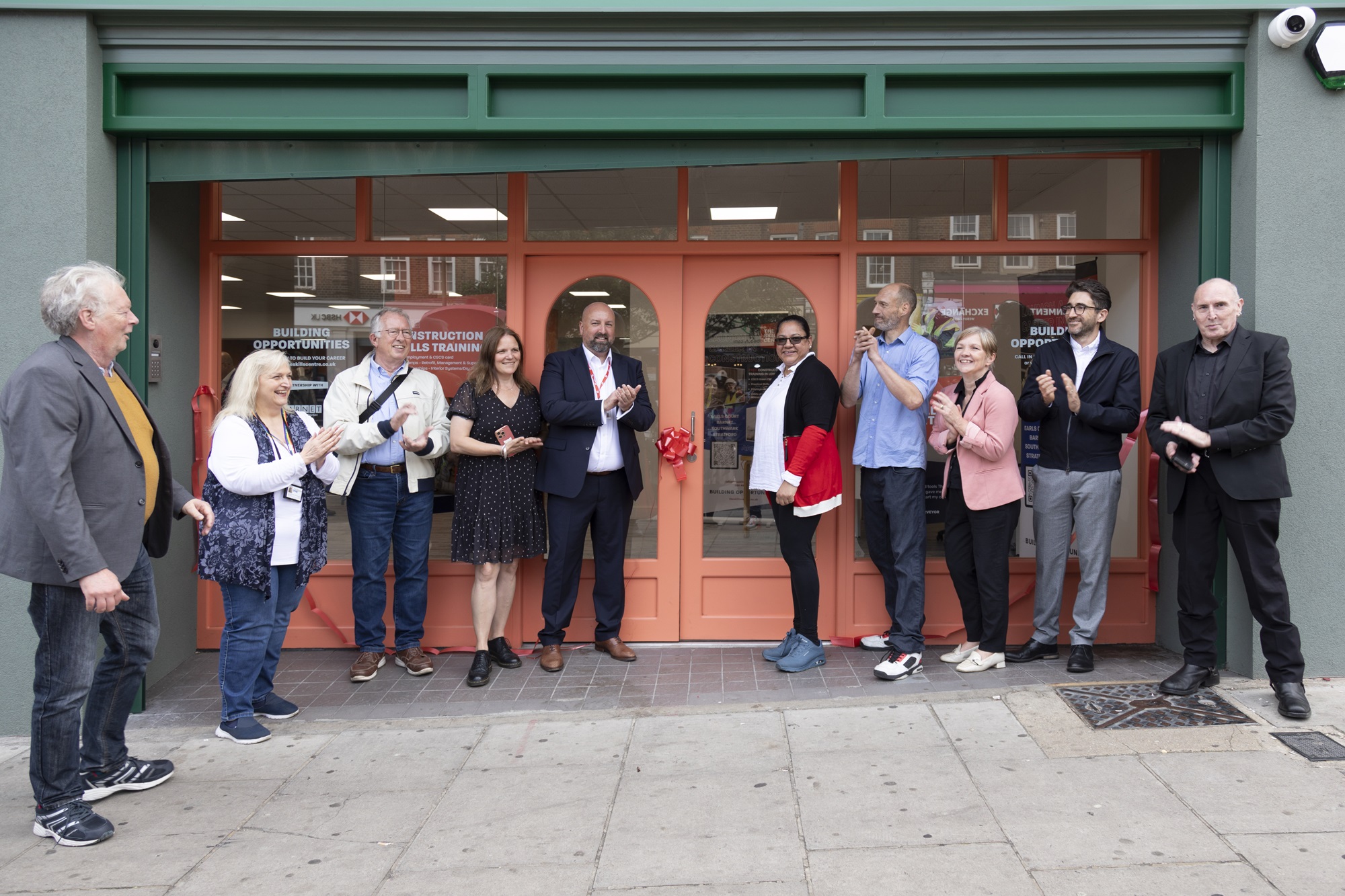
Since May the Skills Centre has delivered:
Four successful insulation boot camps
A "Women into Construction" programme with 15 participants, six of whom have already secured employment
Hands-on work experience during the centre’s refurbishment for a local care leaver from Barnet Council, and six electrical students from Barnet and Southgate College.
Building on the Skills Centre’s expertise in training skilled workers for the construction industry, the centre has been set up to look to the future of Edgware as Ballymore and Places for London have now submitted their outline planning application for the comprehensive regeneration of The Broadwalk Centre site and neighbouring Transport for London land. The wider plans will see £1.7billion invested in Edgware, adding £80m Gross Value Added (GVA) to the local economy and create more than 1,400 full-time jobs. In advance of the development coming forward, the Skills Centre will equip the next generation of workers with vital skills, particularly across the built environment and sustainability sectors.
Ballymore and Places for London’s ambitious wider masterplan for the site proposes to deliver 3,365 new homes, including 1,150 affordable homes, and 463 student accommodation spaces. A significant increase in green space for the town centre includes a new Deans Brook Nature Park, which is to be created by unlocking land which has been inaccessible to the public for almost 100 years.
These plans for Edgware are a major contribution to the 20,000 new homes and 50 per cent affordable housing across London that Places for London will be providing.
The launch event for the Skills Centre brought together local politicians, including the leader of Barnet Council, Barry Rawlings, a range of stakeholders, partners, and industry leaders who share The Skill Centre’s vision for empowering local communities
Attendees had the opportunity to explore the facility, meet the team, and learn more about the innovative and impactful programmes. The event also included presentations from key partners and success stories from individuals who have already benefited from training.
The opening of The Skills Centre Edgware marks its fourth exclusive training centre and 11th delivery location nationwide and is one of four specialist facilities in London, with centres also available in Southwark, Stratford and Earl’s Court. This is the third site that The Skills Centre have provided in partnership with Places for London.
Jon Howlin, CEO of The Skills Centre, said of the new facility: “We’re delighted to be opening the doors to a new training facility for the community in Barnet. Those looking to start or grow a career in construction can find so many opportunities through The Edgware Construction Training Centre, and can develop new skills while meeting with local, recruiting employers.
“Building on the success of The Skills Centre's sites in Stratford, Southwark and Earls Court, the new North London space will specialise in green construction skills and will offer a gateway to the industry that is sorely needed.
“Our ambition is to support a minimum of 300 local residents each year with their career progression and skills development, and we already have training rigs set up in live construction areas that replicate London’s built environment so that anyone learning can hit the ground running once they start work.”
Graeme Craig, Director and Chief Executive Officer at Places for London said: “We are so pleased to be able to support local people learn new skills. We are investing heavily in Edgware to create a whole new town centre and vibrant local economy, and this is a great facility that people can just drop in to and begin their journey with training and job opportunities. Working with the Skills Centre, we are providing training opportunities across London with 8,000 people trained so far, 3,000 people have secured jobs as a result of this training.”
Simon Ryan, Developments Director, Ballymore: "The opening of The Skills Centre is truly worthy of celebration. This facility, and all those who work within it, will have a direct and positive impact on Edgware and its community. Whether that be through training or employment opportunities for local people, or through projects like the planned refurbishment of existing housing stock, which will improve standards of accommodation of council-owned homes in and around Edgware, as well as ensuring they are more energy efficient."
For further details on The Skills Centre Edgware, click here.
Related Articles
Bustling Brentford
We’re still coming down from what has been a jam-packed, fun filled programme of events at our waterside neighbourhood The Brentford Project.
Our week-long series of activities attracted over 5000 visitors with many vendors telling us it was the busiest they’d ever been. With the waterside location providing a scenic backdrop, the creative programme of experience-focused events was the icing on the cake in what has already been a fruitful year at Brentford with the unveiling of the newly completed Workhouse Dock.
Activities for all
The week provided something for everyone, all centred around the star of the show - our very own floating stage on the water. Adding an extra dimension to many activities starting with two ‘Barre on the Water’ classes. These were hosted on the floating pontoon by Bodies Built for Life (BBFL) founder Charlotte Alloway with the event attracting TikTok royalty; the ‘Gregorian Sisters’.
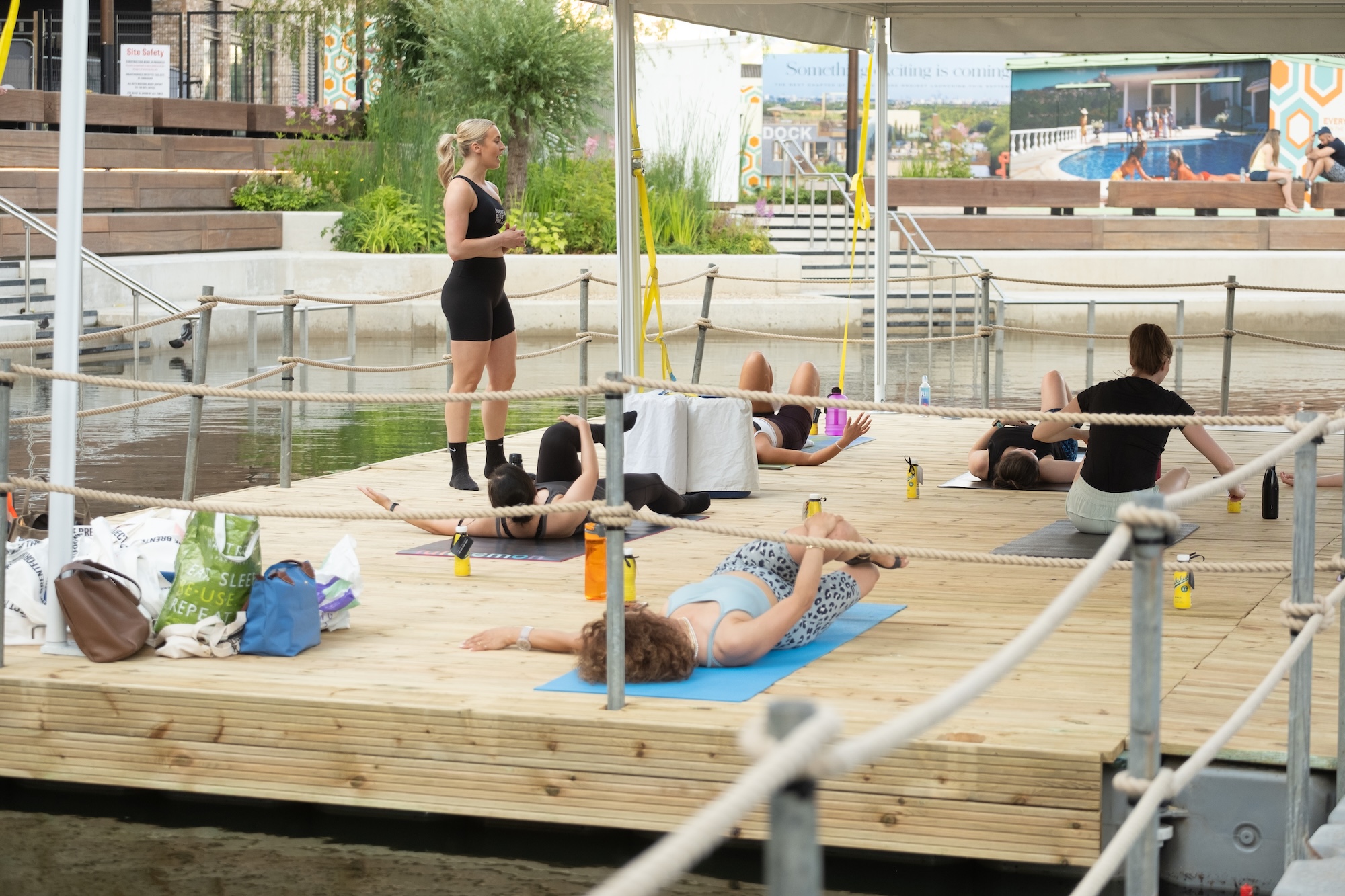
Barre on the Water
The pontoon also became the stage for an inspiring evening of flower arranging. Hosted by Richmond based florist, Bramble & Moss, participants were encouraged to indulge their creativity in making their own flower crown while enjoying a glass of Prosecco under the stars, definitely one for the memory banks.

Flower arranging
Our newest onsite restaurant Rottura also got involved, creating an exclusive evening for lucky attendees who managed to grab a ticket for the sold-out experience. They were able to taste test a beautifully curated three-course menu inspired by Italy a week before the restaurant officially opened to the public.
Bonding the community
These immersive and carefully crafted events paved the way for community favourite ‘Festival on the Water.’ A day abundant with pop-up food and drink vendors, live performances on the floating stage and Duke of London’s much revered classic and supercar car boot sale selling vintage clothing, automobilia, artwork and vinyls. The day was a roaring success and fortunately the weather was on our side with visitors able to soak up the atmosphere in the sun and enjoy all that was on offer as they wandered through the neighbourhood experiencing Brentford in all its glory.
Families were well catered for with Harlene The Hoola Queen hosting various Hoola classes throughout the day, and talented face painters were on hand to transform children and young-at-heart adults into their favourite characters and creatures.
As Ballymore’s Laura Jeffery explains: “It was wonderful to see The Brentford Project thriving and being enjoyed by so many locals and new visitors to the area.
“This programme events provided our popup vendors and long term businesses with a fantastic opportunity to interact with new and existing customers, encouraging people to visit our neighbourhood again in the future. The variety of events and activities on offer really ignited the imagination and essentially encapsulates what the Brentford Project is all about; bringing the community together and connecting people to the once neglected waterfront.”
Related Articles
Bringing homes, jobs and green space to Edgware
Edgware’s town centre could be transformed if Ballymore’s plans for its regeneration can be realised. Over the last four years, we have been working with thousands of local people and our industry partners on proposals to bring homes, jobs, green spaces, shops, cafes, a cinema, healthcare and leisure facilities to this area of north London.
With the planning application for the site now submitted, Ballymore Developments Director Simon Ryan outlines the regeneration vision, how it has been shaped by the community, and what the company is doing to help meet London’s housing needs.
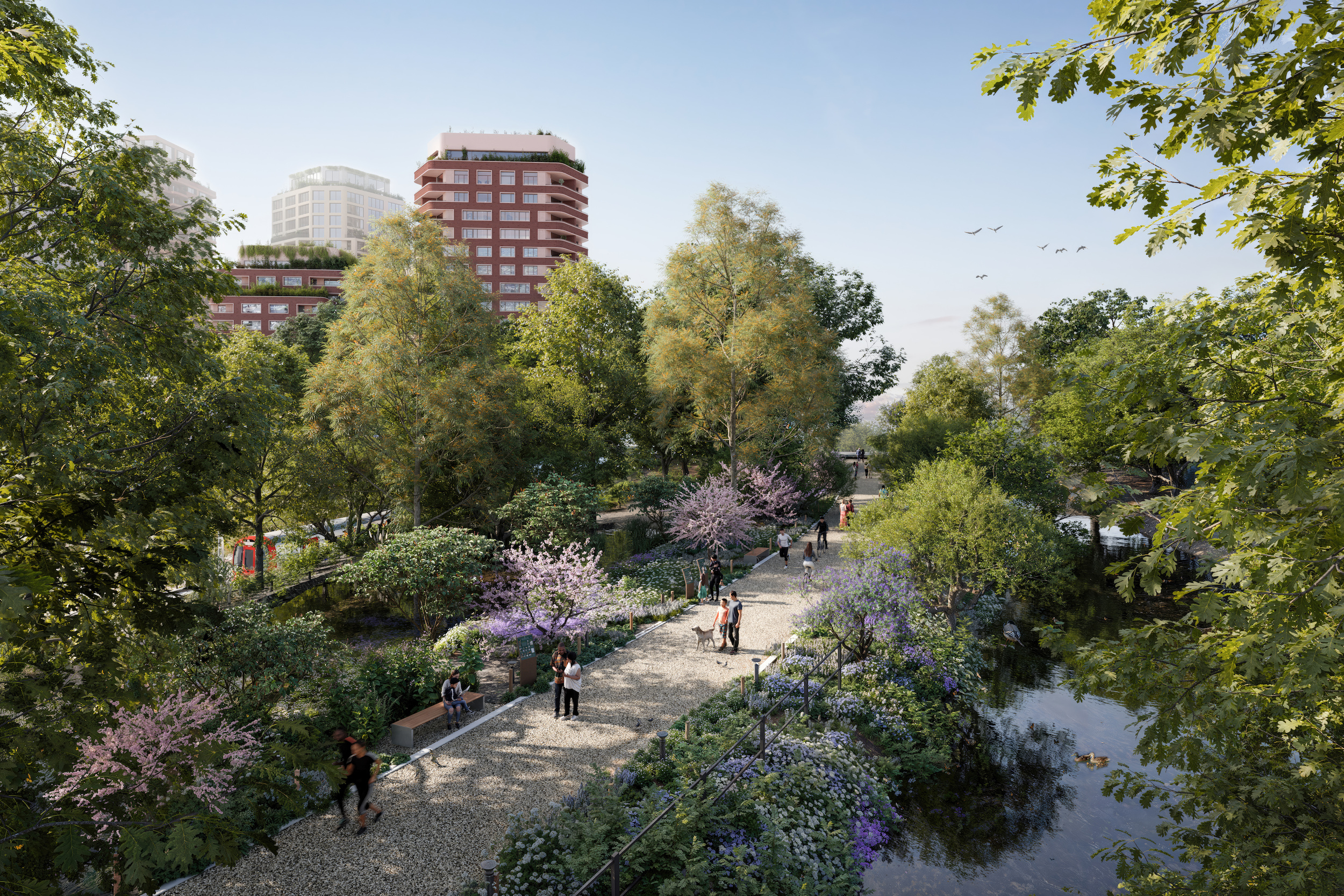
How was the vision for Edgware formed?
In the four years since we bought the Broadwalk Shopping Centre,, we have embedded ourselves in the community, meeting thousands of individuals and spending hundreds of hours on site listening to people. We converted a retail unit in the shopping centre to ‘The Meeting Room’ - a space to meet stakeholders, residents and visitors, to understand how the area works, what they like about it and what its shortcomings are. Ultimately, we’ve shaped our proposals for the town centre to try and meet those needs. Our outreach efforts have since been shortlisted for a number of industry awards – we’re proud of that.
Importantly, we’ve formed a partnership with Places for London – Transport for London’s property company - which owns the adjacent bus depot site. That’s allowed us to bring forward both sites as a single 25.4-acre piece of land and create a more joined-up town centre experience.
What did local people say about the town centre?
While many users enjoy the convenience of the existing covered shopping centre with its ample car parking, people have also come to realise that the place isn’t serving the purpose that it could. They noted that there’s a lack of green space and space to meet; the long high street adjacent to the site (Station Road) has just one public bench where people can sit and talk.
People also noted that there’s a lack of things for families, young adults and children to do, particularly evenings and weekends. It’s a healthy high street in many ways, but visitors tend to drive in, shop and drive out; there’s no reason to stay.
Tell us about the vision for the site?
Firstly, the vision addresses the housing need identified by the borough. Under the masterplan, we want to deliver almost 3,500 homes, up to 35% of those being Affordable.
Retail and commercial space will be more than doubled to enable the Sainsbury’s supermarket on the site to have a new, bigger store and give space for new or improved uses that complement the high street, like cafes, restaurants, library, a cinema, and health and fitness facilities.
We’re looking to improve public transport options, by repositioning bus stops closer to the Underground station and relocating the bus depot under ground. Making the town centre more accessible is important, so we’ve incorporated more access to public realm, better walking routes and cycle hubs into our proposal.
The masterplan – by Howells Architects - features a series of big town squares off the high street. There’s 4.8 hectares of open space proposed on site, including a hectare of play space – the equivalent of 38 tennis courts. In addition, 1.9 hectares of operational land adjacent to the Northern Line, which contain the passing Deans Brook and have become an important local natural resource opened to the public for the first time in 100 years renovating existing operational pathways closed to the public.
What impact will this project have?
It has the potential to be massively transformational. This is one of the most under-utilised yet well connected town centres in London, with the Edgware Underground on site and 20 bus routes serving the bus station. It’s the right place for higher density development.
We recognise our proposals mean big change for the area, but so did the London Underground when it arrived in the fields of Edgware a century ago. This will, we believe, make Edgware a place where people want to live, providing homes for everyone, for the next one hundred years and beyond.
Once it is up and running, the development will provide nearly 1,400 jobs, and thousands of jobs will also be created during its construction.
How is Ballymore working to meet London’s housing needs more generally?
We’re committed to delivering new housing for London. The end of last year (2023) we submitted a planning application for 2,500 homes in Ladbroke Grove. Edgware and Ladbroke Grove are two of the biggest residential-led planning applications in London this year and will be key to delivering on the capital’s housing needs. We now have around 10,000 homes submitted for planning in London.
To keep in touch with the latest news on the Edgware Town Centre project, sign up for our updates on the consultation website here.
Related Articles
Taste of Kildare acknowledges the dedication of the county’s creators
Ballymore, founded in Kildare in 1982, is deeply connected to the county. That's why we are proud to sponsor this year’s Taste of Kildare festival – a showcase of culinary expertise from across the region.
Taking place over the weekend of 20th to 22nd September, Taste of Kildare promises to be the most diverse and immersive experience yet, so in the weeks leading up to the event, we’ll be hearing from some of the key voices shaping this remarkable festival.
Today that voice is chef, baker and Author Graham Herterich, aka The Cupcake Bloke. Graham shares an unbreakable bond with Kildare having been the last official baby to be born in Athy hospital. Here he tells us about his extraordinary career, and why being at The Taste of Kildare feels like a homecoming
“Without the support of Ballymore this wonderful festival couldn’t take place”
I cannot wait to come home to Kildare and soak up the wonderful atmosphere of the festival; it always feels nostalgic as I lived in Athy, Kildare until I was eighteen, so my entire childhood is built on memories of being here.
We lived on Duke Street and my family owned and ran the butchers. It’s a place like no other and as soon as I see the flat landscape of Kildare approaching when I’m heading over on the train from Dublin, I know I’m home.
It’s wonderful having such a big company like Ballymore supporting the event and in turn, the Irish culinary food scene. We’re quite a small and tight community and sponsorship from Ballymore means we can get out there in a different space and connect with our peers and customers, bringing our food and produce to new people. I’m incredibly grateful to Ballymore for this - and genuinely warmed by their connection to Kildare and how they are so pro-actively using their success to support the town they come from so that businesses like mine can experience the magic of the festival. I think it speaks volumes that they choose to invest their time and money to really make a difference to the people of Kildare in creating experiences like this. It shows their commitment to community and really embeds them into the identity of Kildare.
A celebration of Irish produce
This will be the second time I’ve been to the festival, the first was a few years ago, and speaking to Curator Avril Bannerton who I’ve known and worked with many times over the years, this one is bigger and fuller than ever. It also aligns wonderfully with the launch of my second book ‘Cook’ which is a celebration of traditional Irish recipes that convey my childhood, recreated with my own modern twist.
The book is a bit of a love-note to Kildare - it features maps where I pinpoint the places reminiscent of my childhood throughout the town - the butchers where I grew up - places that have triggered memories and inspired new recipes - I really am a Kildare boy through and through, the book is quite literally the taste of Kildare!
That ‘twist’ optimises my culinary style - I’m a trained classical chef and my career has seen many twist and turns taking me down the Michelin Star restaurant route, product development and a dabble with Chain cafe’s before crystallising my dream of owning my own retail store "The Bakery" in Rialto which I opened in 2018. I’ve now dropped the wholesale of the business to concentrate on creating flavoursome, fun and quality bakes, working with my husband Daithí and my brother Pappy.
Supporting independent Irish producers as well as realising my own passion of creating modern day versions of the classics is now my full time job and passion. It’s fast - busy - and wonderful. The bakery specialises in sweet creations - retro favourites such as the bourbon biscuit, but with a caramel and white chocolate spin! We also do a great selection of drinks and sandwiches and we sell locally sourced produce. I’m looking forward to bringing these and more to the festival and I’m hosting a couple of demos too which will be great fun.
The first is an afternoon tea collaboration with Newbridge Silverware which will feature recipes from both of my books - my first book, ‘Bake’ is focused on traditional sweet treats, and as I mentioned, my new book ‘Cook’ features traditional savoury meals as I realised I had a lot more food memories from my childhood that I wanted to share. I’ll be doing a book signing on the Saturday afternoon which is a lovely chance to chat to people and have the craic.
I’m really looking forward to seeing Melissa McCabe who is a fantastic chef, Derry Clarke and Jordan Bailey at the festival as well as many more. I’ll also be getting stuck in with a kids masterclass on the Sunday so it’s going to be a great weekend.
Thanks to Ballymore we get to experience all that our region has to offer, and that’s the very best of Irish food and drink there is. Events such as this really help to put Kildare and the surrounding areas on the map, and like the founders of Ballymore who also reign from Kildare, this makes me incredibly proud.
Related Articles
A British Homes Award - and more accolades - for Brentford
Ballymore has secured the prestigious British Homes Award for Regeneration Scheme of the Year at the British Homes Awards 2024, marking its third major award in recent months.
The British Homes Awards, regarded as one of the most esteemed recognitions in the UK homebuilding industry, celebrate excellence across a broad spectrum, including architectural design, interior innovation, build quality, and sustainability.

The Brentford Project was recognised for its transformation of the area with 876 new homes alongside a revitalised high street, five acres of public space, employment opportunities, and a variety of community and leisure facilities, including the private resident’s club The Wick, complete with a state-of-the-art gym, spa facilities, a lounge, and a heated outdoor pool.

The accolade comes just months after the scheme earned the PROPS Development of the Year Award; The Brentford Project was also recently HIghly Commended at the Evening Standard New Homes Awards and in the Best New Place to Live at the Building London Planning Awards. Ballymore Managing Director John Mulryan explained: “We are delighted with our recent awards success – a testament to our vision for the redevelopment of Brentford and the creation of well-designed, high-quality homes and amenities.
“It’s an honour to earn one of property’s highest accolades and continue this run of recognition from our industry peers.”
Over the past year, significant progress has been made at Brentford, with 319 private homes and 96 affordable homes now completed. The development’s commercial landscape is also thriving, with the arrival of 10 new retailers to date, including independent businesses like Sam's Waterside and GAIL’S now open, and an Everyman Cinema due to open early next year.
Ballymore is set to unveil the next phase of the development on 19th October, with the launch of Quincy House, a new building at the heart of Town Wharf Square featuring 85 new homes available from £350,000.
Find out more about The Brentford Project here.
Related Articles
The festival is a wonderful way to bring people together
Ballymore, founded in Kildare in 1982, is deeply connected to the county. That's why we are proud to sponsor this year’s Taste of Kildare festival – a showcase of culinary expertise from across the region.
Taking place over the weekend of 20th to 22nd September, Taste of Kildare promises to be the most diverse and immersive experience yet, so in the weeks leading up to the event, we’ll be hearing from some of the key voices shaping this remarkable festival.
One such voice is that of Susan McMillan, Proprietor of Grá Coffee Bar and Grá Collective Art Gallery in Naas which was voted the number one coffee bar in Ireland for the last four years by McKenna’s Best in Ireland Awards.
This is a business like no other: an amalgamation of coffee and culture, showcasing the rich tapestry of Irish, local and international creativity, with artworks adorning the walls and the scent of freshly brewed coffee setting the scene. Here Susan tells us more:
“We’re delighted to be a part of this year's Taste of Kildare festival and showcase our business,” says Susan McMillan of Grá Coffee Bar and Art Gallery.
Born in the challenging pandemic period of 2020, Grá has become a space that has helped to bond and cement the community. “We’re about so much more than coffee. We are a destination that embodies experience, warmth and Irish hospitality,” adds Susan.
“Our Coffee Bar is a collision of fine art and finely tuned culinary staples underpinned by excellent coffee both of which will be joining us at the Kildare Festival.
“We celebrate the region’s makers; our organic milk is supplied by the Village Dairy Carlow, fresh organic pastries are baked by Tartine Organic Dublin Bakery; cupcakes and flapjacks by The Carrot Cake Lady Kildare, and we collaborate with another local company Brown Box Catering Kildare to provide a range of gourmet breakfast baps, sandwiches and salads.
“It truly is part of our DNA to support local suppliers which is really the very essence of the Taste of Kildare. It’s a wonderful opportunity for us to not only showcase our own brand, but to recognise and discover the vast amount of culinary talent across Kildare, Nass and beyond.”
Inspiring the community
Susan sees much synergy between her business, other exhibitors and Ballymore. “Ballymore has a huge presence here,” Susan adds. “It’s terrific that they are so continually supportive of the food and drink industry.
“The festival is a wonderful way to bring people together and Ballymore’s sponsorship has allowed the festival to bloom.” This year that includes more representation of local food and drink businesses than ever before – something Susan calls “inspiring”. “I can’t wait to meet fellow vendors and experience their talents. It’s going to be a wonderful weekend; our entire team can’t wait – it blends into the very reason we exist – to provide experiences and be a haven for our customers.
“Ballymore is woven into the fabric of Kildare and it’s events like this which really help us to make our mark, meet other creators and celebrate the wonderful culture of Ireland.
“It’s become a landmark event for our county and a wonderful way to inspire our community, reminding them of the wonderful variety of food, drink and experiences available on our doorstep.”
Grá also has an art gallery which hosts new and emerging artists as well as established creatives from across Ireland and the world over. This immersive, sensory and constantly changing space exhibits the work of different artists – something again Susan sees as a synergy with Ballymore. “Ballymore holds a worthy reputation for supporting artists too, commissioning murals and installations for their neighbourhoods with local artists. Their dedication to elevating authentic Irish culture and supporting the creatives who make up our communities is something I admire – it’s the reason I’ve created an immersive art experience in my own business.
“We cherish being a vibrant part of the local community and are excited about extending our reach further by being a part of this momentous festival. We’re incredibly grateful to Ballymore who, by supporting the festival, are shining a light on the Irish food scene and the wonderful array of experiences we can collectively offer.”
Check out wwwgracoffee.com and gragallery.com for more information.
Related Articles
Showcasing food, wine and entrepreneurship at Taste of Kildare
Lovers of good food, wine and company will soon gather at Naas Racecourse for the 2024 Taste of Kildare festival. Ballymore is proudly supporting the event, which takes place in the county where our business was founded and demonstrates all that’s great about the region’s community, creativity and entrepreneurship.
From 20th-22nd September, the festival gives visitors a chance to savour the county’s best artisanal produce and learn from Kildare’s top chefs and experts in everything from pastry making to mixing cocktails. In the lead-up to the event, we’re featuring some of those taking part, including expert presenter Michelle Lawlor, founder of Naas-based online wine retailer The Nude Wine Company.
Michelle is today known to many as the resident wine expert on Virgin Media’s Ireland.am morning TV show, but her career started with a part-time job in a wine shop around her studies. “I loved it and that became my life,” she says.
The Nude Wine Company, which she established in 2019, grew out of experience running the Hong Kong office of a UK-based online wine supplier. “When I came back to Ireland from Hong Kong I realised the potential of ecommerce and at that time I didn’t see anyone focusing on the types of wines that I love, which were the more sustainable, organic wines,” she says. That became the focus for the micro-business Michelle now runs with life and business partner and golf professional, Tony O’Regan.
For both Michelle and Ballymore, Kildare’s a great place to live
The Nude Wine Co is based in Kildare, quite simply because Michelle’s partner hails from Salins. Michelle has been converted to the delights of the county, and the Naas/Salins area in particular, saying, “It’s a gorgeous place to live”.
That’s a view shared by Ballymore and its customers. The company has developed a string of neighbourhoods in Kildare, including Longstone, Stoneleigh and Stonehaven in Naas and River Walk in Ballymore Eustace. All Ballymore’s new neighbourhoods complement Kildare’s special environment with their beautifully designed homes and landscape features like Stonehaven’s riverside walking trail.
Making connections at the festival
At the Taste of Kildare festival, the wine retailer will have a stall and Michelle will be co-presenting a masterclass on the perfect dinner party drinks. “Because we’re an online business, we only usually get to meet people via Facetime,” she says. “For us as a micro-business of just four employees, it’s amazing to be able to spend time with our customers and future customers, and to make connections and be with our peers.”
Having participated in the last festival two years ago, held at The Curragh Racecourse, Michelle is excited to see it evolve and grow this year. “People who come to Taste of Kildare love food, wine and that whole experience,” she says.
For this year’s festival, host and tourism board Into Kildare is collaborating with more than 100 partners in the tourism and hospitality sectors.
Championing the best of Kildare
As well as selling wines online, the retailer markets food and other gifts made in Kildare and Ireland. “We’ve tried to champion them” says Michelle. “The appetite to shop local and shop Kildare has been transformational for our business.” And Kildare is, she says, “a real hub of entrepreneurship for food, wine and business”.
Michelle hosts wine tasting evenings for local people, with her next tasting event coming up at Naas restaurant Neighbourhood in November. Another aspect of the business is its new online Wine Rack Planner, launching soon. This is designed to help customers build their own wine collection, “great for people moving into a new home, who want some ideas for wines to buy,” says Michelle.
And Michelle’s favourite wine?
We couldn’t let Michelle go without asking her to share her own personal favourite from the wine list. “That would be a Chardonnay from Burgundy – I love a Chablis or a Pouilly-Fuisse. And champagne,” she says.
Book your tickets to the 2024 Taste of Kildare festival here.
Related Articles
Taste of Kildare is a fantastic opportunity for us all
Ballymore, founded in Kildare in 1982, has deep roots in the county. That's why we are proud to sponsor this year’s Taste of Kildare festival – a showcase of culinary expertise from across the region. Taking place over the weekend of September 20th to 22nd, Taste of Kildare promises to be the most diverse and immersive experience yet. In the weeks leading up to the event, we’ll hear from key voices shaping this remarkable festival.
Among them is Paul Linehan, owner of the Ballymore Inn – a renowned gastropub in County Kildare. Paul’s company, The Hartes Group, acquired this Kildare institution in 2022, continuing a legacy that spans three decades.
Here, Paul shares his thoughts on the shared values with Ballymore, his connections to the Mulryan family, and his passion for celebrating Kildare’s food and culture at this year’s Taste of Kildare in September.
I have a long history with Kildare. As a native of Kildare Town, I have a deep passion for the county's food and drink offerings.
My business partners and I established the Hartes Group n 2016 to celebrate Kildare’s culinary scene. We've opened several gastropubs across the county, a Brewery and also Firecastle which is cafe, bakery and deli with rooms, each giving people a place to enjoy great food in a welcoming environment.
18 months ago, we expanded our portfolio by acquiring the Ballymore Inn. Located near Ballymore’s River Walk neighbourhood, the pub has a stellar reputation, initially established by renowned chef, Georgina O’Sullivan. Her dishes attracted visitors from far and wide, and her 2015 book, ’Cooking at the Ballymore Inn’, highlighted the pub's culinary excellence. When Georgina approached us about purchasing the Ballymore Inn, we eagerly grabbed the opportunity.
Much like Sean Mulryan and his team have done in Ballymore Eustace, we sought to honour and celebrate the heritage of the pub and its surroundings. We've made subtle changes, ensuring we do justice to the reputation Georgina built and the pub shares the same spirit and quality as our other Kildare establishments, the Dew Drop Inn and Hartes of Kildare.
Throughout our tenure, we’ve received strong support from Sean Mulryan, his family and Ballymore colleagues, and we’re thrilled to maintain our connection with the company’s nearby River Walk neighbourhood. Historically, the Ballymore Inn has been a destination pub, drawing visitors from miles around but now thanks to the Mulryans and their team, River Walk is bringing new faces and young families through our doors.
Ballymore Eustace is unique in that it has retained its identity and remained small, even avoiding the mass development seen during the Celtic Tiger era. At the Ballymore Inn, we’re embracing that, adding our subtle touch while preserving the pub’s character.. Sean and his team have done the same at River Walk, resulting in a growing population in Ballymore Eustace – something that of course is great for our pub!
I’m excited to stand alongside Ballymore at the Taste of Kildare event – they are the sponsor and we are exhibitors. We have a lot planned for the weekend, including setting up a restaurant and participating in the producers’ tent with our café. Our restaurant menu will feature three offerings - including one item named after Ballymore.
We’ll showcase the best of what we do: the finest Irish produce presented in a gastropub setting. We’re known for our braised meats and slow-cooked dishes, and, in the case of the Ballymore Inn – great fresh fish. We take pride in local sourcing, especially the great barley from our local fields which we use to brew our own beer that’s served in the Ballymore Inn and all of our pubs.
Taste of Kildare is a fantastic opportunity for us all. The event has grown stronger each year, and this year promises to be a showstopper over three days. I can’t wait to get there and get started!
Related Articles
“It’s a space for people to come together and connect”
Brand founder, Xaviera Black of Mother Rugger opened the doors to her gallery shop in December 2023. Located by the waterside in the heart of The Brentford Project, she’s since been inspiring the local community by providing a hub for creative minds to meet and explore their art. Here she tells us more
You could say I’m a quick worker! I finished my degree in Creative arts and a week later had decided to create my business. Whilst my degree specialised in painting, I’d also learnt how to make rugs and this was the inspiration for my business. In-fact, I’d saved my student loan to go travelling but Covid put a stop to that so instead I invested it into starting Mother Rugger.
At first I was focused on selling rugs - and whilst I still am, it became apparent very quickly that the laborious nature of creating each one by hand was not going to be realistic as a business. Making a standard 6x4 inch rug took a full two weeks alone, so I managed to source a fantastic supplier in New Delhi who is brilliant at taking my designs and turning them into a reality.
This has enabled me to focus my time on running the business, and gradually cultivate the space into a community hub as well as a platform to sell my rugs and other curated items. I’ve lived in Brentford my entire life - I know it like the back of my hand and it’s got a vibrant creative crowd here. Loosing our art centre meant there wasn’t a place to connect so that was my driving mission for here.
The space is amazing - externally the waterside location makes it a beautiful place to be - especially on a sunny day when it feels like you’re on holiday. Inside, I feel like I’m in a New York gallery - it’s bringing the vibes! Mainly due to the contemporary exposed ceiling which allows light to flood in creating a perfect stage for the artists who exhibit here.
The current artist of the month is Lou Hamilton with her exhibition ‘Aerial Abstractions’ and the next artist for August is Darcy Whent with her exhibition ‘On all fours’.
The space is also available for creatives to use as they wish. Presently it’s used for creative workshops and yoga and pilates classes. I can’t wait to see how it evolves and how people choose to use it in the future, it’s such a dynamic, light space which makes it incredibly versatile - plus, with 100 square foot to play with it’s really adaptable.
I’m also keen to support local makers - I sell a sunglasses range by Valeye London, the founder of which lives up the road. I also have a lovely local lady who makes jewellery under the name Qlemontine, and a candle brand called ‘Bell & Finch;’ they repurpose vintage glasses into candles. I’m very careful with how I curate the ranges, I really want everything to be special and to complement the space.
I’ve settled in really well - I was so keen to get started, getting the keys and opening four days later! I’ve the Ballymore team to thank for that - their painters helped me get ready in time. I can’t wait to meet more creatives and evolve my own business here.

Related Articles
A celebration of Kildare’s creators
Ballymore, founded in Kildare in 1982, is deeply connected to the county. That's why we are proud to sponsor this year’s Taste of Kildare festival – a showcase of culinary expertise from across the region.
Taking place over the weekend of 20th to 22nd September, Taste of Kildare promises to be the most diverse and immersive experience yet, so in the weeks leading up to the event, we’ll be hearing from some of the key voices shaping this remarkable festival.
Among them is food journalist and editor Dee Laffan, who has spent the last 15 years passionately exploring and sharing the Irish food scene. Here, she talks to us about this rich culture and how she has helped cultivate a dynamic programme for the festival.
The festival puts Kildare firmly on the culinary food map.
“I feel like Kildare has become a go-to county for food tourism these days. With its incredible variety of restaurateurs, producers and food enthusiasts I’m delighted to be helping to fly the flag for the region’s culinary professionals at this year’s Taste of Kildare.”
The potential of Kildare – something Ballymore’s long seen
Ballymore has long celebrated the potential of the region, creating neighbourhoods in Ballymore Eustace, Naas and Newbridge. Now those places have evolved, each with a huge network of culinary expertise, not only in the eateries themselves but throughout the food chain with an abundance of organic farmers such as McCormacks and Sprout & Co.
Kildare – long known as home to Ballymore – is somewhere that’s now synonymous with fine dining, attracting tourists from far and wide thanks to its reputation for excellent hospitality and among them, several five-star establishments.
“Having once lived in Sallins in the region, I’ve experienced first-hand the array of culinary experiences on offer and I think Kildare’s prowess is representative of how far Ireland has come in the last two decades – something perfectly encapsulated with the amount of talent joining us at this year's festival."
Celebrating Kildare culture
“I’ve been a food journalist and editor for over 15 years, driven by the desire to share people’s stories. I’m particularly passionate about highlighting the benefits of supporting local suppliers - not least for the freshness and nutritional value.
“This June, I launched a podcast called Beár Bia, with my co-host Oisín Davis, which focuses on pairing local food and drinks - something which is a prevalent practice in Europe, but not as much here. I also publish an annual food magazine called Scoop: Irish Food Stories that allows me to dig deeper into the fascinating stories of people spearheading the food industry and from those who are just passionate about food in their lives and have stories and memories to share.
“The festival is a similar pursuit, helping to put Kildare on the culinary food map as well as providing a joyous and immersive environment for people to connect and experience the vast variety of wonderful food and drink on offer.”
What’s on the menu
“As well as helping to curate the programme of events, I’ll be hosting the Chefs Theatre and talk stage along with fellow food writer, Ali Dunworth. It's a fantastic opportunity to bridge the talent of the region with the consumers who often don’t see what goes on behind the scenes, which is an industry rich with passion as well as ingredients! It’s also exciting to see how the chefs adapt to a different stage.
“There’ll be lots of well-known stars of Kildare in attendance, including the infamous gastro pub The Ballymore Inn. Often cited as the best gastro pub in the country and the recipient of many awards, the business has recently been taking over with its legacy now in the safe hands of the Hartes Group. I’m also particularly looking forward to seeing what Gareth Naughton - head chef of Neighbourhood in Naas creates for us at the event, as well as experiencing as many of the food trucks as possible. Kevin Walsh of Lily and Wild, based in Newbridge, will be cooking a harvest dinner on Friday evening and taking charge of the BBQ over the weekend - there really is something for everyone.
“Taste of Kildare a place to support and acknowledge the dedication of our creators and growers - from craft breweries and bakers to wine companies and chocolatiers, it’s a feast for the eyes and tummies - we just need the weather to behave and we have the formula for a perfect weekend!”
Related Articles
Ballymore submits application for Edgware town centre redevelopment
Ballymore has submitted an outline planning application to redevelop Edgware’s Broadwalk Shopping Centre, the bus station and garage – in partnership with Places for London – Transport for London’s property company which owns some of the area’s land, including the bus station and garage.
The ambitious and transformative masterplan, designed by Howells, proposes to deliver 3,365 new homes, including 1,150 affordable homes, and 463 student accommodation spaces. A significant increase in green space for the town centre includes a new Deans Brook Nature Park, which is to be created by unlocking nearly five acres of land which has been inaccessible to the public for almost 100 years.
To complement the high street offer, the new town square and centre will more than double the existing volume of commercial space and reintroduce a cinema following the loss of the former Ritz cinema over 20 years ago. Edgware’s daytime and mid-week economy will be bolstered by new office, and workspace for small and medium businesses.

GREENER, CLEANER AND CLOSER TO NATURE
The development will open up access to green space that has been closed off to the public for almost 100 years, by creating the 4.7 acre Deans Brook Nature Park. Current scrubland will become a nature trail with wild planting, walking routes, seating and play areas for the local community to relax, enjoy and spend time in nature within the Town Centre. Across the project, landscape design by Gustafson Porter + Bowman includes 400 new trees, as well as 2.5 acres of new play space for children of all ages integrated across the site.
Ballymore and Places for London collaborated with Make Space for Girls, a charity which campaigns for parks and public spaces to be designed with teenage girls in mind, to support with community engagement workshops, held with local young women and girls aged 12-17. The partnership ensured consideration was given to often overlooked groups to ensure everyone feels welcome. As a result, the landscape design includes a range of inclusive spaces such as social seating, play spaces and safe spaces for young people to meet and spend time with friends – something Edgware lacks today.
The development aims to generate zero emissions once in operation and includes the use of renewable energy sources, such as air heat pumps, and will incorporate solar panels, green roofs and community growing gardens.
AN IMPROVED TOWN CENTRE EXPERIENCE
Plans will more than double the existing commercial, retail and leisure space on the site, with 460,000 sq. ft. for new shops, cafes and restaurants as well as a new larger Sainsburys, cinema and leisure centre, plus flexible floorspace that can deliver office, workspace and hotel uses – centred around a new town square that will complement the existing amenity offer in the town centre.
The masterplan will prioritise pedestrians, cyclists and encourage active travel with significant improvements to connectivity within the town centre and a new public cycle hub offering 200 cycle spaces. The development will deliver a future-proof transport interchange including a new bus garage which can be easily adapted to EVs in the future. The garage will contribute towards future use of electric buses across London – improving air quality and helping to tackle the climate emergency.
The safety of residents and all users of the town centre is at the heart of the proposals and Ballymore and Place for London have committed that no electric vehicles will be permitted to use the garage unless and until the design has been approved by the London Fire Brigade, Barnet Council, the Health & Safety Executive and Building Control. The new transport interchange will provide sheltered waiting areas, pick up and drop off points, and improved connectivity to the Underground station. Convenient local car clubs and Dial-a-Ride will also be provided on site.
A testament to their commitment to the sustainable future of Edgware Town Centre, Ballymore and Places for London have been founding members of the Edgware Business Improvement District, which in partnership with Barnet Council, is providing stewardship and investment for Station Road and beyond, to support local businesses and encourage the creation of a sustainable and dynamic town centre that becomes a destination for local residents and visitors.
It is anticipated that the Edgware Town Centre project will create over 1,400 full time jobs once complete and will generate £80m GVA for the local economy. The significant investment will go towards delivering 20,000 sq. ft. safeguarded for health facilities such as GP surgeries, clinics and a dentist, plus a significant contribution to Barnet Council’s education budget as part of the s106 agreement.
DESIGNED FOR COMMUNITY
Ballymore acquired The Broadwalk Centre in 2020. Over the last three and a half years the project team has worked closely with the Edgware community and an extensive network of stakeholders to gain their insights around how the development can best serve the local community as well as meet local needs.
These contributions have been invaluable in guiding the design process and prompting adaptations. The team has met with more than 3,000 members of the local community and received almost 2,800 pieces of feedback and project contributions. Last summer concluded with the Edgware Summer Fair, an event which saw part of the Broadwalk car park taken over for arts and crafts, food, drink and live music, as well as providing an opportunity for local people to view the model and learn more about the latest design proposals. Almost 3,000 people attended over the late August bank holiday weekend.
In direct response to local resident feedback, the proposed scheme provides 769 parking spaces in total including 344 public parking spaces. On-site parking currently at ground level will be relocated to a multi-storey car park which will have a flexible community space at ground level with potential for a café, a new modern library, pharmacy and affordable working space.
John Mulryan, Group Managing Director at Ballymore said: “Edgware is an incredible town with a rich history – and this site presents a once-in-a-generation opportunity. We’re submitting this application 100 years on from the opening of Edgware station. With this masterplan we are looking to help Edgware continue to thrive over the next 100 years – with new homes, green spaces, job opportunities, sustainable travel, as well as places for friends and family to spend time together and make memories among new shops, restaurants, and community spaces.
“We’re proud of the plans we’re submitting, and we thank the huge numbers of people in the community who’ve met our design team and helped shape these plans.”
Graeme Craig, Director and Chief Executive at Places for London, said: “Following extensive engagement with the local community and close collaboration with our partner, Ballymore, we are pleased that the planning application to deliver an enhanced and improved town centre for Edgware has now been submitted. It looks to revitalise and support the local economy, alongside new opportunities for the community to explore new green and open spaces, while also delivering the homes that the capital urgently needs.
“Sustainability has been considered throughout the design process and is at the heart of the proposals. From a new transport interchange to cycling and walking improvements, these designs will help to encourage sustainable travel and make Edgware and London an even more fantastic place for people to live, work and travel in.”
The application will now be validated by Barnet Council, after which an extended eight-week period of statutory consultation will be undertaken by the council.
Related Articles
The Brentford Project summer festival celebrates opening of Workhouse Dock
Saturday 29th June saw the Brentford Project awash with visitors in celebration of the official opening of the magnificent Workhouse Dock. Situated in its idyllic spot next to the waterside, Workhouse Dock boasts glorious views of the Grand Union Canal and the River Thames which visitors on the day were keen to soak up.
The riverside provided the perfect backdrop for the community summer festival which featured a bustling market complete with an abundance of independent makers selling their wares. There were also pop-up food and drink traders providing a diverse and exciting offering alongside the many businesses already based at The Brentford Project welcoming visitors new and old.
Duke of London provided the ultimate automotive haven with a vintage car boot sale using its curated collection of classic and supercars. Guests were able to admire the cars whilst picking up treasures of vintage clothing, automobilia, artwork, and vinyls. The quirky combination created a wonderful atmosphere with its nostalgic feel in the contemporary inspiring space.
As well as copious shopping and eating opportunities, guests were treated to an array of live performances which took place on an innovative floating stage set up on the water. The day was full of energy attracting locals as well as members of the extended community. This included one family who had happened upon the event by accident and were “thrilled’’ to have discovered all that was on offer.
Laura Jeffery, Ballymore’s PR & Events Manager, commented: “It’s hard to beat The Brentford Project as a location for bringing the community together. The huge range of businesses means there’s something for everyone and the waterside is a beautiful spot to relax. The floating stage was a great talking point and the live music created a buzzing atmosphere for the whole family to enjoy. It’s become a real community hub and we look forward to continuing the momentum this summer with the launch of Everyman on the Water – a free outdoor cinema at Workhouse Dock.”
To find out about future events here, follow thebrentfordproject on Instagram.
Related Articles
The Brentford Project named Development of the Year
Ballymore’s ambitious vision for the redevelopment of Brentford town centre has earned the prestigious PROPS Development of the Year award. This achievement coincides with the exciting news that the project has also been shortlisted for a British Homes Award.
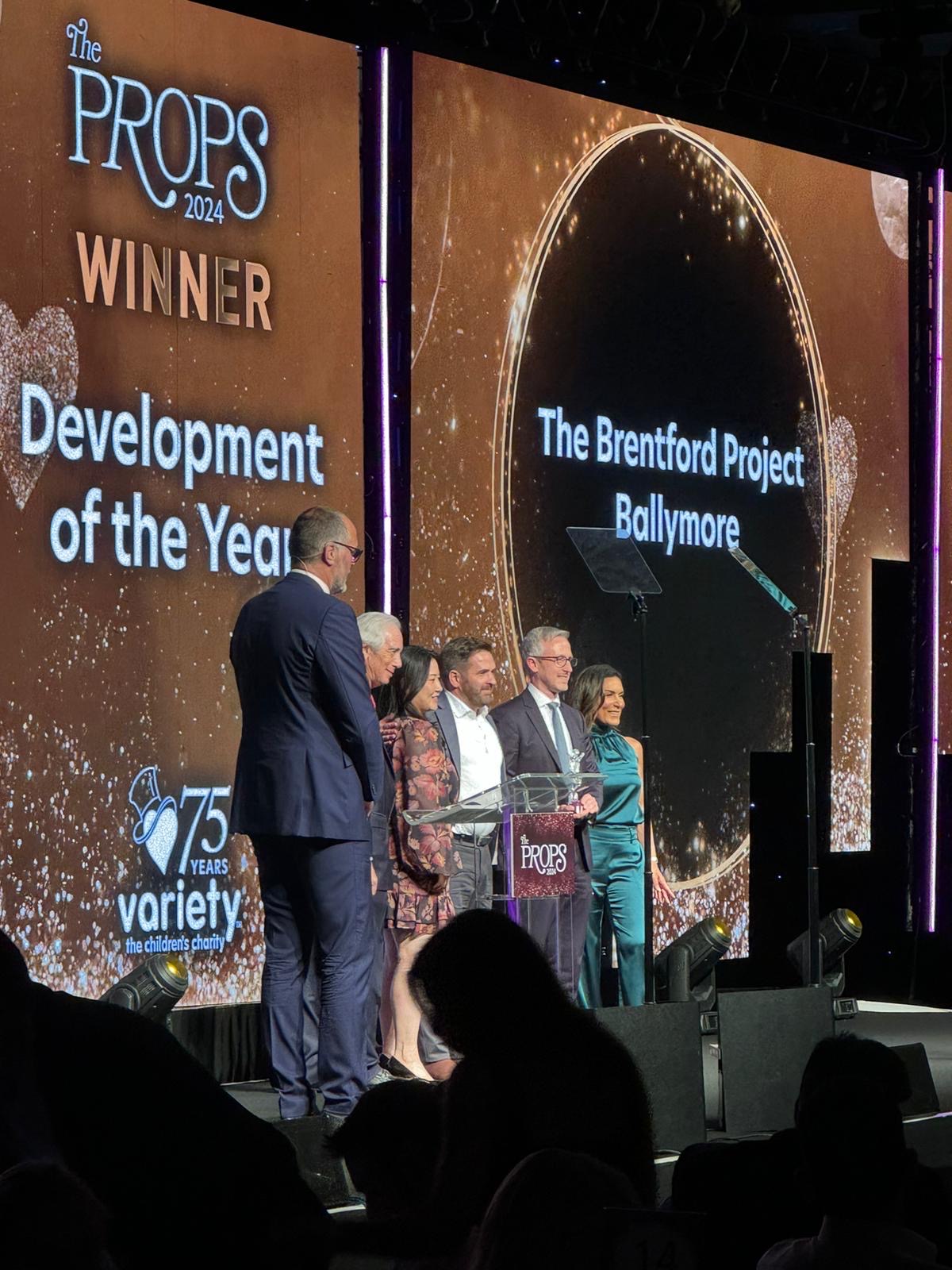
The PROPS Awards celebrate organisations that have excelled in the UK property sector, while also raising vital funds for children and young people through the Variety charity. Judges celebrated The Brentford Project as a bold approach to regeneration. The development injects new life into a previously neglected and overlooked waterfront area of west London regeneration – responding directly to local needs, revitalising the town centre and waterfront, delivering new private and affordable homes, five acres of public realm, new retail and leisure spaces, and creating employment opportunities.
Speaking of the win, Ballymore’s Managing Director John Mulryan said: “The PROPS Awards provide a unique opportunity for our industry to come together and celebrate our collective achievements while raising funds for a worthy cause.
“I am delighted that our work in Brentford has been recognised and extend my congratulations to all the other winners.”
In a simultaneous announcement, the judges of the 2024 British Homes Awards revealed that The Brentford Project has been shortlisted for the prestigious Regeneration Scheme of the Year Award.
The announcements follow a productive year for Ballymore at Brentford, with 319 private homes and 96 affordable homes completed. As a result, 220 residents now call The Brentford Project's one-bedroom studios to three-bedroom apartments home.
The commercial ecosystem at The Brentford Project is also flourishing, with 10 new retailers, many of which are independents, underscoring the development's appeal. Notable additions this year include brasserie-style restaurant Sam’s Waterside and deli Sam’s Larder by West London entrepreneur Sam Harrison, rug company Mother Rugger, bookseller Hewson Books, Italian restaurant Rottura, Everyman Cinema, and a permanent space for classic car dealership Duke of London, thanks to Ballymore's ongoing support.
Find out more about The Brentford Project here.
Related Articles
Planning permission granted for Stratford Waterfront
Related Articles
Former President of Ireland Mary McAleese unveils historic plaque at Embassy Gardens
Ireland’s former President Mary McAleese joined Ballymore Chairman and founder Sean Mulryan today, unveiling a new commemorative plaque in honour of Anglo-Irish suffragette Charlotte Despard – a pioneering figure in the realms of social activism, suffrage, and humanitarian efforts.
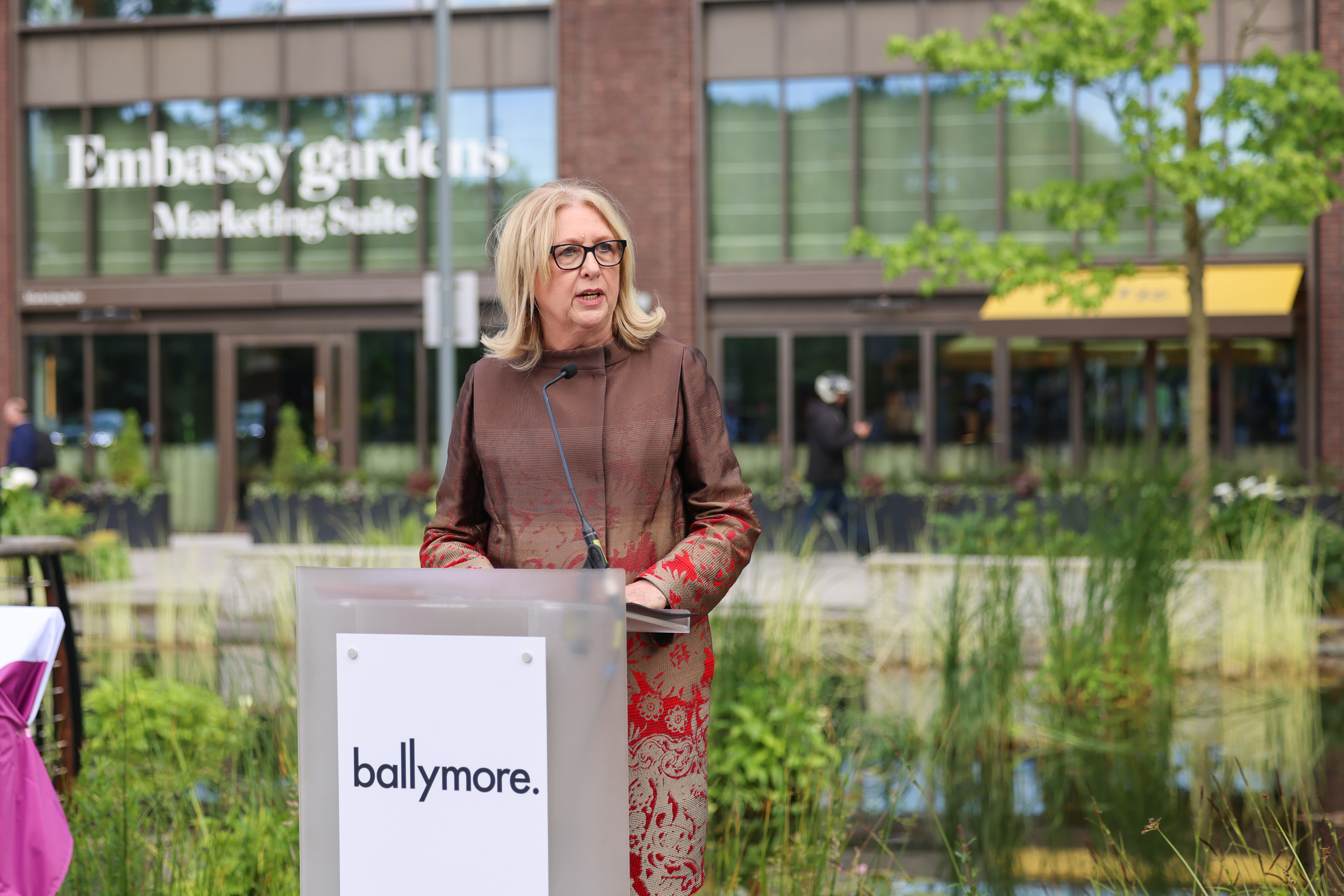
Donated by Ballymore’s founder Sean Mulryan, the plaque was unveiled at a public ceremony at Embassy Gardens in London. The event featured a reading of ‘What has Mrs Despard ever done for us?’ by the poet Hilaire, as well as music performances from award-winning music charity World Heart Beat, whose concert hall and academy is based at Embassy Gardens.
Mary McAleese, who served as the eighth President of Ireland from 1997 to 2011 said: “We all owe Charlotte Despard, and it is so important that her name is known, not for its own sake but for the sake of all she championed and all that still remains undone. She led by example - formidable, challenging example. I hope today is a call to action that she would be proud of, and I am very grateful for being allowed to be part of this event, grateful to those who have made it happen and to those who will make it their business to finish what she started.”
Added Sean Mulryan: “I have always been a passionate advocate of both the important heritage and future potential of Nine Elms, where our Embassy Gardens development has established a new, thriving community. We are proud to play a role in recognising and honouring Charlotte Despard, who contributed so much for people living in Nine Elms, and tirelessly worked for a more fair and equitable society – an important legacy to take forward.”
Known as "The Mother of Battersea” and one of Nine Elms’ most esteemed historical figures, Charlotte provided welfare facilities for the local community, many of whom were Irish, from her home at 2 Currie Street between 1890 and 1922, where landmark development Embassy Gardens stands today. Despard defied societal expectations of her time by dedicating her life to advocating for social justice and equality: the unveiling of a special plaque is testament to her contributions to the local community.
Charlotte married Maximilian Carden Despard, an Anglo-Irish businessman and banker who was heavily involved in the early days of the Hong Kong and Shanghai Banking Corporation (now known as HSBC) from 1865. When her husband died in 1890, Charlotte decided to dedicate the rest of her life to helping the poor, moving to Nine Elms where she offered welfare support to the local community. She spent a great deal of time in Ireland and in 1908 joined Hanna Sheehy Skeffington to form the Irish Women’s Franchise League, settling in Dublin after World War I.
In 1920 Despard toured Ireland as a member of the Labour Party Commission of Inquiry, and during the Irish War of Independence, together with Irish republican revolutionary, suffragette and actress, Maud Gonne, she collected first-hand evidence of army and police atrocities in Cork and Kerry. The two women also formed the Women's Prisoners' Defence League to support republican prisoners and in 1921, Despard shared a house with Maud Gonne, who was also well known for being the muse and long-time love interest of Irish poet W. B. Yeats.
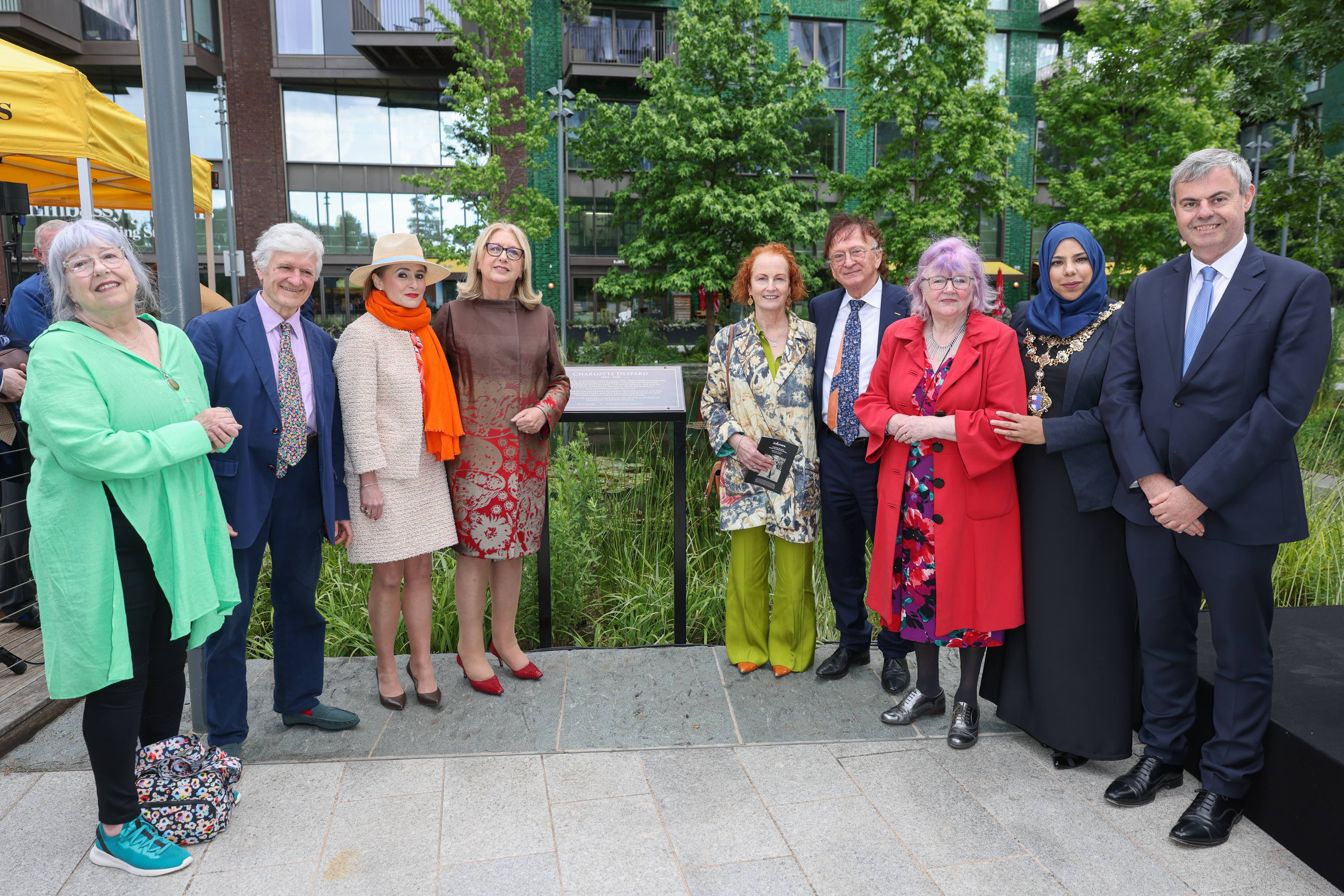
The unveiling ceremony was attended by Irish Ambassador to the UK, Mr Martin Fraser, broadcaster Ryan Tubridy, Mayor of Wandsworth Councillor Sana Jafri, as well as Lady Lucy French OBE, Despard’s great-niece, who said: “Growing up and listening to tales of my great aunt Lottie, I was always filled with immense awe. She was a woman so ahead of her time: a visionary in her support of the vulnerable, and the cause of women's rights. I could not be more proud to see her recognised in Nine Elms, a fitting tribute to the Mother of Battersea.”
The installation of the plaque represents the ongoing commitment of Sean Mulryan and Ballymore to honouring the historical significance of Nine Elms, and those who have lived, worked and contributed to the local community.
Related Articles
Ballymore wins at the 2024 Irish Construction Awards
Ballymore’s River Walk has received the Residential Project of the Year accolade at this year’s Irish Construction Awards.
The award was presented during a ceremony in Dublin on Friday night, celebrating Ireland’s top construction and development achievements over the past year.
River Walk is a new neighbourhood in Ballymore Eustace, the very area from which Ballymore took its name in 1982. Ballymore has now returned here, unleashing founder Sean Mulryan’s vision to extend the village.
Now, Ballymore has brought that to fruition, creating 80 energy-efficient homes that blend the traditional Irish cottage aesthetic with modern design. River Walk draws on the area’s rich heritage, seamlessly connecting the community to existing amenities.
Speaking of the win, Sean Mulryan said: "River Walk is our vision for a contemporary neighbourhood that draws on the best of local and Irish heritage.
“Our goal was to create a place that seamlessly integrates with Ballymore Eustace, celebrating its heritage while emphasising quality and sustainability. Returning to this village after four decades symbolises a homecoming, as we create a new neighbourhood that harmoniously coexists with its existing charm.
“We are thrilled to have our work recognised by the ICE judges and extend our congratulations to all the other winners and nominees.”
Founded in 1993 the Irish Construction Excellence Awards (ICE Awards) are the original and premier recognition of performance excellence for the contracting sector in Ireland. Find out more https://iceawards.ie.
Related Articles
Ballymore set to sponsor the 2024 Taste of Kildare Festival
Ballymore has announced its sponsorship of the 2024 Taste of Kildare Festival at Naas Racecourse this September.
The three-day event, hosted by the county’s tourism board Into Kildare, promises to be bigger and better than ever, celebrating Kildare as the beating heart of Ireland’s culinary scene.
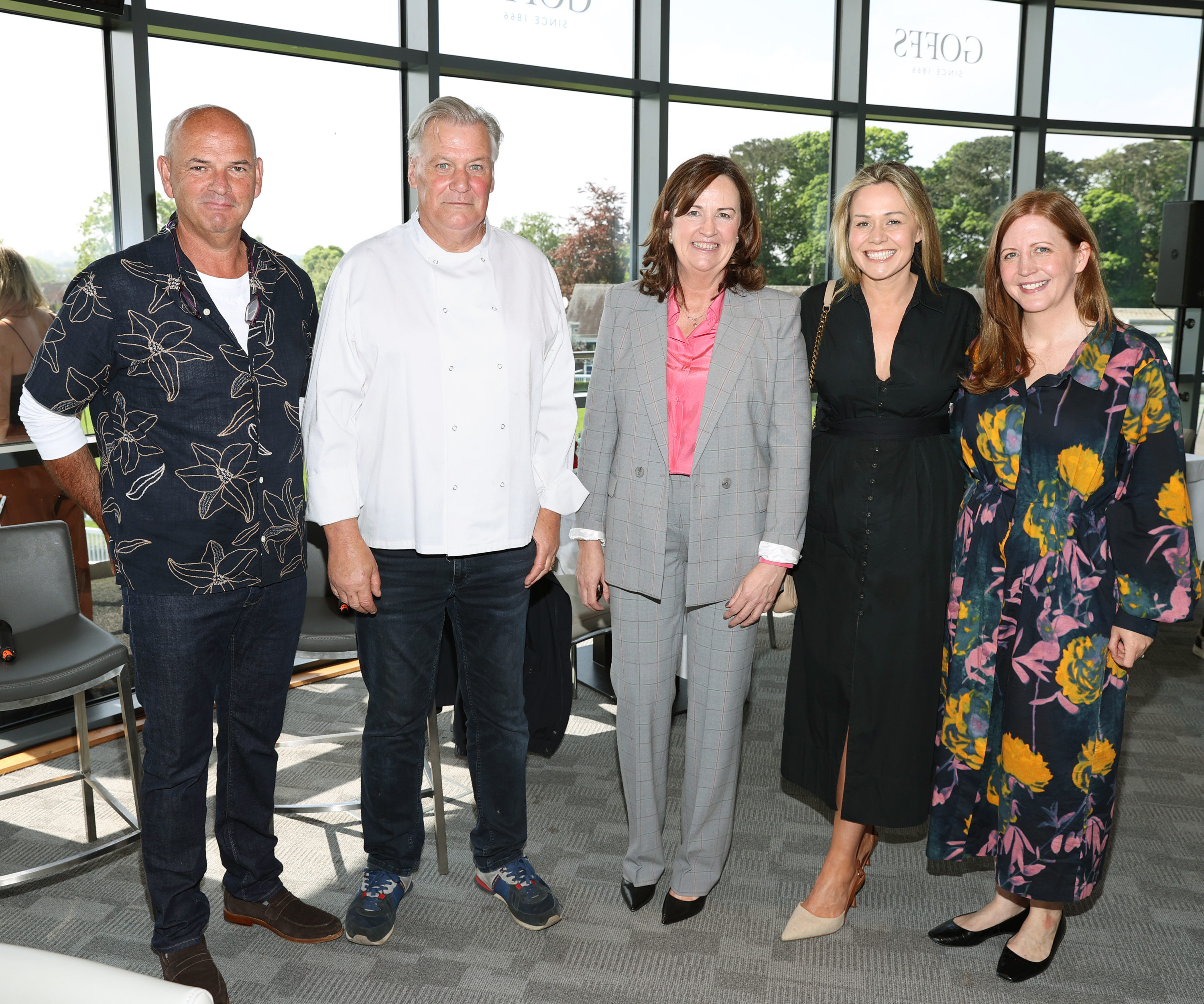
This year’s event will welcome more than 100 partners from the tourism and hospitality sectors, each honouring the area’s rich and diverse food culture. Among them is Kildare County Council’s Local Enterprise Office’s ‘The Flavours of Kildare Collective’ featuring 20 artisan producers.
There will also be demos, masterclasses and special food and drink villages as well as appearances from the county’s culinary stars, including celebrity chef Derry Clarke of The Club at Goffs; Gareth Naughton of Neighbourhood; Gary O’Hanlon from The K Club; Sean Smith from Cliff at Lyons; Jordan Bailey and Majken Bech-Bailey from Bech-Bailey; Natalie Collins of The Japanese Gardens Restaurant at the Irish National Stud & Gardens; Duro Vdovic of Fallon’s of Kilcullen; and Magali Buisson of O’Dooles Restaurant.
Ballymore, which was founded in Co.Kildare in 1982, is supporting this year’s event, as the company’s deputy managing director – and Kildare native – Linda Mulryan explained: “We’re proud to support Taste of Kildare this year, bringing the community together to celebrate the county’s rich food culture.
“Being from Kildare myself, I know how special an event like this is for bringing local businesses, families, friends and neighbours together. Ballymore built its first show home in Kildare over 40 years ago and has built 4,000 homes in the county since, with another 3,000 planned, so this partnership means so much to the whole company. We look forward to helping showcase Kildare’s culinary talent in September.”
Aine Mangan, CEO of Into Kildare added: “I am thrilled to once again support the tourism industry in Kildare and bring the Taste of Kildare to life
“Our past successes at prestigious venues like The Curragh and The K Club are a testament to the vibrant potential of our region. We are committed to continuing this tradition of excellence and showcasing the rich culinary and cultural experiences that Kildare has to offer.
The Taste of Kildare will run from 20th to 22nd September 2024. Ticket prices start from €15, and general admission, group and VIP packages can be booked via www.tasteofkildare.ie.
Related Articles
Ballymore四十年耕耘成就 不言而喻
Brian De'ath擔任銷售與行銷總經理已有七個月,我們與他探討了他是如何加入 Ballymore的,以及他對房地產市場的看法、購房者的基本需求,還有他在Frinton on Sea的海灘小屋為何是他最喜歡的地方。

“偶然進入這個行業,我感到幸運至極。”
在房地產開發這個行業裡,你不可能不熟悉Ballymore! 他們在業界四十年的成就精彩輝煌,我在為其他開發商工作的時候一直關注他們的進展。 簡而言之,我喜歡他們開發的項目。
使他們脫穎而出並真正體現他們獨特賣點的是對每個項目制定的個人化方案。 他們不會拿到項目後就認為:“我們要在項目上打上我們的Ballymore標籤就可以了”,這樣的開發商很難取得成功,我了解到:他們的重心是“我們要如何最好地 捕捉到這裡的地方特色,並將其融入項目之中”。
他們在每個項目中都專注於其地方特色,並賦予每個項目獨特的特質。 這與我之前合作過的開發商有著本質上的區別,這也是Ballymore成功的法寶之一。
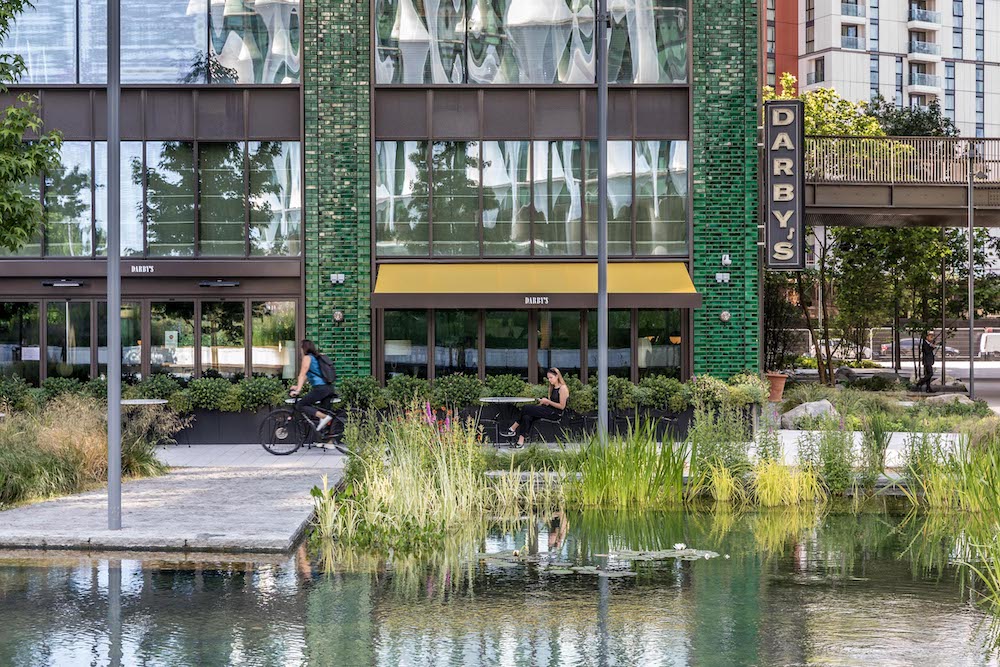
倫敦使館花園
未來願景
這種創新的觀點確保每個項目都能完美地捕捉到其所在社區的精髓,在創造一個蓬勃發展新社區的同時,也為社區錦上添花,賦予其勃勃的生機。 我永遠不會忘記 2011年去參觀使館花園的情景。 當時只有孤零零的三層展銷中心,周圍除了汽車展廳和輕工業之外什麼都沒有,然而當我站在觀景平台上被問及對它的看法時,我的回答很簡單:“難以令人置信”。
事實上,我希望自己可以為所參與的項目提供高品質的體驗,但現在我們還沒有做到,我們正在為此努力。 儘管現有的環境完全不令人振奮,但這正是我們提升水準,創造奇蹟的好機會,這說明它是多麼的不同尋常。
我們可以盡情美化我們的銷售詞句,但購買一棟房子的核心是讓人感受到安心與安全。 人們終渴望一個地方能讓他們遠離塵囂,放鬆身心。 吸引買家的關鍵點就是這個簡單的道理,而我在參觀使館花園時意識到的——當時的使館花園正處於起步階段,而13年後的今天——這種能夠喚起家的感覺的力量不斷壯大,在成熟的路上不斷邁進。 精心設計的空間可以讓人們看到未來的願景——這就是Ballymore已經多次做到的,也是他們今天仍然在做的。
在這裡工作能感受到一種巨大的能量和責任感,我認為這只有在老闆直接參與管理的公司中才能體會到。 我曾經為上市公司工作,聽到過“要以主角一樣行事”的建議,而現在我成為了公司的一部分,老闆位於公司所代表的一切事務核心。 它不屬於你見不到的遠端操控的股東,它屬於每天盡職盡責,辛勤工作在你周邊的人們。
綜觀全局
我工作中的一個重要部分是與我的團隊互動並激勵他們。 沒有房產銷售,我們就沒有業績,因此管理銷售團隊是我日常工作中不可或缺的一部分。 我曾經在房地產仲介公司工作過,所以我可以運用那些銷售技巧,但我必須更多地從全局思考,而不是被更細微的細節所束縛,同時還要記住,每一次銷售都值得慶祝。 每一宗交易都在提醒我們,我們已經激發了人們願將Ballymore成為自己家園的渴望。
永遠不要忽視人們在特定空間中的那種直覺感受,這一點非常重要,我認為這也是Ballymore成功的核心所在。 該公司對項目的全方位掌控非常出色——如果沒有這一點,就不可能取得過去40年來的巨大成就。 它將財務責任感與直覺,一種內在的感受結合在一起,這是必要的,尤其是在規劃像Embassy Gardens這樣需要數十年才能完成的多階段項目時。 總是有一些變數是你無法控製或預測的,要成功駕馭市場的大起大落,需要一定的綜合才能。
房地產市場又經歷了坎坷的一年;也許市場會將2023年下半年視為本輪經濟週期的最低點。 更廣泛地說,英國脫歐和疫情給我們帶來了持續的挑戰——我們看到了對大戶型住宅的需求在增加,購房者選擇在更大居住空間讓自己可以盡情放鬆,而在這方面的投資者則相對較少。
儘管Ballymore今年開局可圈可點,但我們永遠不能自滿。 利率對於潛在購買者是否有購買信心起著至關重要的作用,我們行業的所有人都在期待著首次降息;我是個樂觀主義者,一直預測降息會在今年五月發生...... 讓我們拭目以待。
簡報之外
工作之餘,我主要與朋友和家人在一起。 我和我的妻子Gaynor結婚 23 年,育有兩個女兒19歲的Holly Rose和 17歲的Madeleine。 我們喜歡在Frinton on Sea的粉紅白條紋沙灘小屋度過閒暇時光。 這個週末我將騎自行車70英里前往那裡,女兒們將乘車與我會合! 我最喜歡划船和在海裡游泳,也熱衷於跑步。 我剛開始嘗試鐵人三項比賽,並期待今年晚些時候即將到來的幾場比賽,能成為房地產開發領域的一份子,我感到非常幸運。 然而,當年我離開大學時,房地產開發行業並不在我為自己設定的宏偉藍圖之中,我將過去30年的成功歸功於我會對所有的機會都說"Yes!",以及積極的工作態度。
為Ballymore工作與我的個人目標完全契合: 你必須深度了解自己銷售的產品並相信它,如果你銷售的產品是如此卓越,那麼無論是作為我個人還是潛在的購買者,都很容易說"Yes "。
Related Articles
Ballymore四十年耕耘成就 不言而喻
Brian De'ath担任销售与营销总经理已有七个月,我们与他探讨了他是如何加入 Ballymore的,以及他对房地产市场的看法、购房者的基本需求,还有他在Frinton on Sea的海滩小屋为何是他最喜欢的地方。

“偶然进入这个行业,我感到幸运至极。”
在房地产开发这个行业里,你不可能不熟悉Ballymore!他们在业界四十年的成就精彩辉煌,我在为其他开发商工作的时候一直关注他们的进展。简而言之,我喜欢他们开发的项目。
使他们脱颖而出并真正体现他们独特卖点的是对每个项目制定的个性化方案。他们不会拿到项目后就认为:“我们要在项目上打上我们的Ballymore标签就可以了”,这样的开发商很难取得成功,我了解到:他们的重心是“我们要如何最好地捕捉到这里的地方特色,并将其融入到项目之中”。
他们在每个项目中都重点关注其地方特色,并赋予每个项目别具一格的特质。这与我之前合作过的开发商有着本质上的区别,这也是Ballymore成功的法宝之一。

伦敦使馆花园
未来愿景
这种创新的观点确保每个项目都能完美地捕捉到其所在社区的精髓,在创造一个蓬勃发展新社区的同时,也为社区锦上添花,赋予其勃勃的生机。 我永远不会忘记 2011年去参观使馆花园的情景。当时只有孤零零的三层展销中心,周围除了汽车展厅和轻工业之外什么都没有,然而当我站在观景平台上被问及对它的看法时,我的回答很简单:“难以令人置信”。
事实上,我希望自己可以为所参与的项目提供高质量的体验,但现在我们还没有做到,我们正为之努力。尽管现有的环境完全不令人振奋,但这正是我们提升水准,创造奇迹的好机会,这说明它是多么的不同寻常。
我们可以尽情美化我们的销售词句,但购买一所房子的核心是让人感受到安心与安全。人们终渴望一个地方能让他们远离尘嚣,放松身心。吸引买家的关键点就是这个简单的道理,而我在参观使馆花园时意识到的——当时的使馆花园正处于起步阶段,而13年后的今天——这种能够唤起家的感觉的力量不断壮大,在成熟的路上不断迈进。精心设计的空间可以让人们看到未来的愿景——这就是Ballymore已经多次做到的,也是他们今天仍然在做的。
在这里工作能感受到一种巨大的能量和责任感,我认为这只有在老板直接参与管理的公司中才能体会到。我曾经为上市公司工作,听到过“要以主人公一样行事”的建议,而现在我成为了公司的一部分,老板位于公司所代表的一切事务核心。它不属于你见不到的远程操控的股东,它属于每天尽职尽责,辛勤工作在你周边的人们。
纵观全局
我工作中的一个重要部分是与我的团队互动并激励他们。没有房产销售,我们就没有业绩,因此管理销售团队是我日常工作中不可或缺的一部分。我曾经在房地产中介公司工作过,所以我可以运用那些销售技巧,但我必须更多地从全局思考,而不是被更细微的细节所束缚,同时还要记住,每一次销售都值得庆祝。每一宗交易都在提醒我们,我们已经激发了人们愿将Ballymore成为自己家园的渴望。
永远不要忽视人们在特定空间中的那种直觉感受,这一点非常重要,我认为这也是Ballymore成功的核心所在。该公司对项目的全方位掌控非常出色——如果没有这一点,就不可能取得过去40年来的巨大成就。它将财务责任感与直觉,一种内心的感受结合在一起,这是必要的,尤其是在规划像Embassy Gardens这样需要数十年才能完成的多阶段项目时。总有一些变数是你无法控制或预测的,要成功驾驭市场的大起大落,需要一定的综合才能。
房地产市场又经历了坎坷的一年;也许市场会将2023年下半年视为本轮经济周期的最低点。更广泛地说,英国脱欧和疫情给我们带来了持续的挑战——我们看到了对大户型住宅的需求在增加,购房者选择在更大居住空间让自己可以尽情放松,而在这方面的投资者则相对较少。
尽管 Ballymore 今年开局可圈可点,但我们永远不能自满。利率对于潜在购买者是否有购买信心起着至关重要的作用,我们行业的所有人都在期待着首次降息;我是个乐观主义者,一直预测降息会在今年五月发生......让我们拭目以待。
简报之外
工作之余,我主要与朋友和家人在一起。我和我的妻子Gaynor结婚 23 年,育有两个女儿19岁的Holly Rose和 17岁的Madeleine。我们喜欢在Frinton on Sea的粉白条纹沙滩小屋度过闲暇时光。这个周末我将骑自行车70英里前往那里,女儿们将乘车与我会合!我最喜欢划船和在海里游泳,也热衷于跑步。我刚刚开始尝试铁人三项比赛,并期待着今年晚些时候即将到来的几场比赛,能成为房地产开发领域的一份子,我感到非常幸运。然而,当年我离开大学时,房地产开发行业并不在我为自己设定的宏伟蓝图之中,我将过去30年的成功归功于我会对所有的机遇都说 "Yes!",以及积极的工作态度。
为Ballymore工作与我的个人目标完全契合: 你必须深度了解自己销售的产品并相信它,如果你销售的产品是如此卓越,那么无论是作为我个人还是潜在的购买者,都很容易说 "Yes"。
Related Articles
“I love living at 8th Lock!”
8th Lock in Dublin has been tailor-made to provide everything our residents could possibly desire. Now as we launch the final homes available to rent, we hear from those who have already moved in, as they tell us how they’ve been settling into our newest neighbourhood – somewhere which heralds a new era of living with sustainability, accessibility and community at its heart.
“Living here has been transformative for my family”
The boundaries have been well and truly pushed at 8th Lock and it’s wonderful to see it in all its glory, with residents settling into what has already become a thriving and vibrant community.
From the onset, the masterplan for this development stretched the norm, striving for the innovative integration of the latest environmental friendly procedures to create a new standard of home with sustainability at its core.
The result is exemplary, with occupants soaking up the endless benefits as they create a new life in this space which provides all the amenities they could wish for, executed with precision with user experience at the forefront of every decision – something resident Ruth McKeown explains: “I love living at 8thLock. Everything’s convenient and it’s been so easy to make a life here; meeting new people and enjoying all that’s on offer.”
Beautiful communal gardens provide scenic walks, with amenities including an onsite gym, comfortable and inspiring meeting spaces, a roof garden and access to our dedicated tenant app and concierge services all designed with ease of living in mind. As resident Lucas Imbimbo explains: “The experience at 8th Lock has been excellent. The move-in process was swift and the staff have always been helpful. The gym is brand new - it’s fantastic and the concierge are always very helpful.”
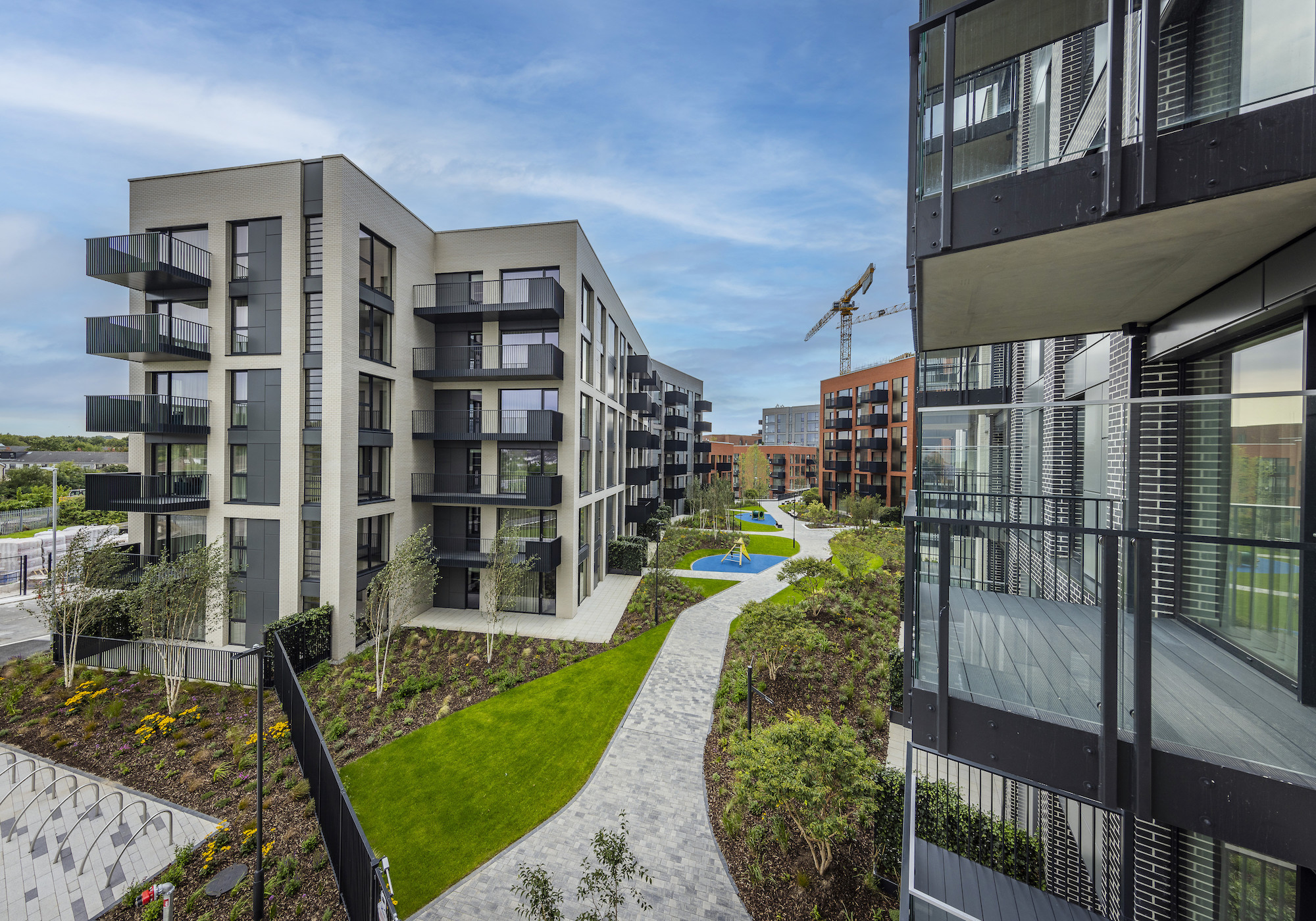
Situated close to the city alongside the Royal Canal, 8th Lock achieves the rare and harmonious balance of being able to offer beautiful green spaces on its doorstep alongside urban, connected living with its many flexible transport options and accessibility to Dublin.
Resident Thiago Sousa adds that moving here has been a “transformative experience” for his family adding, “instant access to public transportation just steps away adds another layer of convenience to our lives.” Lucas Imbimbo also says that “having easy access to public transport has been key to our experience.” Lucas’ comments are echoed by Ruth who works at a hospital and adds: “It’s all so well-connected, making all of my journeys to work really simple”.
But it’s not just location and accessibility that enables 8th Lock to shine. Integral to its vision was the commitment to create homes that offer practicality and beauty, inspiring an elevated living experience. Built with incomparable energy efficiency credentials, integrated heating systems and sleek finishes, these homes offer all the modern appliances you would expect, with light, spacious living areas and a balcony to enjoy the canalside vista.
Thiago Sousa reports that his apartment is “incredibly comfortable, and furnished with top-notch quality pieces.” While Lucas Imbimbo says: “my favourite part of the development is the apartment itself: the design is beautiful, and the furniture is of the highest quality, making my wife and I feel really at home.” Resident Phaniraj Rao confirms that “the property is particularly of very high quality making the experience of living here more memorable.”
With an abundance of parks, shops, restaurants, cafes, schools, and sports clubs all within walking distance, 8th Lock offers something for everyone, providing the opportunity to live in a unique and elevated way.
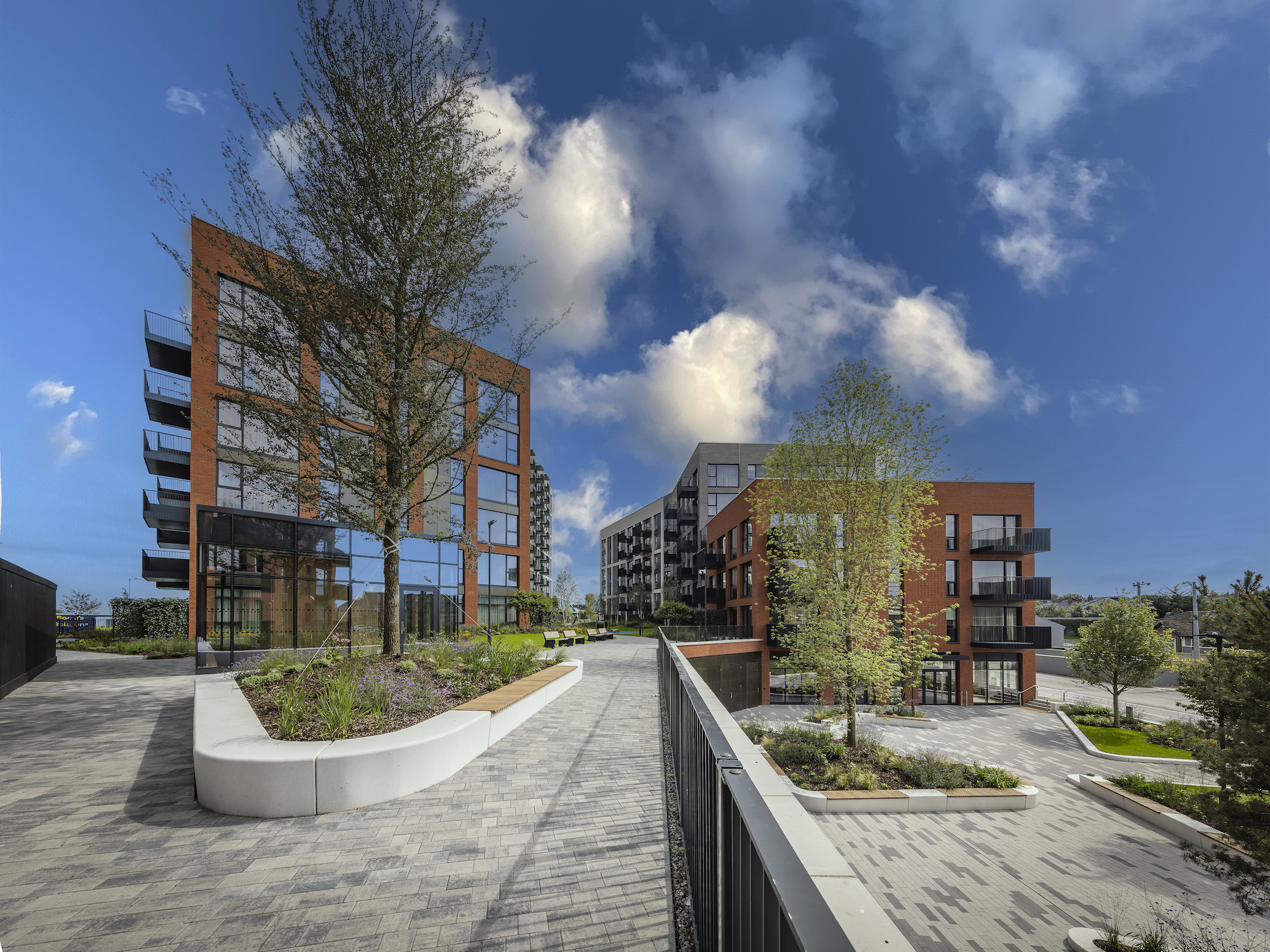
This Spring sees the much-anticipated addition of one- and two- bedroom rental properties available at 8th Lock with Anne Marie Higgins - Savills Agent to General Manager, 8th Lock ( Savills) - concluding: “We’re delighted to have welcomed so many fantastic residents to 8th Lock and look forward to presenting our newest rental homes in the coming weeks.
“They each present the highest standards of build quality – as is the way with Ballymore homes. And they come with a great resident service, a whole host of amenities, excellent connectivity and superb quality interior finishes.”
Find out more about the final homes at 8th Lock here.
Related Articles
“Ballymore’s 40-year track record speaks for itself”
Seven months into his role as Managing Director of Sales & Marketing we chat to Brian De’ath about what brought him to Ballymore, his view of the housing market, the fundamental needs of home buyers, and how his beach hut at Frinton on Sea is his favourite place of all.

“I feel very fortunate to have stumbled into this industry”
You don’t work in this industry without familiarising yourself with Ballymore! Their 40-year track record speaks for itself and I’d followed their progress throughout my career whilst working for other developers. Quite simply put, I love what they produce.
The element that makes them stand out and really encapsulates their USP is their individualistic approach to every project they undertake. They don’t arrive and say ‘we’re going to put our overarching Ballymore stamp on this’ which wouldn’t necessarily be an unsuccessful approach - instead they devote their energy into asking ‘how can we best capture the heart of this location.’
The focus is always to add to the unique character of the landscape with the stamp of approval coming from studying each potential development in isolation. This is an inherently different approach to developers I’ve worked with previously and forms part of the Ballymore magic.

Embassy Gardens in London
A vision of the future
This innovative outlook ensures that every project seamlessly captures the essence of its location, to create an organic addition to the space whilst creating a thriving new community. I’ll never forget going to visit Embassy Gardens in 2011. There was just the original three storey marketing suite on site surrounded by nothing but car show rooms and light industry, yet when asked what I thought of it whilst standing on the terrace viewing platform, my response was simply ‘I think I feel ill.’
The truth is, I wished that I was delivering this quality of experience on the projects I was currently dealing with, but at this time we weren’t. That this space had been able elicit this level of feeling, despite the existing surroundings being completely uninspiring, shows how very special it was.
We can dress it up as much as we like, but at the heart of buying a home is the need to feel secure and safe. People have always - and will always want a place where they can shut the rest of the world away and relax. The ability to attract buyers lies in this simple truth and what I realised on that visit around Embassy Gardens - which was at the very beginning of its journey and is still coming to fruition 13 years later - is the power in being able to evoke that feeling of home. The skill of executing a space whereby people can see a vision of the future - their future. That’s what Ballymore have done countless previous times – and it’s what they still do today.
There is also a great energy and sense of responsibility in working here, which I think can only come from being part an owner managed business. Having worked for PLCs and received the advice to ‘act like you own it’ I’m now part of a business where the owners sit at the very heart of everything the company stands for. It doesn’t belong to distant shareholders, who you can’t visualise, it belongs to real people working incredibly hard, showing up every day to do the best they can.
Seeing the bigger picture
An essential part of my role is to engage and motivate the teams around me. Without selling our properties we don’t have a business, so managing the sales team is an integral part of my day to day. I used to work as a salesman in an estate agent so I can use that skill set although I have to take more of a helicopter view rather than get tied down in the finer details, whilst also remembering that every single sale deserves a celebration. Each is a reminder that we have triggered that human response to the feeling of being in a Ballymore home.
It’s important to never lose sight of how people feel in a space, something I feel is at the core of Ballymore. The business has a very good handle on the numbers - you don’t get to achieve what it has in these past 40 years without this. But it combines this fiscal responsibility with intuition, a gut feeling, which is necessary, especially when planning multi-phased projects like Embassy Gardens which can take decades to complete. There are always going to be variables you can’t control or predict and it takes a certain skill set to successfully navigate the many ups and downs of the market.
The housing market has experienced another tricky year; perhaps the market will look back on the latter part of 2023 as a low point in this economic cycle. More broadly, Brexit and Covid have presented us with continued challenges - we’ve seen a higher demand for larger homes with buyers choosing to stretch themselves into bigger spaces, whilst investors have been far thinner on the ground.
Although we have had a positive start to the year we can never be complacent. Interest rates have a big part to play in giving potential buyers the confidence to move forward with their purchase and all of us in the industry are waiting expectantly for the first rate cut; I’m an optimist and have been predicting that’ll happen this May… let's see.
Beyond the brief
Outside of work you’ll mainly find me spending time with friends and family. I’ve been married to Gaynor for 23 years and we have two girls, Holly Rose (19) and Madeleine (17). We love to spend time at our pink and white striped beach hut in Frinton on Sea - in fact I’ll be cycling the 70 miles there this weekend and the girls will meet me there, travelling by car! My favourite thing is to paddle board and swim in the sea, and I’m also a keen runner. I’ve just started to experiment with triathlons and am looking forward to a couple of events later this year.
I feel very fortunate to be a part of the property development world. There was certainly no grand plan for this as a career when I left university and I put whatever success I have been part of over the (almost) last 30 years to saying yes; to opportunities and having a can-do, positive attitude.
Working for Ballymore is in alignment with my own goals: You must be invested and believe in the product you are selling and when the product is this good it’s easy to say yes to it, both from mine and a potential purchaser's perspective.
Related Articles
Celebrating the great women of Ballymore: Part III
This week we celebrate International Women’s Day by catching up with three of our colleagues across the business to see what the day means to them, and their experiences working in the construction industry.
During her short time with us, Helen McNamara has already been recognised by colleagues as having a calm and balanced approach to life which ignites her natural ability in being able to deal with people with deep compassion and care, making her the perfect first port of call in our offices at Ballymore.
We chat to her about her job as our Receptionist, life generally, and how she’s found raising a family whilst fulfilling her own aspirations.
‘I’ve raised three strong young women’
I’ve led a varied life career-wise, yet dealing with people is always the same. I think everyone should be offered compassion and empathy and a chance to be listened to. I deal with Aftercare at Ballymore, as well as the day to day running, so I’m often having to sort out problems for people.
At heart, we’re all consumers so I can relate to everybody on that level, but fundamentally, I like people and want to help them. It’s coming up to a year working here and I love it. It sounds cliche, but it’s the people that make it - they’re the friendliest bunch! Many have high-pressure jobs, but they never take anything out on you, everyone is treated with kindness and respect and that’s really important.
Lending an ear
My job means I get to meet many different people daily, with contractors coming in for meetings and staff constantly around. I pop a bowl of sweets on my desk for anybody who wants one, I like to encourage people to come and say hello, the sweets lure them in. I love engaging with people and can pick up on a person’s mood quickly.
My kids are older now and some have their own families, but I feel very fortunate that I was able to be at home with them during their formative years. That said, I still did my bit, providing accommodation for students and setting up my own business from home sourcing and selling diamond tip blades having spotted a niche in the market. Essentially though, I was where I wanted to be, with my children. I'm acutely aware that it’s not always easy for women to have a career and a family, especially when a child is sick; I’m still incredibly grateful that I had that opportunity.
Equality for all
Whilst I recognise that International Women’s Day is a positive thing, I feel that every day should be for everyone! I don’t like to distinguish specifically on gender, as I believe it’s about who you are as a person, although I recognise that I’ve been incredibly fortunate and led a very privileged life as a woman when so many haven’t. I raised three amazing daughters, and a son who values equality and is brilliantly respectful. I wanted them to experience real life and different cultures so we moved to West Africa for two years when they were aged between four and fourteen. I really believe that experience has had an everlasting effect on them and has made them very humble individuals with an acute awareness of the importance of human connection.
I’m really happy working at Ballymore and enjoying this period of my life, working full time, seeing my grandchildren, and writing a book! I’ve always written - in the past it was plays and now a work of fiction called ‘MisConceptions.’ I don’t know where it will lead but as I’ve always said, ‘feel the fear and do it anyway’ – a great message for everyone I think!
Related Articles
Celebrating the great women of Ballymore: Part II
This week we celebrate International Women’s Day by catching up with three of our colleagues across the business to see what the day means to them, and their experiences working in the construction industry.
Today we met Flavia Coelho who’s had to tackle more than most to get to where she is today, including learning a whole new language as part of her decision to move to Ireland from her home in Brazil.
Here, she tells us how she’s settled into her role as a Design Coordinator here at Ballymore and why it was worth the sacrifice.
“I’ve found more women than ever are being welcomed into the industry”
I’ve worked at Ballymore for almost two years but have been in the construction industry for much longer. I grew up, and began my career in Brazil, working there as an architect for nine years before deciding that I wanted to move abroad. In 2017 I made it happen and took the plunge, moving here to Ireland. It was a big move and involved making a few sacrifices, but I was adamant it was what I want to do even though it was very hard to leave my family.
My next challenge of course was learning the English language as a native Brazilian! So for the first couple of years I invested all of my energy into doing just that whilst earning a living working in restaurants and cleaning to get by.
In my third year here I was fluent enough to be able to do a master’s degree in project management which meant I could then get back to doing what I love, working in construction. It’s a challenging job, and I can’t say it’s always easy, but I honestly can’t see myself doing anything else. I’m responsible for coordinating all the Design elements of our projects, ensuring the Ballymore aesthetic is adhered to at every stage and in keeping with stringent health and safety guidelines. I oversee the design, working with the commercial department and site team right up to construction. Currently I’m overseeing three projects so it keeps me very busy!
A job for life
I have to say, I’ve found more women than ever are being welcomed into the industry and that is really nice to see. I have found in the past that as a woman I maybe didn’t get taken as seriously as male colleagues, especially when dealing with external contractors on site, but that has diminished as time has progressed and I would encourage any woman who is passionate about the industry to feel confident in pursuing it. As with any job it has its high-pressure moments, but I love the people and working with all the different departments means I interact with many on a daily basis so it suits me perfectly. There are opportunities for everyone - male or female, it’s more whether it suits you as a person as it’s a dynamic job that involves a lot of problem-solving. I’m in it for the long haul!
I miss my family of course, and I try and get home to Brazil once a year if I can, but inevitably I miss weddings and birthdays and that’s hard, but I’m incredibly proud of all that I’ve achieved in my career and don’t regret moving despite the sacrifices I’ve made. The work-life balance depends on where I’m up to on any given project but I have a lovely life outside of work seeing friends, keeping fit at the gym and hiking in beautiful Ireland.
I think International Women’s Day is a great initiative and a way to celebrate every aspect of being a woman, not just the career we choose. We celebrate it in Brazil too so it’s nice to see it’s represented around the world.
Related Articles
New Skills Centre to provide a base for construction and STEM skills in Edgware
New Edgware Skills Centre set to come to Station Road, located in the former Argos unit on Station Road and delivered by a partnership between Ballymore, Places for London and The Skills Centre
The Skills Centre, opening in spring 2024, is already making an impact with local care-leavers and apprentices from Barnet Southgate College involved in the fit-out
The new centre underlines Ballymore and Places for London’s commitment to growing local skills as part of the proposed regeneration of Edgware Town Centre
A new Skills Centre will soon open on Station Road in Edgware and will provide a base for local people seeking to embark on a range of rewarding and varied careers in construction and the built environment. The Skills Centre has been funded and delivered by Ballymore (owners of the Broadwalk Shopping Centre), Places for London (Transport for London’s property company) and The Skills Centre (an employer-led, community-focused, training and apprenticeships provider). The hub will be a focal point for growing local skills and talent, taking advantage of the opportunities presented by the proposed regeneration of Edgware Town Centre and beyond.
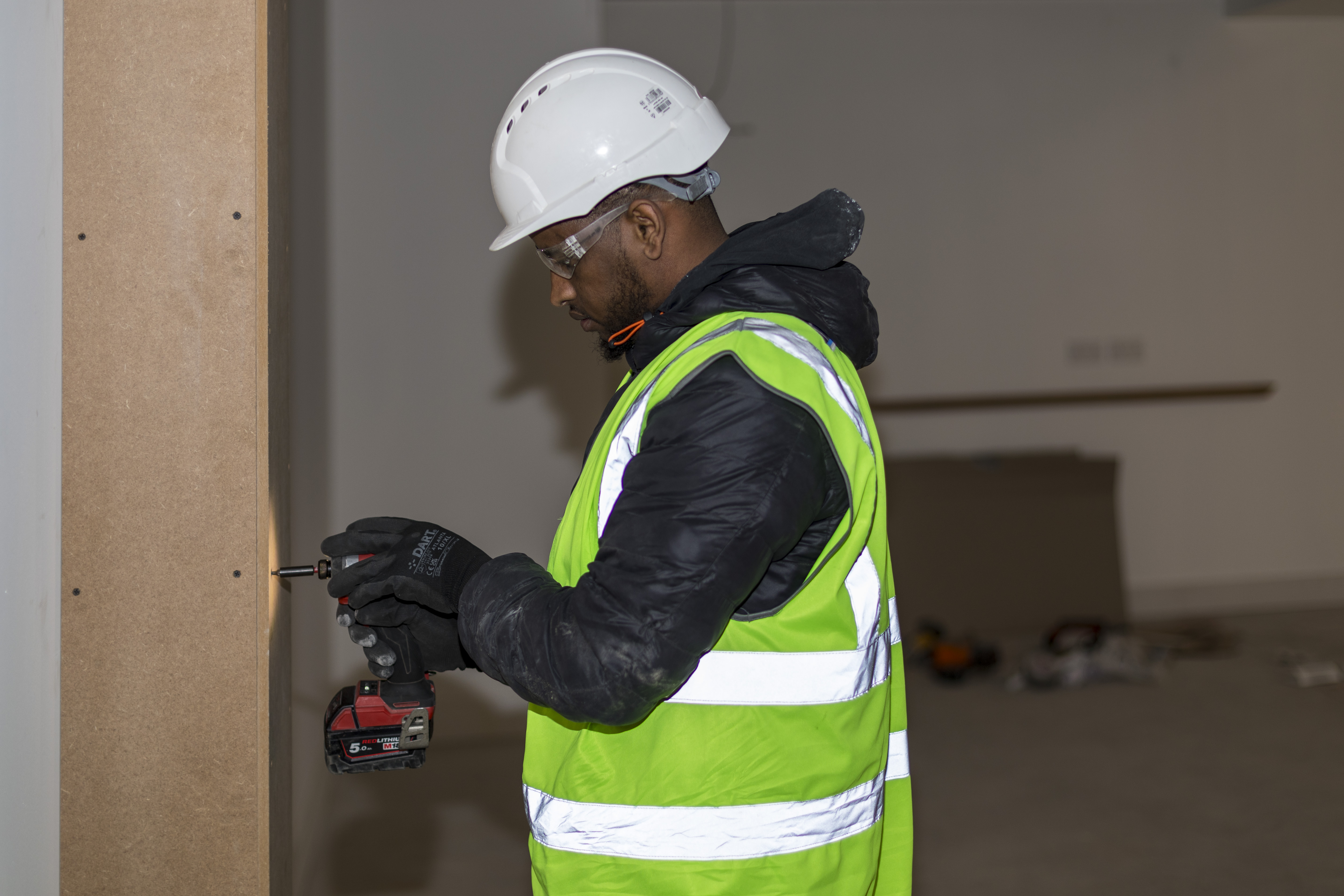
The centre, which is set to formally open its doors in spring this year, is designed to offer a diverse range of training opportunities, including pre-employment training, dry-lining apprenticeships, retrofit and green skills bootcamps, Site Management Safety Training Scheme (SMSTS) and Site Supervisor Safety Training Scheme (SSSTS) courses. The doors will be open to anyone interested in a career in construction and the built environment – whether as part of their first step into the sector or in order to progress their career. As the proposed development progresses in the future, the centre will support an ever-increasing range of exciting career options, with hundreds of local people benefitting from training and job opportunities.
Ahead of its official opening, the Skills Centre is already making an impact in Edgware, with the fit-out of the unit presenting a unique opportunity for local residents and students to gain important new skills and develop hands-on experience.
One such individual is Simon, a 25-year-old Hendon resident who applied to work on the fit-out through Barnet Council’s Care Leavers scheme. This followed a Construction Information Day, hosted by Barnet Council, Rothwell Interiors and Places for London, which aimed to support young and disadvantaged people in the borough into work experience and job opportunities. Simon, who lives in foster care, has gained vital new skills through the project from carpentry to electrical skills. The role has given him the necessary experience to obtain his Construction Skills Certification Scheme (CSCS) Card and he’s looking forward to using his experience as a springboard to gain further qualifications, continue expanding his skills and eventually start his own business.
Speaking about his experience, Simon said: “The construction skills and experiences I’ve got here are really valuable. Not only are they helping me get the necessary qualifications I need to build my career, but they’re also practical skills that are helping me become more self-reliant and save money at home.
“A lot of young people might not see construction as a career path they want to take as it takes time and effort to build the skills you need, but if you’re patient and work hard, it can change your life.”
The Skills Centre has also provided opportunities for Andre and Tariq, students at Barnet and Southgate College. They are taking part in work placements on the site, balancing the practical experience on-site with their Level 3 electrical installation courses. The two students have been working on the site two days a week, learning new skills and understanding how a busy commercial site works.
As Andre notes: “Construction is a great stepping stone to challenge yourself and build a career.” Tariq agrees with this, adding: “I want to be a master in one skill, but get experience in everything. so I can futureproof my career. The experience here’s been great for that - I can do a bit of everything and it helps you understand where you see your future.”
Building on The Skills Centre’s expertise in training skilled workers for the construction industry, the centre has been set up to look to the future of Edgware as Ballymore and Places for London prepare to submit their outline planning application for the comprehensive regeneration of The Broadwalk Centre site and neighbouring land. The wider plans will see £1.7billion invested in Edgware, adding £80m Gross Value Added (GVA) to the local economy and creating more than 1,400 full-time jobs.
Ballymore and Places for London’s wider masterplan for the site proposes to deliver 3,365 new homes, including up to 1,150 affordable homes, and 463 student accommodation spaces. A significant increase in green space for the town centre includes a new Deans Brook Nature Park, which is to be created by unlocking land which has been inaccessible to the public for almost 100 years.
In advance of the proposed development coming forward, the Edgware Skills Centre will be key to providing the next generation of workers with vital skills, particularly across the built environment and sustainability sectors.
Simon Ryan, Ballymore’s Developments Director said: "The Skills Centre exemplifies the potential of underutilised high street spaces. The team has been doing great work in other locations delivering quality courses and qualifications that respond directly to demand. Their insight into what the market needs, now and into the future, gained by partnership working with developers like us and Places for London delivers huge value to their students.
“Whether you're looking to find a path to your first job, or looking to make a change in career, The Skills Centre has a lot to offer. We're thrilled they've chosen to partner with us in Edgware and look forward to seeing them grow and expand their services over time."
Lisa-Jane Risk, Head of Operations at Places for London, said: “Through the opening of the new Skills Centre in Edgware later this year, we’re helping people across the city take the first steps into the construction industry as well as support them into the next stage of their career.
“The new Skills Centre at Edgware will play a vital role in creating new opportunities for those looking to gain skills in the construction and built environment sectors. It will build on our existing range of programmes, including other Skills Centres, that have led to more than 5,000 people receiving training since 2020, with more than 2,000 of those already having found employment.”
Jon Howlin, Chief Executive of The Skills Centre said: “We are looking forward to bringing local opportunities to residents, contributing not only to the Edgware Town Centre development but also fostering a skilled workforce for the broader prosperity of Barnet. The new Edgware facility will underline our commitment to matching skills training to real opportunities with local employers, ensuring that our programs align with the needs of the job market.”
John Bryson, Welfare. Employment and Skills Programme Manager at the London Borough of Barnet said: “With more than 6,000 jobs ringfenced for local people and well over 500 apprenticeships in the pipeline from live developments alone, the scale of opportunity for local residents is off the scale. Working with partners including Barnet and Southgate College, The Skills Centre will be a focal point to promote careers in the construction sector, and provide a unique and essential route for local people to gain the skills needed to secure jobs and apprenticeships.”
Stephanie Ejiogu, Industrial Placement Officer at Barnet Southgate College said: “The Skills Centre in Edgware is already providing invaluable opportunities for our students, helping them to gain the essential hands-on experience on working sites that cannot be replicated remotely. We’re looking forward to continuing our work with the Skills Centre, Ballymore and Places for London, to empower more people from more diverse and varied backgrounds to get the skills they need for a rewarding lifelong career in construction and STEM”
Anyone interested can get in touch via The Skills Centre website, for guidance on how they can help match your skills to local employment opportunities.
Related Articles
Celebrating the great women of Ballymore: Part I
This week we celebrate International Women’s Day by catching up with three of our colleagues across the business to see what the day means to them, and their experiences working in the construction industry.
We start today with Monica Healy; Monica is the epitome of a strong, hardworking woman and one we’re incredibly happy to have in our workforce. She attests that her success in her role as a Senior Site Admin and Project Coordinator is only possible thanks to her team of equally strong women; Maggie Conway Halligan, Donna Sommers, Fiona Reid and Joanna Osowska with them all working seamlessly together to help ‘build a community.’
Coming from a large family - eight of them girls, Monica offers a fascinating insight into the dynamics of gender, and how formative it was for her to have an inspiring mother who always told her she could achieve anything.
‘Woman are like teabags, you don’t know how strong they are until they are in hot water’
I come from a line of very strong, independent women, and that is all down to my mum, who was very forward-thinking for her time. She worked incredibly hard and always told us to follow our dreams and that is exactly what I have done.
It’s not been easy, especially in the earlier days when I worked in wholesale, travelling around construction sites - I went to an interview 20 years ago for a builder’s merchant and was the only female applicant - it just wasn’t considered a woman’s job, needless to say I didn’t get the position. However, two years later they phoned me and offered me a job as their first female rep!
Thankfully, the stereotype that women don’t fit into this industry is long gone and today it’s a very different place. Especially at Ballymore who are absolutely fantastic to work for. Everyone has a role to play and no one is less important than anyone else; job description or gender is irrelevant. We’re all a valued cog in the wheel; as they say, ‘no man (or should I say ‘woman’) is an island’ - we’re all equal!

The dream team
I’ve worked at Ballymore since 2015 and very happily so - I still wake up every morning grateful to be here and looking forward to my work. My team is invaluable, I wouldn’t be where I am without them, and we all work very coherently together. I’m also very conscious that I support them, in the same way I have been supported through my career here; special thanks to Don Mc Mahon and all the residential team.
Of course, there have been challenges, I raised my two boys alone whilst balancing my career and make no mistake, navigating childcare with a career is not easy, especially three decades ago when I felt judged for my situation by society, but again, my mum gave me the strength not to feel the need to conform and get married – she encouraged me to live authentically. I’ve always felt that I’ve broken boundaries and I wouldn’t have it any other way.
Two years ago I bought my own home in Ireland, a Ballymore property of course! I’d worked on the Bellingsfield development from the beginning, so it was a real full-circle moment to buy a property there and be part of the new thriving community. That’s the wonderful thing about my job, you’re part of something so big and special and you see something come together from scratch and all of a sudden you have this new community – you’re literally creating a village, it’s deeply fulfilling and I’m living the reality of what Ballymore create first hand in my new home.
Paving the way for the future
My boys are grown up now, in fact, I became a Grandmother a few weeks ago which has been a wonderful addition to my life. His partner said to me how incredibly hands-on and wonderful my son is as a dad, and I felt such pride. I always strived to bring up my boys with integrity and grace with a respect for equality - in fact, one of them was born on International Women’s Day!
It’s great to celebrate the achievements of women, I was brought up with the notion that we don’t just do things for ourselves, being strong and responsible as a woman is leading the way for future generations of females who need to know that anything is possible and I live by that mantra every day.
Related Articles
巴利摩協助Barnet政府對Edgware鎮中心商業區進行首次改造
2023下半年,Barnet市政府宣佈Edgware鎮中心地帶將迎來首次商業改造專案(Business Improvement District - BID),該改造專案的投資額高達80萬英鎊。
BID是由Edgware鎮商業改造團隊共同努力推動下的成果。該團隊是由巴利摩、倫敦交通局、Barnet市政府和當地商家聯合組成,他們在此前的一年裏開展了廣泛而全面的諮詢活動,以瞭解Edgware商家的關注點及目標需求。Edgware鎮中心也是巴利摩開發專案Broadwalk購物中心的所在地,該專案也是當地重要的重建專案。
談及這一消息,巴利摩專案總監Simon Ryan說:“我們致力於Edgware地區的轉型,非常高興看到BID成為現實。這一消息會把當地商家凝聚在一起,齊心協力投資鎮中心的建設,參與管理與行銷,目的是振興該地區的經濟,打造繁榮的社區。”
擔任Barnet小企業宣導者兼社區財富建設內閣成員的市議員Anne Clarke女士認為:“作為Barnet的第一個鎮改建專案,Edgware的BID成為我們與社區、商家合作的一個里程碑。
“我們非常熱愛Edgware社區,也非常關心生活與工作在Edgware城鎮中心的人們,通過BID專案增進了議會與Edgware商界之間的溝通與對話。我們希望通過BID目標的達成,能夠讓Edgware鎮成為新、老企業共同蓬勃發展的繁榮社區”。
巴利摩集團參與開發Edgware鎮始於2020年,當時開發商收購了占地7.5公頃、面積為17,650平方米的購物中心,該購物中心位於Edgware地鐵站一側。巴利摩團隊目前正在為該購物中心進行開發建設,該專案包括建造高質量的新住宅大樓、零售商家、公共領域、綠色空間以及社區休閒設施。Simon表示:“這是Edgware鎮中心的核心地段,它具有開啟鎮中心復興的潛力。我們很高興能把我們的構想帶到這個地區,通過與當地居民探討、協商,開發一個讓所有在這裏生活、工作和休閒娛樂的人們都能引以為豪的新城鎮。”
“我們的商業中心重建計畫以及BID的舉措都證明了Edgware鎮的巨大潛力,這將使Edgware成為倫敦北部一個充滿活力、生機勃勃的繁榮小鎮。”
BID是由Edgware當地企業和商家等聯合組成,負責協調並管理商業區的行銷,BID受法律監管,以確保買賣的公平與透明。通過商家的廣泛磋商,制定為期五年的商業發展計畫。旨在改善該當地的商業環境,從而促進經濟增長和社區發展。Edgware的BID是Barnet地方政府推出的首個專案,欲瞭解更多資訊,請點擊here。
Related Articles
巴利摩协助Barnet政府对Edgware镇中心商业区进行首次改造
2023下半年,Barnet市政府宣布Edgware镇中心地带将迎来首次商业改造项目(Business Improvement District - BID),该改造项目的投资额高达80万英镑。
BID是由Edgware镇商业改造团队共同努力推动下的成果。该团队是由巴利摩、伦敦交通局、Barnet市政府和当地商家联合组成,他们在此前的一年里开展了广泛而全面的咨询活动,以了解Edgware商家的关注点及目标需求。Edgware镇中心也是巴利摩开发项目Broadwalk购物中心的所在地,该项目也是当地重要的重建项目。
谈及这一消息,巴利摩项目总监Simon Ryan说:“我们致力于Edgware地区的转型,非常高兴看到BID成为现实。这一消息会把当地商家凝聚在一起,齐心协力投资镇中心的建设,参与管理与营销,目的是振兴该地区的经济,打造繁荣的社区。”
担任Barnet小企业倡导者兼社区财富建设内阁成员的市议员Anne Clarke女士认为:“作为Barnet的第一个镇改建项目,Edgware的BID成为我们与社区、商家合作的一个里程碑。
“我们非常热爱Edgware社区,也非常关心生活与工作在Edgware城镇中心的人们,通过BID项目增进了议会与Edgware商界之间的沟通与对话。我们希望通过BID目标的达成,能够让Edgware镇成为新、老企业共同蓬勃发展的繁荣社区”。
巴利摩集团参与开发Edgware镇始于2020年,当时开发商收购了占地7.5公顷、面积为17,650平方米的购物中心,该购物中心位于Edgware地铁站一侧。巴利摩团队目前正在为该购物中心进行开发建设,该项目包括建造高质量的新住宅大楼、零售商家、公共领域、绿色空间以及社区休闲设施。Simon表示:“这是Edgware镇中心的核心地段,它具有开启镇中心复兴的潜力。我们很高兴能把我们的构想带到这个地区,通过与当地居民探讨、协商,开发一个让所有在这里生活、工作和休闲娱乐的人们都能引以为豪的新城镇。”
“我们的商业中心重建计划以及BID的举措都证明了Edgware镇的巨大潜力,这将使Edgware成为伦敦北部一个充满活力、生机勃勃的繁荣小镇。”
BID是由Edgware当地企业和商家等联合组成,负责协调并管理商业区的营销,BID受法律监管,以确保买卖的公平与透明。通过商家的广泛磋商,制定为期五年的商业发展计划。旨在改善该当地的商业环境,从而促进经济增长和社区发展。Edgware的BID是Barnet地方政府推出的首个项目,欲了解更多信息,请点击here。
Related Articles
巴利摩志願者參加運河日活動 為改善社區環境助力
8月23日,來自巴利摩的約20名員工參加了The Canal Day of Action(運河行動日)活動,旨在為改善當地環境和空間做出貢獻。
運河行動日是在皇家自治市Kensington和 Chelsea的區域內舉行。此活動是由該地慈善機構"自主之路"(Pursuing Independent Paths )(PiP),與運河與河流基金會以及Meanwhile Gardens社團聯合舉辦。
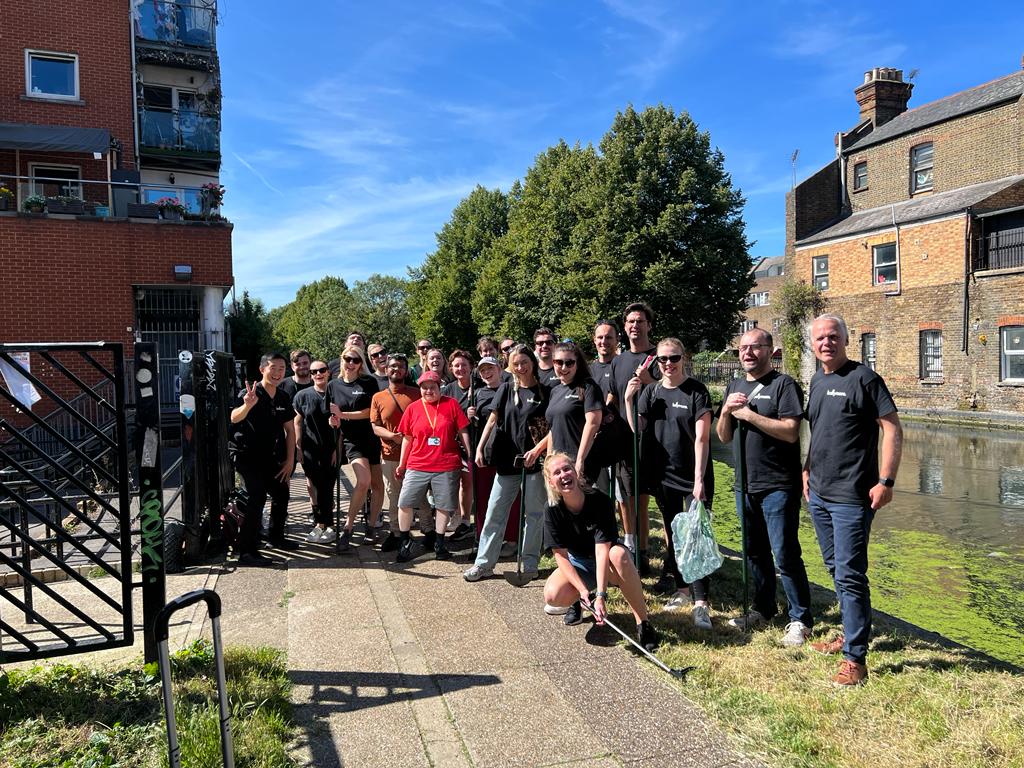
慈善機構自主之路(PiP)的學生也參加了這一活動。PiP致力於支持那些學習障礙或自閉症成年人。該機構提供一系列支持服務,幫助這些個體實現更加獨立和有意義的生活。PiP的服務包括生活技能培訓、社交技能發展、就業支持等。他們的目標是幫助這些人融入社會,並在生活中取得成功。本次活動是這次以花園為主題的技能課程的一部分,為參與的學生提供就業技能培訓。PiP的負責人Jack Taylo解釋道:“這是一個真正美妙的日子,我們的學生取得了許多積極的成果,這不僅促進PiP學生的技能,也對Kensington北部的大片社區美容美化更有裨益。
他還表示:“這裏是一個非常適合舉辦我們活動的地方,這片運河區域大部分被叢生植物覆蓋,其中有大量的旋花藤(俗稱喇叭花),可以迅速蔓延,扼殺其他植物,限制生物多樣性。巴利摩的志願者與我們的學生一起修剪這些植物,並種植新的種子,為運河沿岸的小徑引入色彩繽紛的新植物,供我們的學生維護和我們的社區享受。我們非常感激每一個花費業餘時間來做出貢獻的每一個人。

大聯合運河的這段水域將成為巴利摩在Ladbroke Grove新的開發專案的一部分。巴利摩通過與Sainsbury's超市集團合作,希望將這個占地19英畝的土地改造為一個全新的社區,讓每個人都喜愛並且茁壯成長的地方。該地點是Kensington和 Chelsea皇家自治市最大的廢棄土地再利用的機會,該計畫包括打造住宅、工作、社交和娛樂為一體的綜合區域。巴利摩發展經理Tilly Gerlikaite是Ladbroke Grove開發團隊的成員,她說:“我們已經融入了這個社區,與當地的居民和社區組織建立了良好的聯繫,我們也會不斷完善我們在Ladbroke Grove的設計方案。
Tilly Gerlikaite還表示:“這次運河日活動是與駐紮在北肯辛頓的一些優秀人士攜手工作的體驗,今天是一個真正有意義並且非常豐富的一天。我為我們巴利摩的同事感到自豪,為他們至始至終充滿熱情而感到驕傲,他們參與了許多專案,並且從中學到了新的技能,我們為能結識一些生活在這裏的優秀人才而感到開心。巴利摩非常願意與本地慈善機構和組織建立更多有意義的夥伴關係。
想瞭解更多資訊,請點擊這裏 PiP 。

Related Articles
巴利摩志愿者参加运河日活动 为改善社区环境助力
8月23日,来自巴利摩的约20名员工参加了The Canal Day of Action(运河行动日)活动,旨在为改善当地环境和空间做出贡献。
运河行动日是在皇家自治市Kensington和 Chelsea的区域内举行。此活动是由该地慈善机构"自主之路"(Pursuing Independent Paths )(PiP),与运河与河流基金会以及Meanwhile Gardens社团联合举办。

慈善机构自主之路(PiP)的学生也参加了这一活动。PiP致力于支持那些学习障碍或自闭症成年人。该机构提供一系列支持服务,帮助这些个体实现更加独立和有意义的生活。PiP的服务包括生活技能培训、社交技能发展、就业支持等。他们的目标是帮助这些人融入社会,并在生活中取得成功。本次活动是这次以花园为主题的技能课程的一部分,为参与的学生提供就业技能培训。PiP的负责人Jack Taylo解释道:“这是一个真正美妙的日子,我们的学生取得了许多积极的成果,这不仅促进PiP学生的技能,也对Kensington北部的大片社区美容美化更有裨益。
他还表示:“这里是一个非常适合举办我们活动的地方,这片运河区域大部分被丛生植物覆盖,其中有大量的旋花藤(俗称喇叭花),可以迅速蔓延,扼杀其他植物,限制生物多样性。巴利摩的志愿者与我们的学生一起修剪这些植物,并种植新的种子,为运河沿岸的小径引入色彩缤纷的新植物,供我们的学生维护和我们的社区享受。我们非常感激每一个花费业余时间来做出贡献的每一个人。

大联合运河的这段水域将成为巴利摩在Ladbroke Grove新的开发项目的一部分。巴利摩通过与Sainsbury's超市集团合作,希望将这个占地19英亩的土地改造为一个全新的社区,让每个人都喜爱并且茁壮成长的地方。该地点是Kensington和 Chelsea皇家自治市最大的废弃土地再利用的机会,该计划包括打造住宅、工作、社交和娱乐为一体的综合区域。巴利摩发展经理Tilly Gerlikaite是Ladbroke Grove开发团队的成员,她说:“我们已经融入了这个社区,与当地的居民和社区组织建立了良好的联系,我们也会不断完善我们在Ladbroke Grove的设计方案。
Tilly Gerlikaite还表示:“这次运河日活动是与驻扎在北肯辛顿的一些优秀人士携手工作的体验,今天是一个真正有意义并且非常丰富的一天。我为我们巴利摩的同事感到自豪,为他们至始至终充满热情而感到骄傲,他们参与了许多项目,并且从中学到了新的技能,我们为能结识一些生活在这里的优秀人才而感到开心。巴利摩非常愿意与本地慈善机构和组织建立更多有意义的伙伴关系。
想了解更多信息,请点击这里 PiP 。

Related Articles
15分鐘城市圈的案例
15分鐘城市圈並不是一個新的概念。但最近幾周,它卻陷入了一場相當大的爭議之中。
一個聰明而以人為本的城市規劃模式,旨在通過15分鐘步行或騎行距離便可解決眾多的日常需求,因早前牛津的交通過濾計畫的實施,遇到一些反對聲音,導致“15分鐘城市圈”這一理念成為一個陰謀論的說法,甚至在英國下議院的討論中也出現了這種論調。
然而,在目前的爭論中人們似乎忽略了它當初進入主流視線的原因。為什麼在大型開發專案或探討現有城鎮和城市中心改建時,開發商、城市規劃師和建築師都非常關注這一重要議題。
Covid-19的大流行促使人們對社區的需求和期待有所變化,其中包括商品齊全的商業街、充裕的綠地和完備的社區便民設施。
對於我們這些負責創建社區環境的人來說,我們需要傾聽。15分鐘城市圈似乎很自然地成為我們實現這一目標的最佳答案。
那麼,在城市重建背景下,我們應該如何看待 15 分鐘城市圈呢?作為一個起點,成功的步行街區必須是真正多功能的,這也是 15 分鐘城市圈四大支柱(鄰近性、多樣性、密度和普遍性)的基礎。
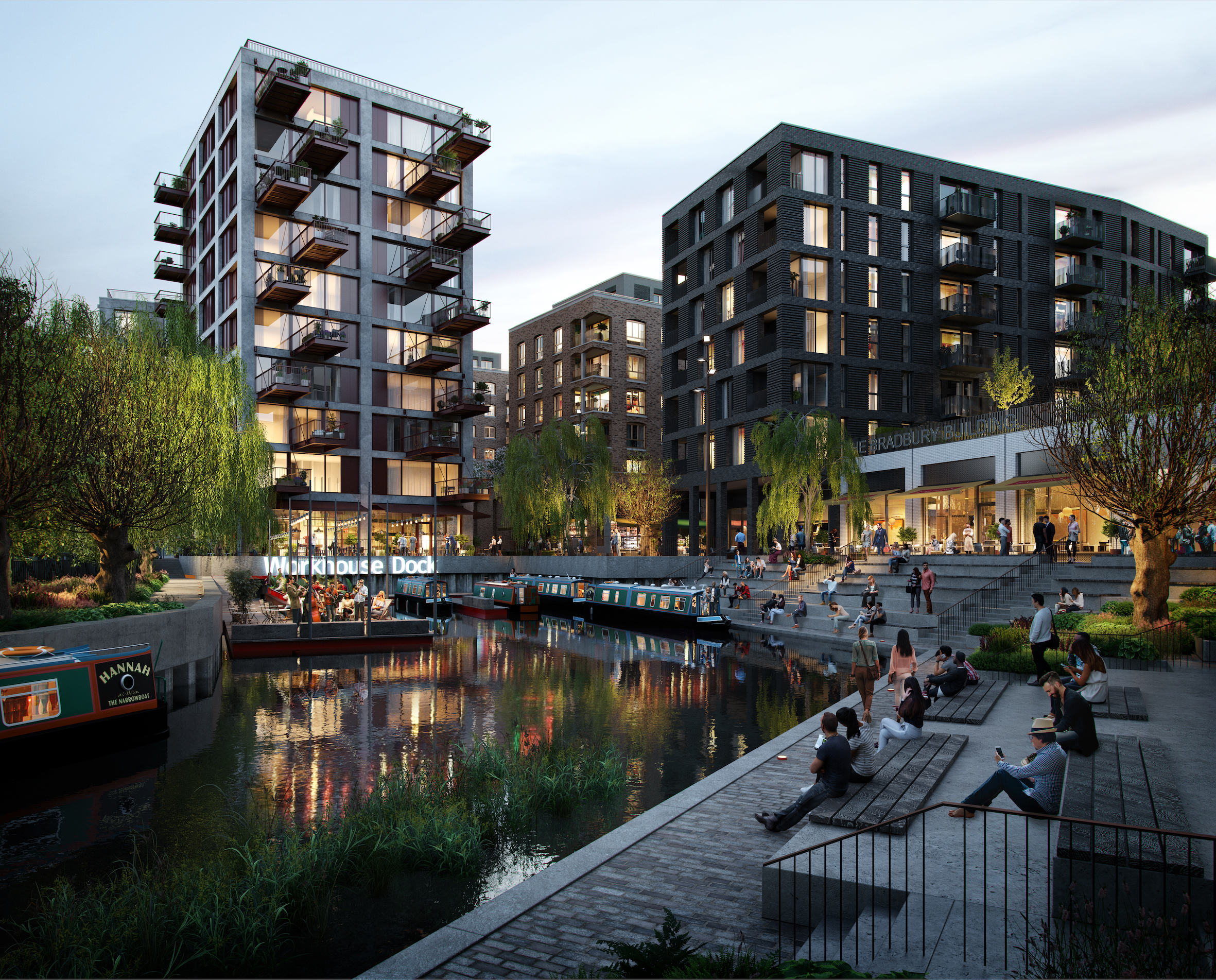
通過這樣的規劃,可以帶來豐厚的社會、經濟與環境的效益。讓我們以巴利摩西倫敦重建專案The Brentford Project為實例,來探討這一議題。
The Brentford Project囊括了高街與布倫特河之間的11.8英畝的土地,在開發前兩者之間存在著巨大的間隔。我們開發計畫的核心是將兩者重新連接起來,但如果僅僅建造幾座大樓是無法填充這些空間的。我們規劃通過步行街和大面積的河畔公共領域的建設,將高街、住宅樓,與河畔有機地連為一體,使社區在步行範圍內就可以達到購物與休閒的目的,並為居民創造了更多社區內的互動機會。
為當地居民提供休閒與聚集的空間是非常重要的,這些步行可以抵達的社區公共空間,可以培養居民的社區意識,有助於社區的繁榮。
事實證明,該專案真正振興了這一地區,這個開發專案也包含了15分鐘城市的所有要素。The Brentford Project開發專案已經成為老爺車經銷商Duke of London,以及深受歡迎的餐館Santa Maria Pizzeria的家園。未來的零售商家將包括50多家新店、精品店、餐館和娛樂場所。
The Brentford Project開發專案的一層將提供日常的便利設施,包括廣受歡迎的Sam's Larder等餐館,市場領先的零售商、麵包店、雜貨店、肉店等傳統商店以及大型連鎖超市 Morrison's。通向河畔的步行街和庭院專為當地獨立零售商、工匠和手工藝者而設計的,這些店鋪為居民和當地人提供盡可能多的便民服務。不僅如此,居民還可以使用一系列貼心的公共設施,包括共用辦公空間、游泳池、高規格的健身房和健身工作室,還有豐富的私人和公共室外活動空間。
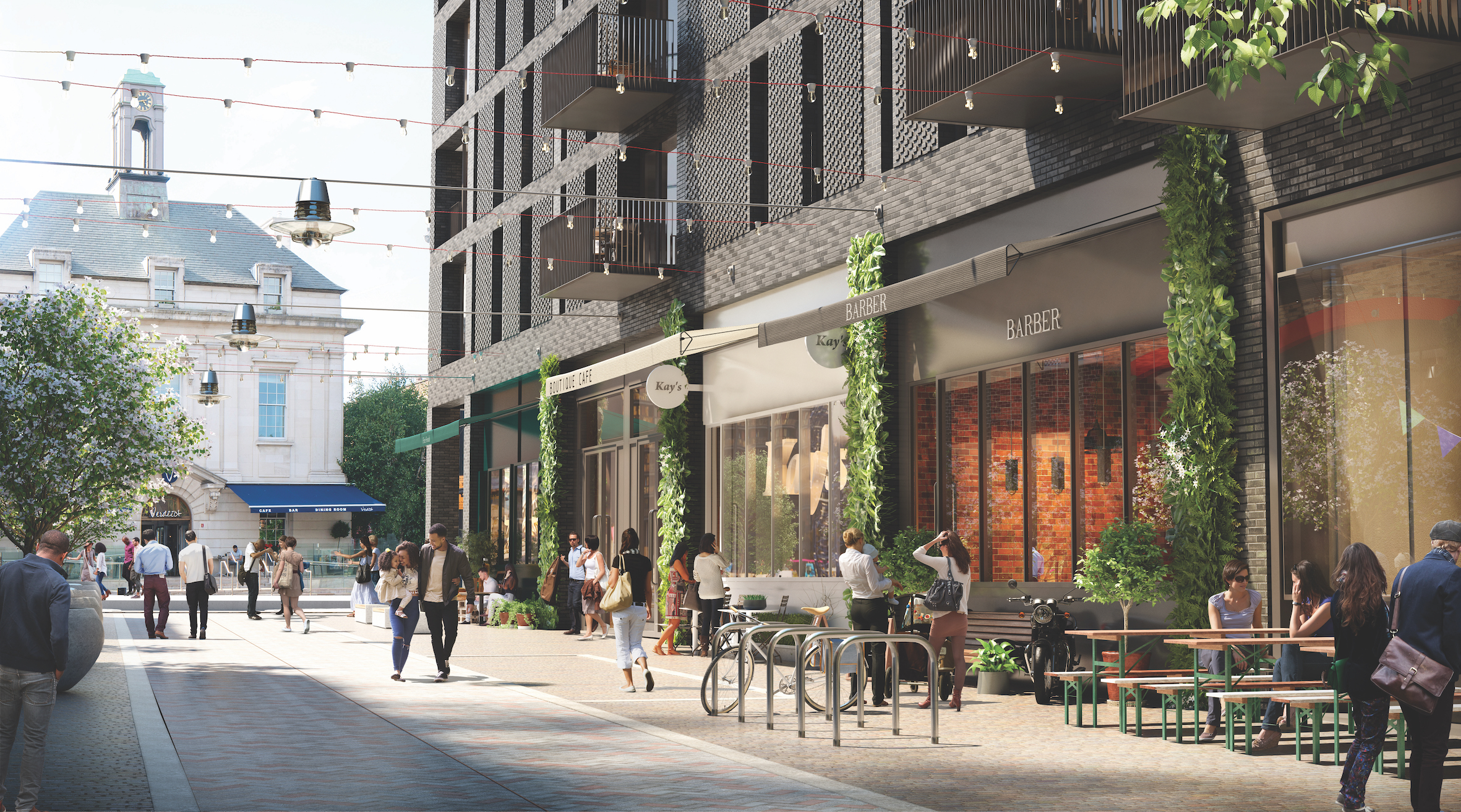
通過隨處可見的綠地環境可以提高人們的健康水準,在家門口就能享受到便利的生活設施可以節省居民的時間,又可以提升居民的身體素質,還可以加強居民間的互助與包容,這些都是我們現代生活環境應該擁有的。當然,這一原則並不是在所有地方都適用,事實上,總會有人需要在較遠的地方工作,但15分鐘城市圈的重要元素幾乎可以在所有地方應用。
在後疫情時代的生活背景下,採用15分鐘城市圈的開發模式,將開發專案重點放在可步行和社區便利這一著眼點上——就像The Brentford Project開發專案這樣,會使開發專案更具吸引力。這是創造更幸福、更健康和更可持續居住場所的必然途徑。
Related Articles
15分钟城市圈的案例
15分钟城市圈并不是一个新的概念。但最近几周,它却陷入了一场相当大的争议之中。
一个聪明而以人为本的城市规划模式,旨在通过15分钟步行或骑行距离便可解决众多的日常需求,因早前牛津的交通过滤计划的实施,遇到一些反对声音,导致“15分钟城市圈”这一理念成为一个阴谋论的说法,甚至在英国下议院的讨论中也出现了这种论调。
然而,在目前的争论中人们似乎忽略了它当初进入主流视线的原因。为什么在大型开发项目或探讨现有城镇和城市中心改建时,开发商、城市规划师和建筑师都非常关注这一重要议题。
Covid-19的大流行促使人们对社区的需求和期待有所变化,其中包括商品齐全的商业街、充裕的绿地和完备的社区便民设施。
对于我们这些负责创建社区环境的人来说,我们需要倾听。15分钟城市圈似乎很自然地成为我们实现这一目标的最佳答案。
那么,在城市重建背景下,我们应该如何看待 15 分钟城市圈呢?作为一个起点,成功的步行街区必须是真正多功能的,这也是 15 分钟城市圈四大支柱(邻近性、多样性、密度和普遍性)的基础。

通过这样的规划,可以带来丰厚的社会、经济与环境的效益。让我们以巴利摩西伦敦重建项目The Brentford Project为实例,来探讨这一议题。
The Brentford Project囊括了高街与布伦特河之间的11.8英亩的土地,在开发前两者之间存在着巨大的间隔。我们开发计划的核心是将两者重新连接起来,但如果仅仅建造几座大楼是无法填充这些空间的。我们规划通过步行街和大面积的河畔公共领域的建设,将高街、住宅楼,与河畔有机地连为一体,使社区在步行范围内就可以达到购物与休闲的目的,并为居民创造了更多社区内的互动机会。
为当地居民提供休闲与聚集的空间是非常重要的,这些步行可以抵达的社区公共空间,可以培养居民的社区意识,有助于社区的繁荣。
事实证明,该项目真正振兴了这一地区,这个开发项目也包含了15分钟城市的所有要素。The Brentford Project开发项目已经成为老爷车经销商Duke of London,以及深受欢迎的餐馆Santa Maria Pizzeria的家园。未来的零售商家将包括50多家新店、精品店、餐馆和娱乐场所。
The Brentford Project开发项目的一层将提供日常的便利设施,包括广受欢迎的Sam's Larder等餐馆,市场领先的零售商、面包店、杂货店、肉店等传统商店以及大型连锁超市 Morrison's。通向河畔的步行街和庭院专为当地独立零售商、工匠和手工艺者而设计的,这些店铺为居民和当地人提供尽可能多的便民服务。不仅如此,居民还可以使用一系列贴心的公共设施,包括共享办公空间、游泳池、高规格的健身房和健身工作室,还有丰富的私人和公共室外活动空间。

通过随处可见的绿地环境可以提高人们的健康水平,在家门口就能享受到便利的生活设施可以节省居民的时间,又可以提升居民的身体素质,还可以加强居民间的互助与包容,这些都是我们现代生活环境应该拥有的。当然,这一原则并不是在所有地方都适用,事实上,总会有人需要在较远的地方工作,但15分钟城市圈的重要元素几乎可以在所有地方应用。
在后疫情时代的生活背景下,采用15分钟城市圈的开发模式,将开发项目重点放在可步行和社区便利这一着眼点上——就像The Brentford Project开发项目这样,会使开发项目更具吸引力。这是创造更幸福、更健康和更可持续居住场所的必然途径。
Related Articles
巴利摩摘取2023《旗幟晚報》最佳新居獎
巴利摩的幸運島專案摘取本年度 《旗幟晚報》新居獎(Evening Standard New Homes Awards)中的 “最佳大型開發獎”(Best Large Development Award)。
該獎項彰顯了巴利摩在地區改造方面的突出實力。幸運島專案是建立在利茅斯半島(Leamouth Peninsula)上一片廢棄的工業用地之上,如今這裏已經是鳥語花香,處處生機勃勃,成為一個以住宅為中心的繁榮社區,這裏共有841套住宅,其中包括精心設計的公寓、豪華的頂層閣樓以及聯排別墅,幸運島臨水而居,所有住宅的四周環繞著設計考究的園林設計,景色壯觀而迷人壯觀。幸運島還毗鄰巴利摩另外的一個開發專案倫敦城市島社區,該社區已經成為東倫敦一個著名的充滿生機活力的文化中心。
談到獲獎的感受,巴利摩總經理 John Mulryan 表示: “我們很高興幸運島獲得這一殊榮。該專案在倫敦東區的轉型重建專案中佔據著很關鍵位置,此次獲獎標誌著我們在該地區(包括倫敦城市島專案)的改建工程又成功地的登上了新的臺階。
“我們衷心感謝評委們對該專案的肯定,並向所有其他獲獎開發商表示祝賀。
在本次獲獎之前不到一年的時間裏,幸運島已經連續摘取了業界權威機構頒發的三項榮譽大獎,其中有《星期日泰晤士報》的英國住宅獎、What House的金獎和倫敦建築規劃獎中的最佳新居住地獎。
欲瞭解更多幸運島開發專案的資訊,請點擊此處。
Related Articles
巴利摩摘取2023《旗帜晚报》最佳新居奖
巴利摩的幸运岛项目摘取本年度 《旗帜晚报》新居奖(Evening Standard New Homes Awards)中的 “最佳大型开发奖”(Best Large Development Award)。
该奖项彰显了巴利摩在地区改造方面的突出实力。幸运岛项目是建立在利茅斯半岛(Leamouth Peninsula)上一片废弃的工业用地之上,如今这里已经是鸟语花香,处处生机勃勃,成为一个以住宅为中心的繁荣社区,这里共有841套住宅,其中包括精心设计的公寓、豪华的顶层阁楼以及联排别墅,幸运岛临水而居,所有住宅的四周环绕着设计考究的园林设计,景色壮观而迷人壮观。幸运岛还毗邻巴利摩另外的一个开发项目伦敦城市岛社区,该社区已经成为东伦敦一个著名的充满生机活力的文化中心。
谈到获奖的感受,巴利摩总经理 John Mulryan 表示: “我们很高兴幸运岛获得这一殊荣。该项目在伦敦东区的转型重建项目中占据着很关键位置,此次获奖标志着我们在该地区(包括伦敦城市岛项目)的改建工程又成功地的登上了新的台阶。
“我们衷心感谢评委们对该项目的肯定,并向所有其他获奖开发商表示祝贺。
在本次获奖之前不到一年的时间里,幸运岛已经连续摘取了业界权威机构颁发的三项荣誉大奖,其中有《星期日泰晤士报》的英国住宅奖、What House的金奖和伦敦建筑规划奖中的最佳新居住地奖。
欲了解更多幸运岛开发项目的信息,请点击此处。
Related Articles
Sean Mulryan在愛爾蘭著名頒獎典禮上榮獲”卓越非凡”稱號
Kildare商業頒獎典禮的夜晚豪華而熱烈,這個高規格的黑領帶晚宴吸引著嘉賓身著盛裝來到基拉希酒店(Kilashee Hotel)。巴利摩公司創始人、董事長兼首席執行官Sean Mulryan在晚宴上被授予了一個高規格的獎項,以表彰他在愛爾蘭商業做出的傑出貢獻。
當晚的最高潮最精彩的一幕是萬眾矚目的頒獎典禮,Sean Mulryan榮獲最高大獎。頒獎嘉賓在臺上談到他工作影響力時表示,Sean Mulryan的成就不僅僅是在Kildare,而是在整個愛爾蘭和英國,他說:“巴利摩是愛爾蘭和英國最重要、最成功的房地產開發公司之一",他還補充道:"Sean Mulryan的前瞻性決定與他的雄心壯志為巴利摩帶來了巨大的成功,Sean Mulryan一次又一次地展現出他的睿智,堪稱非凡。
“他具有遠見卓識,在倫敦泰晤士河畔購置的土地,將美國大使館吸引搬遷於此,這個位於巴特西旁邊的使館花園社區成為倫敦新的地標。 而位於泰晤士河上游的倫敦城市島專案為英國國家芭蕾舞團建造了新家,該建築現被命名為Mulryan舞蹈中心,這裏與他1994年在金絲雀碼頭的第一個專案僅咫尺之遙。
“在愛爾蘭,他在利菲河畔的碼頭區打造了Dublin Landings多功能社區。此外,他還在都柏林完成了其他重要專案,包括The White Water shopping centre、Royal Canal Park、Sea Gardens以及位於歷史悠久的自由區的健力士街區重建專案。
“在他事業突飛猛進的這些年裏,無論他在哪里從事開發專案,他都心系自己的故鄉——Kildare。他在Kildare郡內,監督建造了4,000 套住宅,另有3,000 套正在建設中。他和妻子Bernadine在這裏養育他們的五個孩子,我很高興一些孩子今晚也來參加了慶典。”
“Sean的愛好非常廣泛,他是文化、教育和體育事業的支持者,尤其是對愛爾蘭蓋爾運動協會(GAA)的支持和他對賽馬的情有獨鐘的表現也是眾所周知的,他僅在Kildare賽馬場就贏得了許多項冠軍。 他還以慷慨大方著稱,今年的商業傑出貢獻獎授予Sean是當之無愧的。
今晚的儀式象徵著王者歸來,巴利摩由Sean於1982年在Kildare的Ballymore Eustace鎮創立。在此後的四十年裏,該公司在英國創造了超過20,000 套住宅,在愛爾蘭創造了 15,000 套住宅,並開發了超過500萬平方英尺的辦公和零售空間。
Sean在獲獎感言時表示: “我很高興能獲得這一殊榮。Kildare對我、對我們的家庭、對我們的企業都是美好的開端,並延續至今,僅此一點,我就感激不盡。
“頒發這個獎項給我,不僅僅是對我個人的表彰,也是對這些年裏幫助我的所有人的褒獎。巴利摩能夠走到今天是我們集團每個員工辛勤努力的結果。包括我的妻子Bernadine,我的孩子與同事,以及我的商業夥伴、同行以及我所有的客戶。
“這是一個非常愉快的夜晚,也是一個見證Kildare所有偉大成就的時刻:讓我們共同祝願Kildare郡繼續取得成功,祝福所有在這裏生活的人們美滿幸福。”
在此瞭解有關Kildare商業獎的更多資訊。
Related Articles
Sean Mulryan在爱尔兰著名颁奖典礼上荣获”卓越非凡”称号
Kildare商业颁奖典礼的夜晚豪华而热烈,这个高规格的黑领带晚宴吸引着嘉宾身着盛装来到基拉希酒店(Kilashee Hotel)。巴利摩公司创始人、董事长兼首席执行官Sean Mulryan在晚宴上被授予了一个高规格的奖项,以表彰他在爱尔兰商业做出的杰出贡献。
当晚的最高潮最精彩的一幕是万众瞩目的颁奖典礼,Sean Mulryan荣获最高大奖。颁奖嘉宾在台上谈到他工作影响力时表示,Sean Mulryan的成就不仅仅是在Kildare,而是在整个爱尔兰和英国,他说:“巴利摩是爱尔兰和英国最重要、最成功的房地产开发公司之一",他还补充道:"Sean Mulryan的前瞻性决定与他的雄心壮志为巴利摩带来了巨大的成功,Sean Mulryan一次又一次地展现出他的睿智,堪称非凡。
“他具有远见卓识,在伦敦泰晤士河畔购置的土地,将美国大使馆吸引搬迁于此,这个位于巴特西旁边的使馆花园社区成为伦敦新的地标。 而位于泰晤士河上游的伦敦城市岛项目为英国国家芭蕾舞团建造了新家,该建筑现被命名为Mulryan舞蹈中心,这里与他1994年在金丝雀码头的第一个项目仅咫尺之遥。
“在爱尔兰,他在利菲河畔的码头区打造了Dublin Landings多功能社区。此外,他还在都柏林完成了其他重要项目,包括The White Water shopping centre、Royal Canal Park、Sea Gardens以及位于历史悠久的自由区的健力士街区重建项目。
“在他事业突飞猛进的这些年里,无论他在哪里从事开发项目,他都心系自己的故乡——Kildare。他在Kildare郡内,监督建造了4,000 套住宅,另有3,000 套正在建设中。他和妻子Bernadine在这里养育他们的五个孩子,我很高兴一些孩子今晚也来参加了庆典。”
“Sean的爱好非常广泛,他是文化、教育和体育事业的支持者,尤其是对爱尔兰盖尔运动协会(GAA)的支持和他对赛马的情有独钟的表现也是众所周知的,他仅在Kildare赛马场就赢得了许多项冠军。 他还以慷慨大方著称,今年的商业杰出贡献奖授予Sean是当之无愧的。
今晚的仪式象征着王者归来,巴利摩由Sean于1982年在Kildare的Ballymore Eustace镇创立。在此后的四十年里,该公司在英国创造了超过20,000 套住宅,在爱尔兰创造了 15,000 套住宅,并开发了超过500万平方英尺的办公和零售空间。
Sean在获奖感言时表示: “我很高兴能获得这一殊荣。Kildare对我、对我们的家庭、对我们的企业都是美好的开端,并延续至今,仅此一点,我就感激不尽。
“颁发这个奖项给我,不仅仅是对我个人的表彰,也是对这些年里帮助我的所有人的褒奖。巴利摩能够走到今天是我们集团每个员工辛勤努力的结果。包括我的妻子Bernadine,我的孩子与同事,以及我的商业伙伴、同行以及我所有的客户。
“这是一个非常愉快的夜晚,也是一个见证Kildare所有伟大成就的时刻:让我们共同祝愿Kildare郡继续取得成功,祝福所有在这里生活的人们美满幸福。”
在此了解有关Kildare商业奖的更多信息。
Related Articles
巴利摩在 2023 What House? 頒獎禮上摘得銀獎
一年一度的 What House? 頒獎典禮本於2023年11月17日在倫敦舉行,巴利摩榮獲了兩項大獎: 最佳豪華開發專案與最佳多功能開發獎。
位於金絲雀碼頭的華殿大廈由兩座塔樓組成,共有 767 套公寓,該專案被授予最佳豪華開發專案銀獎,這是評委對綠盛世與巴利摩(EcoWorld Ballymore) 將植被的親和力這一理念完美地融入到設計之中,也是對其在樓房密集的建築環境下引入大自然的綠意給予的褒獎。
評委們在頒獎典禮上給予高度評價,他們表示:"傳統意義上,金絲雀碼頭對商業的需求要高於對自然的需求,但該房產採用的是自然色彩和有機材料",評委們還補充道: "將綠色植物融入到生活空間,令居民身心受益,讓整個開發專案在各類植物的點綴下顯得生機勃勃"。
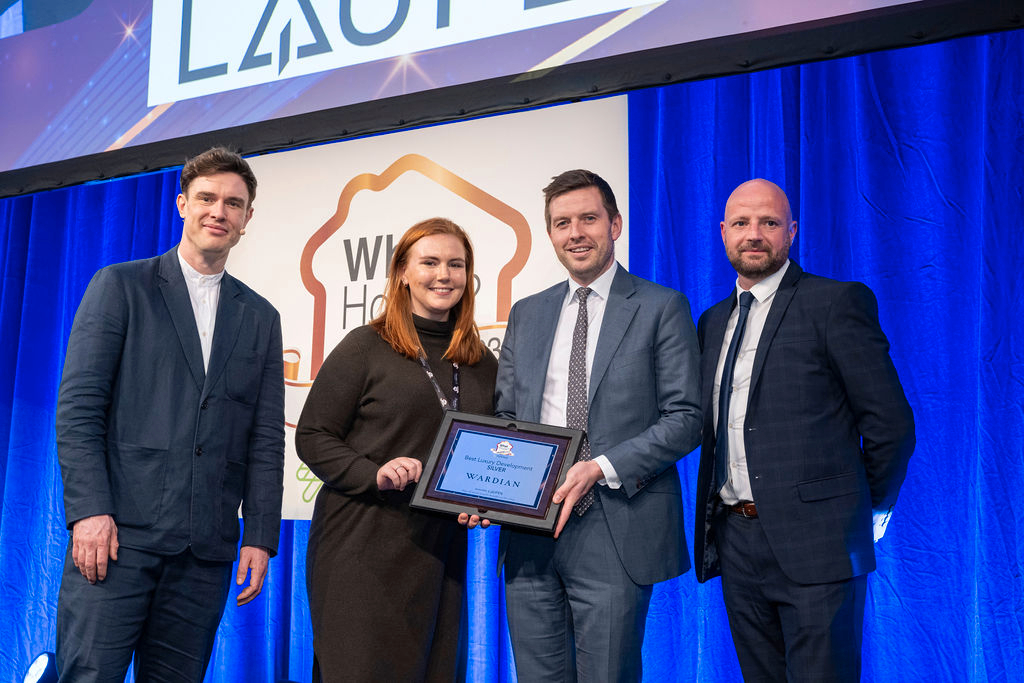
綠盛世與巴利摩(EcoWorld Ballymore)合作的位於倫敦九榆樹重建區的使館花園(Embassy Gardens) 社區也在頒獎典禮上也受到了表彰。評委們表示,他們注意到該地區已 "轉變為一個繁榮的社區",擁有種類繁多的便民設施,其中使用率很高的健身房、及聯合辦公空間和獨特的空中游泳池——一個懸掛在兩棟大樓之間、高達35米的空中泳池。
評委們還表示,為World Heart Beat Music Academy學院提供的設施給他們留下了 "深刻的印象"。這個慈善機構也把使館花園(Embassy Gardens)稱作是自己的家園。
頒獎儀式結束後,巴利摩總經理John Mulryan表示:“我們非常感謝What House?評委對我們獲獎物業的溢美之詞。我們在華殿和使館花園都投入了獨特的創新設計,力圖將首都的住宅標準推向一個新的高度。評委們的評價反映了我們的努力是有成效的,能夠獲得業內的多項褒獎,我們倍感欣慰。”
幾天前,巴利摩創始人、董事長兼首席執行官Sean Mulryan剛剛被授予愛爾蘭商業傑出貢獻獎。評委們對Sean Mulryan的工作讚賞有加,稱 "他是愛爾蘭和英國最重要、最成功的房地產開發公司之一"。
點擊此處查看更多巴利摩最近獲得的獎項。
Related Articles
巴利摩在 2023 What House? 颁奖礼上摘得银奖
一年一度的 What House? 颁奖典礼本于2023年11月17日在伦敦举行,巴利摩荣获了两项大奖: 最佳豪华开发项目与最佳多功能开发奖。
位于金丝雀码头的华殿大厦由两座塔楼组成,共有 767 套公寓,该项目被授予最佳豪华开发项目银奖,这是评委对绿盛世与巴利摩(EcoWorld Ballymore) 将植被的亲和力这一理念完美地融入到设计之中,也是对其在楼房密集的建筑环境下引入大自然的绿意给予的褒奖。
评委们在颁奖典礼上给予高度评价,他们表示:"传统意义上,金丝雀码头对商业的需求要高于对自然的需求,但该房产采用的是自然色彩和有机材料",评委们还补充道: "将绿色植物融入到生活空间,令居民身心受益,让整个开发项目在各类植物的点缀下显得生机勃勃"。

绿盛世与巴利摩(EcoWorld Ballymore)合作的位于伦敦九榆树重建区的使馆花园(Embassy Gardens) 社区也在颁奖典礼上也受到了表彰。评委们表示,他们注意到该地区已 "转变为一个繁荣的社区",拥有种类繁多的便民设施,其中使用率很高的健身房、及联合办公空间和独特的空中游泳池——一个悬挂在两栋大楼之间、高达35米的空中泳池。
评委们还表示,为World Heart Beat Music Academy学院提供的设施给他们留下了 "深刻的印象"。这个慈善机构也把使馆花园(Embassy Gardens)称作是自己的家园。
颁奖仪式结束后,巴利摩总经理John Mulryan表示:“我们非常感谢What House?评委对我们获奖物业的溢美之词。我们在华殿和使馆花园都投入了独特的创新设计,力图将首都的住宅标准推向一个新的高度。评委们的评价反映了我们的努力是有成效的,能够获得业内的多项褒奖,我们倍感欣慰。”
几天前,巴利摩创始人、董事长兼首席执行官Sean Mulryan刚刚被授予爱尔兰商业杰出贡献奖。评委们对Sean Mulryan的工作赞赏有加,称 "他是爱尔兰和英国最重要、最成功的房地产开发公司之一"。
点击此处查看更多巴利摩最近获得的奖项。
Related Articles
Everyman落户布伦特福德开发项目 打造休闲胜地
我们很高兴地宣布,豪华品牌电影院Everyman将进驻布伦特福德开发项目的3 West Bradbury Yard,成为我们这个以休闲为重点社区的又一亮点。位于伦敦西部的布伦特福德开发项目是一个以住宅为主导的120万平方英尺的河畔社区。以高端影院而著称的Everyman综合休闲娱乐中心坐落在开发项目的核心地段,从布伦特福德高街抵达娱乐中心非常便捷。这个占地10,973 平方英尺的休闲娱乐中心将为社区提供Everyman所有高端的休闲与娱乐服务。
Everyman的发言人表示:“我们很高兴能够成为布伦特福德开发项目的休闲胜地。巴利摩房地产开发公司的愿景是打造一个集零售、休闲以及便民服务为一体的繁荣社区理念,与我们Everyman的理念非常契合。我们期待Everyman的高端休闲服务为布伦特福德的民众带来福祉。”
巴利摩的高级开发经理Richard Pearce补充道:“Everyman入驻布伦特福德项目的核心地带,符合我们为社区和游客提供全天候服务这一理念。该品牌与巴利摩以及其他即将入驻品牌完美融合,在社区里成为一道独具特色的零售、餐饮与娱乐的休闲风景线。Everyman的入驻让我们向完美社区的愿景又迈近了一步,也成为我们这个河畔社区建设关键要素。”
此前,独立礼品店Mother Rugger的入驻让社区内充满温馨的氛围,该店位于Bradshaw Yard,占地1,116平方英尺,于去年12月开业。此外,在未来几个月还将有新的品牌餐饮店精彩亮相,其中包括著名的手工面包店GAIL's,以及在《厨艺大师:职业选手》大赛荣获季军的选手Elena Frattura与双胞胎妹妹Emily共同创办的全日餐饮店Rottura。
布伦特福德开发项目致力于改造布伦特福德镇高街南半部的11.8英亩的土地,通过一系列的建设,用步行小巷将高街与布伦特河完美衔接。 除876套全新公寓外,该开发项目还设有餐饮、娱乐、购物和休闲等配套设施,以及超过5英亩的园林景观和公共区域。让两个旧日的码头重焕生机,成为社区娱乐休闲中心,为伦敦西部居民和观光游客带来一道靓丽的休闲景观。
Related Articles
Everyman落戶布倫特福德開發專案 打造休閒勝地
我們很高興地宣佈,豪華品牌電影院Everyman將進駐布倫特福德開發專案的3 West Bradbury Yard,成為我們這個以休閒為重點社區的又一亮點。位於倫敦西部的布倫特福德開發專案是一個以住宅為主導的120萬平方英尺的河畔社區。以高端影院而著稱的Everyman綜合休閒娛樂中心坐落在開發專案的核心地段,從布倫特福德高街抵達娛樂中心非常便捷。這個占地10,973 平方英尺的休閒娛樂中心將為社區提供Everyman所有高端的休閒與娛樂服務。
Everyman的發言人表示:“我們很高興能夠成為布倫特福德開發專案的休閒勝地。巴利摩房地產開發公司的願景是打造一個集零售、休閒以及便民服務為一體的繁榮社區理念,與我們Everyman的理念非常契合。我們期待Everyman的高端休閒服務為布倫特福德的民眾帶來福祉。”
巴利摩的高級開發經理Richard Pearce補充道:“Everyman入駐布倫特福德專案的核心地帶,符合我們為社區和遊客提供全天候服務這一理念。該品牌與巴利摩以及其他即將入駐品牌完美融合,在社區裏成為一道獨具特色的零售、餐飲與娛樂的休閒風景線。Everyman的入駐讓我們向完美社區的願景又邁近了一步,也成為我們這個河畔社區建設關鍵要素。”
此前,獨立禮品店Mother Rugger的入駐讓社區內充滿溫馨的氛圍,該店位於Bradshaw Yard,占地1,116平方英尺,於去年12月開業。此外,在未來幾個月還將有新的品牌餐飲店精彩亮相,其中包括著名的手工麵包店GAIL's,以及在《廚藝大師:職業選手》大賽榮獲季軍的選手Elena Frattura與雙胞胎妹妹Emily共同創辦的全日餐飲店Rottura。
布倫特福德開發專案致力於改造布倫特福德鎮高街南半部的11.8英畝的土地,通過一系列的建設,用步行小巷將高街與布倫特河完美銜接。 除876套全新公寓外,該開發專案還設有餐飲、娛樂、購物和休閒等配套設施,以及超過5英畝的園林景觀和公共區域。讓兩個舊日的碼頭重煥生機,成為社區娛樂休閒中心,為倫敦西部居民和觀光遊客帶來一道靚麗的休閒景觀。
Related Articles
“Bray is such a charming place”
We asked local Dublin artist and creator, Homebound, to design two bespoke pieces of art for our contemporary new homes at Sea Gardens in Bray. Here he tells us how he went about capturing the nostalgia and charm of this beautiful seaside location, and how his childhood connection to Bray led the way.

One of Homebound's creations; a picture now on display in the Sea Gardens' show home
“Bray evokes the feeling of going back to more innocent times”
I’ve always loved Bray, it’s played an important part in my family over the years, so it was a real honour to be asked to do the thing I love the most - create art, for such a well-respected company such as Ballymore in this place which holds such sentiment for me. My family and I are based in Dublin, but I fondly remember my mam telling me how her family used to make the long trek over to Bray for their holidays back in the 60’s - it’s a full circle moment to be there in a professional capacity now!
Bray is such a charming place, I remember as a child gravitating towards the little huts on the Promenade and finding them an enchanting part of the landscape - it was a natural focus for these commissions, as they just represent everything I love about the place. It’s the small details around Bray that really draws me to it - the railings, the atmosphere - it’s these elements that evoke the feeling of going back to more innocent and less demanding times, reminiscent of my childhood. I prefer to stick to a simple style in my work, with an emphasis on adding interesting flourishes to draw the viewer in, whilst working with a subtle colour pallet. This worked perfectly for these pieces, the simplicity of the designs feels in alignment with the nostalgia Bray ignites in me.
I've been painting and drawing since a very young age, it’s always been the way I like to express myself, so doing it as a job is living the dream. I was producing large abstract canvases earlier in my career which led to being featured in a few solo and group exhibitions around Dublin and London over the years. My work has evolved considerably since then with a focus on digital artworks now rather than paintings using oils. I create a vast mix of work as my interests lie anywhere between music, literature, the history of Dublin and beyond - whatever inspires me at the time!
‘A perfect partnership’
I was delighted when Ballymore asked me to represent them with my work, anything that helps to bring my work to a wider audience is much appreciated. They were very gracious with their request as well, giving me free rein to create an artwork that compliments the Bray landscape whilst leaving the rest to me - no better request for a creative! I didn’t feel limited or tied down to doing anything specific, I could just encapsulate what Bray meant to me with integrity, in pieces I hope others will love too.
It was a privilege to be chosen to create these pieces for Ballymore, I’m incredibly grateful for the support they’ve shown me in my career, enabling me to make a life out of doing what I love. There’s nothing more rewarding than that, long may it continue!
You can buy Homebound Prints online and in store at Jam Art Factory - two independent shops in Dublin.
Related Articles
“We’ve been supported by Ballymore every step of the way”
If you’re passing through our Goodluck Hope development in London, you may smell the unmistakable smell of freshly baked bread courtesy of our newest tenants, Layers Bakery. The brainchild of professional chefs Faye Weatherburn and Giulia Agnoli, and entrepreneur Chelsea Finch, a formidable trio who have created a wholesome place for the community to enjoy their exquisite, baked on site, collection of baked goods. Here we chat to Faye, straight off the back of an incredibly successful launch weekend.
It’s been quite a week! Since our opening we’ve been completely overwhelmed. It’s been busier than we could have hoped for! On our opening day, I was literally in the back preparing croissants on a loop - everything we put out went, and we just kept replacing it as quickly as possible! It’s been a long time coming - myself and Giuila worked together a few years ago and the seed was planted to create our own bakery when the company we both worked for shut down.
Community Spirit
In what now seems like a perfect order of events, Chelsea, who was one of our customers, approached us, asking when we were going to set up - and that she would support us by continuing to use us to supply her five businesses. She has been integral in supporting our entire operation, providing us with valuable expertise in setting up the coffee shop side of our business, something integral to our vision of bringing the local community together. We both feel quite strongly that as a coffee shop we have a fundamental duty to the community to provide a lovely place for them to socialise, and that’s what Layers has become.
Even before we opened we popped a sign on the door inviting passersby to pop in and have a chat so we could get to know the locals, that was really nice and we had many visitors who have now become customers, it’s very much the relaxed and friendly vibe we wanted.

The finer details
Working with Ballymore has been nothing but positive, we’ve been supported by them every step of the way. We were fully involved with every design decision in our space, down to where the plug sockets were placed, it really was tailor made to suit our business. We both have experience of working in specialised kitchens - Guila at Dinner by Heston and Fallow, and me as a Pastry Chef at the Ritz so we know how important it is to have the right setup.
Being in this location is incredible, we love the heritage, and the dry dock, it’s such a characterful space and the huge windows and industrial ceiling in our bakery fit perfectly with the vibe of our terracotta and coral terrazzo. Originally we’d planned something much smaller so this has exceeded all expectations, but as soon as we saw it we knew it was for us; we visited every week as it was being built so we feel like we’ve been integral to its fruition.
Mission led
A huge motivator for us was to responsibly get rid of waste having been horrified at the amount of waste we’d previously experienced. We now make marmite out of leftover bread and carefully tailor our menu around what we have available to minimise any leftovers. We are also passionate about sourcing premium produce from local suppliers. Our flour comes from our regenerative farmer, Wildfarmed Flour, and all our dairy products come from The Estate Dairy who also provide us with pastry butter which we used to have to get from France. Everything we sell is baked on site by our own fair hands - Guilia is on the night shift at the moment so it’s a 24 hour operation!
All in all, it’s been an amazing first week, we can’t wait to evolve and welcome more visitors as we continue to develop our offerings, we’re excited about what’s to come.
To keep up to date with Layers, follow them on Instagram.
Related Articles
Ballymore Renews Commitment to Gaelic Football at Dublin City University
Ballymore, renowned for its steadfast support of community groups and grassroots organisations in Ireland, has reaffirmed its support of Gaelic football at Dublin City University (DCU) for the 2023/24 academic year, having supported the men’s and women’s football teams since 2021/22.
DCU Dóchas Éireann, is the largest university Gaelic games club in Ireland, with 800 members representing DCU across 28 men’s and women’s football, camogie and hurling teams.
Ballymore's partnership with DCU underscores the company's dedication to fostering sports development in Ireland, aligning with its broader commitment to community and social investment. By supporting DCU, Ballymore aims to empower the university in its mission to transform lives and societies, helping DCU’s elite student athletes with cutting-edge facilities that enable them to combine the highest standards of sporting performance and academic achievement.

Linda Mulryan is deputy managing director for Ballymore in Ireland said: “Ballymore is committed to investing in initiatives that catalyse positive societal impacts and cultivate the communities where we provide homes.
"We firmly believe that sports are fundamental to society, fostering a sense of belonging within communities while significantly improving overall health and wellbeing, so I am thrilled to renew our partnership with DCU for 2024.
"DCU’s emphasis on talent development through its sports scholarship programme perfectly aligns with our overarching mission to effect positive transformations in Ireland, and we are proud to stand in support.”
Prof Dáire Keogh, President of Dublin City University stated: “We welcome Ballymore’s renewed commitment to Gaelic football at DCU. Our ongoing partnership has enabled significant investment in the development of our talented student athletes and has ensured that our men’s and women’s teams have the support they need to excel, both on and off the pitch. We look forward to building on this success in the year to come.”
Jason Sherlock, Director of Development with DCU Educational Trust concluded: “At DCU Educational Trust, we are proud to build strong partnerships that advance DCU’s mission to transform lives and societies. Our collaboration with leading organisations like Ballymore enables us to drive societal change and to enable talent to excel, including through our sports scholarship programme which enables high performing student-athletes to excel in sport and in life.”
Related Articles
207 affordable homes complete at Riverscape in Newham
Ballymore and Oxley celebrate the completion of 207 new high quality affordable homes at Riverscape in the Royal Docks.
The completion of these two new apartment buildings – called East River Wharf - mark a pivotal milestone at Riverscape and the occasion was marked by a handover ceremony hosted by Ballymore & Oxley with Homes England and Legal & General Affordable Homes. Joined by Cllr James Asser, Deputy Mayor at the London Borough of Newham, and local councillors Cllr Shaban Mohammed and Cllr John Whitworth.
Located directly on the River Thames in the heart of one of London’s most exciting regenerations, East River Wharf offers a collection of 1, 2 and 3 bedroom Shared Ownership apartments as well as affordable rent and social rent properties.The affordable homes are among the first homes to be completed at Riverscape, a 769 home development designed by Howells Architects.
East River Wharf forms part of the wider Royal Wharf master plan, which in total will deliver over 4,154 homes, 3,893 of which have already been completed. Royal Wharf is a thriving and dynamic new ‘London village’ community, complete with a RIBA award-winning primary school, a modern community centre, a busy high street with 120,000 sq ft commercial space, a new park, and a beloved riverside pub
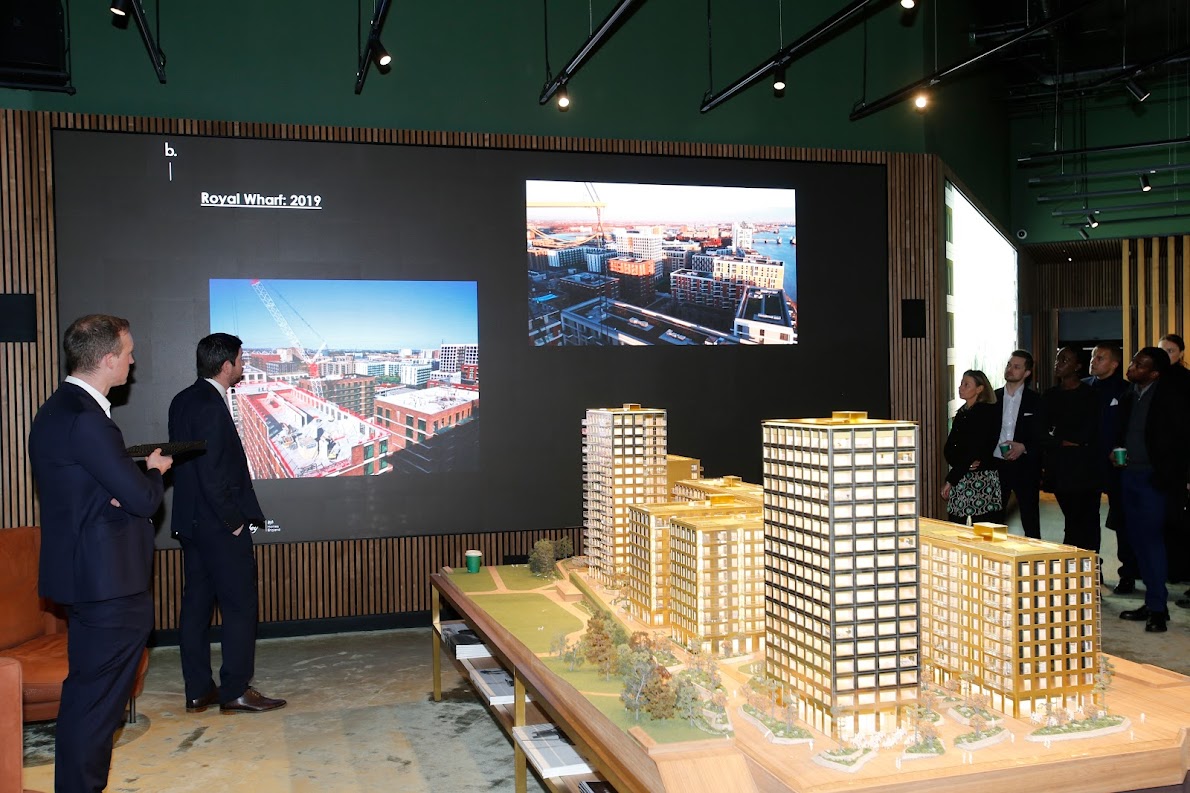
The homes at Royal Wharf are well connected to central London via the DLR, at Pontoon Road and West Silvertown, and by water thanks to the Thames Clippers service at the Royal Wharf Pier – completed by Ballymore & Oxley in November 2019. The community is flanked by Thames Barrier Park to the east and Lyle Park to the west, which this year celebrates the centenary of being gifted to the community by Abram Lyle (of Lyle’s Golden Syrup) in 1924.
Ben Denton, Chief Executive at Legal & General Affordable Homes, said:
“We are delighted to be working closely with Ballymore and Oxley to bring more affordable housing to London, particularly in Newham. Ballymore with Oxley is a great partnership delivering the regeneration of this important part of East London.
By celebrating the delivery of these affordable rented and Shared Ownership homes, we are making a small contribution towards addressing London’s crisis in homes that people can afford.
We look forward to working together with Ballymore and Oxley again in the future to create communities that our residents can thrive in.”
Nigel Barclay, Director of Loans at Homes England, said:
“It is exciting to see the new community at Riverscape taking shape with the completion of these new, quality affordable homes. With support from the Government’s Levelling Up Home Building Fund, Riverscape will rightly form an integral part of the wider Royal Docks site and go some way to address the housing need in Newham.”
John Mulryan, UK managing director, Ballymore:
“Royal Wharf is one of London’s great housing success stories. Over 40 acres of brownfield land has become home and a place of pride for over 10,000 people. We’re thrilled to be handing over the latest affordable homes to L&G today and look forward to welcoming their residents into this very special community.”
Related Articles
“It’s the local creative and artistic scene I was looking for”
With The Brentford Project fast becoming a thriving waterside destination, we caught up with one of our first residents, Sonia Jones, as it nears a year since she moved into her new home here.
A former music industry icon - renowned for nurturing talents like Rita Ora and sharing the stage with legendary acts including the Rolling Stones - Sonia embarked on the next chapter in her life when she moved to The Brentford Project.
Making the move from a large Chiswick home in search of a more exciting and creative neighbourhood, here, Sonia shares her favourite things about life at The Brentford Project.
"It's a one-stop destination for all my daily needs, with the local creative and artistic scene I was looking for.”
It’s coming up to a year since I moved here from Chiswick and I couldn’t be happier with how well I’ve settled in. For me, the appeal of The Brentford project lies in its ability to offer me a beautiful fresh and contemporary space to live, with access to everything I could possibly need right on my doorstep. I can be in the heart of the action in a moment, stepping outside to vibrant surroundings full of people, restaurants and shops. Likewise I can look out of my window and take in the abundant views of the trees and nearby parks, providing an instant connection to nature and bringing the outside in. It offers a rare and perfect harmony of urban and peaceful living.
The move was motivated by a need to be surrounded by likeminded people, I want to immerse myself within a creative and vibrant setting, and thankfully, The Brentford project ticks all of those boxes. Not only is my apartment a wonderful space to be, but the neighbourhood is fast becoming a community within itself, it’s an exciting time to be here, and this is just the beginning!
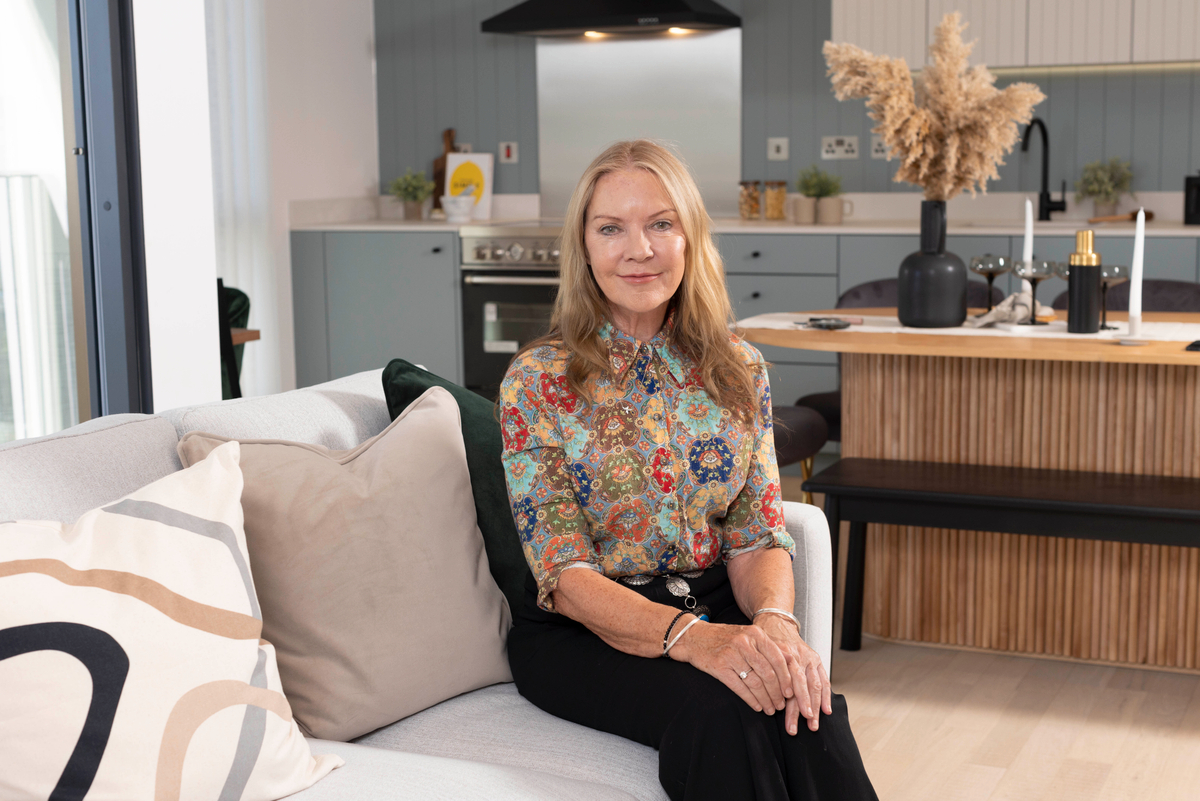
Inspiring views
There’s so much to appreciate, not least the vista of the London skyline as well as the calming, ever changing views of the water which I can lose hours watching. Having bountiful green views in London is a real treat, and it’s that, fused with the waterside location which brings the magic to my home.
Syon Park and Kew Gardens are nearby, offering me a tranquil escape from the city's hustle and bustle. Such convenient accessibility, with all the amenities I need right here means I can live my life freely with nothing out of reach, that really is the greatest benefit of living here.
The standard of my apartment is amazing, it’s been designed with integrity, with real thought and consideration about how I would use the space, it flows in a way which harmonises with how I live, like it’s been tailor made just for me. The aesthetic is beautiful, I walk in and feel incredibly happy to be here. It’s flooded with natural light thanks to the 4 large patio doors, and the interior combines natural materials with contemporary design making it feel opulent and luxurious but also approachable and practical.
Bringing the wow factor
My apartment doesn't have a typical layout which was one of the things that appealed to me. It’s positioned over 2 floors with the 3 bedrooms downstairs and the living areas upstairs which is quite unusual and something which makes it feel even more special. The result is a spacious, light and open feel which I love, especially when I’m entertaining friends. The star of the show is the very generously sized terrace, accessed by the 4 sets of patio doors, it’s like my own private oasis, and it really brings the wow factor! The views are spectacular, it’s a wonderful spot to enjoy them from.
It’s hard to pick a highlight as the entire space has been so well considered, but I do absolutely love my bedroom. It’s a striking space complete with an ensuite and dressing room - every girl's dream! It feels stylish and lavish as well as being completely practical, it’s a place I can unwind and relax, and reset for the day ahead.
In short, I love living here. It’s contemporary and inspiring with everything I need but as importantly, it has real heart with local creativity and the thriving artistic scene I was looking for. It feels lively and exciting and coming home to my apartment is a joy, I know I’ll enjoy many many years here.
Related Articles
Everyman confirmed as leisure anchor at The Brentford Project
We are delighted to announce that we have signed luxury cinema concept, Everyman, for The Brentford Project, our new 1.2 million sq ft riverside community and residential-led development in Brentford, West London. Located in the heart of the scheme on 3 West Bradbury Yard, the new leisure-focused anchor tenant, Everyman, will be easily accessible from Brentford High Street. The 10,973 sq ft space will feature components of Everyman’s luxurious cinema offering.
A spokesperson at Everyman commented: “We are delighted to be joining the Brentford Project as the leisure anchor. Ballymore’s vision to create a thriving community, in which the retail and leisure offer serves both the residents and the wider area, reflects our own lifestyle approach. We are looking forward to bringing the Everyman experience to Brentford.”
Richard Pearce, Senior Development Manager at Ballymore, added: “The signing of Everyman at the heart of the Brentford Project matches our intention to provide a day-to-evening offer for our community and visitors alike. The brand is perfectly aligned to Ballymore and the other businesses opening at The Brentford Project, supporting and nurturing independent and unique retail and dining brands. Everyman brings us one step further to completing our long-term community vision and forms a key element to the final phases of the riverside development.”
The news follows an independent gift shop signing, Mother Rugger, a 1,116 sq ft space on Bradshaw Yard, which opened in December. In addition, new dining entrants will also be opening their doors in the coming months, including artisan bakery and coffee shop, GAIL’s and a debut for family-owned all-day dining concept, Rottura, co-founded by MasterChef: The Professionals quarter finalist Elena Frattura and her twin sister, Emily.
By transforming 11.8 acres along the southern half of the town’s High Street, The Brentford Project will reconnect the High Street with the waterfront via a series of pedestrianised yards. Alongside 876 new homes, the development will bring an eclectic mix of dining, entertainment, shopping and leisure amenities, and over five acres of landscaping and public realm. Two riverside docks will be revitalised and transformed into new leisure hubs, attracting visitors from West London and beyond.
Related Articles
Spreading seasonal cheer in London
The past few weeks have seen many successful Christmas events taking place across our London developments – from cocktail evenings and carol concerts to family-focused workshops and Christmas markets. Here we learn more about the celebrations that have kicked off the festive season across our neighbourhoods.

Festive singing at Goodluck Hope
Christmas came early for our London team this year. It was the first weekend in December in fact when we descended on Goodluck Hope on the Leamouth Peninsula to host an all-day Christmas-themed community celebration – the first of a month of festive celebrations.
Wrapping up from the cold, our visitors embraced the wintry weather to make the most of a whole host of activities including gingerbread house decorating workshops with Layers Bakery - a new offering soon opening at Goodluck Hope. The event allowed the Layers’ team to showcase its business to the community by running a number of groups to take part in the edible, festive fun.
Families and Frozen fans also enjoyed two afternoon screenings of the Disney classic in the Cinema, whilst London Docklands Singers performed classic carols from the Dry Dock as visitors were treated to complimentary mulled wine and mince pies from another new commercial tenant, Taylor’s of Goodluck Hope. The celebrations provided entertainment for the community and the opportunity for neighbours to gather together on their doorstep, with all ticket proceeds donated to local homelessness charity, Your Place (Caritas Anchor House).

A special screening of Frozen
A few days later saw Embassy Gardens pull out all the stops for a special Christmas carol concert in partnership with our resident and inspiring local charity, World Heart Beat. As an important part of our community here, the concert provided a unique opportunity to showcase this world-class facility and hub for culture, which we’re always proud to celebrate as home to some of the world’s leading music talent.
Taking place within the charity’s dedicated concert hall at Embassy Gardens, the carol concert boasted an impressive line-up of World Heart Beat’s performers. Ranging from community choir groups to bands, instrumentalists, and musical talent, it created an incredibly unique Christmas atmosphere as visitors enjoyed the music along with a festive tipple and delicious mince pies. The ticket proceeds were donated to homelessness charity Bags of Taste with matched donation from Embassy Gardens.
Meanwhile at our luxury development in Canary Wharf, residents and guests of the team at Wardian enjoyed drinks and canapes overlooking the London skyline views from The Observatory, whilst expert gift-wrappers added that special touch to their Christmas gifts.

Local children sing at World Heart Beat at Embassy Gardens
Our fourth event was held by our team at Riverscape, who welcomed customers, new residents, and the local community to a relaxed, warming ‘Carols & Cocktails’ evening reception. Guests escaped the cold and windy December weather to celebrate Christmas with festive cocktails and canapes, whilst live carol performances by The Noelles set the informal tone and enabled guests to mingle with their neighbours and find out more about life at Riverscape.
Lastly, we hosted a large Christmas market at The Brentford Project in partnership with local community group Brentford Voice, with activity taking place along Bradshaw Yard and Market Place on Brentford High Street. Thousands of people gathered to enjoy food and drink – including from the area’s newest offering Sam’s Waterside and upcoming new restaurant Rottura, as well as Christmas gifting stalls alongside live music and local choir performances.

Singers at The Brentford Project
Reflecting on the success of this year’s Christmas calendar, Ballymore’s Brian De’ath, Managing Director for Sales and Marketing said: “Ballymore creates places with a soul, thriving neighbourhoods in which everyone can live, work and play. These festivities are testament to that, bringing everyone together with a range of vibrant events that celebrate the best of each community.
“A big thank you to everyone for their involvement and Christmas spirit to make each event so successful.”
Related Articles
Expanding the menu at Goodluck Hope in London
The first of two new businesses at Goodluck Hope, Ballymore’s new island development on Leamouth Peninsula in London, has opened its doors today.
Purveyors of the finest seasonal fruit and vegetables, ethical and organic grocer Taylor’s of Goodluck Hope will serve the island community everything from luxury, handpicked delicacies to cupboard essentials for every day. Having firmly established themselves at Maltby Street Market, Taylor’s of Goodluck Hope will have an in-store deli, offering a quiet sanctuary for savouring and enjoying fine food, while its wine-bar will create a lively social hub at the heart of the neighbourhood, where friends can gather, and occasions can be celebrated.
Guests can expect delicious small plates and relaxed dishes, showcasing seasonal produce with a “farm shop-to-table” ethos. Each day, the Chef will prepare a bespoke fresh meal that Goodluck Hope residents and locals can enjoy - eventually these meals will be available for ‘click and collect’ for the ultimate tasty, healthy and easy dinner at home.
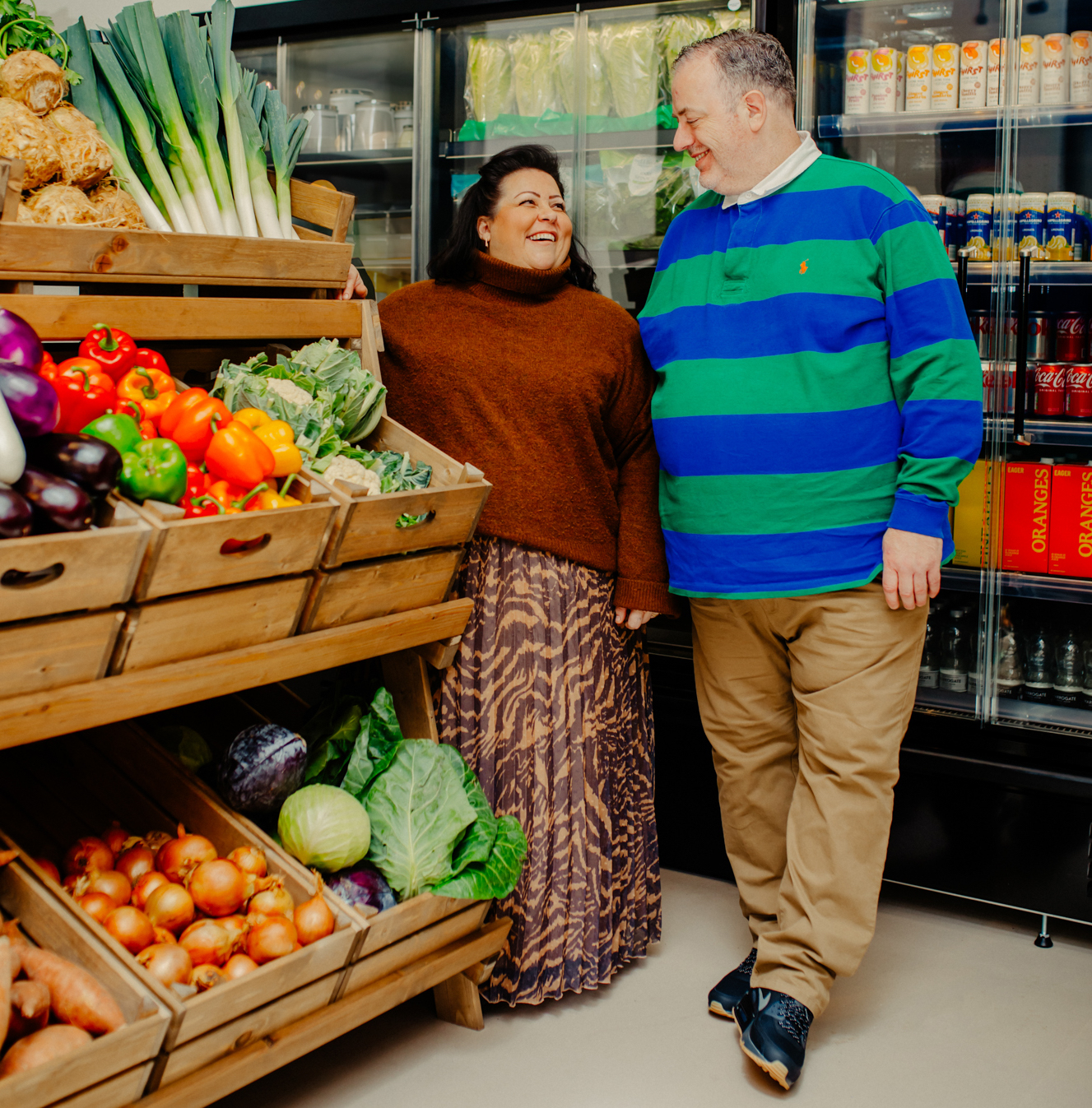
The store will also use minimal packaging, with free refill stations for many grocery items to help shoppers reduce waste. Regular events, such as talks to tastings with artisan food and drink suppliers, will entertain and educate locals, and bring the community together over a love of food.
Just next door, wholesale bakery and coffee shop Layers is set to open later this month, offering delicious goods every day from 8am, including freshly baked sourdough goods, delicious coffees, grab-and-go breakfasts as well as a very seasonal all-day brunch menu from the cafe. They will also host a rolling programme of events and educational workshops.
Founded by Chelsea, Giulia and Faye, who have years of industry experience in hospitality, retail, coffee, baked goods, and food, Layers is both creative and fun whilst expressing individuality and attracting its 'people' through culture and authenticity. The store will be family friendly, with pets welcome too.
Goodluck Hope is the industrial-inspired riverside development of 841 new homes on Leamouth Peninsula, creating an island neighbourhood of new homes, creative hubs and independent businesses. Inspired by its rich maritime heritage and cultural history, Goodluck Hope is conveniently located close to finance and commercial hub Canary Wharf and London City Airport via Canning Town station on the Jubilee Line, and yet remains secluded from the rush of the city, offering a uniquely tranquil waterfront lifestyle in this part of the capital.
Keith Taylor, founder of Taylor’s at Goodluck Hope, said: “We instantly loved the feel of Goodluck Hope when we first visited. The Dry Dock being right at the centre of the community excited us so much that we couldn't say no! Since the announcement of our shop opening, we have been inundated with messages from residents welcoming and engaging with us, cementing that sense of community we felt. We cannot wait to open and start greeting people in both our store and bar.”
Faye Weatherburn, co-founder of Layers, said: “I fell in love with this location from the very first time we came to visit, back in May 2022. There was still construction taking place and yet, we went in and looked at each other and said, 'Yes, I think this is it.' There is something about the view of the O2, being so close to the water, and the history of the location that just makes it all magical. We look forward to opening and serving the new community at Goodluck Hope.”
James Boyce, Associate Regional Sales Director at Ballymore, said: “We are delighted to welcome Taylor’s of Goodluck Hope and Layers Bakery to our island community.
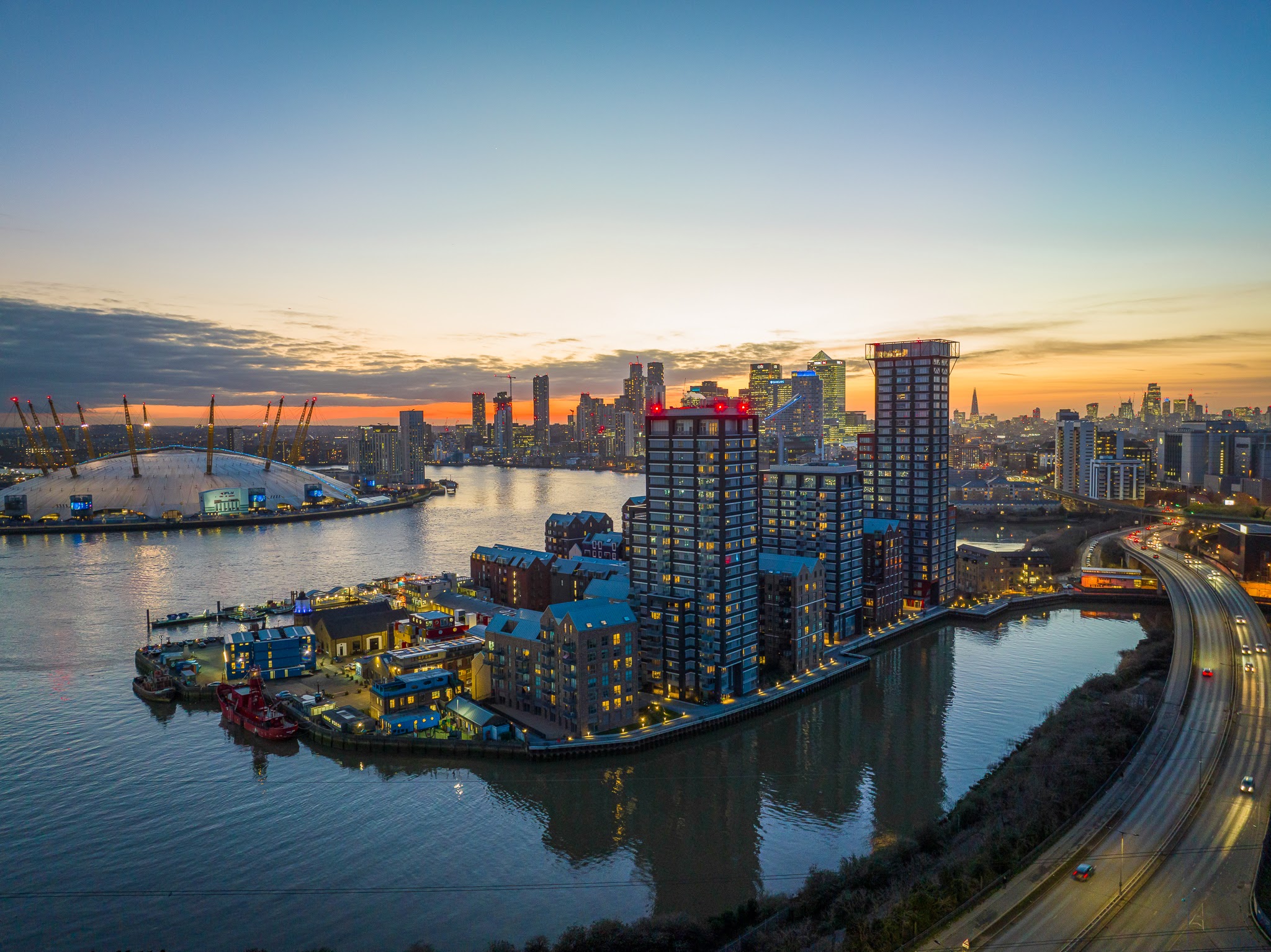
The island is already home to a number of thriving independent businesses, and the arrival of an exciting new destination bakery and a premium, ethical grocer, deli and wine bar will bring the best food, drink and atmosphere right to the doorstep of our residents, offering ultimate convenience. They join the neighbouring cocktail bars, coffee shops, galleries and culture hubs just a few minutes away on City Island, completing our island story.”
Both stores can be found at Orchard Dry Dock, Orchard Place, London E14 0JW. Taylor’s of Goodluck Hope is now open, with Layers Bakery opening later this month. Layers Bakery will be open daily from 8am and Taylor’s of Goodluck Hope grocery is open from 8am to 8pm Tuesday to Saturday and 9am to 7pm on Sundays.
For enquiries about living at Goodluck Hope, please click here, email sales@goodluckhope.com or call 0203 944 1825.
Related Articles
Supporting the artists of the future as they help tackle climate change
This autumn, we partnered with The Grantham Institute at Imperial College London, to help raise awareness of climate change through the work of four budding young artists – including one whose work is now on display in Nine Elms.
The initiative was part of the biennial Grantham Climate Art Prize which invited young people, who will be most affected by climate change, to create bold designs for outdoor public murals focused on the solutions needed to tackle the climate crisis.
The work of four budding young artists has gone on display in locations across the UK this month – including in Nine Elms, close to Ballymore’s Embassy Gardens neighbourhood.
The 2023 Grantham Climate Art Prize celebrates young artists, whose work was judged by a stellar panel of representatives from The Grantham Institute, programme sponsors- Octopus Energy and the Turner Contemporary.
Among the winners was 11-year-old Samuel Web whose depiction of a kingfisher flying from a trashed and polluted world to a cleaner, greener and more sustainable future has been painted as a mural in Coventry. Janet Aloa, age 17 from Rochdale created a piece entitled Use Your Voice aimed at empowering young people to speak up to those in power and demand action to tackle climate change. It is now painted as a mural in West Norwood, in South London, while 19-year-old Ria Hoondle’s Team Green – a depiction of people working to preserve nature and rectify damage caused to our environment, is now on display in Glasgow.
It is however a runner up Aarayn Prabhaker’s Colours for the Climate piece that caught the attention of Ballymore. The striking artwork – an additional project for 2023 which was sponsored by Ballymore – embraces the Grantham Climate Art Prize theme, showing a range of fruit and vegetables with protest placards calling for people to eat more plant-based foods and less meat and dairy in order that we can live more sustainably. Aaryan’s design has now been transformed into a 19.5-metre long mural close to Embassy Gardens. It has been brought to life by artists Karla Rosales Garcia and Roger Rigol. And speaking of it Karla said. “This is such an important project raising awareness of climate issues in a unique and creative way. It was a challenging project taking 2 weeks to complete, but we prepared thoroughly and I’m really excited by the result, plus the reaction from passersby has been incredible - cars stop and beep in appreciation and people come and ask questions about it - so it’s doing what it’s supposed to do - encourage conversation and raise awareness.”
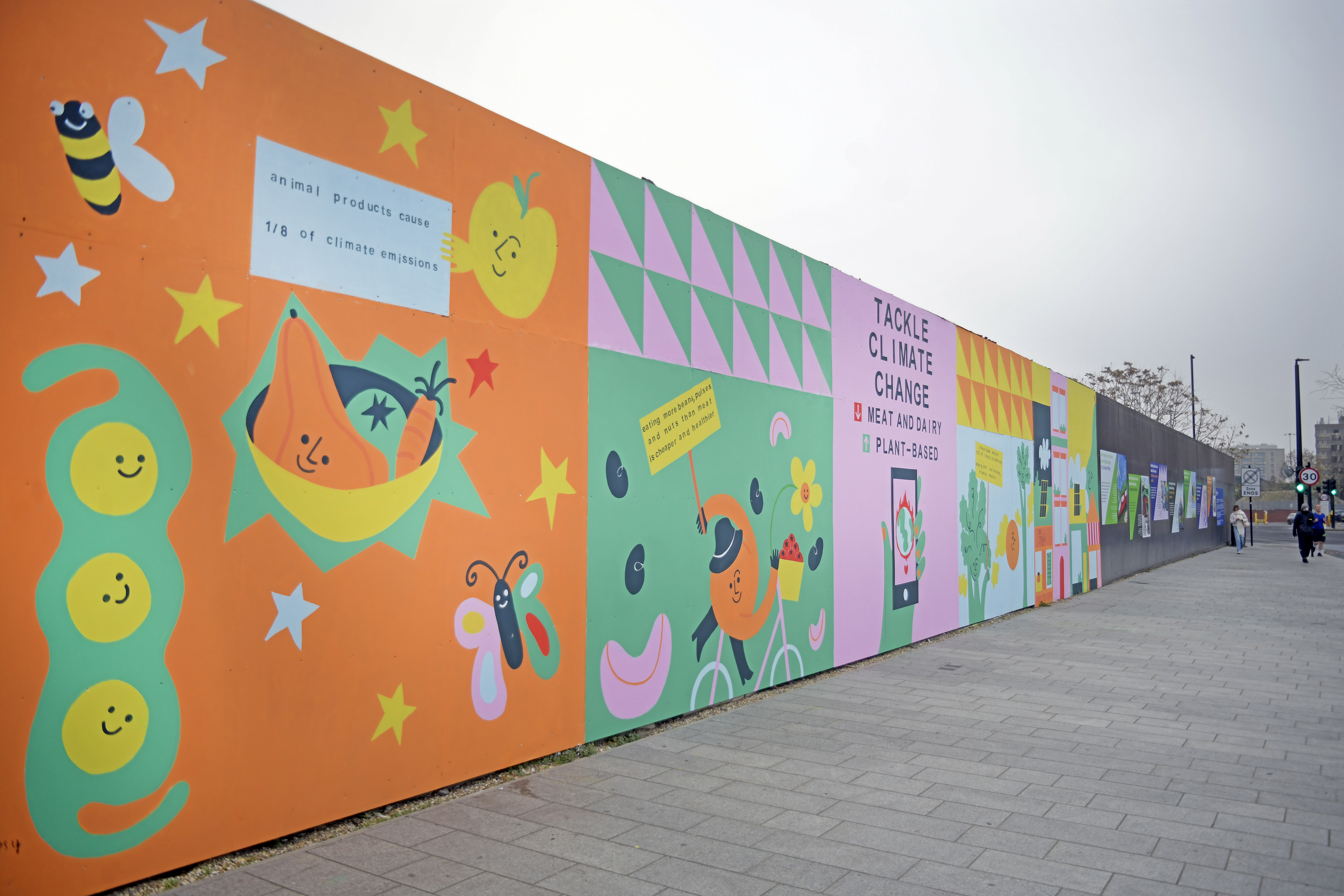
The completed mural.
Speaking of his original design, 12-year-old Aaryan told us he had spent a lot of time designing the mural, working on it for “hours at a time over a three-week period”, adding: “I was inspired by my sister, Alekhya who is 10 and an excellent artist. I wanted to raise awareness with my art to help the world tackle global warming and cut down on our carbon footprint, I can’t wait to see it in real life now it’s finished, it will be really exciting.”
Commenting on her son’s achievement, Aaryan’s mum Shalini Varma said: “Aaryan has always been very creative and especially loves sketches, portraits and abstract art so he was incredibly keen to create this piece. He spent such a long time over the summer designing the mural I was overwhelmed with pride and joy when I received the email telling us Ballymore had chosen it.”

Aaryan, from Barnet in north London, with local artists Karla Rosales Garcia and Roger Rigol who have brought his concept to life.
Concluded Linsey Wynton Grantham Climate Art Prize Project Manager at Imperial College London: “We are delighted to have partnered with Ballymore, with their strong sustainability credentials and shared vision for a better future. Not only have Ballymore sponsored this striking mural, but an exhibition highlighting our popular ‘Nine things you can do about climate change’ campaign illustrated by artwork from winners, runners up and shortlisted entries to this year’s art prize.
“Such a broad mix of people will pass the mural and exhibition each day – from business people, to politicians, to residents – we’re giving them a bold reminder about climate change and some beautiful pieces of art to call their own.”
Related Articles
Ballymore honoured at the 2023 What House? Awards in London
The annual What House? Awards took place in London this weekend with Ballymore recognised in two categories: Best Luxury Development and Best Mixed-Use Development.
Wardian, a development of 767-apartments across two towers in Canary Wharf, was awarded the Silver Award for Best Luxury Development – recognition of EcoWorld Ballymore’s emphasis on biophilia at the scheme and a celebration of its efforts in introducing nature to a dense built environment.
Speaking at the ceremony, judges said: “Canary Wharf traditionally shouts business louder than nature, but this scheme is about natural colours and organic materials”, adding that the company had “drawn on the recognised physical and mental benefits of incorporating greenery into living spaces, and the development is alive with different species of plants throughout”.

Embassy Gardens, EcoWorld Ballymore’s neighbourhood in the Nine Elms regeneration area of London was also celebrated at the ceremony. Judges noted the area had been “transformed into a thriving neighbourhood” with a “wide range” of amenities including the “gym, well-used co-working space” and the “unique” sky pool – a swimming pool which stands 35 metres in the air, suspended between two buildings at the scheme. Judges also said they were “impressed” with the facilities provided to the World Heart Beat Music Academy, a charity which also calls Embassy Gardens home.
Speaking after the ceremony, Ballymore managing director John Mulryan said: “We are grateful for the What House? judges for their kind words about our neighbourhoods in London.
“At both Wardian and Embassy Gardens we have invested in innovative design, trying to push boundaries in the capital’s residential offering. The judges’ remarks reflect our efforts, and we are delighted to be in receipt of more awards from our industry peers.”
The awards come just days after Ballymore founder, Chairman and Chief Executive Sean Mulryan was presented with an Outstanding Contribution to Business Award in Ireland. Judges celebrated Sean’s work, saying "he is one of the most significant and indeed successful property development companies in Ireland and the UK”.
See more of Ballymore’s recent awards here.
Related Articles
“Remarkable” Sean Mulryan is honoured at prestigious Irish awards ceremony
Sean Mulryan, founder, Chairman and Chief Executive of Ballymore has been presented with a prestigious award, honouring his outstanding contribution to business in Ireland.
The Kildare Business Awards were a night of celebration, welcoming guests and dignitaries from across the county to the Kilashee Hotel for a formal black-tie event and dinner.
The pinnacle of the night was the much-anticipated awards ceremony, with Sean’s accolade presented at the end of the evening. Taking to the stage, the awards presenter talked of the impact of Ballymore’s work – not just in Kildare, but across Ireland and England, saying that Ballymore "is one of the most significant and indeed successful property development companies in Ireland and the UK”, adding: “The vision and ambition Sean has displayed time and time again is nothing short of remarkable.
“His foresight for acquiring sites in London along the Thames was enough to attract the US Embassy to move to its new London location next to Battersea at Embassy Gardens. Further up the river, he created the new home for the English National Ballet now named the Mulryan Centre for Dance at London City Island, not far from where his first London project took shape at Canary Wharf in 1994.
“Back here in Ireland, he created the wonderful mixed-use quarter at Dublin Landings in the Docklands along the Liffey. And it would be remiss not to mention other significant projects in Dublin including The White Water shopping centre, Royal Canal Park, Sea Gardens and last but certainly not least, the Guinness Quarter redevelopment in the historic Liberties.
“Throughout this time, and no matter where his development projects take him, he has never lost his strong links with Kildare. In this county alone, he has overseen the construction of 4,000 homes with another 3,000 in the pipeline. He and his wife Bernadine have raised their family of five children here, and I am delighted to add some of whom are here in attendance this evening.
“Sean is a champion of culture, education and sport, particularly the GAA and his passion for horseracing is well known with many winners secured at Kildare racecourses alone. He is known for his enormous generosity, and it is entirely fitting that this year’s award for Outstanding Contribution to Business Award goes to Sean.”
The ceremony marked a homecoming for Ballymore; the company was founded by Sean in the Kildare town of Ballymore Eustace in 1982. In the four decades since, the company has gone on to create more than 20,000 homes in the UK, 15,000 homes in Ireland and has developed more than five million square feet of office and retail space.
Reflecting on his achievements Sean said: “I am delighted to accept this prestigious award. Kildare has been very good to me, to our family, and to the business – and for that alone I give my deep and heartfelt appreciation.
“This award though is about much more than me and represents the many people who have helped us through the years – each of them contributing to making Ballymore the business it is today. That starts with Bernadine and our children and extends to business partners, contemporaries and indeed our customers.
“It has been a truly enjoyable evening and one which celebrated all that is great about Kildare; here’s to the continued future success of the county and all of us who live here.”
Find out more about the Kildare Business Awards here.
Related Articles
We commission street artist Solus to create his biggest ever work
Internationally renowned street artist Solus has an impressive portfolio of works. Now, having worked together briefly in 2022, Ballymore has commissioned Solus once again, this time to create a striking new mural at 8th Lock, the final phase of development at Ballymore’s Royal Canal Park in Dublin.
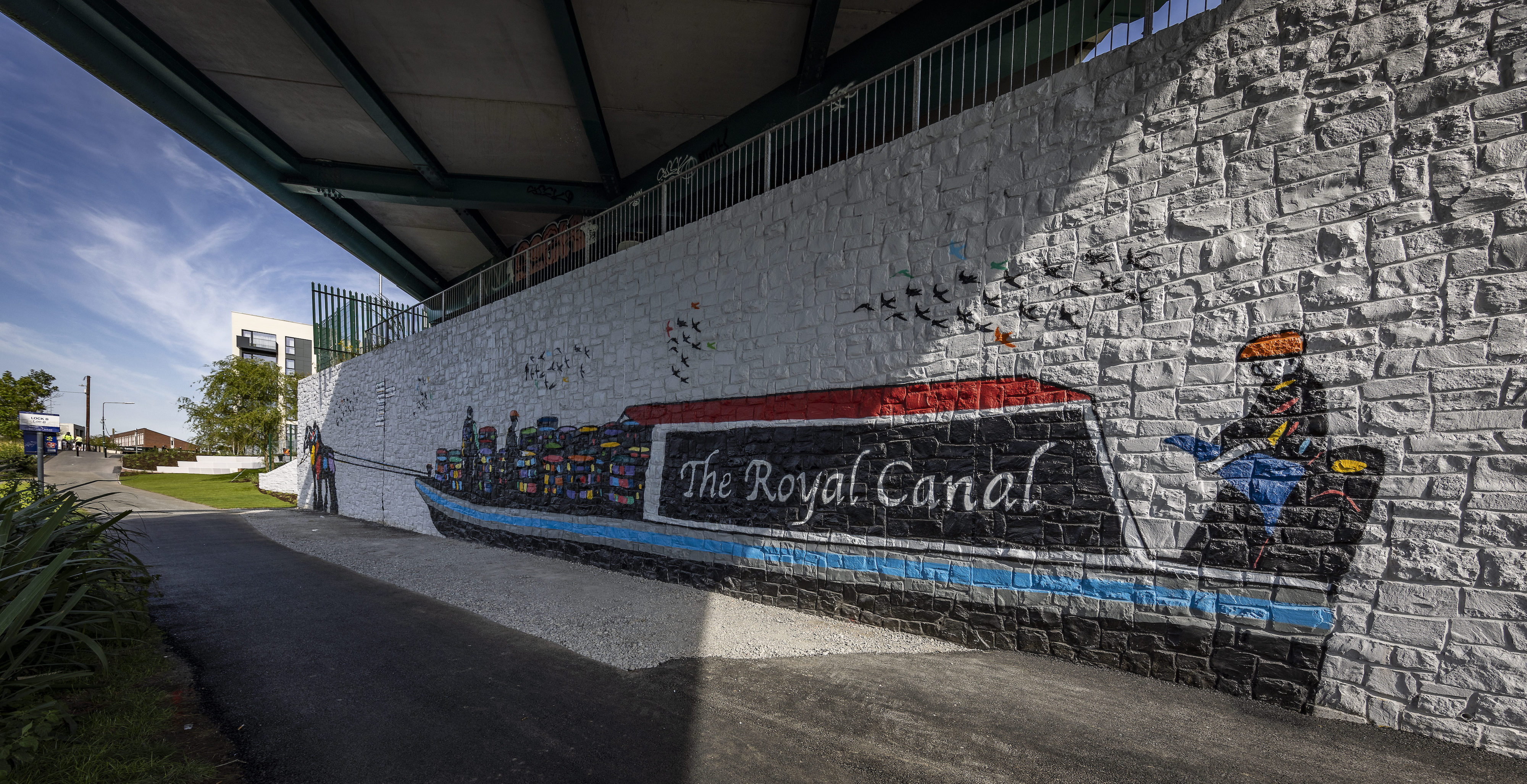
The new mural along the southern bank of the Royal Canal is the biggest artwork of Solus’ career. It adopts Solus’ inimitable style of silhouettes with pops of vibrant colours, with a scene showing the canal being used by people, dogs and horses. He explains: “It’s a joy to take on this site, and I was keen to create something that would serve as a tribute to the history of the canal and how it was used in the past to transport goods – that’s what we’ve done with this piece, captured a moment in time.
“I used spray paint to create a series of black silhouettes – then adding colours over the blacks; the colours are much more vibrant when they’re used in this way - it creates depth and enhances the colour”
The ambitious piece took a month to design, and a further two weeks to physically paint, with new features being added to the piece as it came to life. Solus continues: “To the right of the main piece we added signposts – each intended to offer directions to the canal bridges; given that the apartments at 8th Lock are named after the bridges it seemed a pertinent way to bring them together – and it makes the piece really site specific!”
The contemporary approach Solus used to create this vast piece of art makes it thoroughly modern while still paying homage to its canalside location. He adds: “I used black silhouettes with colours over the blacks; the colours are much more vibrant when they’re used in this way - it creates depth and enhances the colour”.
The scale and bold colour palette of the mural have created a joyous focal point that’s evoked a heartwarming reaction from residents and passers-by. Many have been inspired to share their own memories of the canal as Solus worked, with one man bringing old photos of the workers who built the original structure, and others complimenting the work as they passed.
Creating such a vast piece doesn’t come without complications, with Solus recounting the difficulties of working on the wall: “It’s not a flat surface, which is very difficult to work on, so I relied heavily on complementary colours to give detail and to make the mural visually appealing”. Solus is content with the completed mural, concluding happily that the original goal was achieved: “It’s an authentic nod to the history of the site, which creates a striking focal point for the community.”
Solus is a renowned Irish artist. In 2017 he served as National Trailblazer (Ambassador) for Culture Ireland, representing and promoting culture in Ireland, and in 2018 he was nominated as one of five Irish artists to receive the IrishCentral Creativity and Arts awards, honouring him for his work in the streets of New York.
Related Articles
Ballymore and Sainsbury’s joint venture submits plans for major new canalside neighbourhood in Ladbroke Grove
Over 2,500 new homes, two parks, restored canal basin and high street proposed for the Royal Borough of Kensington and Chelsea on brownfield site
- 2,519 new homes, with a mix of sizes and types including at least 500 affordable homes.
- Proposed development will create 2,000 permanent long-term jobs and an estimated £37 million annual boost to the local economy.
- Green and open spaces, including new public parks, play areas and a restored canal basin.
- A new high street with local shops and places to work, including a new modern and more spacious Sainsbury’s store and café.
- Upgraded transport on Ladbroke Grove with an improved junction and new bus stops, as well as better links to the canalside path.
- A community hub for everyone to enjoy, with spaces for businesses, charities and community groups to flourish in affordable workspace.
- The planning application has been submitted following three years of close consultation with the local community and stakeholders.
Ballymore and Sainsbury’s have submitted a planning application for a major canalside neighbourhood in Ladbroke Grove. The proposed new neighbourhood has been designed to deliver 2,519 new homes, of which at least 500 will be affordable, plus two parks and a local high street with a reinstated, historic canal basin at its heart. Plans also include over 90,000 sq ft of high street shops, cafes and restaurants as well as a new Sainsbury’s Supermarket (130,000 sq ft) – with no day of trading to be lost between the transition from the current store to the new.
The proposed neighbourhood would deliver much-needed new homes for London on a brownfield site already allocated for development by RBKC and the GLA / Mayor of London. The 19-acre site is one of the largest remaining brownfield sites in RBKC, and a large proportion of the site has been closed off to the public for over 40 years as a former gasworks site. In addition to the current Sainsbury’s Ladbroke Grove Supermarket, the site has most recently been occupied by industrial uses, including a scrap metal processing facility and commercial storage.Bordering the Grand Union Canal to the north and railway tracks to the south, the site is part of the Kensal Canalside Opportunity Area, identified in the Mayor’s London Plan.
The masterplan, by FaulknerBrowns Architects, has been shaped over the last three years, in close consultationwith the local community, local councillors, planning officers and the GLA, to create a place that meets the area’s current and future needs. These contributions have been invaluable in guiding the design process. The architectural approach takes its inspiration from local Regency and Victorian design, as well as its setting close to Kensal Green Cemetery, the Grand Union Canal and the wider area’s rich cultural mix.
Two public parks and inclusive play spaces, designed by landscape architecture and design practice, Spacehub, form part of the proposals, as well as diverse natural habitats and interventions to support urban wildlife and biodiversity net gain. This includes grassland, woodland, wetland and canal basin habitats. In total, the neighbourhood will offer over 8.5 acres of high quality, publicly accessible open space.
Situated around 15 minutes’ walk from four tube stations (Kensal Green, Kensal Rise, Ladbroke Grove and Westbourne Park), the plans encourage sustainable travel with new bus stops, pedestrian links and cycle routes and improved access to the canalside path. In response to Transport for London’s focus on active travel and pedestrian and cyclist safety as a priority, signalised junctions will be introduced on Ladbroke Grove and Kensal Road.
A comprehensive sustainability strategy aims to maximise renewable generation and green infrastructure to produce zero emissions on site. Heating and cooling will be provided by air source heat pumps and the development will feature solar panels and sustainable urban drainage systems. The scheme has been based on sustainable design and construction practices, adopting circular economy principles by considering the lifecycle of materials and minimising waste.
John Mulryan, Group Managing Director, Ballymore, said:
“Kensal Canalside is one of the last remaining major brownfield sites to be developed in London and the largest in the Royal Borough of Kensington and Chelsea. The scale and location of the site – in one of London’s 48 Opportunity Areas – presents a real opportunity to create a thoughtfully designed, accessible and sustainable canalside neighbourhood with strong transport links.
“There are over 3,000 households on RBKC’s housing waiting list. Our proposals will make a positive and significant contribution towards reducing that figure. Kensal Canalside will provide a significant number of much-needed homes, plus a variety of retail spaces as well as open green spaces and a community leisure and amenity space that our residents and the local people can enjoy.”
Patrick Dunne, Group Property and Procurement Director, Sainsbury’s, adds:
“The development of the Kensal Canalside Opportunity Area will revitalise a key brownfield site in the Royal Borough of Kensington and Chelsea, delivering places for people to live, work, shop and relax, and providing a significant boost to the local economy.
“The plans will allow us to deliver a brand-new, state-of-the-art Sainsbury’s supermarket for the local community to enjoy, and we’re proud that we are providing continuity to our customers by keeping our existing store open until the new one arrives. The larger, more modern and more spacious superstore will stock a wider range of our great value, high-quality food and non-food products and will build on our track record of offering fantastic service to our customers in Ladbroke Grove.”
Ben Sykes, Partner at FaulknerBrowns Architects, said:
“The masterplan is inspired by its characterful setting, where Ladbroke Grove meets the sweeping Grand Union Canal and the open space at Kensal Green. In response, our design has been built around public spaces, including a restored canal basin, play spaces and adding gardens and groves to the borough, to create a series of smaller neighbourhoods with a rich mix of uses and a strong sense of personality and place.
“We are delighted to see the proposals submitted, after working with local residents, the local council, Ballymore, Sainsbury’s and the entire project team for almost four years, to research, design and develop the masterplan.”
The development will create a minimum of 2,000 permanent long-term jobs and provide a significant boost to the local economy, amounting to approximately £37 million annually. The scheme will also deliver funding for social infrastructure within the local community such as healthcare and schools. The Notting Hill Carnival, which launches from the site, will be preserved as a close and long-term partner, and plans to create a new family friendly Carnival experience are being explored.
If planning is successful, the 11-year construction programme is estimated to start in 2025. The first homes will be delivered in 2030, along with the new Sainsbury’s store and the neighbourhood centre around the restored canal basin.
Related Articles
Industry pulse: redefining the workplace
The city office sector is in a state of flux, as it continues to get to grips with the lasting impacts of the pandemic on working practices and market demand. But looking ahead, Ballymore’s creative director Roger Black highlights four ideas that are set to redefine the workplace at locations like our project Bishopsgate Goodsyard in Shoreditch (pictured above).
The much-trumpeted death of the office because everyone will now work from home is a falsehood. Work for many is certainly evolving with the aid of 21st century communication tools and the ease by which one can work from multiple locations; however, the need and most importantly the desire to interact with colleagues in-person remains central. The imposed isolation of Covid lockdowns has reminded us all that as social beings – we thrive together, yet suffer alone.
Yes, work has changed and the pattern of where work is conducted has become more dispersed with people spending less time in the principal office space, Monday to Friday. Employers will inevitably require less space, however the quality of that space will now have to be fantastic in order to attract and retain the best talent, enhancing the ‘experience’ of work.
The data is in. International architectural practice, Gensler, in its 2023 UK Workplace Survey of more than 2,000 office workers, found employees are coming into the office for purposeful interaction and to get work done. The top reason for coming to work was “to sit with my team”. Quality counts.
Work is now a social as well as productive endeavour, and it’s our role as thoughtful developers to create and curate the new workplace around the notion of ‘experience’.
This is front of mind for Ballymore’s leadership and development teams as we evolve the design across all our mixed-use and commercial projects in the UK and Ireland. Architecture and build quality will always be a top priority for us, however other factors are also coming into sharper focus.
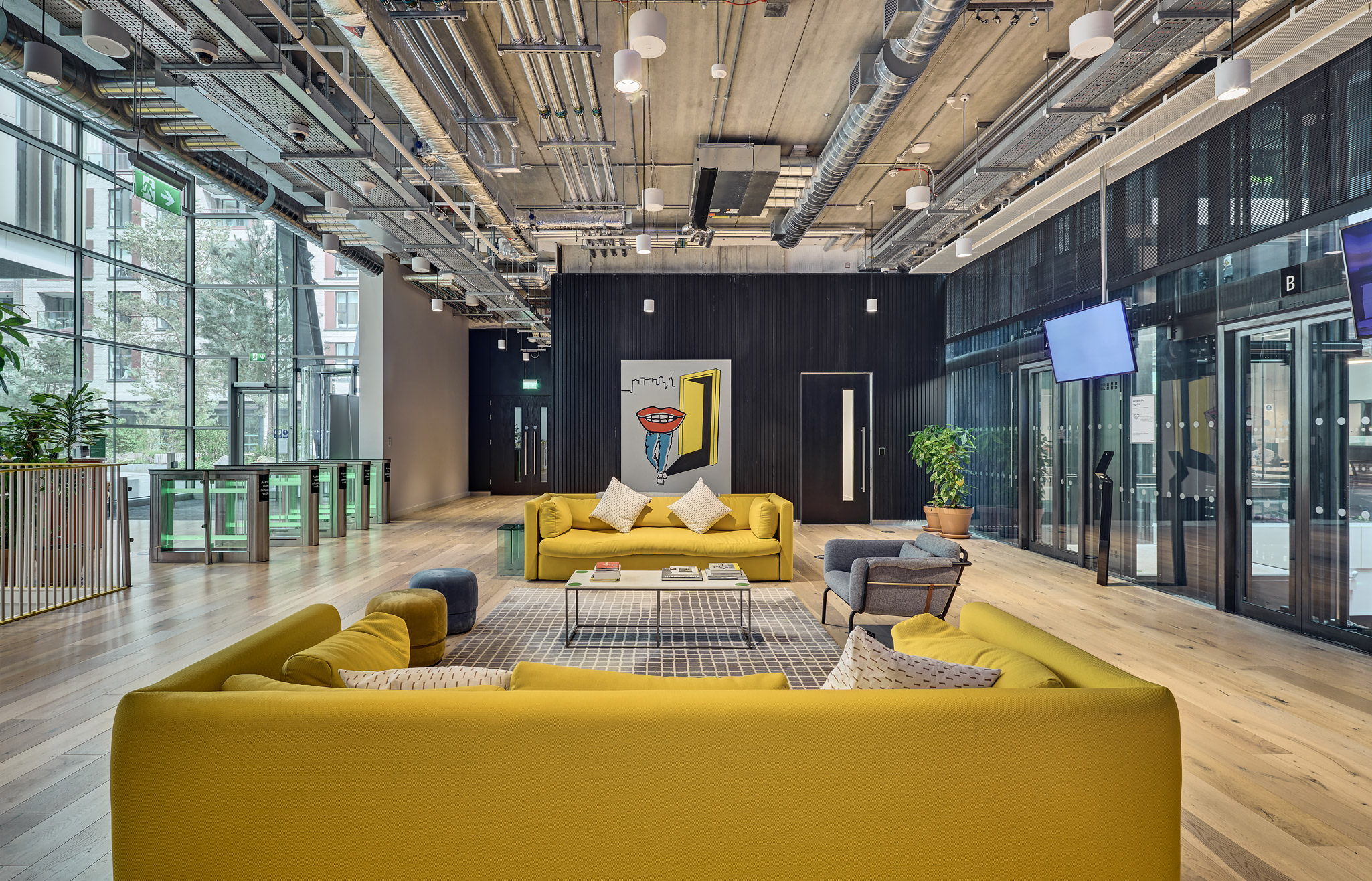
Dublin Landings
More convenience
If you look at work behaviours at some successful environments – like Google – employees tend to stay a lot longer in the workplace because they’re part of a different workplace paradigm, where work is a lifestyle experience. You are what you do and you live what you do.
So we’re thinking about the qualities that you have at home – like easier access to a GP or day care for your kids – that could make being at the workplace more convenient.
Gensler’s survey and other data show people are attracted to the workplace if they have a rich, dynamic mix of things to engage with there. One thing that designers have allowed us to believe is that every amenity has to be behind the front door of the office, but I don’t think that’s true.
In the city, an organisation can plug into the geographic diversity of its location, which means you can step out of the office and go to the gym or a restaurant. This is a clarion call for densification.
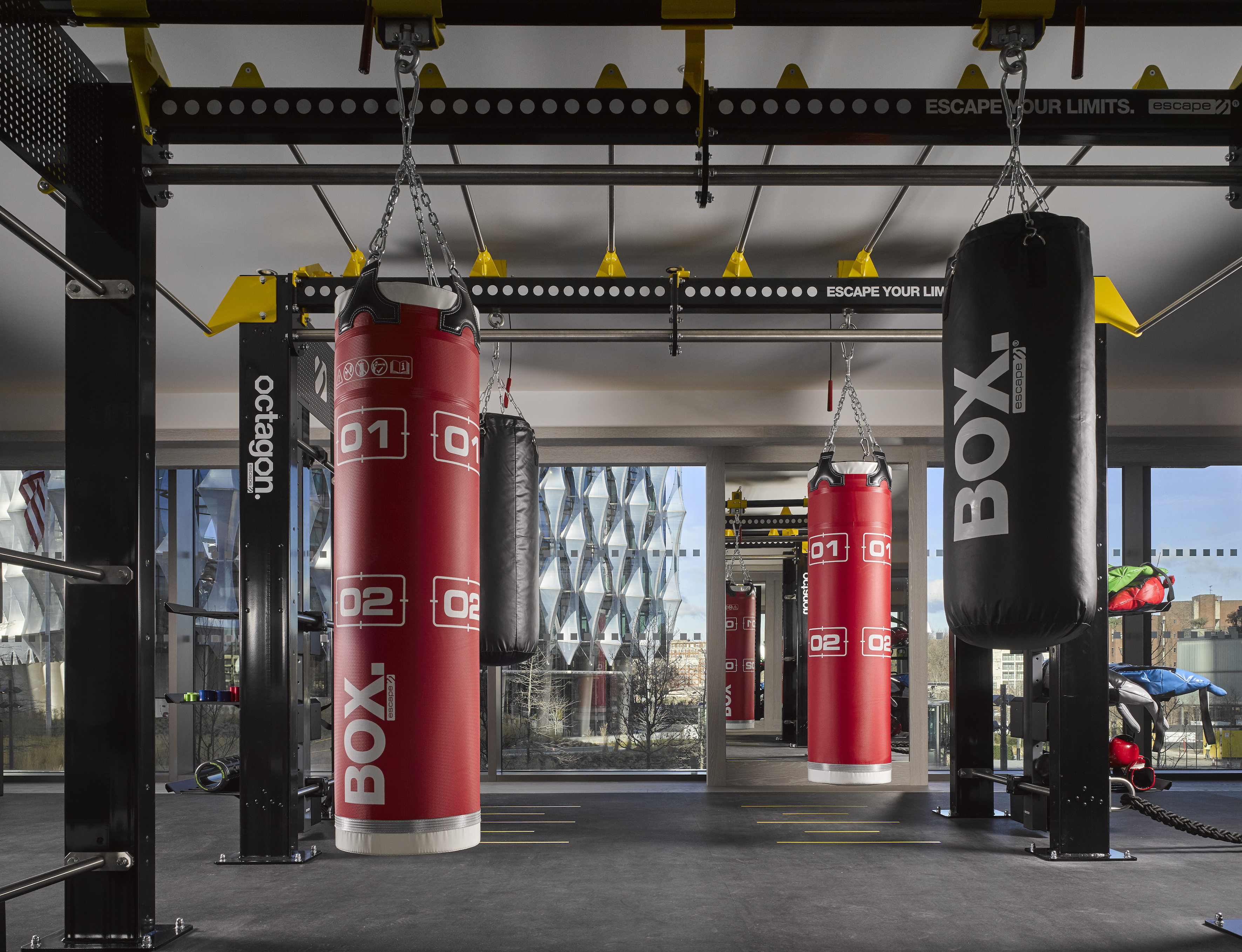
Locations are important as colleagues aim to step out of the office and head to the gym or a restaurant
Less space
Technology has removed the need for many to be anchored to a desk, so we can move from a meeting in the restaurant to a quiet library-like setting, or even outdoors.
Greater densification, combined with the fact people are working in a more dynamic way, means employers are going to need less office space, but that space will have more variety.
Outdoors comes indoors
Many of us enjoyed the ability to work from a garden setting during Covid. We’re now looking to design outdoor experiences inside buildings, by creating indoor landscaped gardens with artificial lighting that recreates natural daylight.
There was a great push to give offices terraces in the wake of the pandemic, but there are relatively few days when you can use that space. If you have curated indoor/outdoor experiences you can use them all year round, and with artificial lighting creating a daylight colour spectrum you can extend the day, as well as promoting wellbeing through biophilic characteristics.
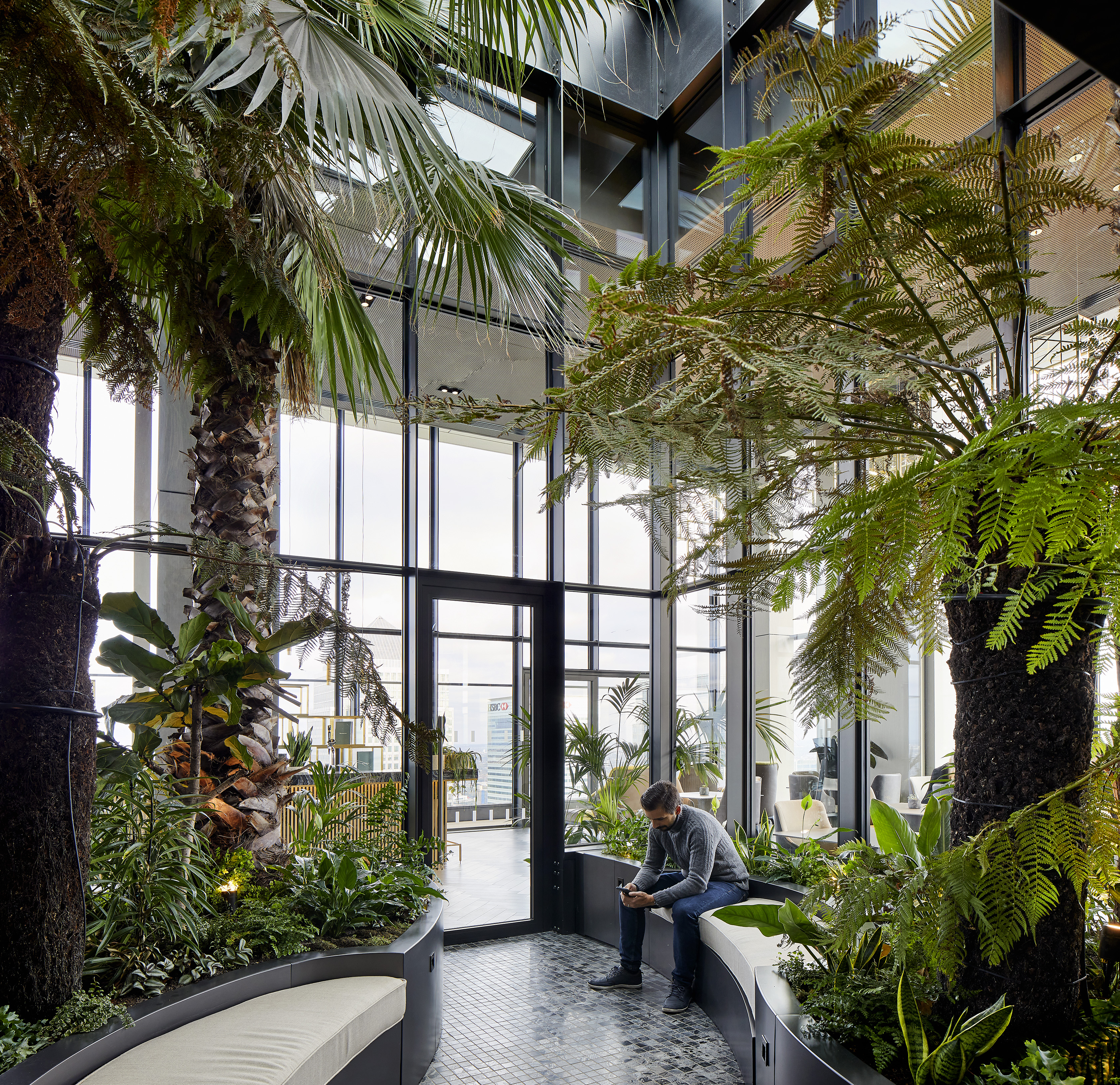
Biophelia was central to our design at Wardian in London
Designing the best experience
We’re going to see ‘experience’ professionals – now common in sectors like travel and retail – working more with big corporates and employers to curate the entire work/life experience. You’re starting to see that now in office buildings, where encouragement for cycling to work has led to a ramping up of cycle facilities for staff.
‘Experience Design’ isn’t just a wrapper that goes on after we’ve created the building; it’s central to our design development process, cradle to grave.
Related Articles
Ballymore wins best development at the 2023 Evening Standard New Homes Awards
Ballymore’s Goodluck Hope has won the Best Large Development Award at this year’s Evening Standard New Homes Awards – a prestigious ceremony which celebrates and commends innovation and excellence in today’s new homes.
The award is testament to Ballymore’s work in transforming the area. Once a stretch of disused industrial land on the Leamouth Peninsula, it has been reborn as a vibrant, residential-centric community comprising 841 homes- including thoughtfully designed apartments, lofts, and townhouses, all nestled amidst a captivating landscape of courtyards and slipways. Goodluck Hope also stands adjacent to the Ballymore’s completed London City Island community, itself a vibrant, cultural development.
Speaking of the news, Ballymore managing director John Mulryan said: “We are thrilled to add this accolade to Goodluck Hope's growing list of recognitions. This development has played a pivotal role in transforming East London, marking an extension of our successful endeavours in the area, including London City Island.
“We thank the judges for their support of the scheme and congratulate all of the event’s other winners.”
The award comes less than a year after Goodluck Hope was honoured with three other prestigious accolades; the Sunday Times British Home Award, a What House Gold Award and Best New Place to Live at the Building London Planning Awards.
For further information about the development, click here.
Related Articles
綠盛世與巴利摩合作夥伴關係獲國際認證
綠盛世巴利摩(Ecoworld Ballymore)是一家合資企業,開發了倫敦一些最令人矚目和創新的住宅開發專案。近日該公司在英馬商會卓越獎評比中(British Malaysian Chamber of Commerce Excellence Awards)榮獲英國-馬來西亞年度最佳合作夥伴獎。

綠盛世國際在馬來西亞領獎
這個備受讚譽的獎項由英國駐馬來西亞大使、倍受尊敬的Charles Hay MOV頒發,旨在表彰那些取得了傑出商業成果並為經濟創造了顯著價值的成功合作夥伴關係。
Ecoworld和Ballymore自2015年以來一直保持合作夥伴關係,在倫敦城市島(London City Island)和Wardian等地創建了新的社區。倫敦城市島是一個占地12英畝的河濱社區,被稱為“微縮曼哈頓”,而Wardian則是位於金絲雀碼頭南部的兩座豪華住宅塔樓。
這兩家合作夥伴還負責開發備受讚譽的大使館花園(Embassy Gardens)。大使館花園是世界著名的天空泳池所在地,被倫敦市長描述為“可能是倫敦和英國最重要的重建故事”。
在談到合資企業的成功時,Ballymore集團總經理約翰·穆爾瑞安(John Mulryan)表示:“我們很自豪能與Ecoworld作為優秀合作夥伴一同獲得認可。在過去的八年裏,這個合資企業在倫敦艱難時期交付了數千套住宅。通過共同努力,我們找到瞭解決之道,並創建了我們相信將經得起時間考驗的新社區。”
該頒獎典禮的組織者表示,獲獎者是“我們兩國的榜樣”,並補充說“我們要祝賀所有獲獎者,並感謝參與這個令人難忘的專案的每個人”。
Ballymore在過去一年中已獲得八個開發專案的獎項,其中包括兩個備受追捧的英國住宅獎。您可以在此處查看巴利摩所獲得的全部獎項。
Related Articles
绿盛世与巴利摩合作伙伴关系获国际认证
绿盛世巴利摩(Ecoworld Ballymore)是一家合资企业,开发了伦敦一些最令人瞩目和创新的住宅开发项目。近日该公司在英马商会卓越奖评比中(British Malaysian Chamber of Commerce Excellence Awards)荣获英国-马来西亚年度最佳合作伙伴奖。

绿盛世国际在马来西亚领奖
这个备受赞誉的奖项由英国驻马来西亚大使、倍受尊敬的Charles Hay MOV颁发,旨在表彰那些取得了杰出商业成果并为经济创造了显著价值的成功合作伙伴关系。
Ecoworld和Ballymore自2015年以来一直保持合作伙伴关系,在伦敦城市岛(London City Island)和Wardian等地创建了新的社区。伦敦城市岛是一个占地12英亩的河滨社区,被称为“微缩曼哈顿”,而Wardian则是位于金丝雀码头南部的两座豪华住宅塔楼。
这两家合作伙伴还负责开发备受赞誉的大使馆花园(Embassy Gardens)。大使馆花园是世界著名的天空泳池所在地,被伦敦市长描述为“可能是伦敦和英国最重要的重建故事”。
在谈到合资企业的成功时,Ballymore集团总经理约翰·穆尔瑞安(John Mulryan)表示:“我们很自豪能与Ecoworld作为优秀合作伙伴一同获得认可。在过去的八年里,这个合资企业在伦敦艰难时期交付了数千套住宅。通过共同努力,我们找到了解决之道,并创建了我们相信将经得起时间考验的新社区。”
该颁奖典礼的组织者表示,获奖者是“我们两国的榜样”,并补充说“我们要祝贺所有获奖者,并感谢参与这个令人难忘的项目的每个人”。
Ballymore在过去一年中已获得八个开发项目的奖项,其中包括两个备受追捧的英国住宅奖。您可以在此处查看巴利摩所获得的全部奖项。
Related Articles
“舞後”——倫敦城市島的藝術慶典
一座新的雕塑在巴利摩倫敦城市島社區揭幕,這座雕像的落成,標誌著這個坐落在利茅斯半島上的社區已成為東倫敦最新的、引人注目的文化區。
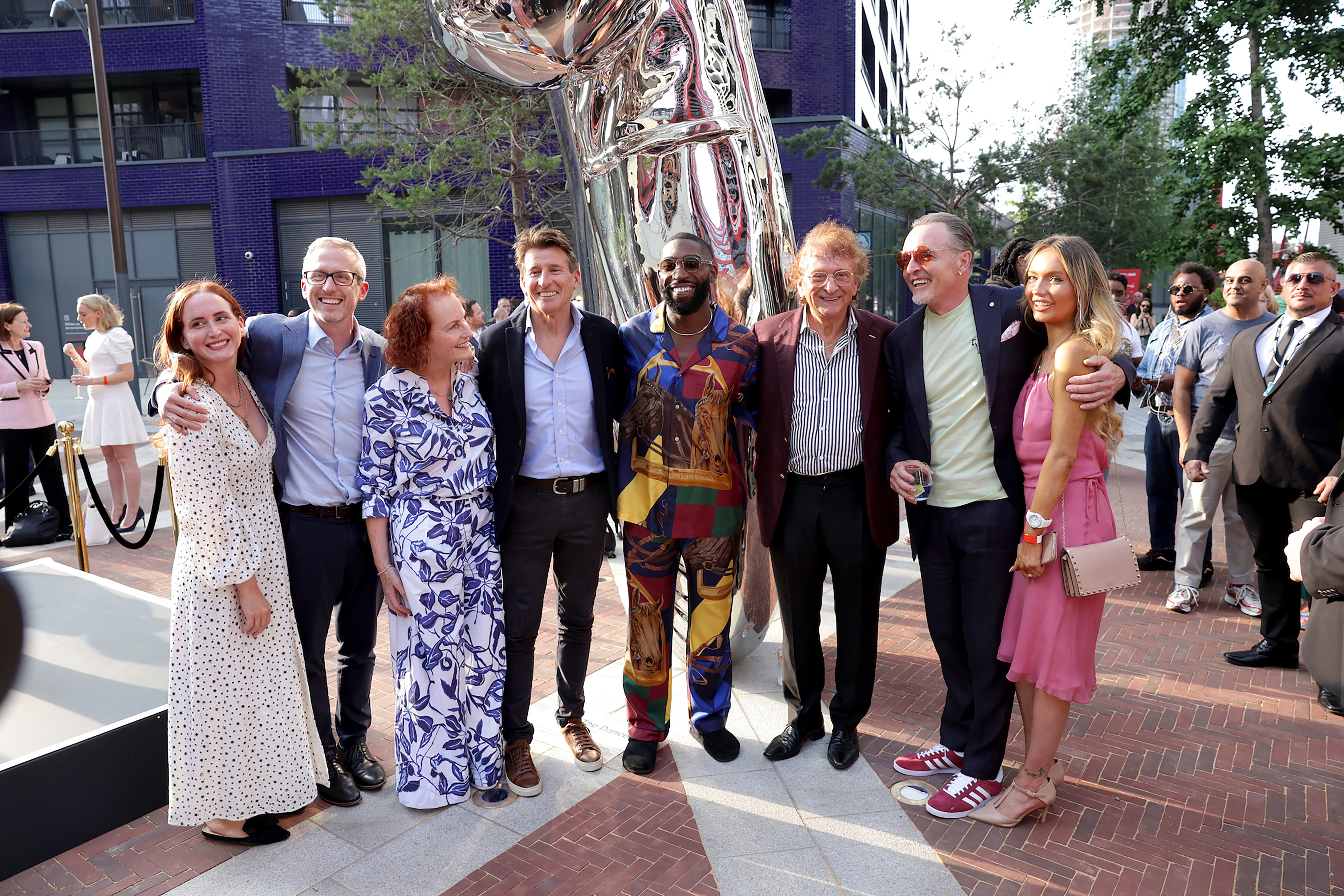
這座雕像是由巴利摩創始人Sean Mulryan與Seb Coe勳爵共同揭幕的。揭幕當晚Seb Coe勳爵還發表了演講。他在演講中歷數了Sean曾經為 2012 年奧運會提供資金贊助,以及對倫敦城市島等社區的設計願景和高品質的建設,並讚揚他為東倫敦的復興工程做出了巨大貢獻。
"我知道Sean對城市復興的重視程度。我們看到並證實了肖恩對體育與文化的重視在社區中所發揮的巨大效應。 我們眼前看到的矗立在這裏的這個大型文化機構——英國國家芭蕾舞團,是這個文化社區的基石。 它不僅為這裏的文化做出巨大貢獻,給倫敦乃至全英國的文化都注入了巨大活力。
“對於那些在這個社區生活與工作的人來說,請繼續發揚這種精神,因為這是一個重要的文化傳承的理念,你們提供的不僅僅是基礎設施服務,而是讓社區的體育與文化相結合而產生的能動力。 它關乎人類生存的精神層面的需求。”

如若觀看Seb Coe勳爵開幕式演講的完整視頻,請點擊此處。
Sean和他的妻子Bernardine將這座雕塑贈送給社區,充分證明了他們對藝術不懈的追求,Sean認為: "這座雕塑是倫敦城市島引人注目的又一個新的聚焦點。
"我一直深深地感受到藝術、文化和自然之美與人們的幸福指數及生活品質是息息相關的。因此,我們將藝術作為所有開發專案的核心考量。
"在倫敦城市島,巴利摩率先將倫敦的創意產業更廣泛地遷移到這裏——首都的東部地區。我們希望社區的居民和遊客能盡情享受這裏的文化氛圍,也希望這座新雕塑能讓他們停頓片刻,哪怕僅是幾秒鐘"。
這座雕塑由Colin Spofforth設計的。
為了進一步推動當地藝術的發展,Sean Mulryan還宣佈啟動一項新的藝術基金計畫,該計畫是他與藝術家、兼三一畫廊(Trinity Gallery)策展人Ian Felton聯手設立的(三一畫廊位於幸運島開發專案,比鄰倫敦城市島)。該基金計畫將為新銳藝術家提供資金與行銷的支持,幫助他們開發新作品。 根據該計畫,Sean將投資原創藝術作品。這些藝術品將進行未來版本的製作,並以版稅的方式出售,在接下來的五年內為藝術家創造持續的收入來源。Ian將以他專業的知識提供藝術市場方面的建議,並且在製作和銷售方面給予支持。
長期目標是將藝術基金發展成為一個可持續的模式,不斷為藝術家提供支持,並在未來許多年裏創造新的收藏品。

Sean解釋說:“我熱衷於為嶄露頭角的藝術家提供一個分享作品的平臺。 我想對他們進行投資,創造可行的收入來源,讓他們的事業更上一層樓,並將他們的才華展示給新的觀眾。
“我很自豪這一舉措以及這座雕塑,這彰顯了我們對倫敦這一地區的藝術的重視,並期待通過新的基金計畫在未來結識更多新銳藝術家。” 雕塑揭幕和基金啟動儀式在倫敦城市島的 Lockdown Room 舉行,在這個音樂與文化相交融的夜晚,巴利摩的員工、表演者、音樂家和嘉賓們彙聚一堂,英國說唱歌手 Tinie Tempah 和 DJ Welshy為現場觀眾帶來了精彩的表演,來自英國國家芭蕾舞團(ENB)的舞蹈家也表演了精彩的芭蕾舞片段。

當晚的活動進一步認證了倫敦城市島在推動首都文化和藝術方面所發揮的作用。除 ENB 外,許多文化合作夥伴也在此安家落戶,其中包括 arebyte 工作室——為多達 150 名的藝術家和製作者提供經濟實惠的工作空間,他們的作品涵蓋珠寶、設計、美術、動畫、數字媒體、音樂、時裝、攝影、遊戲開發、建築和陶瓷等領域;還有倫敦燈塔畫廊——為新銳和知名藝術家及攝影師提供攝影工作室和展示畫廊。
音樂家在這裏也有一個展示平臺——“The Woods”錄音棚,這裏是製作人和詞曲作者Dantae Johnson的三只熊娛樂公司 (Three Bears Entertainment) 的所在地,裏面設有音樂和播客工作室、創意活動和排練空間。 他的隔壁是創意時尚工作室Lulu Liu,她是一位高級時裝設計師,在設計中使用先進3D 技術。 當然,還有三一藝術畫廊,為新生藝術家和知名藝術家提供一個展示的平臺。
Sean總結道:“這次活動提醒我們,我們對倫敦城市島的願景藍圖已化為現實,該地區已經成為倫敦新的文化和藝術中心。 倫敦城市島曾經是倫敦城中的一塊不毛之地,現在擁有 4,000 多名居民,周邊遍佈獨立的特色餐廳、商店和優美的戶外空間。”
欲瞭解有關倫敦城市島的更多資訊,請單擊此處。

瞭解我們的創意社區
瞭解我們的創意社區
要想瞭解在島上安家的一些創意人士的採訪視頻,請點擊此處。
Related Articles
“我在這裏總是感到超級受歡迎”
巴利摩的倫敦城市島專案位於首都倫敦的東部,是一處蓬勃發展的新興文化社區。
在這個新興社區裏彙聚了無數創意人才,社區還為那些表演者和藝術家提供了一個分享自己作品的平臺。在這部紀錄片中,我們將會結識一些視倫敦城市島為自己的家園的藝術家。

點擊這裏聆聽Archangelo古典音樂樂團的心聲:他將倫敦城市島比作“藝術家的樂園”;或定格動畫師Tim Allen的對倫敦城市島的評價:這裏是他剪輯全球大片的基地,就如同Guillermo del Toro’s adaptation在改編他的奧斯卡獲獎影片《木偶奇遇記》。
在紀錄片中還展示了arebyte畫廊,該畫廊為多達150名藝術家、製作者、時裝設計師、音樂家、音樂製作人提供了經濟實惠的展示空間,當然還有英國國家芭蕾舞團——倫敦城市島的文化核心。
談到這個日益壯大的社區,巴利摩集團創始人兼主席Sean Mulryan表示: "倫敦城市島是一些才華橫溢的藝術家和表演者的家園。我們對這個社區的願景是將這裏建設成一個能激發他們創作靈感的地方,為他們提供一個能夠與全球觀眾接軌的平臺。
"這部紀錄片完美地記錄了藝術家在島上的生活經歷;我很高興聽到他們的心聲,並期待那些精良的製作、精美的藝術作品和精湛的表演將從這裏源源不斷地誕生!”
這部紀錄片僅僅是倫敦城市島精彩文化周的一個掠影。而這裏豐富多彩的文化活動每天都在發生著!就在幾天前,包括Seb Coe勳爵在內的嘉賓們來到倫敦城市島參加了一座雕塑的揭幕典禮。這座雕塑雕刻得惟妙惟肖,是一雙銀色的芭蕾舞鞋,是Sean Mulryan和他的妻子Bernardine贈送給倫敦城市島的禮物,它坐落於英國國家芭蕾舞團的Mulryan Centre的對面。點擊這裏可以瞭解更多資訊。
Related Articles
“我在这里总是感到超级受欢迎”
巴利摩的伦敦城市岛项目位于首都伦敦的东部,是一处蓬勃发展的新兴文化社区。
在这个新兴社区里汇聚了无数创意人才,社区还为那些表演者和艺术家提供了一个分享自己作品的平台。在这部纪录片中,我们将会结识一些视伦敦城市岛为自己的家园的艺术家。

点击这里聆听Archangelo古典音乐乐团的心声:他将伦敦城市岛比作“艺术家的乐园”;或定格动画师Tim Allen的对伦敦城市岛的评价:这里是他剪辑全球大片的基地,就如同Guillermo del Toro’s adaptation在改编他的奥斯卡获奖影片《木偶奇遇记》。
在纪录片中还展示了arebyte画廊,该画廊为多达150名艺术家、制作者、时装设计师、音乐家、音乐制作人提供了经济实惠的展示空间,当然还有英国国家芭蕾舞团——伦敦城市岛的文化核心。
谈到这个日益壮大的社区,巴利摩集团创始人兼主席Sean Mulryan表示: "伦敦城市岛是一些才华横溢的艺术家和表演者的家园。我们对这个社区的愿景是将这里建设成一个能激发他们创作灵感的地方,为他们提供一个能够与全球观众接轨的平台。
"这部纪录片完美地记录了艺术家在岛上的生活经历;我很高兴听到他们的心声,并期待那些精良的制作、精美的艺术作品和精湛的表演将从这里源源不断地诞生!”
这部纪录片仅仅是伦敦城市岛精彩文化周的一个掠影。而这里丰富多彩的文化活动每天都在发生着!就在几天前,包括Seb Coe勋爵在内的嘉宾们来到伦敦城市岛参加了一座雕塑的揭幕典礼。这座雕塑雕刻得惟妙惟肖,是一双银色的芭蕾舞鞋,是Sean Mulryan和他的妻子Bernardine赠送给伦敦城市岛的礼物,它坐落于英国国家芭蕾舞团的Mulryan Centre的对面。点击这里可以了解更多信息。
Related Articles
“舞后”——伦敦城市岛的艺术庆典
一座新的雕塑在巴利摩伦敦城市岛社区揭幕,这座雕像的落成,标志着这个坐落在利茅斯半岛上的社区已成为东伦敦最新的、引人注目的文化区。

这座雕像是由巴利摩创始人Sean Mulryan与Seb Coe勋爵共同揭幕的。揭幕当晚Seb Coe勋爵还发表了演讲。他在演讲中历数了Sean曾经为 2012 年奥运会提供资金赞助,以及对伦敦城市岛等社区的设计愿景和高品质的建设,并赞扬他为东伦敦的复兴工程做出了巨大贡献。
"我知道Sean对城市复兴的重视程度。我们看到并证实了肖恩对体育与文化的重视在社区中所发挥的巨大效应。 我们眼前看到的矗立在这里的这个大型文化机构——英国国家芭蕾舞团,是这个文化社区的基石。 它不仅为这里的文化做出巨大贡献,给伦敦乃至全英国的文化都注入了巨大活力。
“对于那些在这个社区生活与工作的人来说,请继续发扬这种精神,因为这是一个重要的文化传承的理念,你们提供的不仅仅是基础设施服务,而是让社区的体育与文化相结合而产生的能动力。 它关乎人类生存的精神层面的需求。”

如若观看Seb Coe勋爵开幕式演讲的完整视频,请点击此处。
Sean和他的妻子Bernardine将这座雕塑赠送给社区,充分证明了他们对艺术不懈的追求,Sean认为: "这座雕塑是伦敦城市岛引人注目的又一个新的聚焦点。
"我一直深深地感受到艺术、文化和自然之美与人们的幸福指数及生活质量是息息相关的。因此,我们将艺术作为所有开发项目的核心考量。
"在伦敦城市岛,巴利摩率先将伦敦的创意产业更广泛地迁移到这里——首都的东部地区。我们希望社区的居民和游客能尽情享受这里的文化氛围,也希望这座新雕塑能让他们停顿片刻,哪怕仅是几秒钟"。
这座雕塑由Colin Spofforth设计的。
为了进一步推动当地艺术的发展,Sean Mulryan还宣布启动一项新的艺术基金计划,该计划是他与艺术家、兼三一画廊(Trinity Gallery)策展人Ian Felton联手设立的(三一画廊位于幸运岛开发项目,比邻伦敦城市岛)。该基金计划将为新锐艺术家提供资金与营销的支持,帮助他们开发新作品。 根据该计划,Sean将投资原创艺术作品。这些艺术品将进行未来版本的制作,并以版税的方式出售,在接下来的五年内为艺术家创造持续的收入来源。Ian将以他专业的知识提供艺术市场方面的建议,并且在制作和销售方面给予支持。
长期目标是将艺术基金发展成为一个可持续的模式,不断为艺术家提供支持,并在未来许多年里创造新的收藏品。

Sean解释说:“我热衷于为崭露头角的艺术家提供一个分享作品的平台。 我想对他们进行投资,创造可行的收入来源,让他们的事业更上一层楼,并将他们的才华展示给新的观众。
“我很自豪这一举措以及这座雕塑,这彰显了我们对伦敦这一地区的艺术的重视,并期待通过新的基金计划在未来结识更多新锐艺术家。” 雕塑揭幕和基金启动仪式在伦敦城市岛的 Lockdown Room 举行,在这个音乐与文化相交融的夜晚,巴利摩的员工、表演者、音乐家和嘉宾们汇聚一堂,英国说唱歌手 Tinie Tempah 和 DJ Welshy为现场观众带来了精彩的表演,来自英国国家芭蕾舞团(ENB)的舞蹈家也表演了精彩的芭蕾舞片段。

当晚的活动进一步认证了伦敦城市岛在推动首都文化和艺术方面所发挥的作用。除 ENB 外,许多文化合作伙伴也在此安家落户,其中包括 arebyte 工作室——为多达 150 名的艺术家和制作者提供经济实惠的工作空间,他们的作品涵盖珠宝、设计、美术、动画、数字媒体、音乐、时装、摄影、游戏开发、建筑和陶瓷等领域;还有伦敦灯塔画廊——为新锐和知名艺术家及摄影师提供摄影工作室和展示画廊。
音乐家在这里也有一个展示平台——“The Woods”录音棚,这里是制作人和词曲作者Dantae Johnson的三只熊娱乐公司 (Three Bears Entertainment) 的所在地,里面设有音乐和播客工作室、创意活动和排练空间。 他的隔壁是创意时尚工作室Lulu Liu,她是一位高级时装设计师,在设计中使用先进3D 技术。 当然,还有三一艺术画廊,为新生艺术家和知名艺术家提供一个展示的平台。
Sean总结道:“这次活动提醒我们,我们对伦敦城市岛的愿景蓝图已化为现实,该地区已经成为伦敦新的文化和艺术中心。 伦敦城市岛曾经是伦敦城中的一块不毛之地,现在拥有 4,000 多名居民,周边遍布独立的特色餐厅、商店和优美的户外空间。”
欲了解有关伦敦城市岛的更多信息,请单击此处。

了解我们的创意社区
了解我们的创意社区
要想了解在岛上安家的一些创意人士的采访视频,请点击此处。
Related Articles
Enhancing community skills and spaces: our Ballymore volunteers join the Canal Day of Action
Some 20 colleagues from Ballymore joined a volunteer day in London this week, supporting the local environment and local skills.
The Canal Day of Action took place in the Royal Borough of Kensington and Chelsea and was organised by local charity Pursuing Independent Paths (PiP), working with the Canal and Rivers Trust, and Meanwhile Gardens – a community garden initiative in the area.

Students from PiP also joined the day; the organisation empowers adults with learning disabilities or autism to find their voice and lead a life of their choice, and the event was part of its garden-focused curriculum, providing employment skills for the students who took part. Jack Taylor of PiP explained: “This was a truly fantastic day with many positive outcomes – not only for PiP students, but for the broader community in North Kensington.
“This was a great space in which to host our event; this area of canal is largely overgrown, with a higher number of bindweed that can spread quickly, suffocating other plants, and limiting biodiversity. Ballymore volunteers worked alongside our students to cut it back, while planting new seeds to bring a diverse array of new plants to the towpath for our students to maintain and our community to enjoy. We are hugely grateful to everyone who gave their time to make a big transformation.”

This stretch of the Grand Union Canal will form part of Ballymore’s planned new development at Ladbroke Grove. Partnering with Sainsbury’s, Ballymore hopes to transform an 19-acre expanse of land within an existing community, a place where everyone can flourish. The site is the Royal Borough of Kensington and Chelsea’s biggest brownfield opportunity, with plans to create areas for living, working, socialising and recreation. Ballymore’s graduate development manager Tilly Gerlikaite is part of the Ladbroke Grove development team and said: “We have immersed ourselves in this community, connecting with local people and organisations as we evolve our designs for Ladbroke Grove.
“The canal clearance event was another opportunity to work alongside the great people already based in North Kensington; it was a truly rewarding and informative day. I am proud of our Ballymore colleagues – each of whom was enthusiastic from start to finish, indulging in the many tasks at hand, picking up new skills, and meeting some great people. We are really keen to build further meaningful partnerships with local charities and organisations in this area.”
Find out more about PiP here.

Related Articles
Market intelligence: interest rate rises
Families and businesses across the UK are feeling the squeeze as interest rates continue to rise through the year. The property sector is also feeling the effects of interest rate increases, with consequences for investors, developers and homebuyers, as Ballymore’s Head of Underwriting David Morris explains.
When the Bank of England’s Monetary Policy Committee voted to raise the base rate last month, it was the UK’s 14th consecutive interest rate rise. It’s difficult to predict where we’ll go from here; higher interest rates increase the cost of borrowing, whether you’re a homebuyer wanting a mortgage or a developer looking to finance a development. That is presenting a more challenging environment at every stage of delivering a development, from financing site acquisitions through to selling new homes.
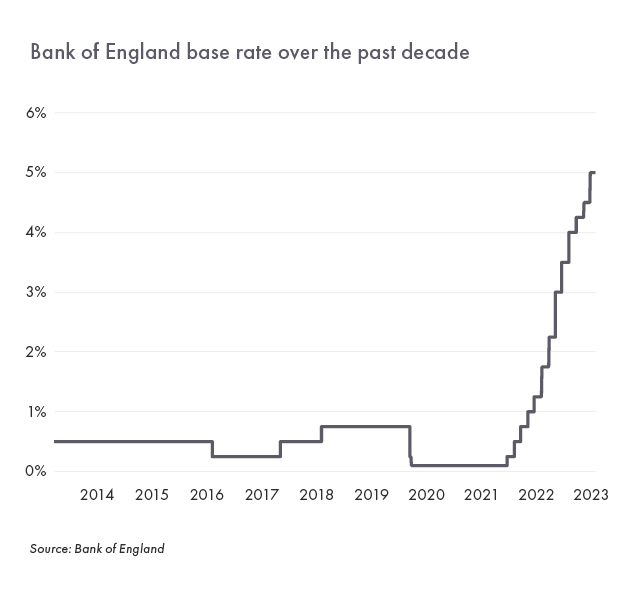
The rising cost of development finance
Like the cost of borrowing for mortgages, the cost of development finance has escalated dramatically – more than doubling over the past year. As a result, the price at which developers need to sell homes increases to compensate for this.
This cost increase has to be seen in the wider development context where new regulations are placing greater demands on developers in areas like design and sustainability. The sector is getting to grips with complexities like the new building safety requirements, including the need for a second staircase in higher rise buildings, which increases build costs and reduces sale-able space.
Objectives like these are positive and often essential, but they ultimately increase the price at which we need to sell a home to compensate for the additional costs. Where the price required is above what we believe is achievable the project becomes unviable.
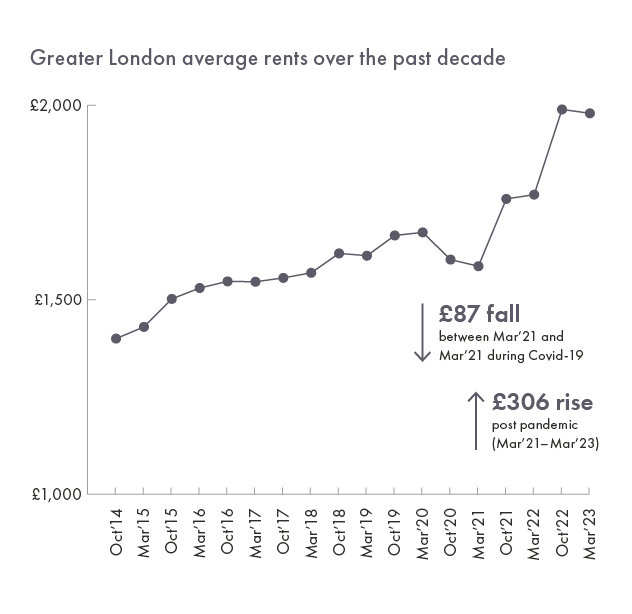
Tougher investment markets
At the same time, the increase in interest rates is increasing what is referred to as ‘the risk-free rate’, which is the return achieved from government bonds or money in a bank account. If an investor can receive 4.5% or 5% return on a government bond, then they will need to see higher reward for taking additional risk, such as owning real estate. The yield (income of a building divided by purchase price) being demanded by investors increases to compensate for this. Whilst investors were willing to accept 3.5% to 4% yield on real estate 18 months ago, as the ‘risk free rate’ than was almost zero, now investors are demanding yields in excess of 5%. If the income has remained constant, which will be the case for most offices over the past 18 months, then the yield movement results in a c. 25% decrease in value.
Another factor causing lenders concern, is the ability of investors in the office sector to service their loan facilities. Lenders are doing that by focusing on what’s called the interest coverage ratio (ICR) – which is a metric that measures the difference between the income of the building and the interest on any loan. As interest rates increase and income remains static this metric can cause office owners to default on their loans.
There have been concerns for some time about post-pandemic office occupancy rates, which, although rising, are still down on pre-pandemic levels. But alongside that, a number of major business names have made environmental, social and governance (ESG) commitments about their plans for their office space, and will want to be in the very best buildings.
This creates a domino effect for older less energy efficient buildings. Their ability to let the building has reduced dramatically so rents are falling, reducing income at the same time as interest rates are rising, increasing costs and yields are widening, decreasing value. It is in some ways a ‘perfect storm’.
Residential has been less impacted than the office market due to the high demand and lack of supply of quality stock. London did not see significant price increases during COVID 19 compared to other parts of the UK. Construction starts remaining at decade low levels in London, and likely to fall further, mean supply is unlikely to put pressure on house prices.
Although there was a trend for people to move out of London through the pandemic, there has been a return since and residential rental prices are increasing dramatically. The residential letting market reacts in a much more rapid fashion than commercial letting markets or the residential sale market to external stimuli and we have seen dramatic growth in rents, which generally rise in line with inflation, making the sector an attractive proposition for a pension fund or investor. This is why Build to Rent is likely to become a larger part of Ballymore’s business going forward.
One dynamic that should be remembered is we are now in an ‘inflationary environment’ and being able to purchase apartments in Ballymore developments two or three years off plan allows investors to benefit from that inflation, locking in a price today, for something you won’t complete on for up to three years, could be very beneficial. That’s important because Ballymore doesn’t just develop buildings; we create places - homes and communities. Prices can rise as completion nears, when the quality of what we’ve created is evident and we’re seeing an investor appetite for quality so we’re in a strong position.
Related Articles
Ballymore helps secure Barnet’s first ever business improvement district at Edgware
There was exciting news for Edgware this week, as Barnet Council announced the borough’s first Business Improvement District (BID) – helping drive investment of up to £800,000 into the high street.
The BID is the culmination of a campaign led by the Edgware BID steering group. Comprising Ballymore, Transport for London, Barnet Council and local businesses, the group has spent the past year hosting extensive consultations to understand the priorities of businesses in Edgware which is home to Ballymore’s Broadwalk Shopping Centre – a key regeneration site for the local area.
Speaking of the news, Ballymore Projects Director Simon Ryan said: “We are committed to the transformation of Edgware, and are delighted to see the BID become a reality. This announcement will bring local businesses together to collectively invest in the management and marketing of the town centre, with the aim of revitalising the area’s economy and creating a thriving business community.”
Cllr Anne Clarke, Barnet’s Small Business Champion and Cabinet Member for Community Wealth Building added: “As the first BID in Barnet, the Edgware BID marks an important moment in our partnership with communities and businesses.
“We care a great deal about our places and the people who live and work in our town centres, and by establishing this BID, we can foster a stronger dialogue between the council and the business community in Edgware. By working together, we hope that we can make Edgware a place for businesses new and old to thrive.”
Ballymore’s involvement in Edgware came in 2020 when the developer acquired the 17,650 sq m shopping centre, which sits on a 7.5 hectare site next to Edgware Underground Station. The Ballymore team is currently evolving designs for the site, with proposals including high-quality new homes and retail, public realm and green spaces and community and leisure facilities; Simon continued: “This is a hugely important site at the heart of Edgware – one which has the potential to unlock the regeneration of the town centre. We are thrilled to be bringing our ideas to the area, consulting with local people to develop a new place that all who live, work and play here can be proud of.
“Our plans and the establishment of the BID are testament to the potential of Edgware as it becomes a revitalised, vibrant north London destination.”
BIDs are business-led partnerships that enable coordinated investment in the management and marketing of a commercial area. Governed by legislation to ensure fairness and transparency, a BID is developed through consultation and the creation of a five-year business plan. Edgware BID is the first of its kind in Barnet’s local authority area; read more about it here.
Related Articles
Slow fashion is in style at Embassy Gardens
Embassy Gardens played host to a celebration of sustainable style and independent British brands this month, welcoming hundreds of fashion fans to London's Nine Elms for a two-week pop-up with Daily Dress Edit.

The pop-up took over Embassy Gardens’ Oxeye restaurant, creating an immersive style experience that allowed customers to explore the vibrant space – something the Evening Standard called “a colourful bijoux bursting with fab frocks”. Seasonal dressesfrom 50 hand-picked brands including Well Worn, Faune, Smock London and If Only If were displayed around the venue, as well as a collection of limited-edition dresses made from surplus fabric – something known in the industry as deadstock.
Daily Dress Edit Founder Isabel Spearman, who established the brand in 2018, said: “The Daily Dress Edit customer is broad, they’re 25 to 65, and I meet everyone from lawyers and doctors to creatives… but what ties them together is that they are all really proud to support these female independent sustainable brands.”
Guests visiting the pop-up were invited to attend 45-minute style appointments; 120 guests also attended a series of drinks receptions at the pop-up, including Samantha Cameron and leading media figures, DailyTelegraph Fashion Director Bethan Holt, Clare Casey, Director of Global Partnerships for Conde Nast International and Emma Redmayne – Publishing Director of House & Garden.
Eloise Solari, Associate Regional Sales Director at Ballymore, concluded: “We are proud that we were able to support Isabel in her ambitions to create a fairer and more sustainable fashion industry – championing independent brands and giving them a platform to promote their unique collections.
“The pop-up served as a testament to the diverse range of lifestyle brands attracted to Embassy Gardens, reaffirming our commitment to developing a new cultural hub and vibrant neighbourhood in Nine Elms."
Find out more about the Daily Dress Edit here

